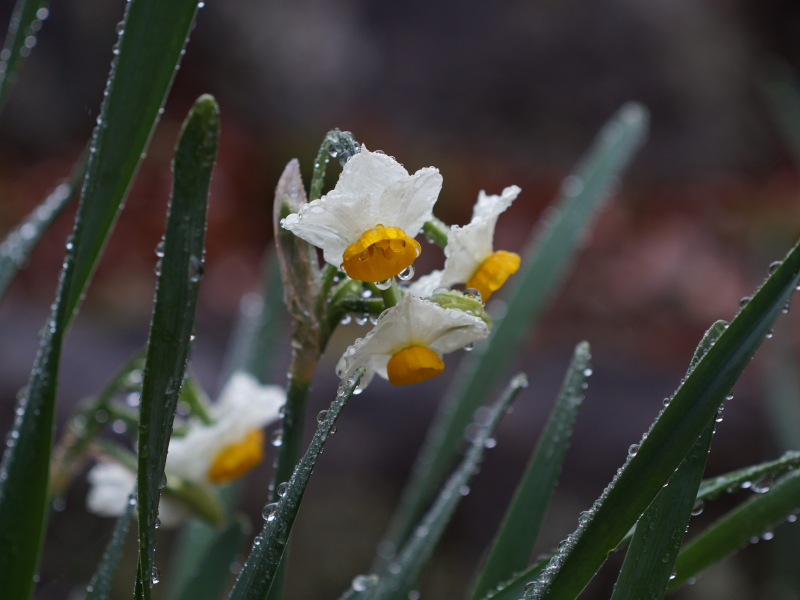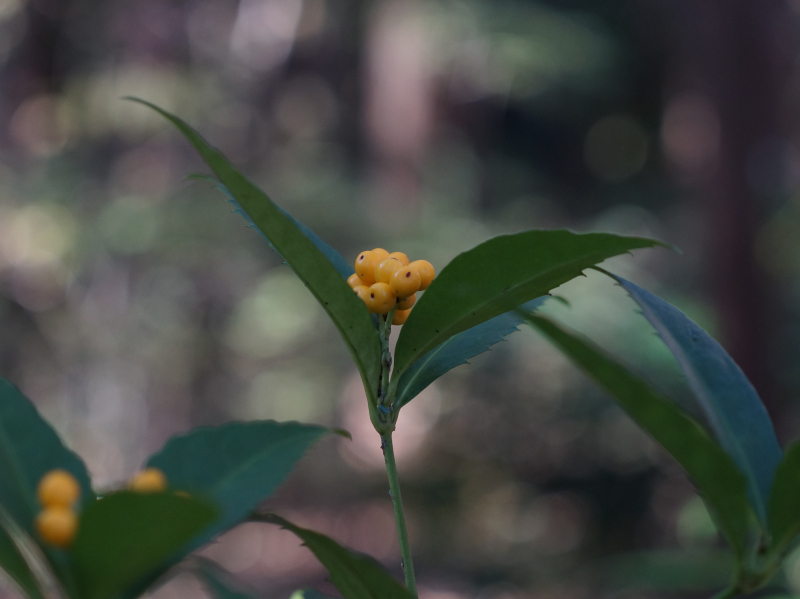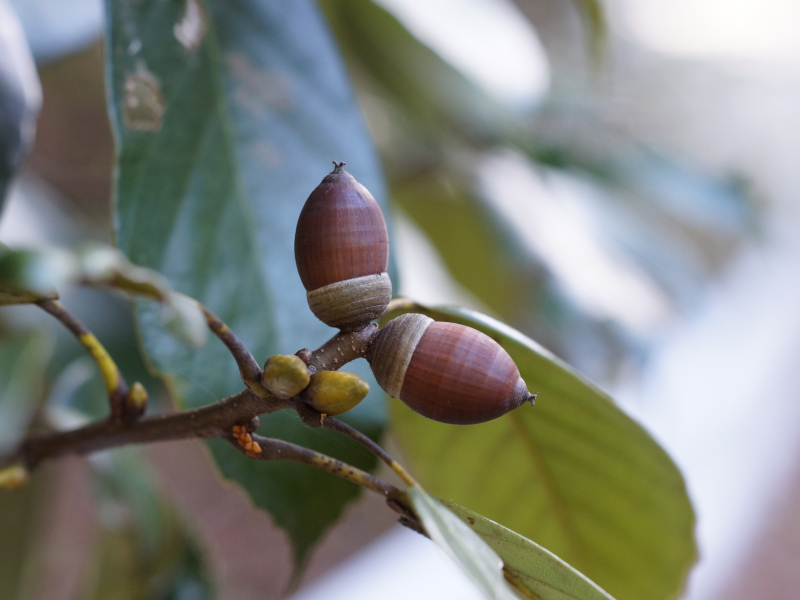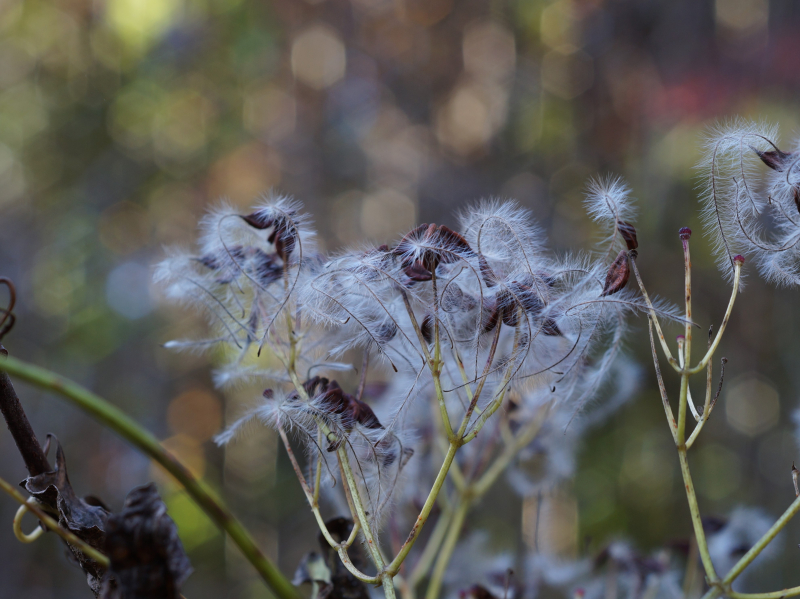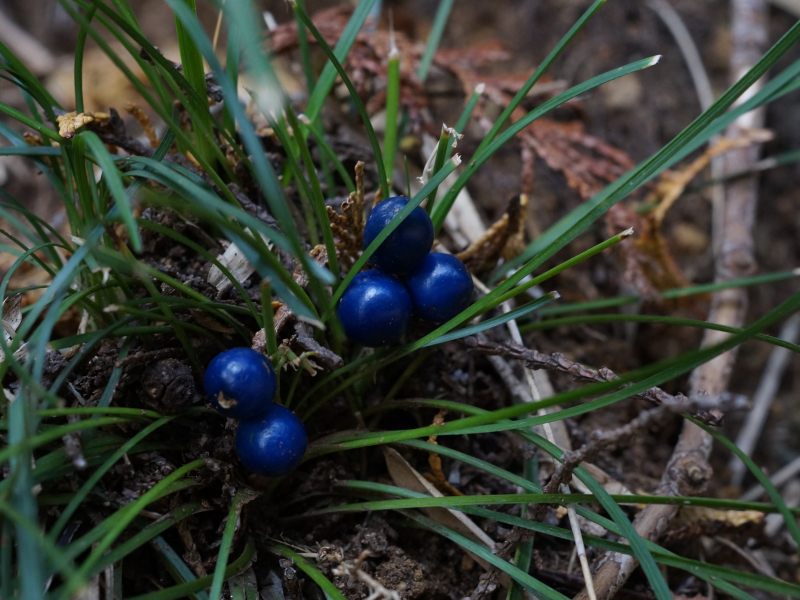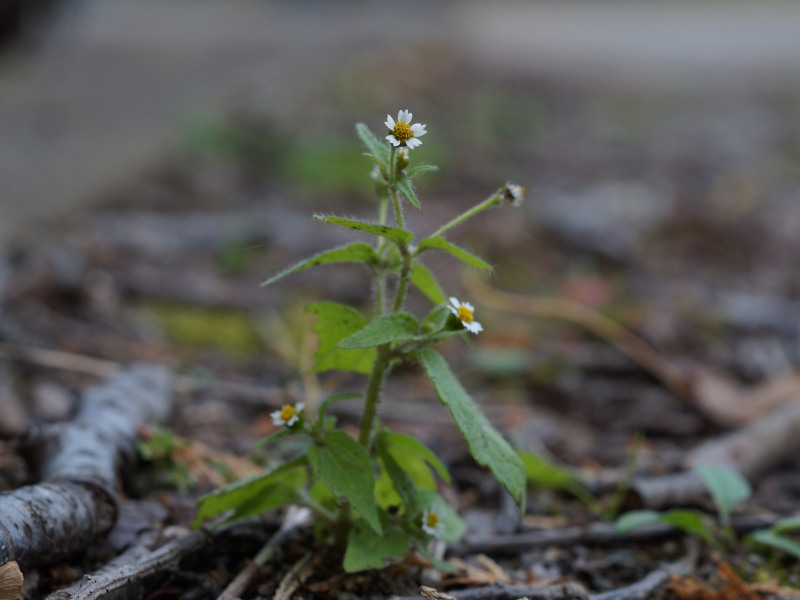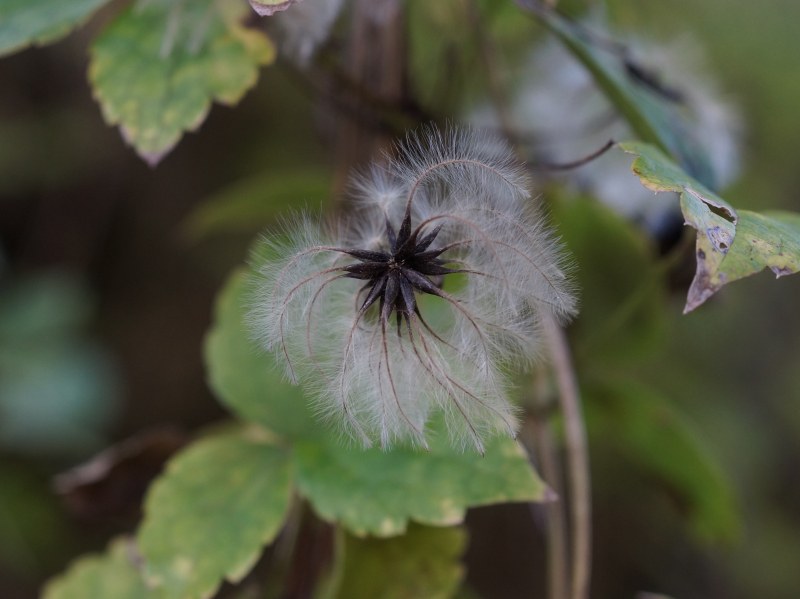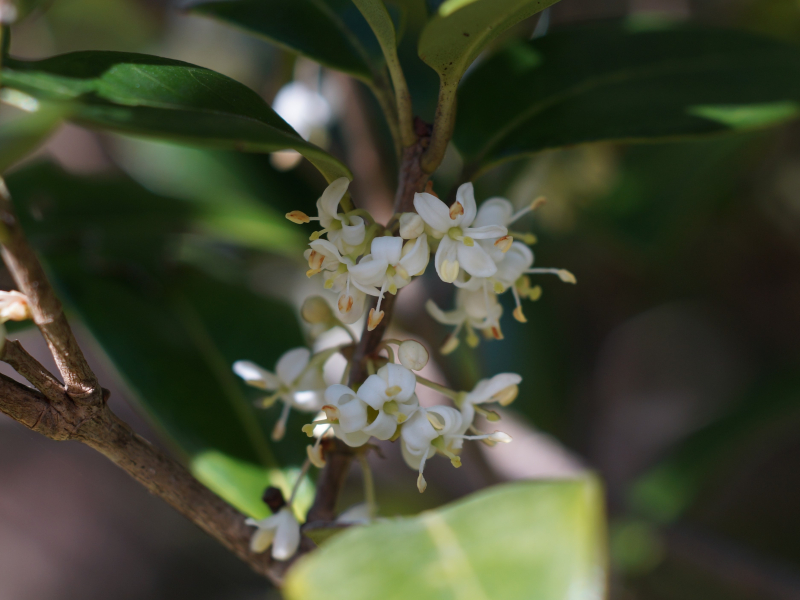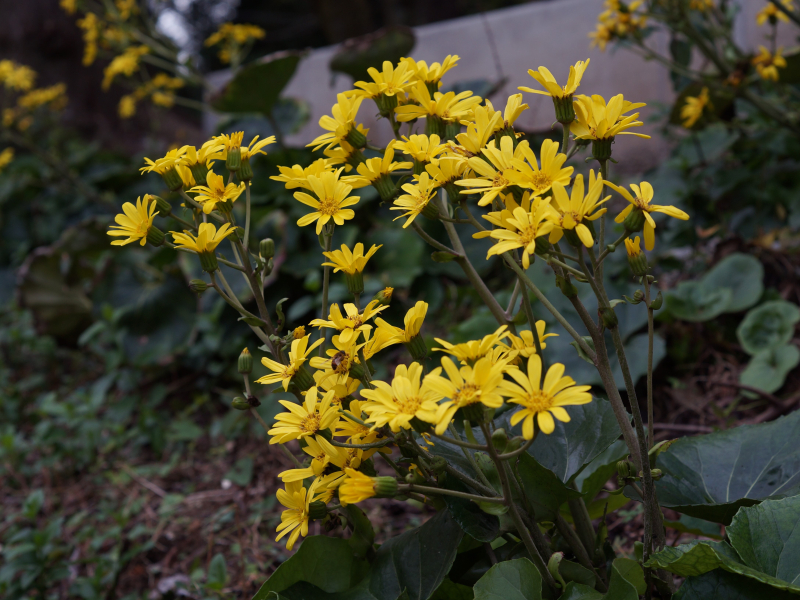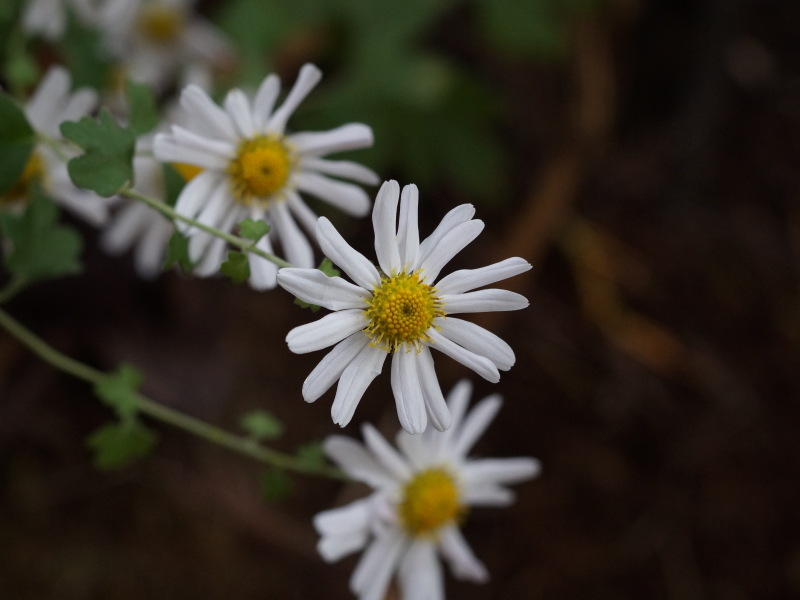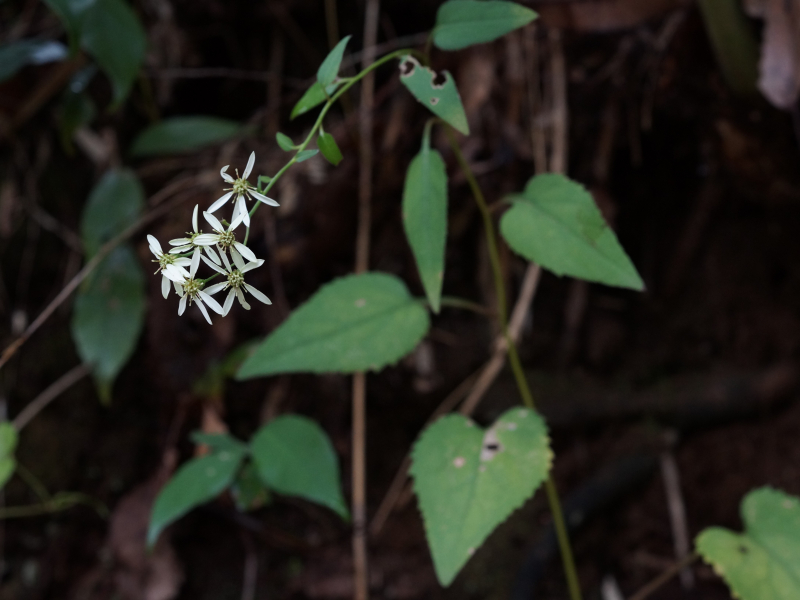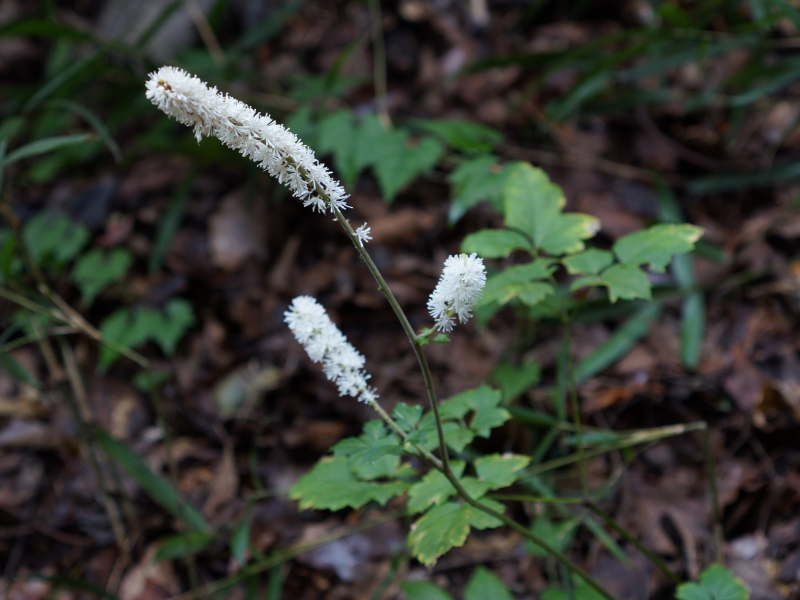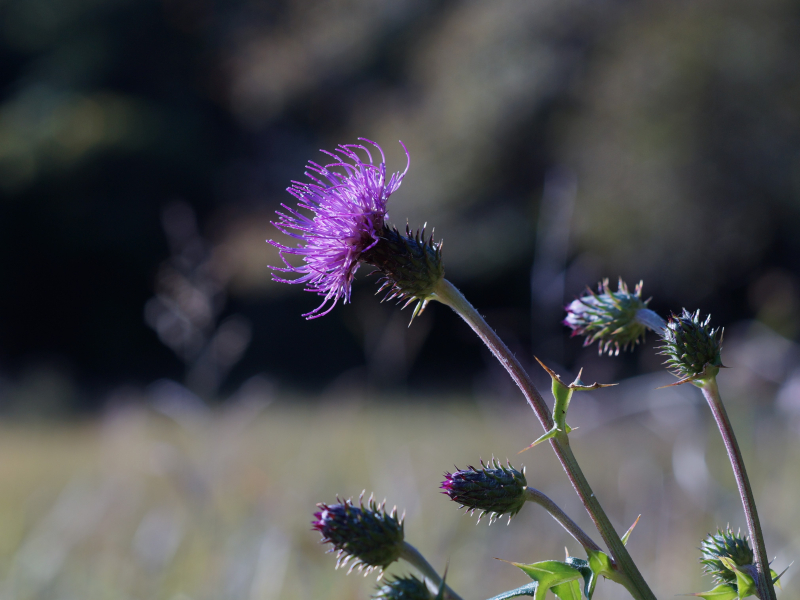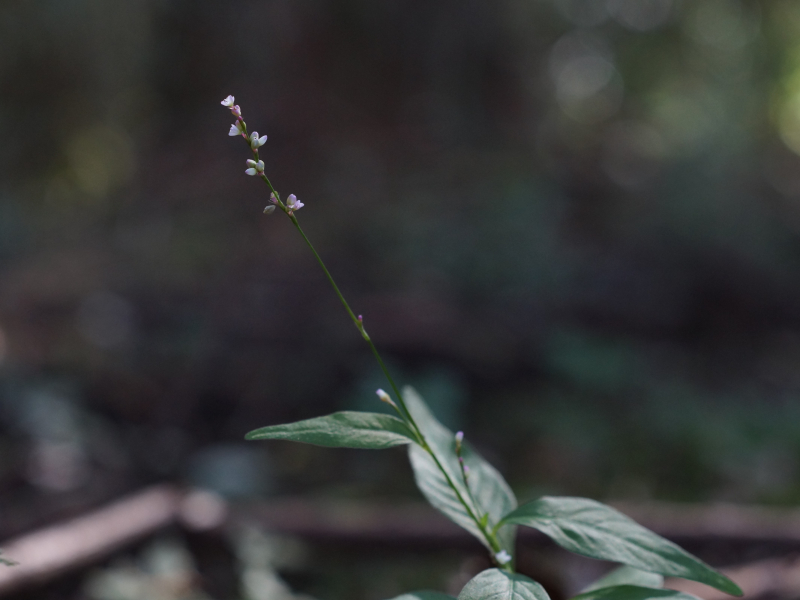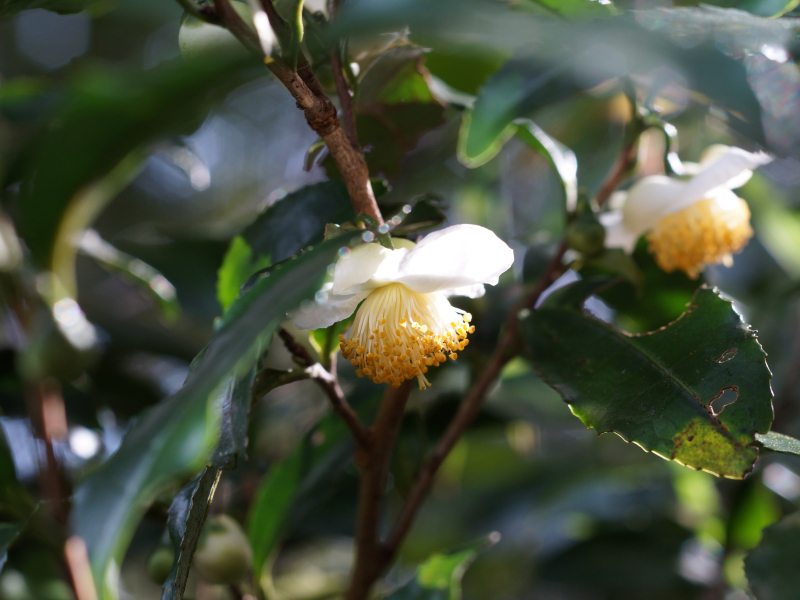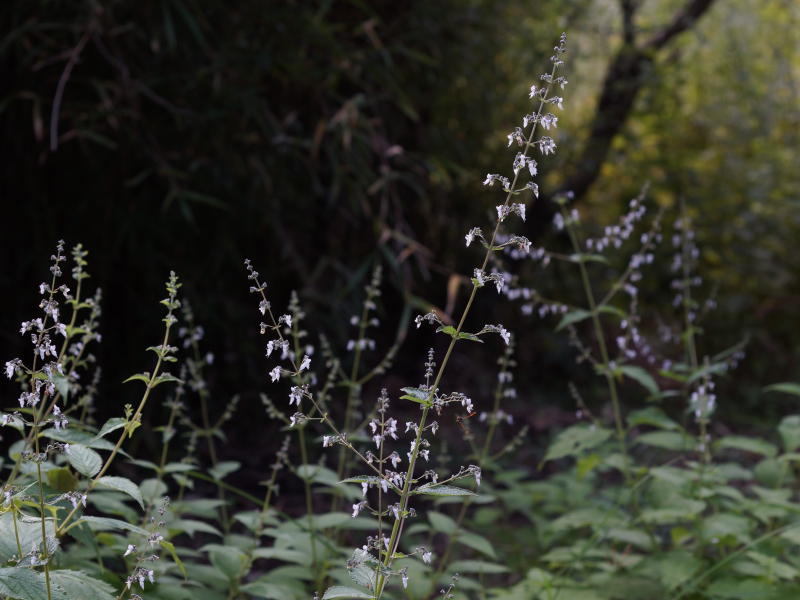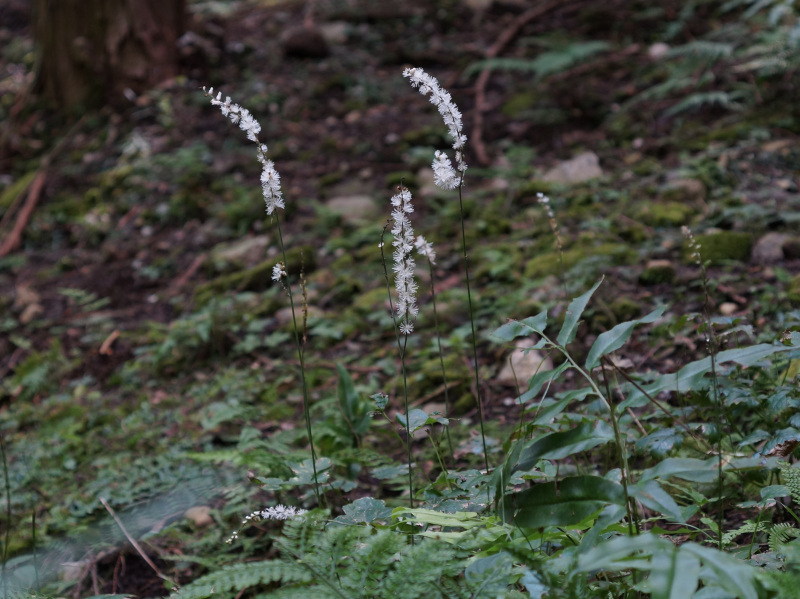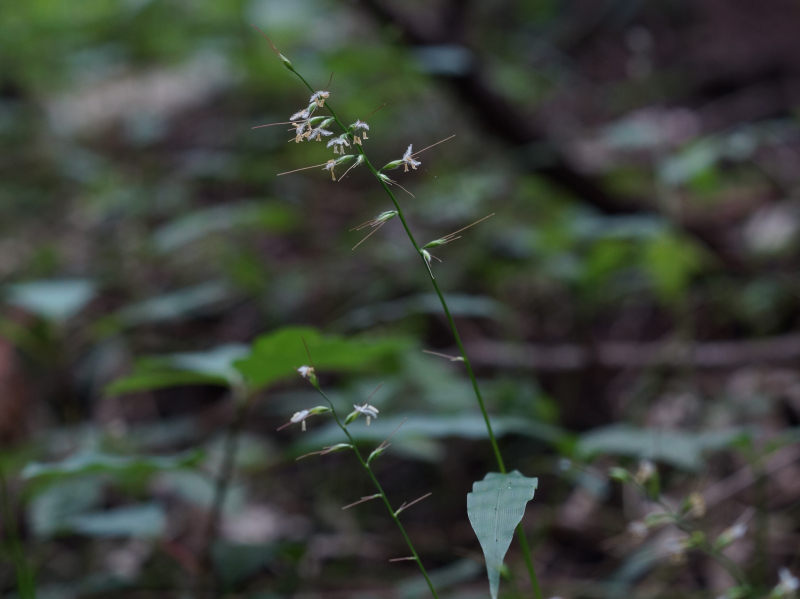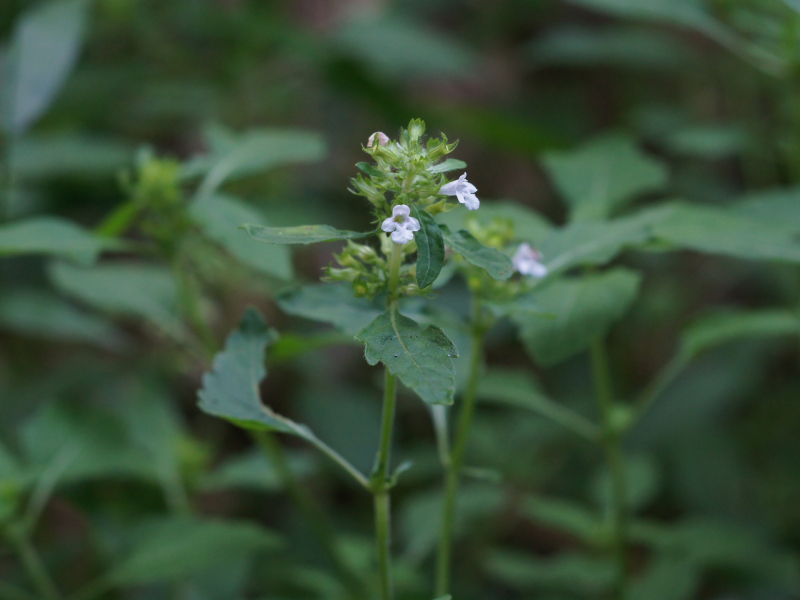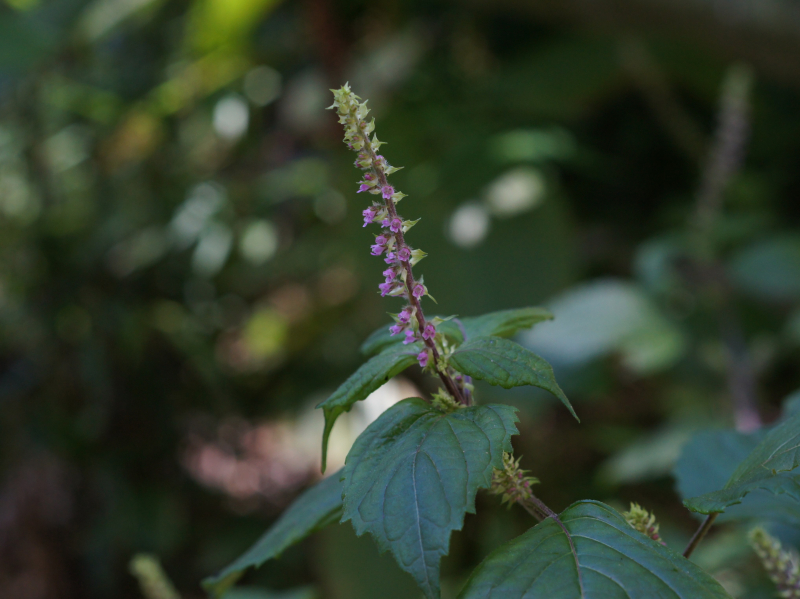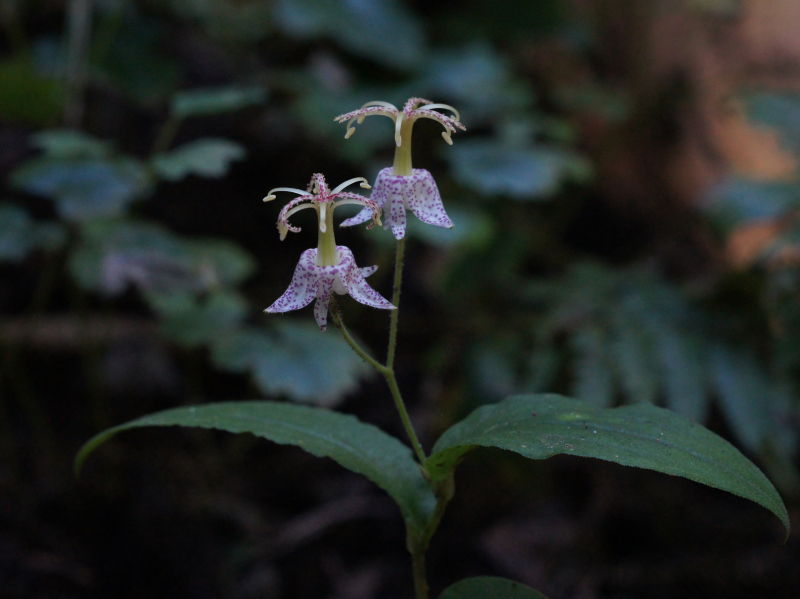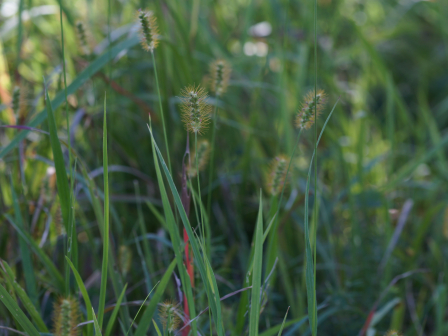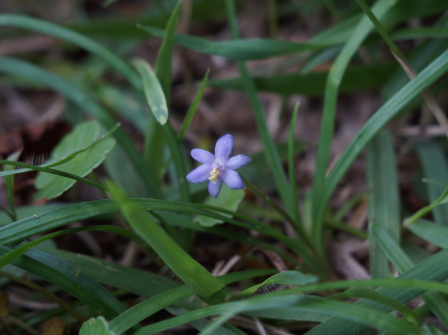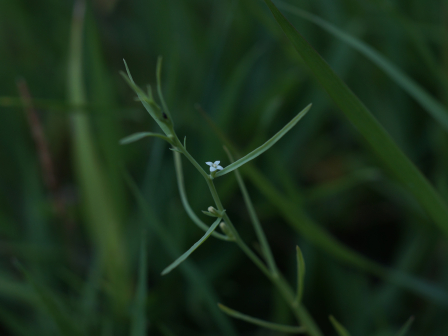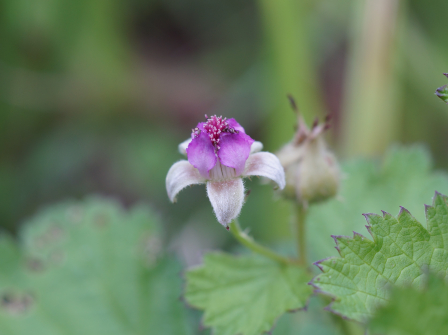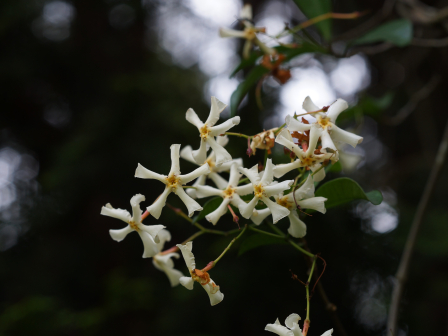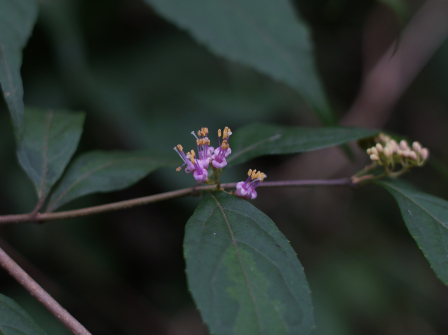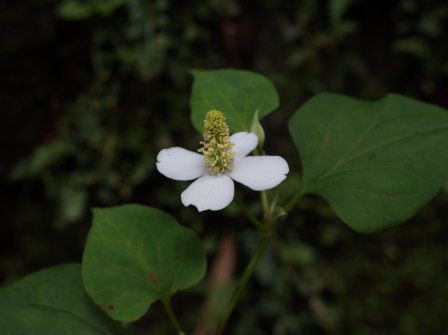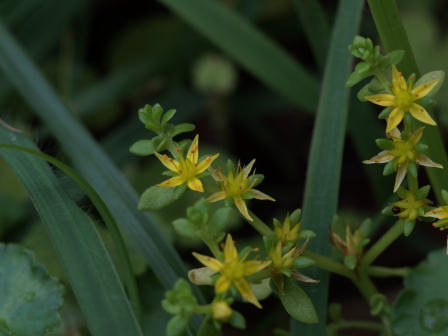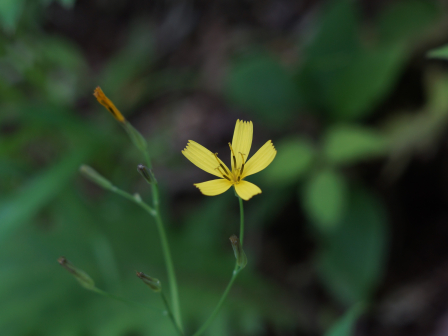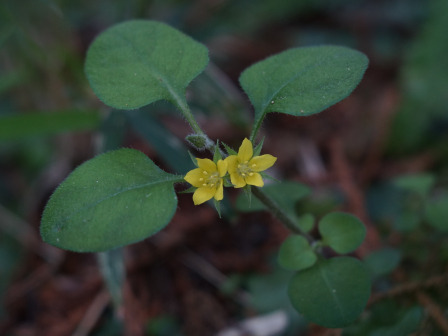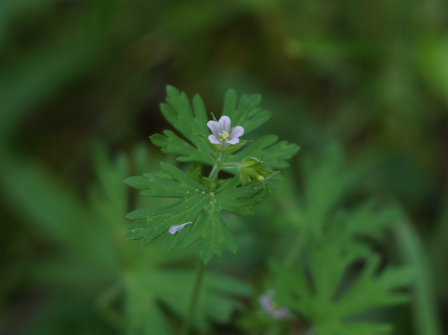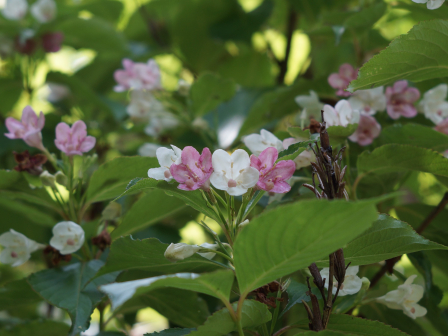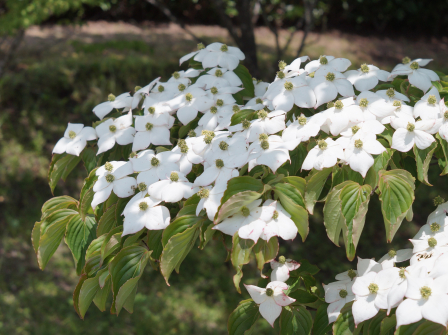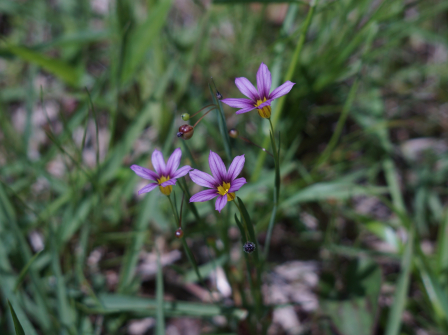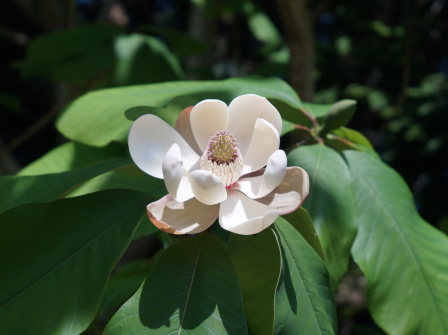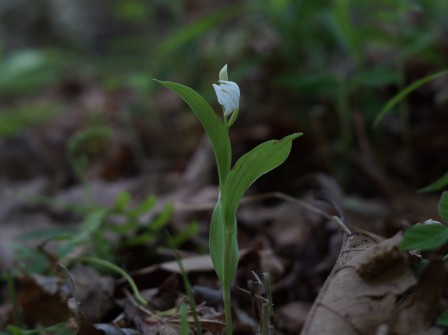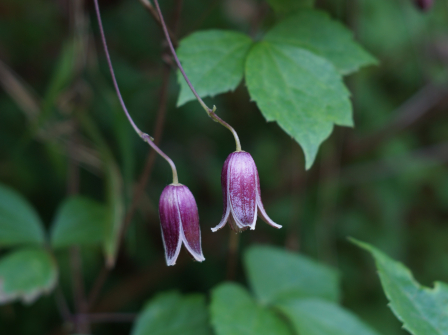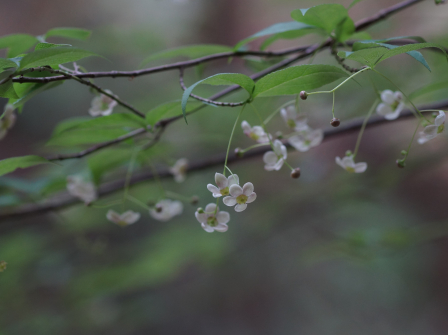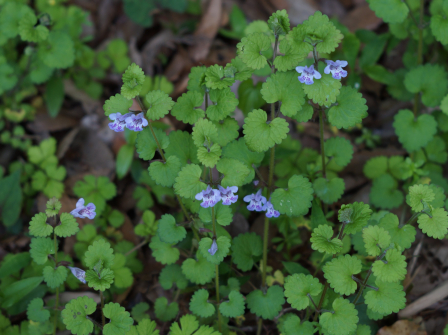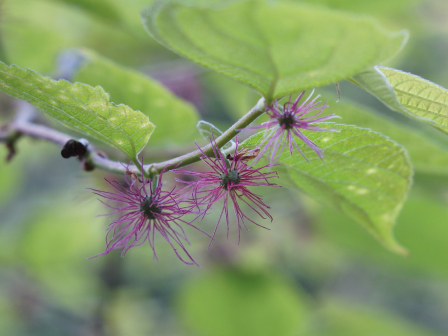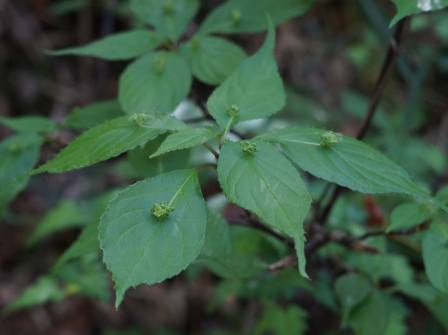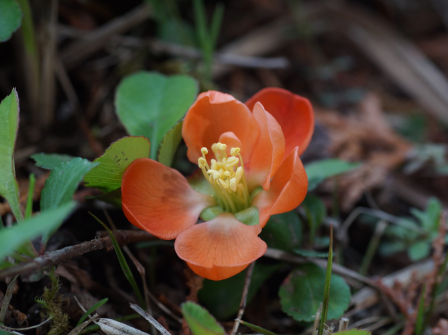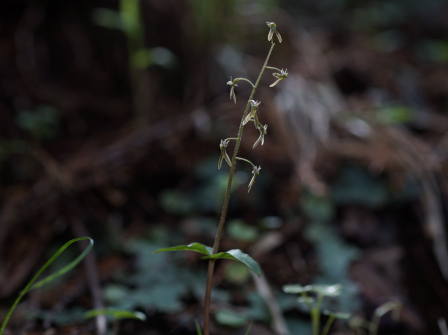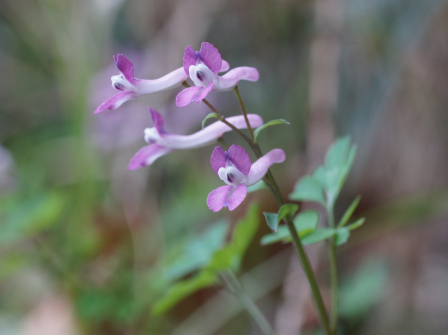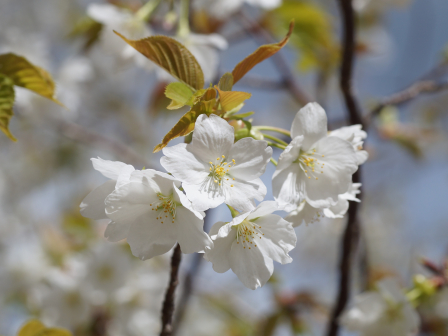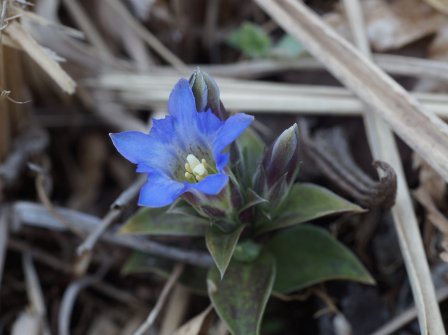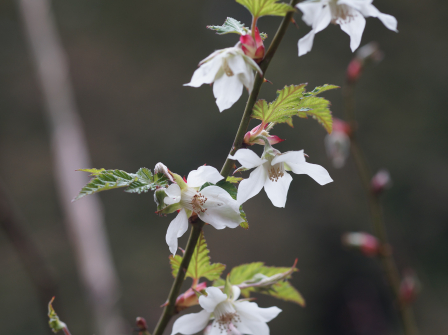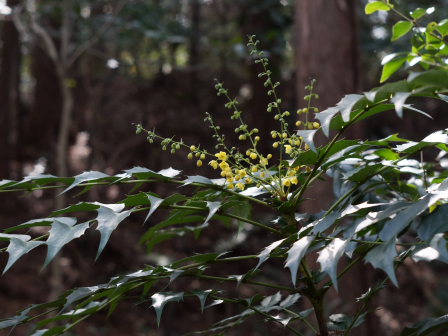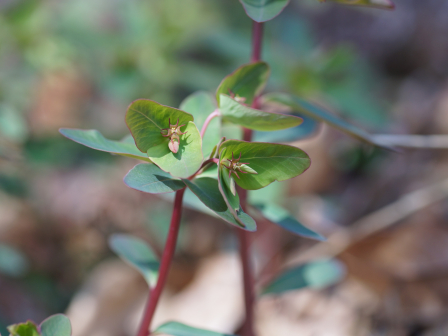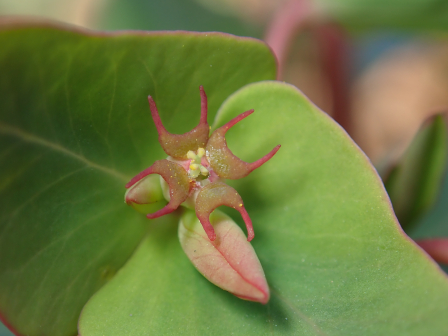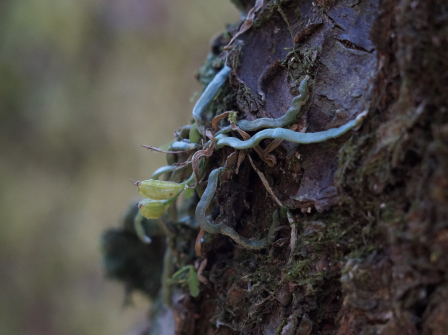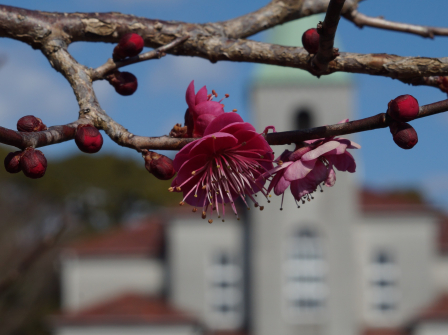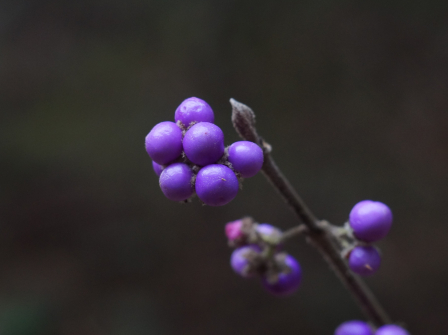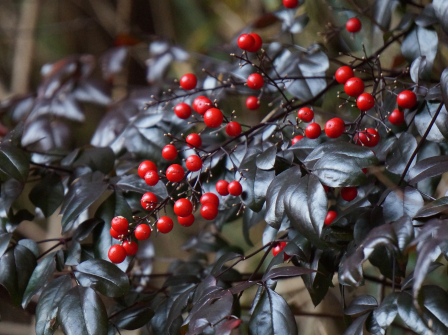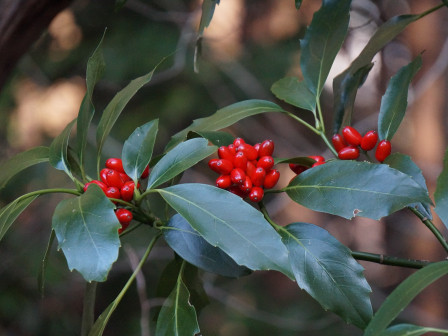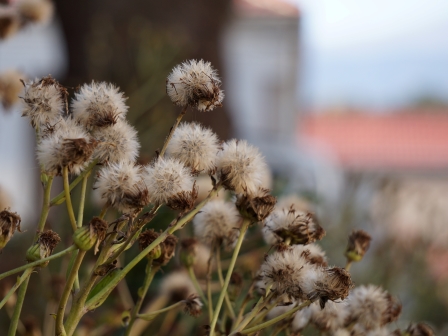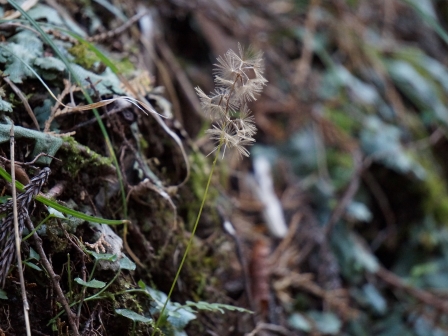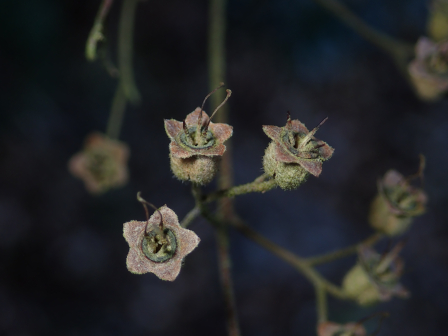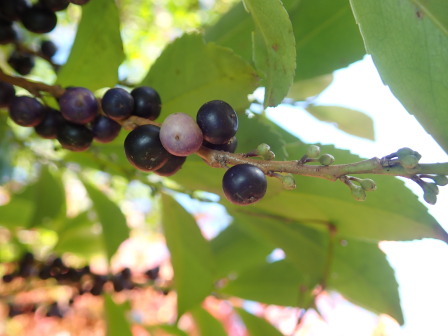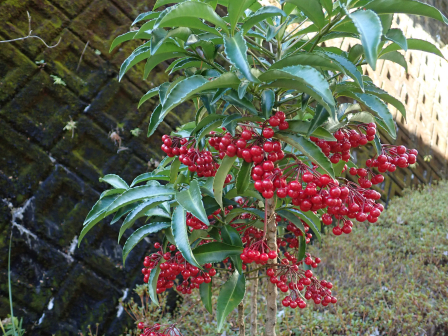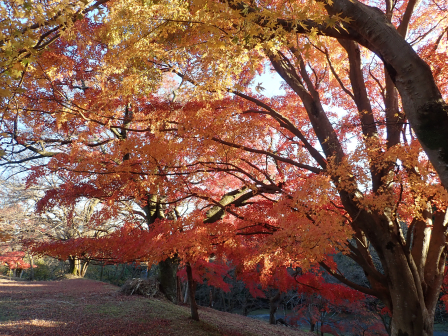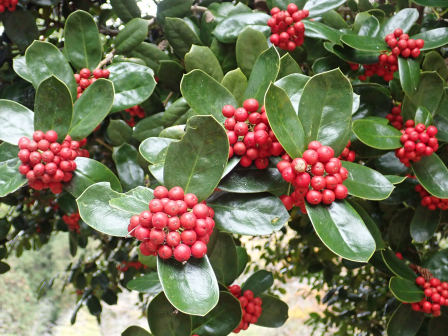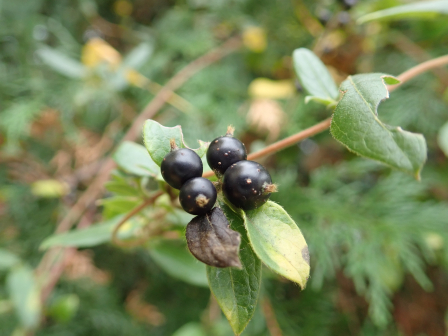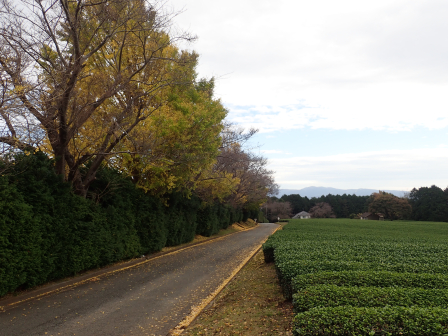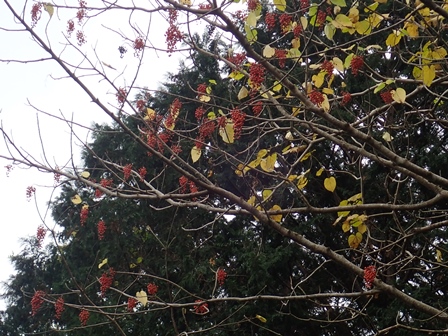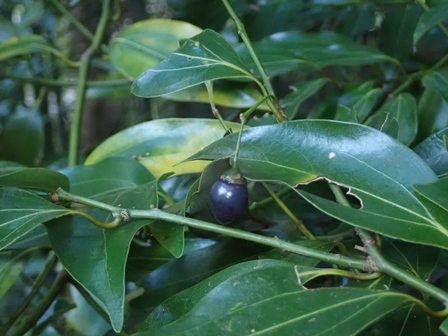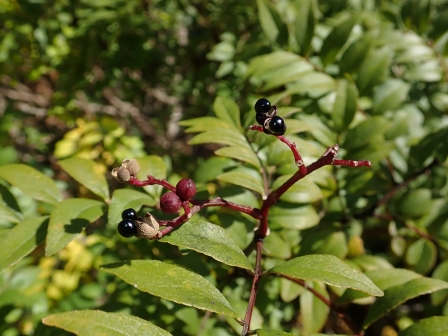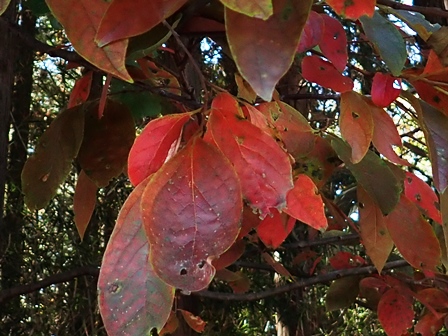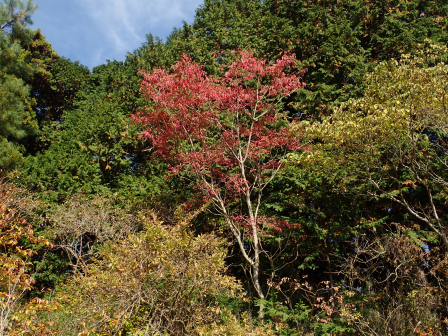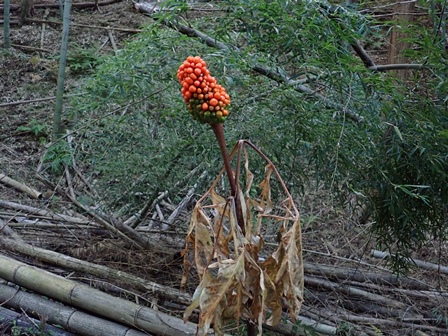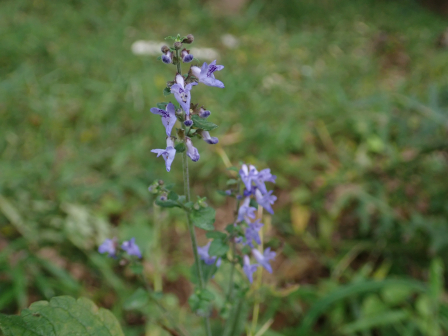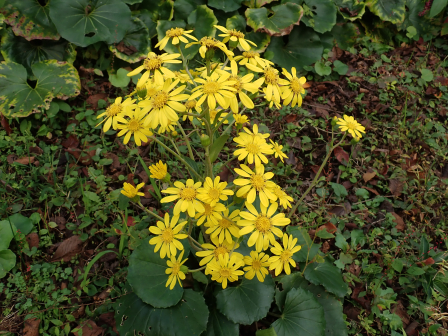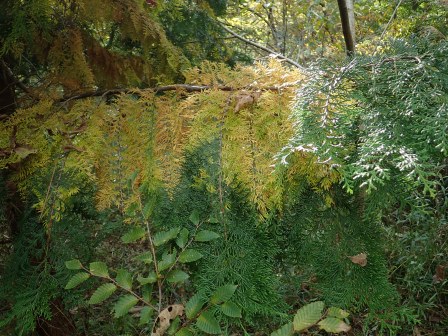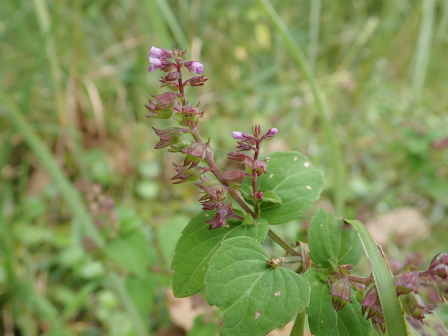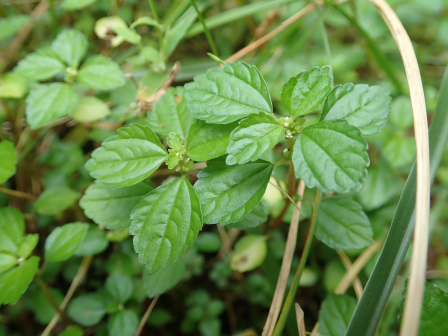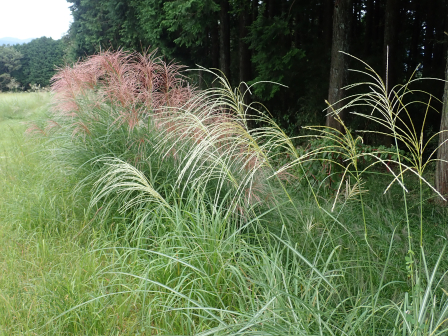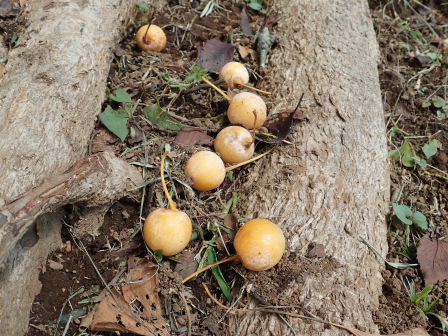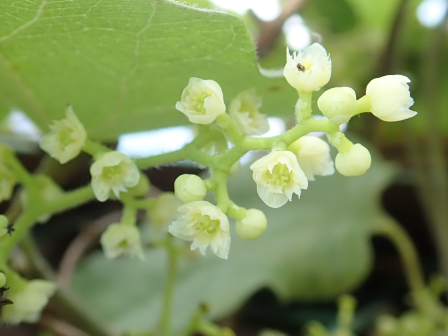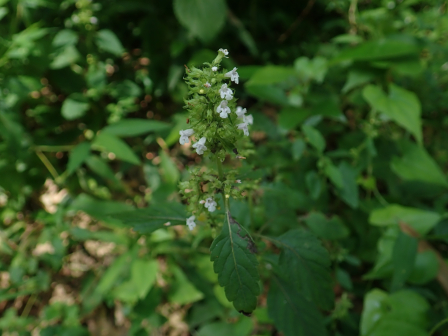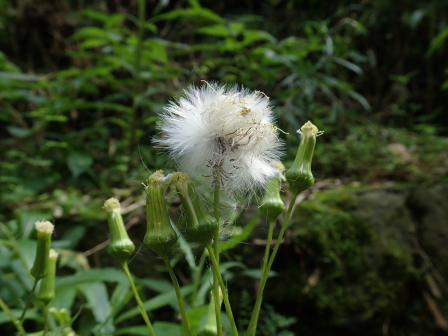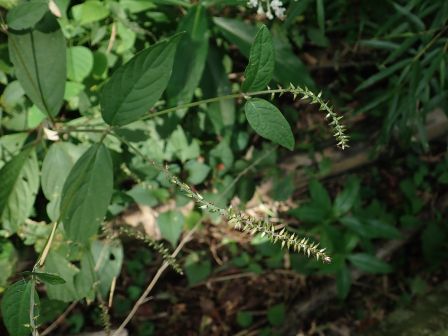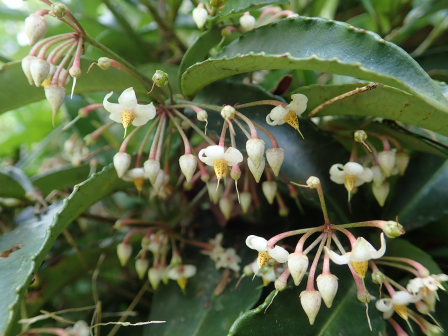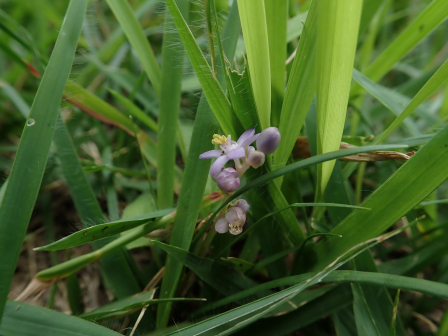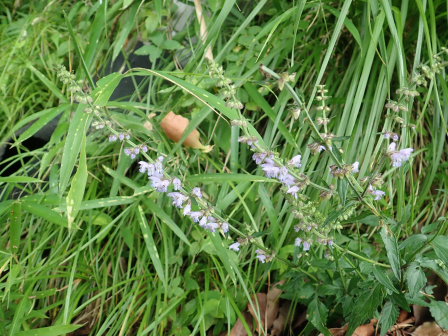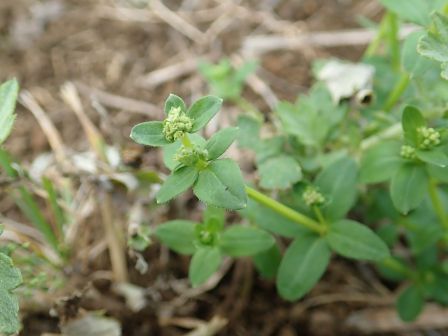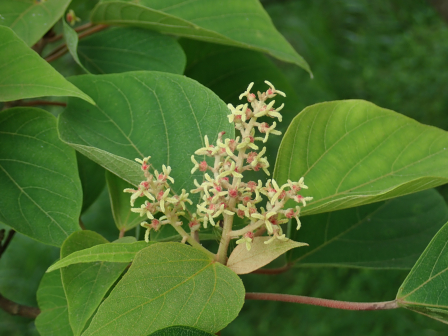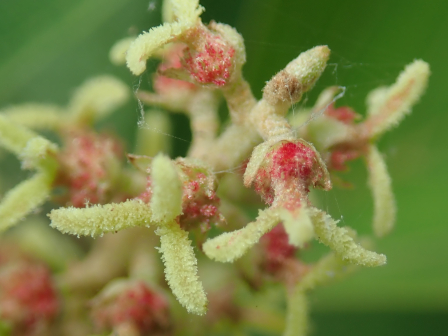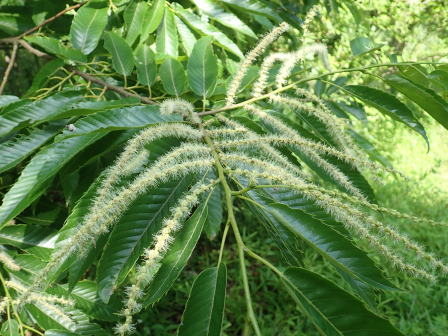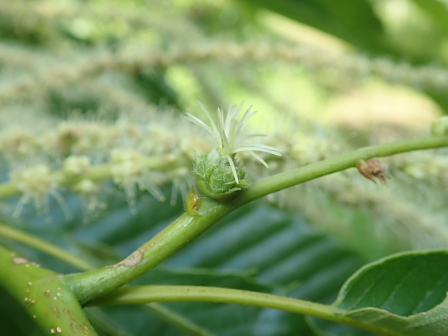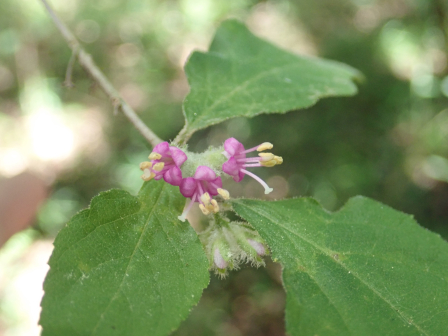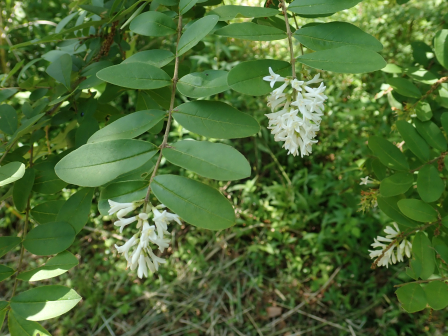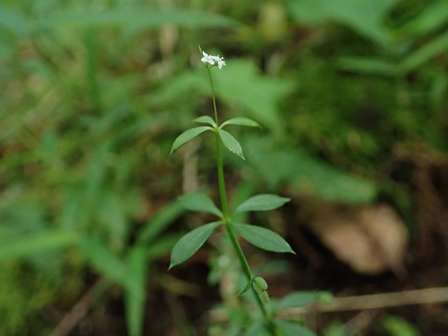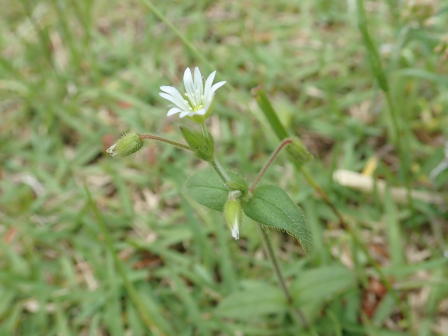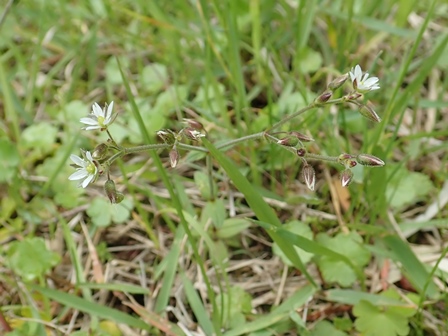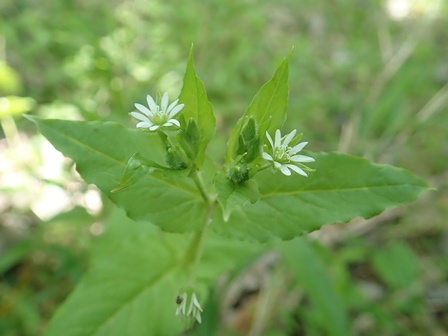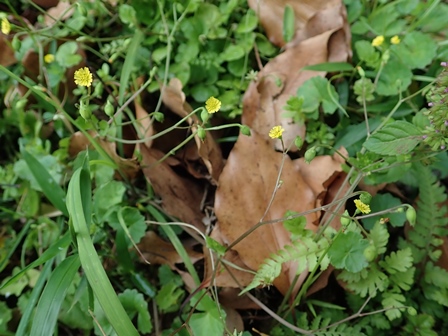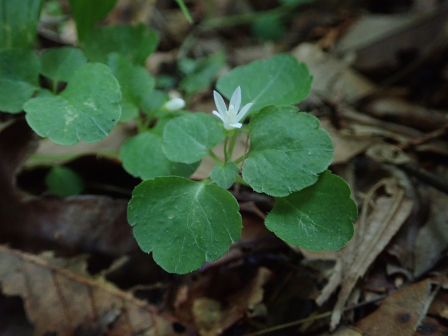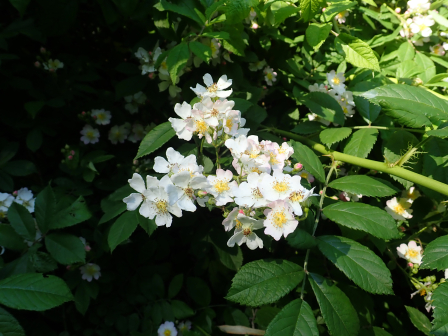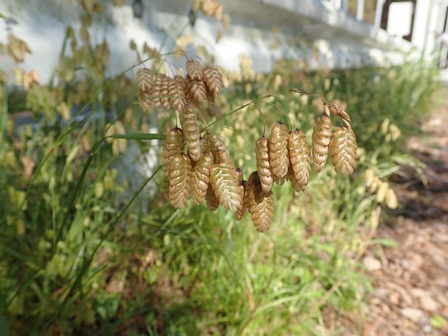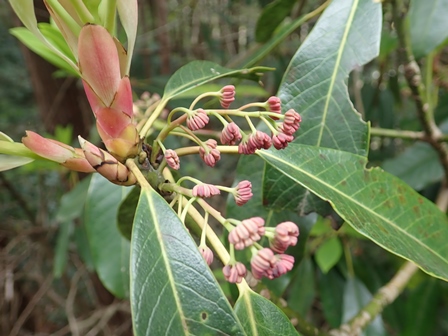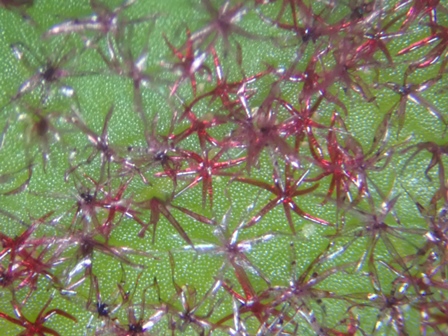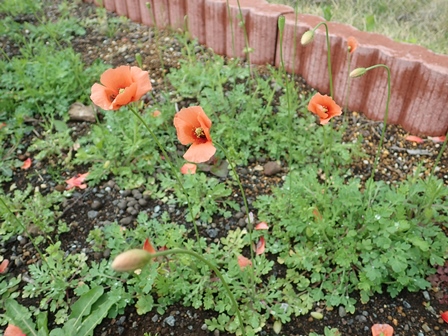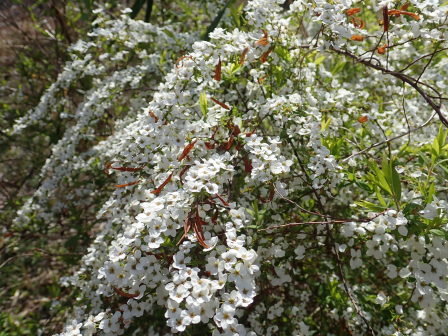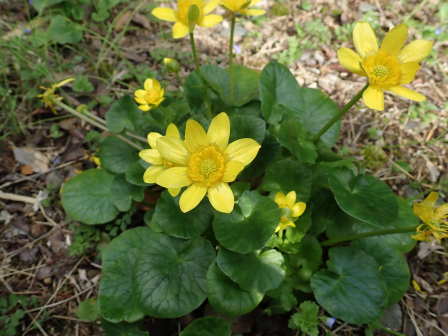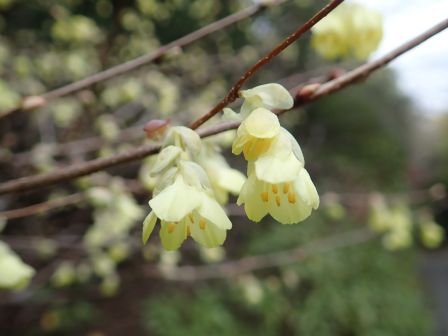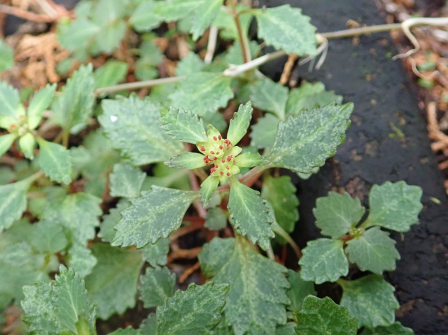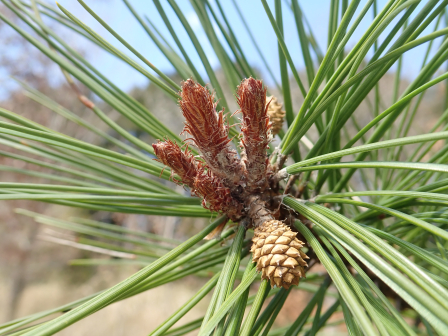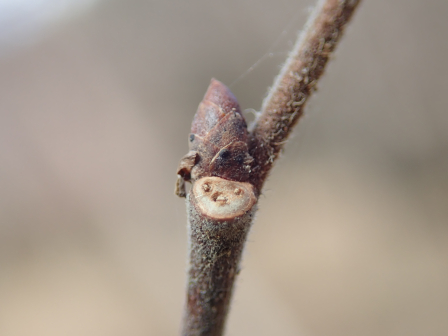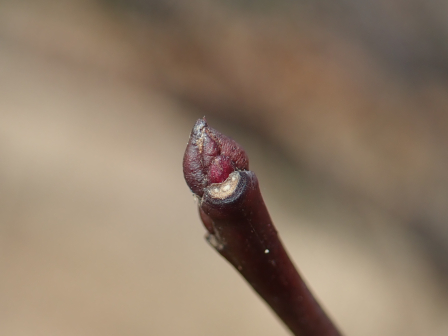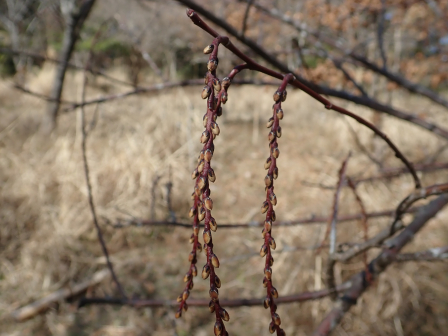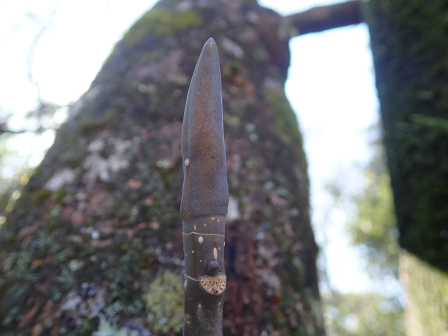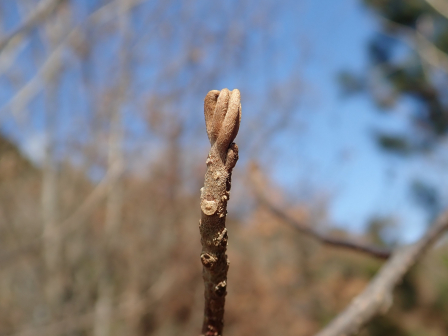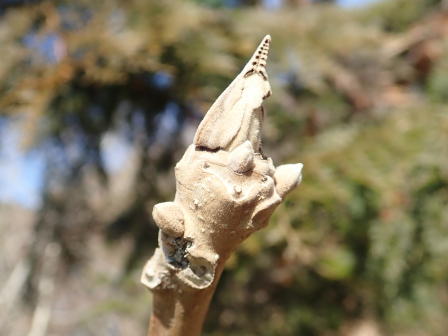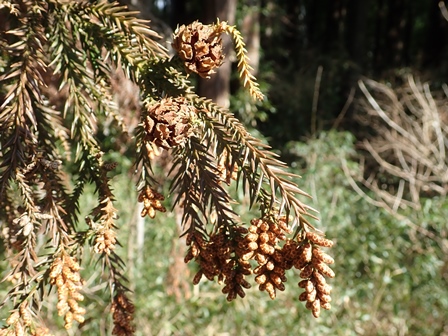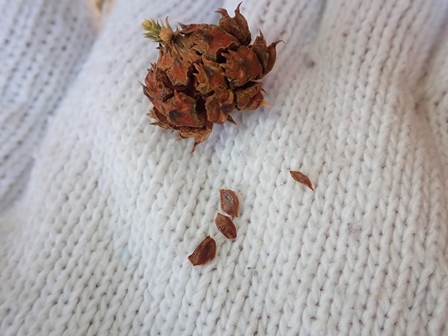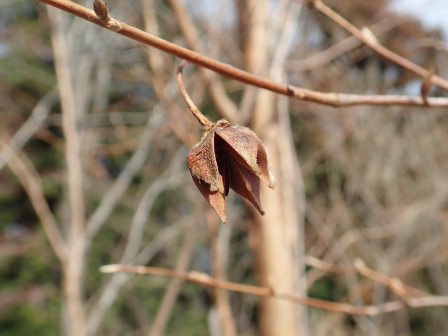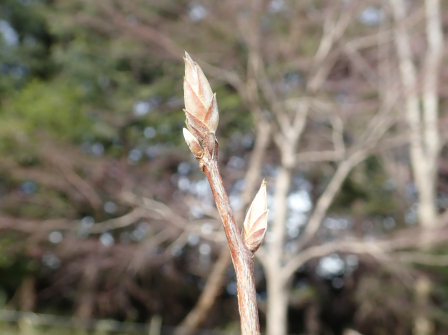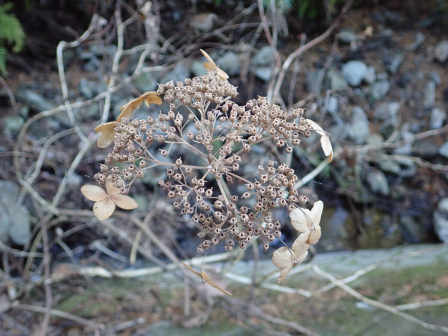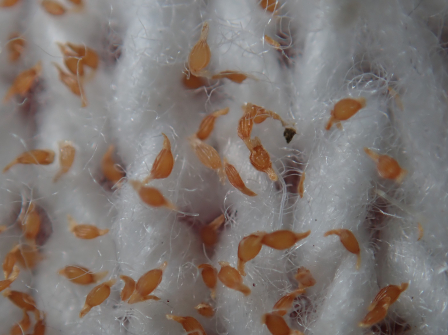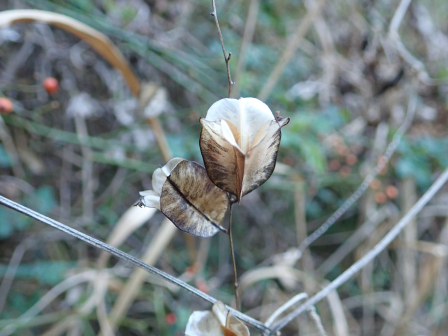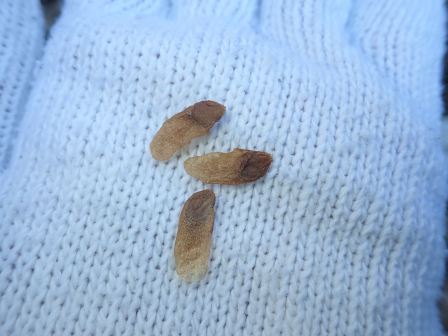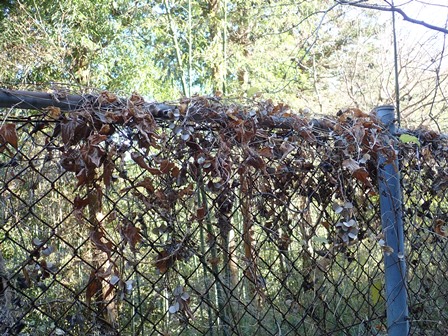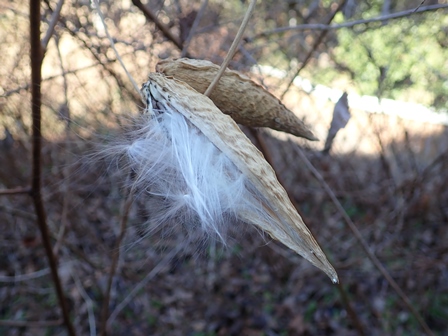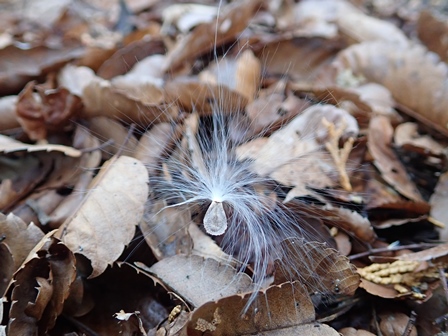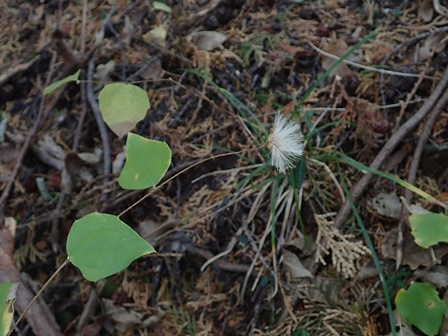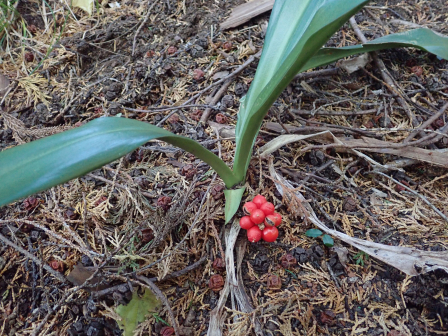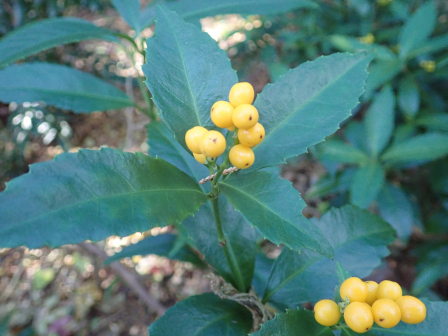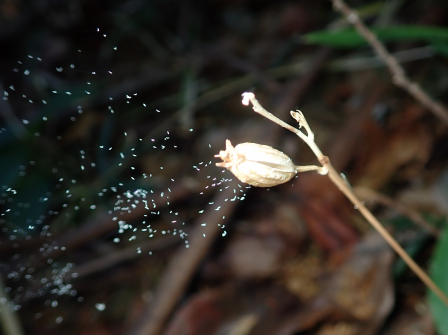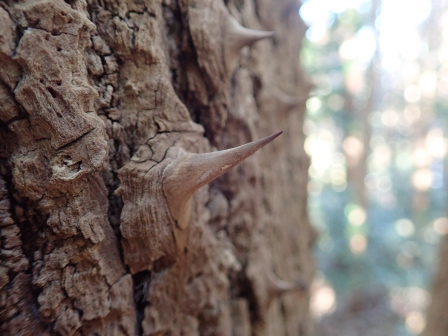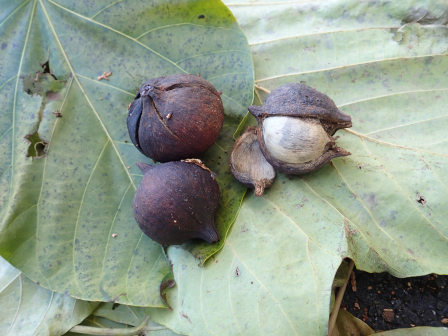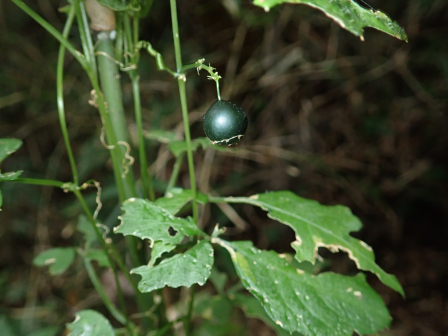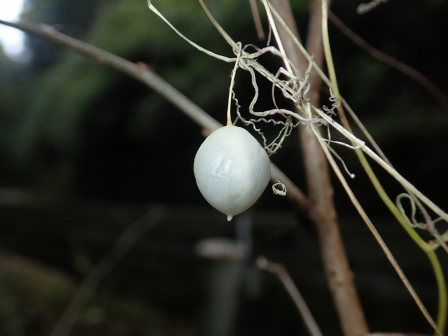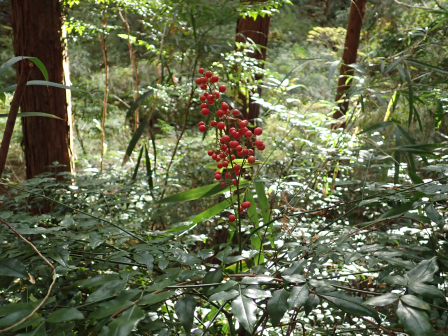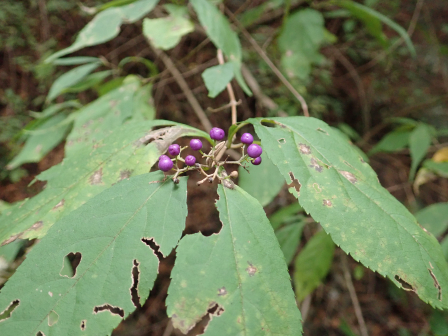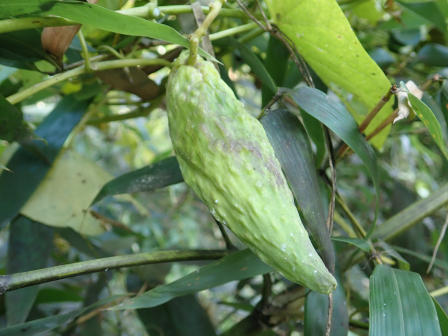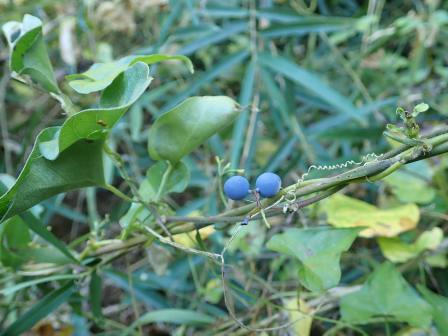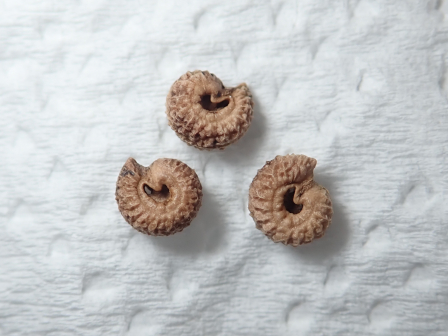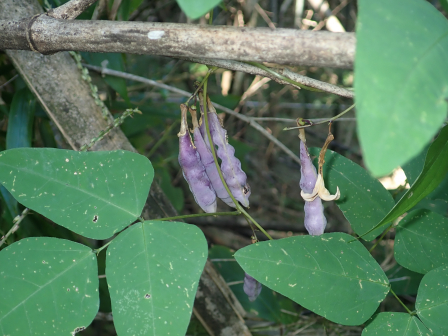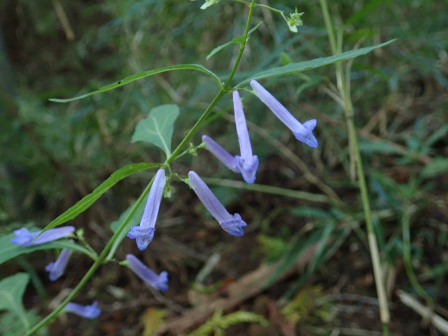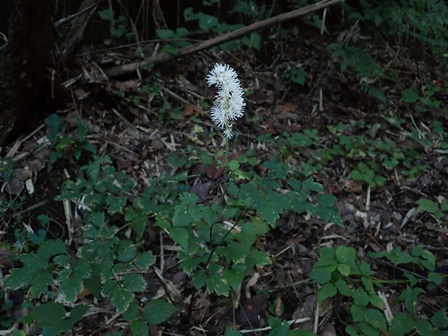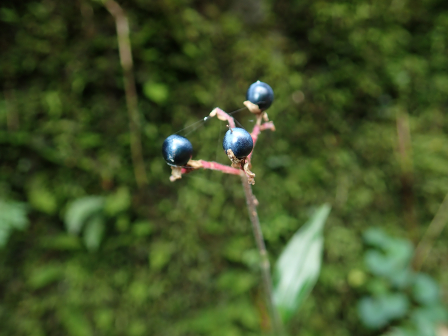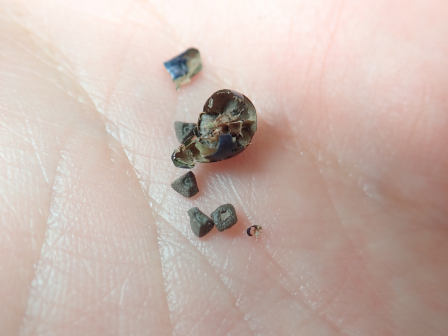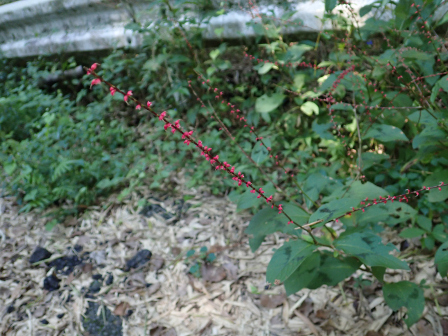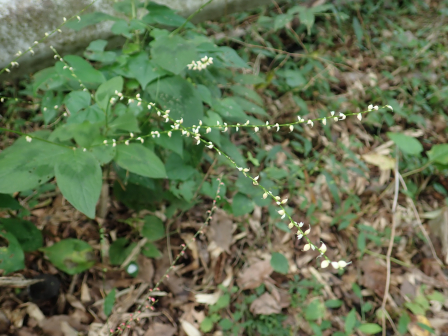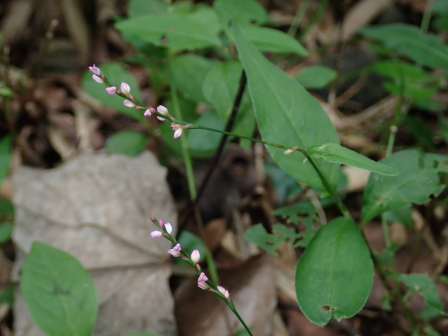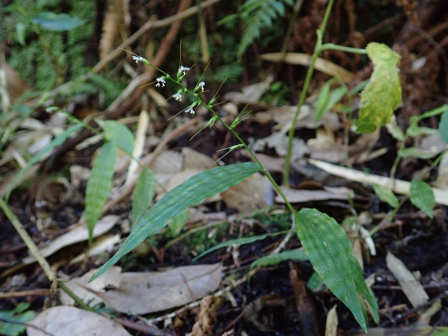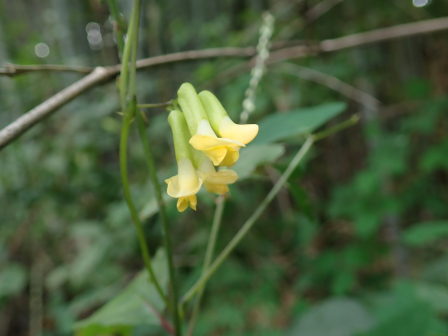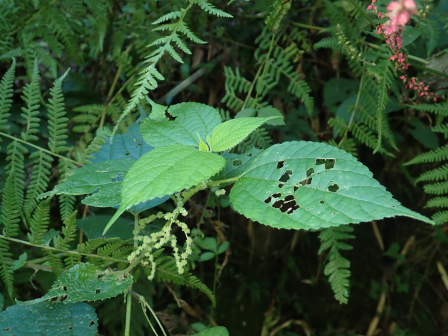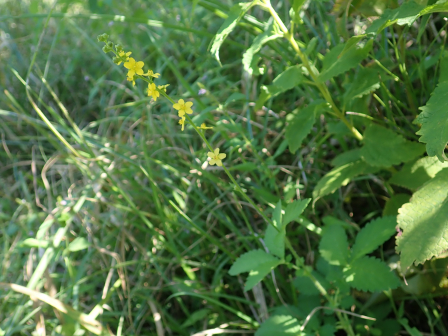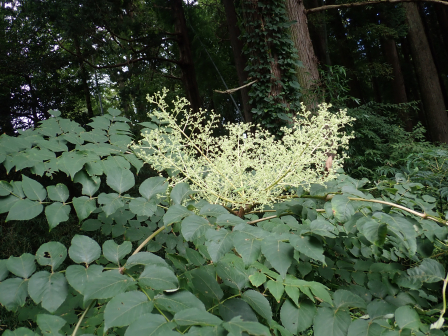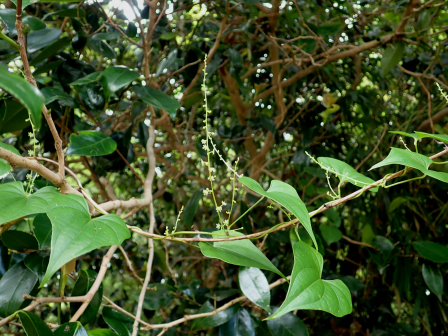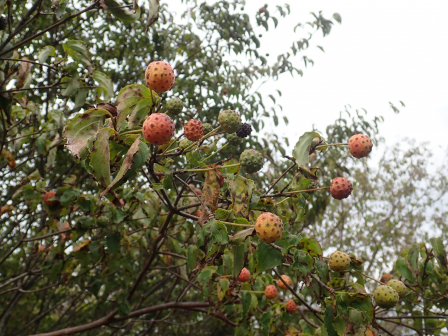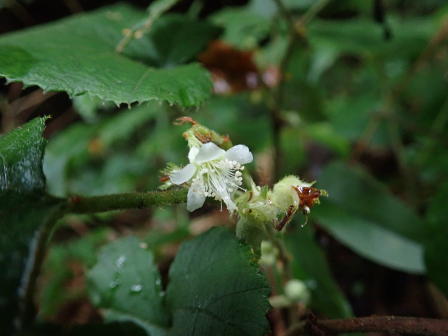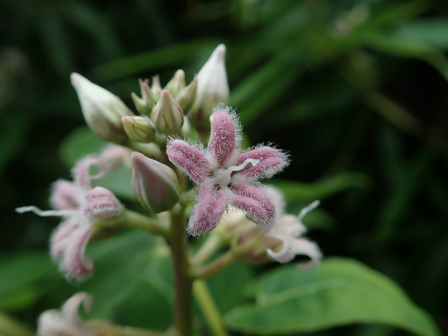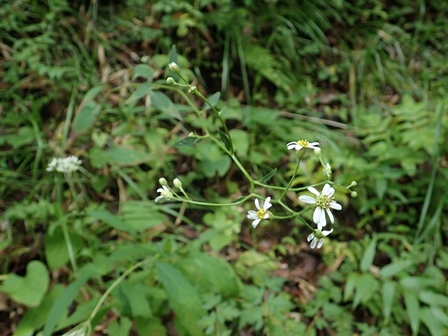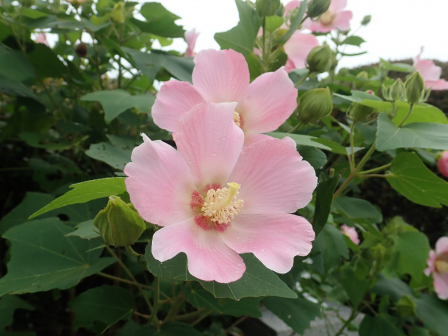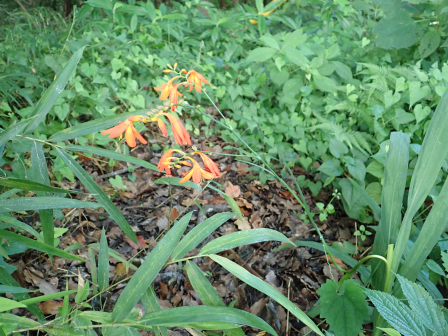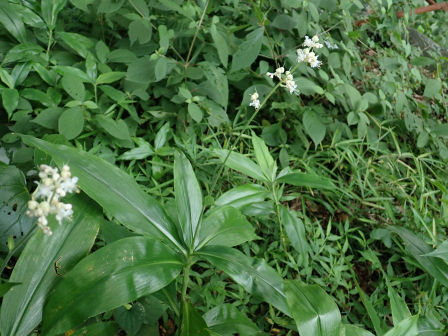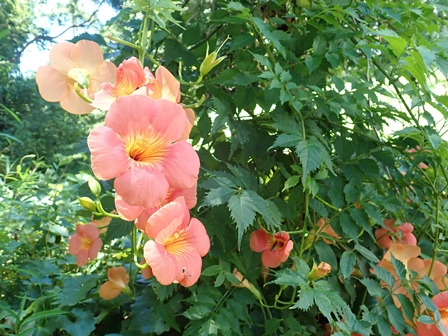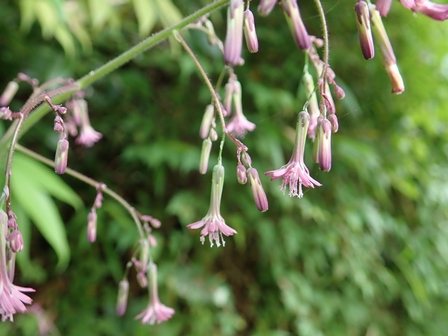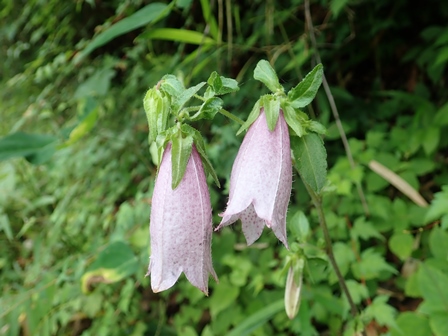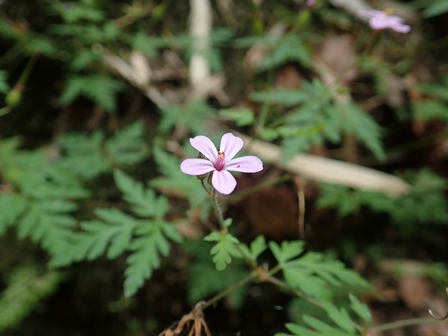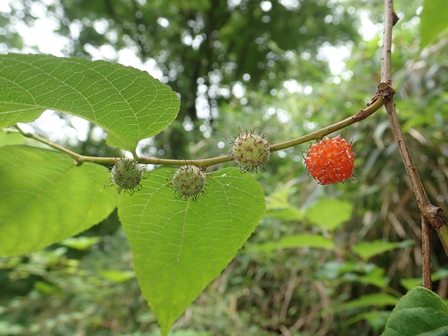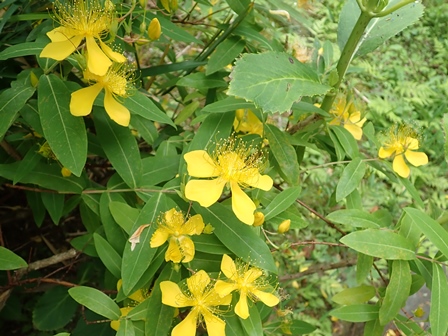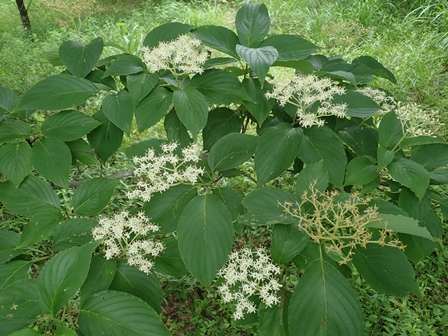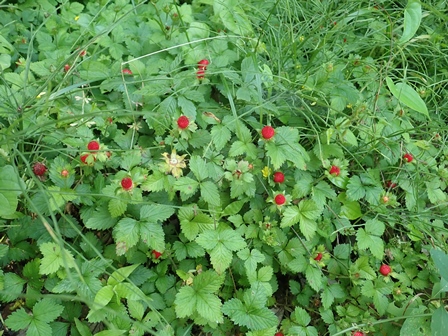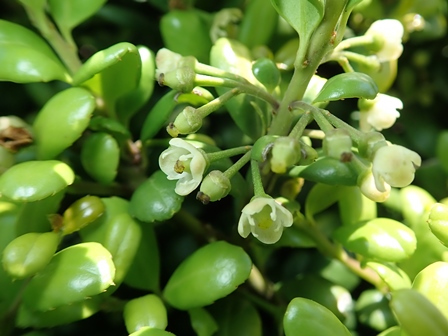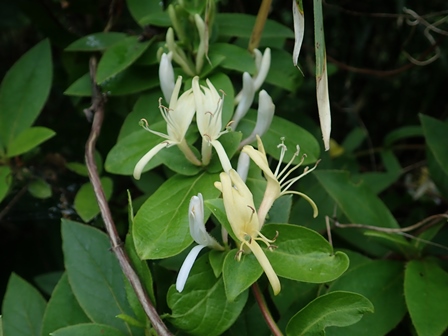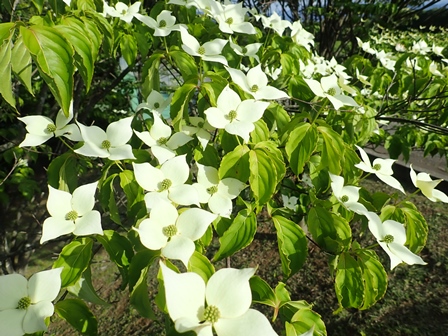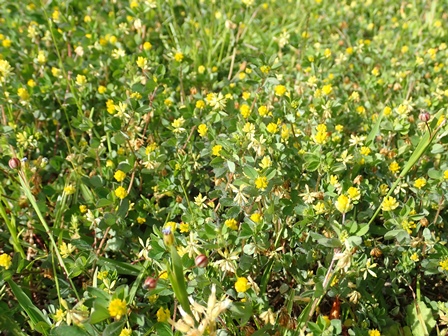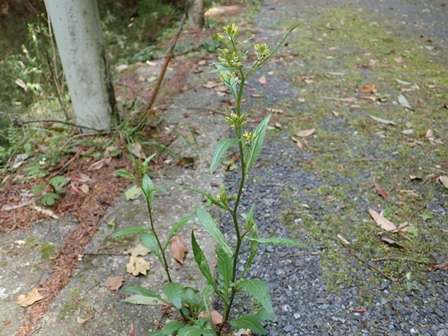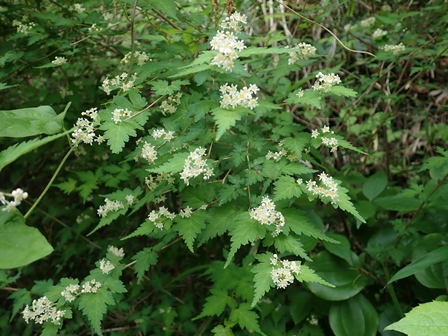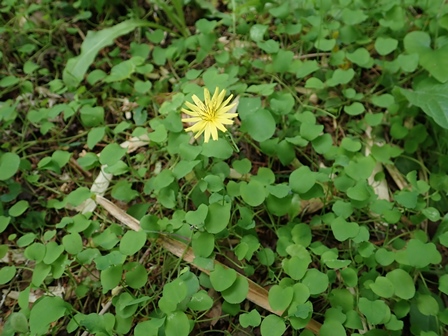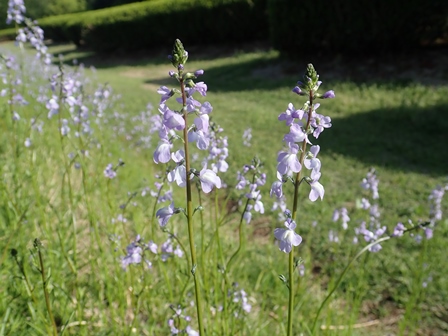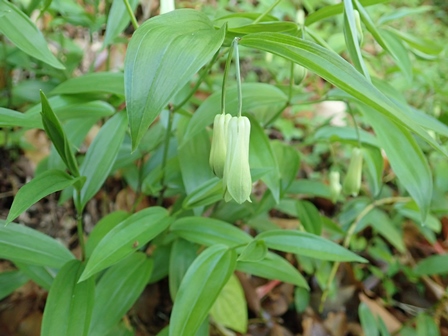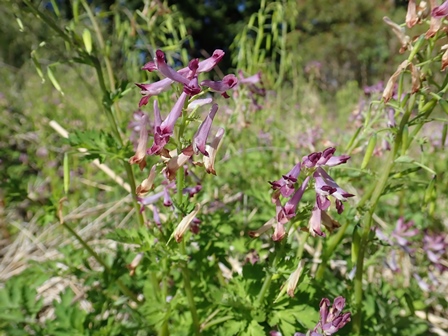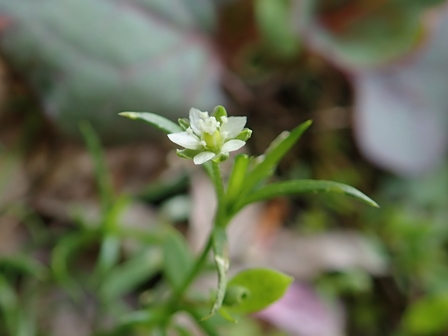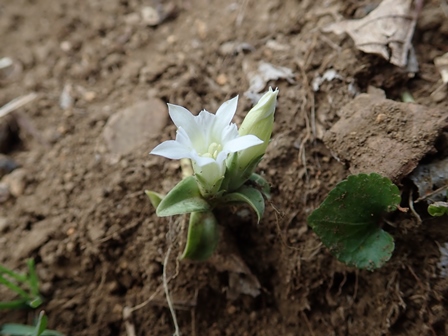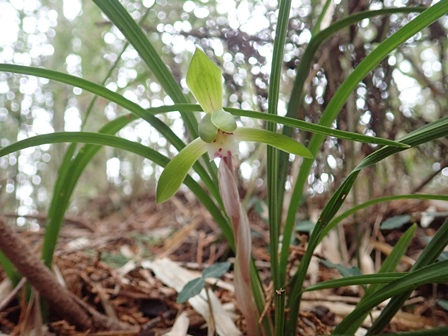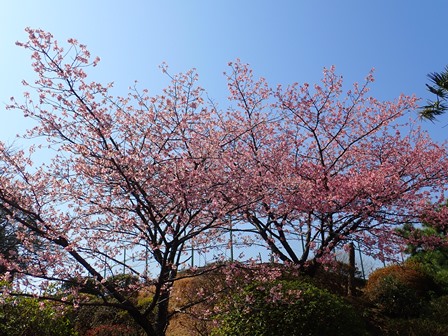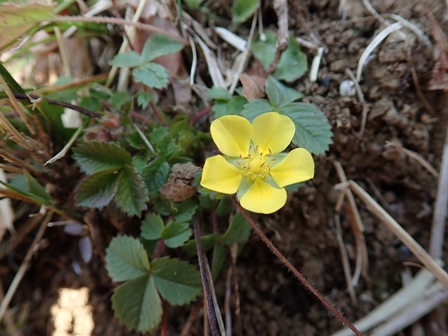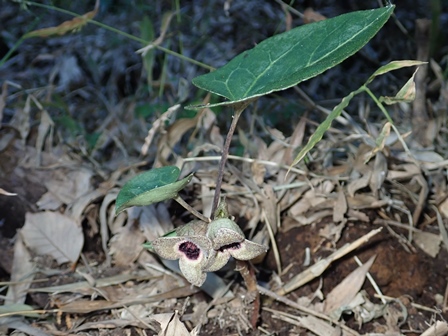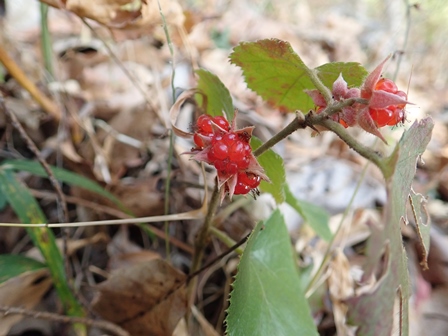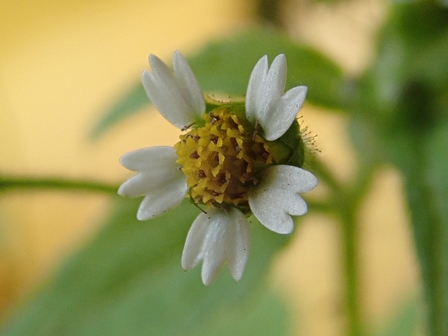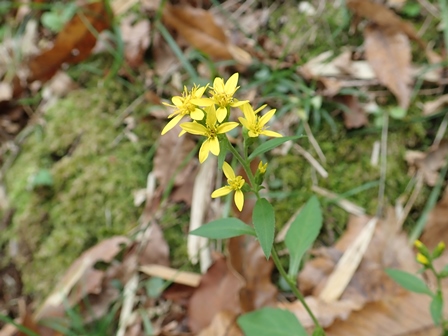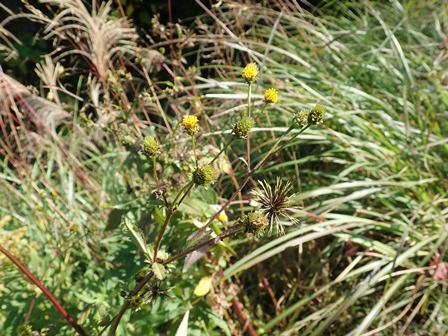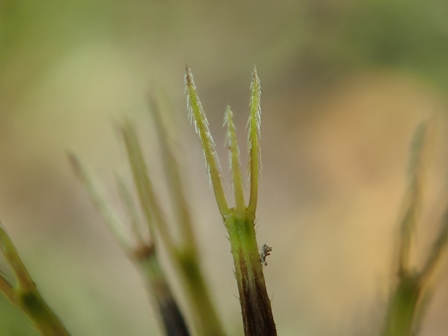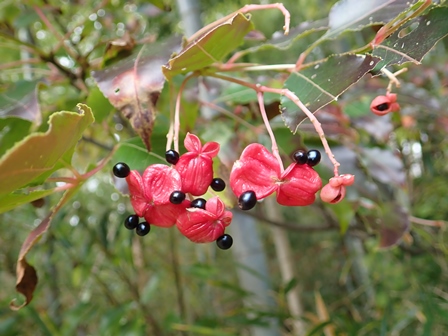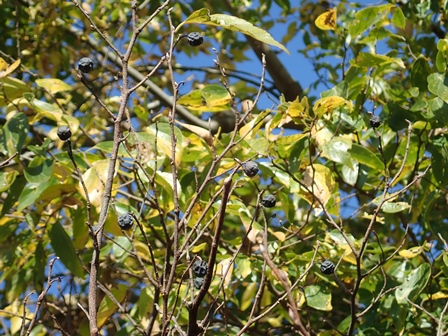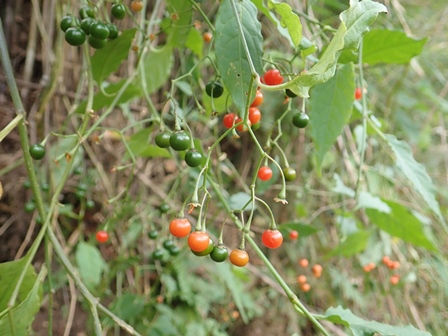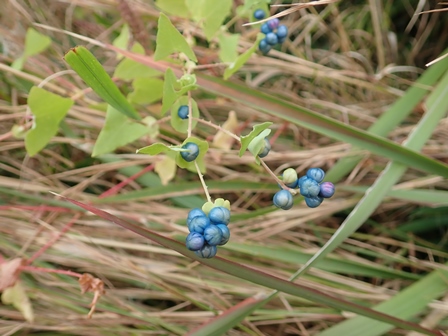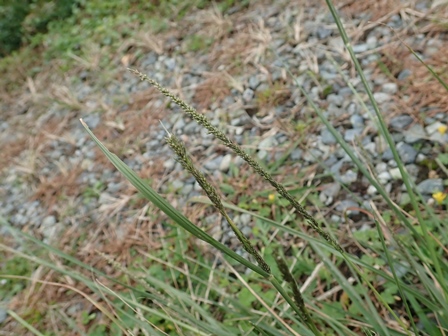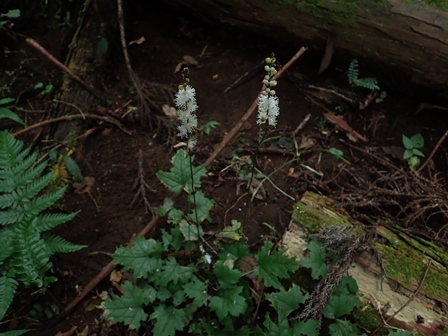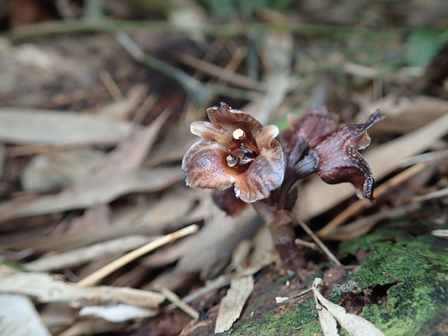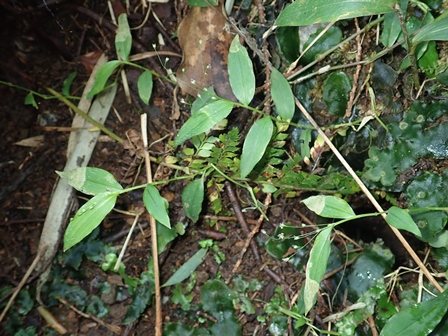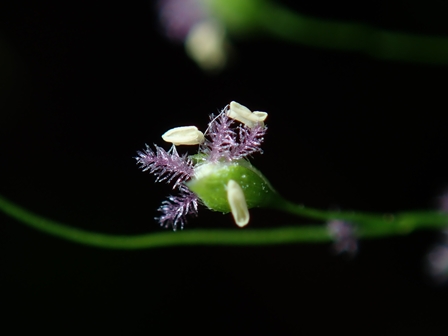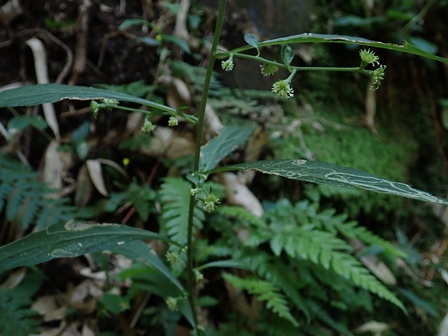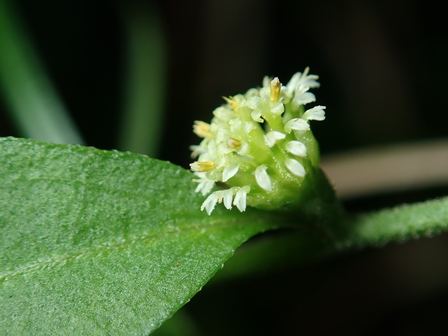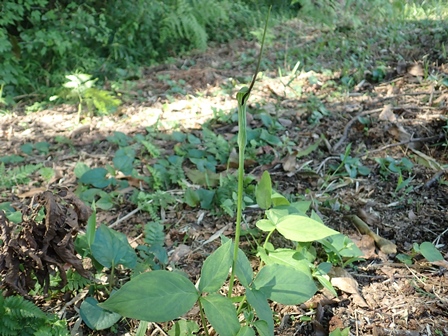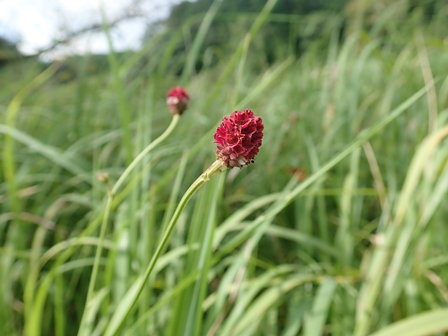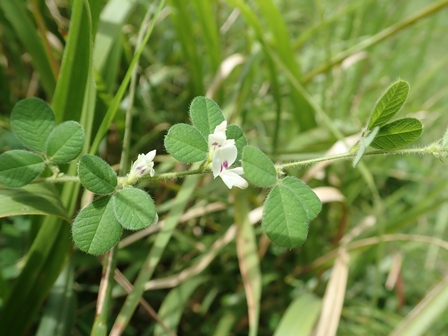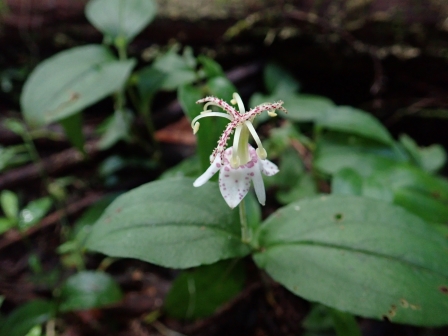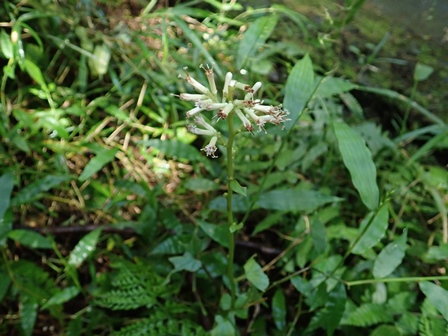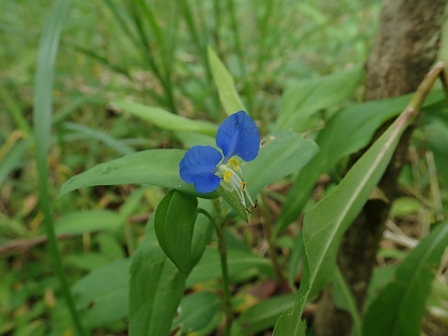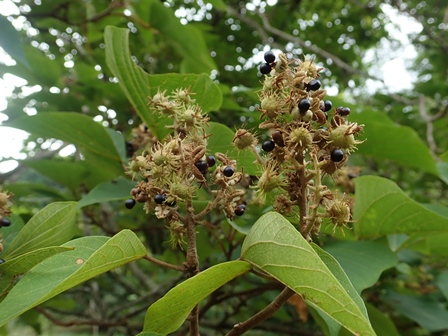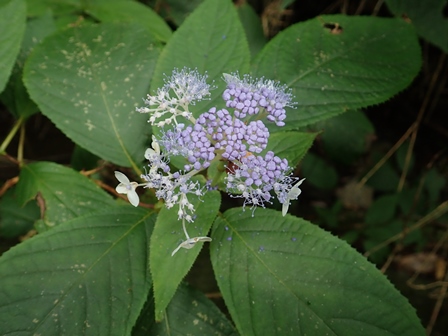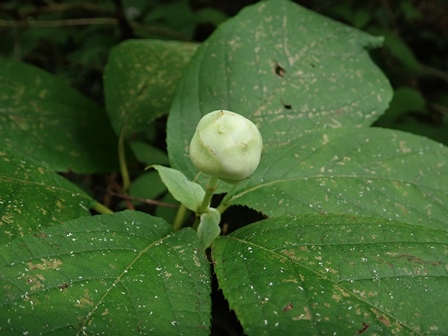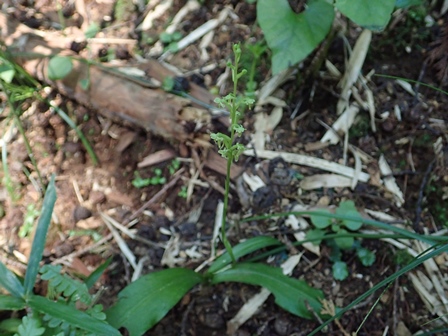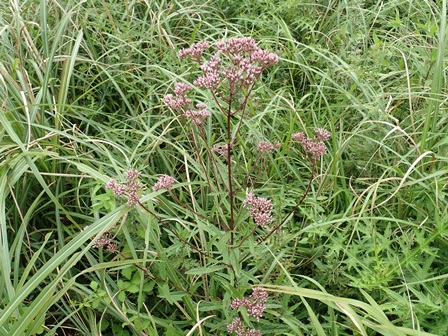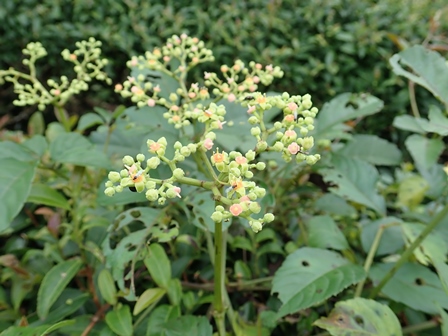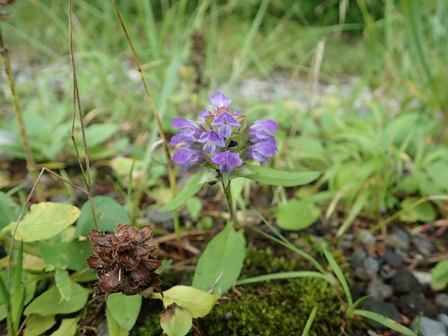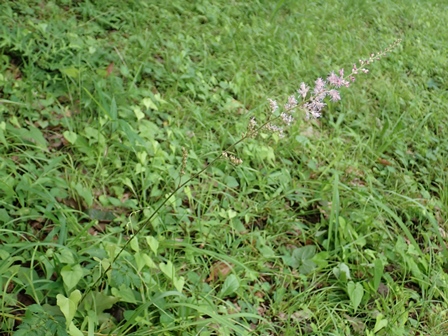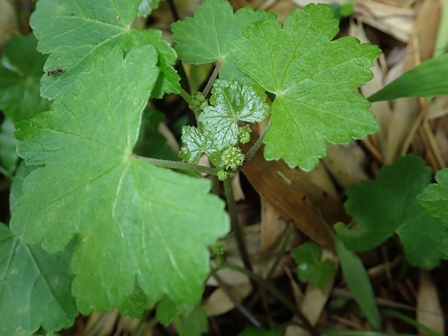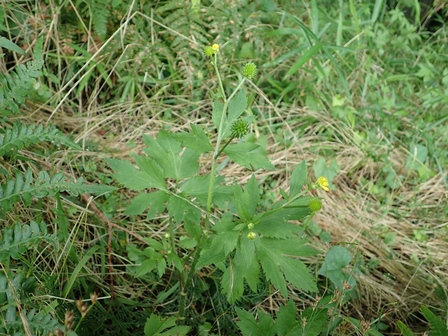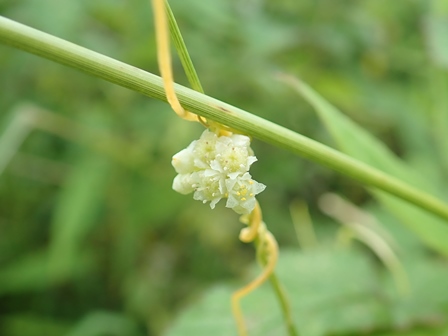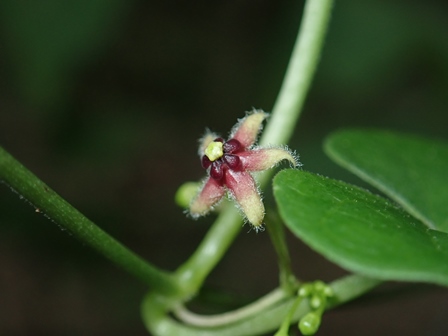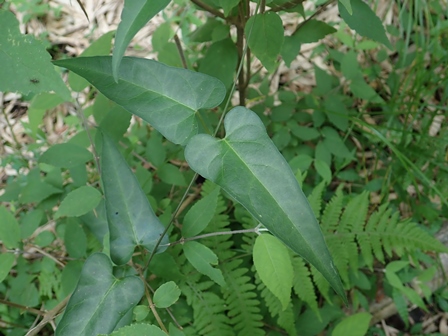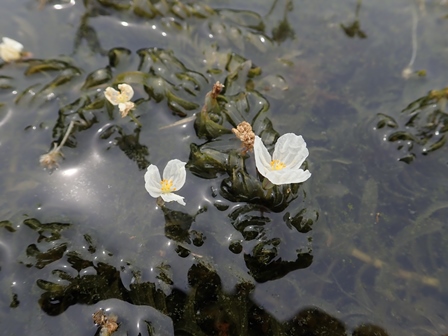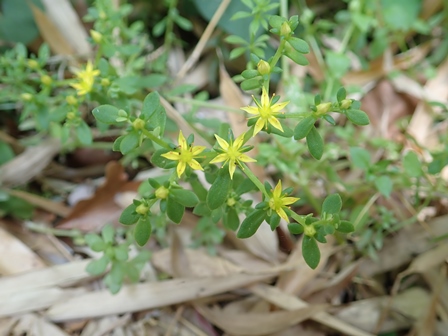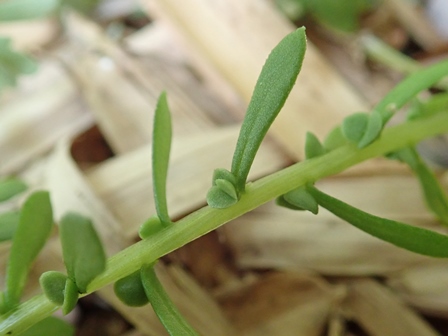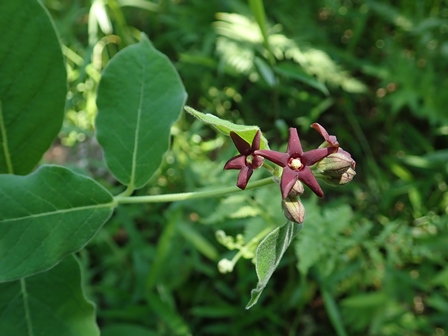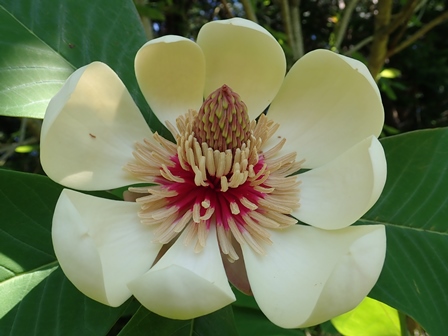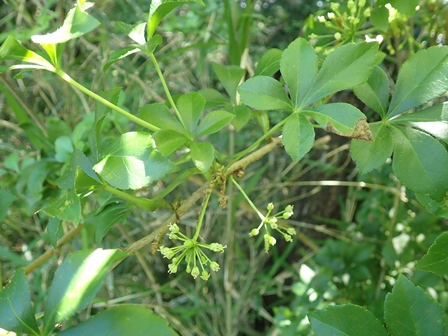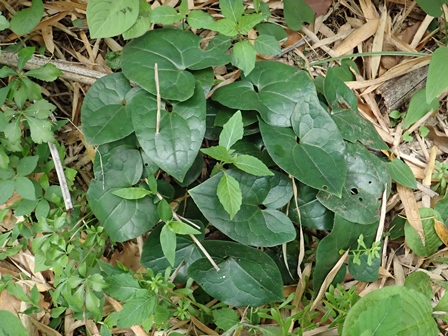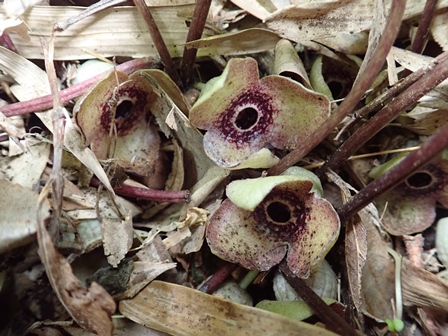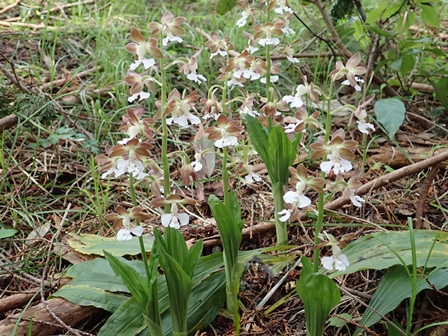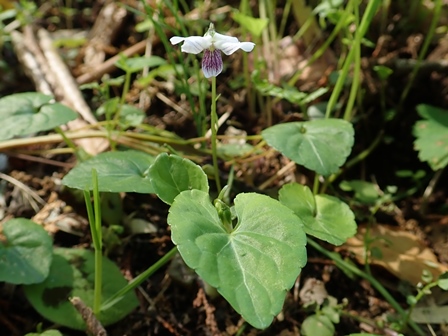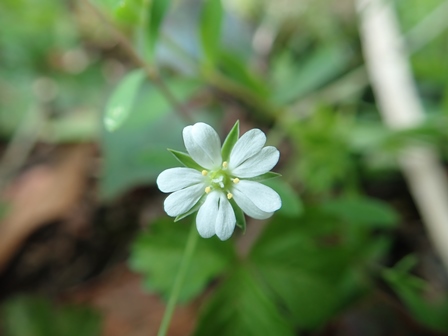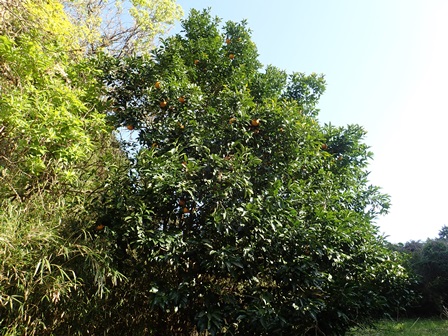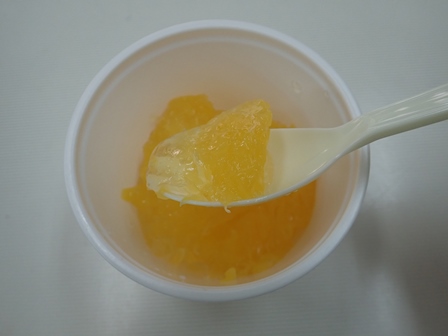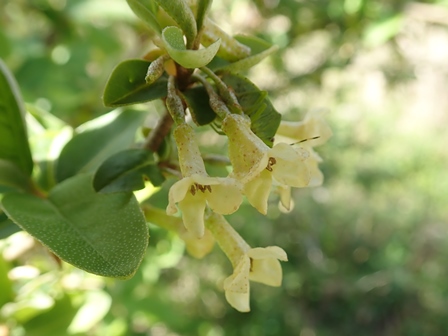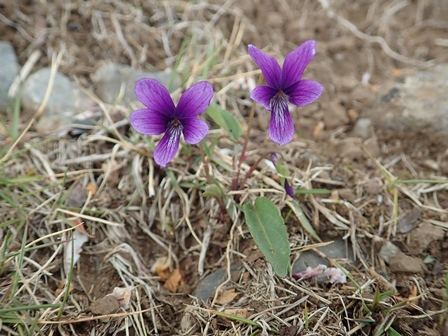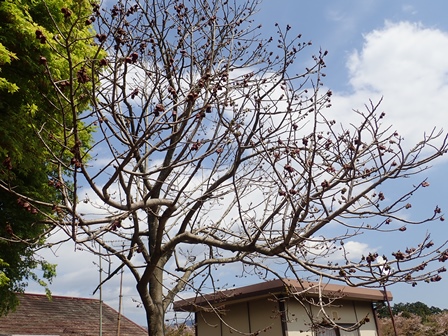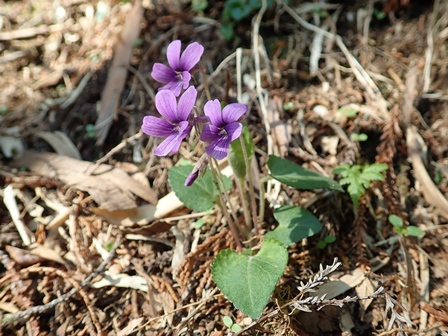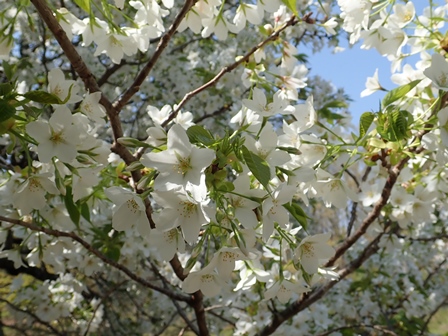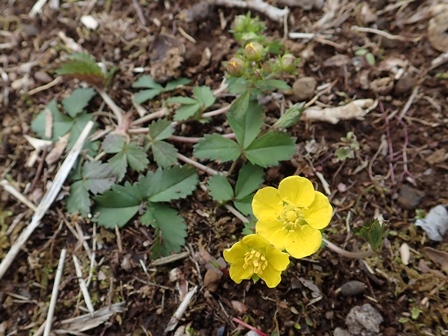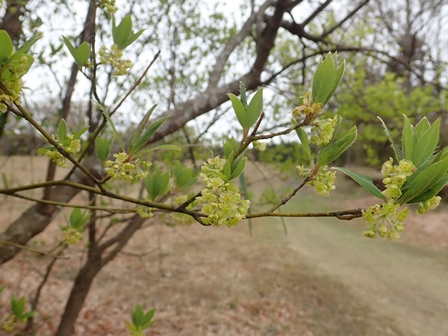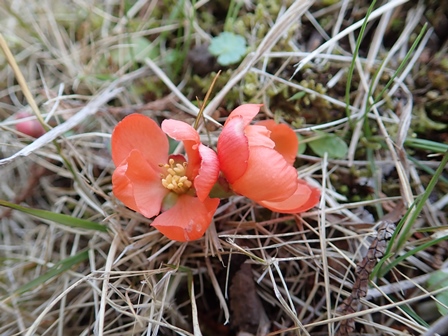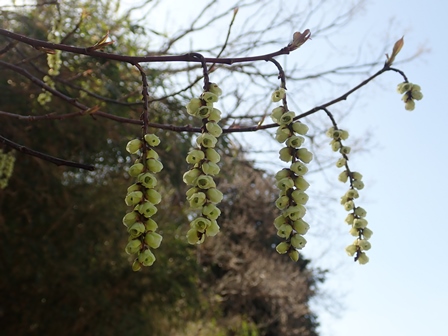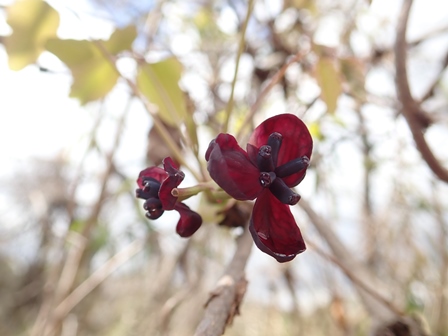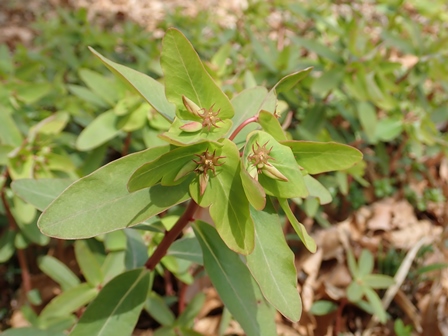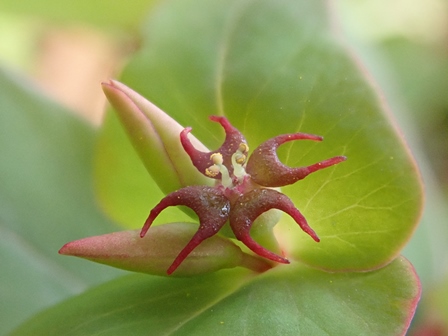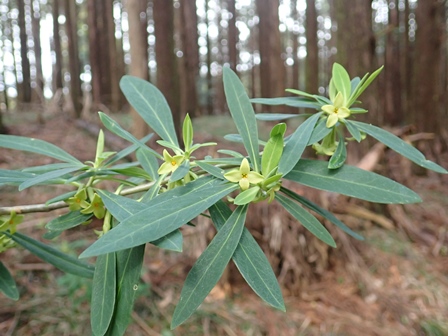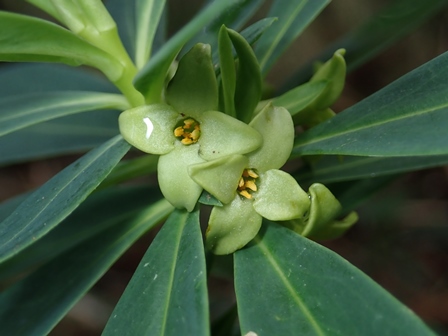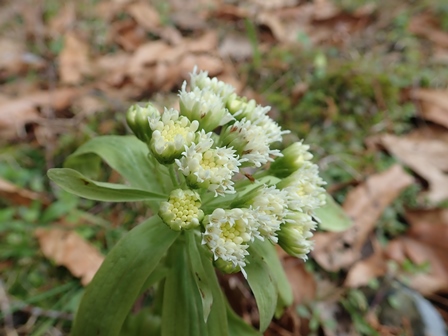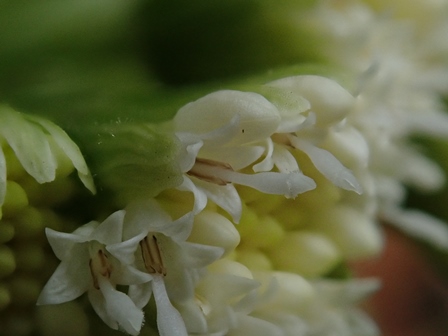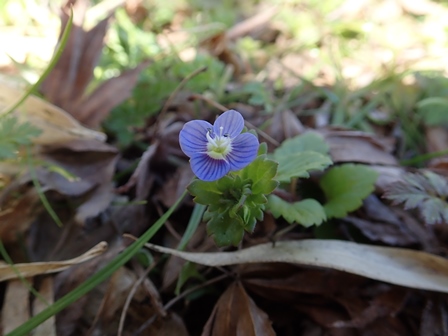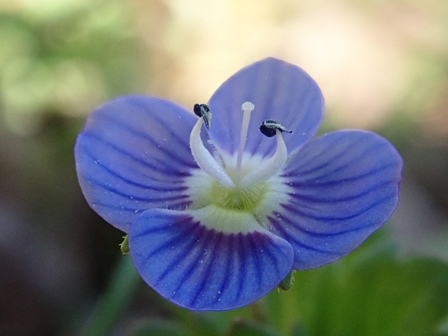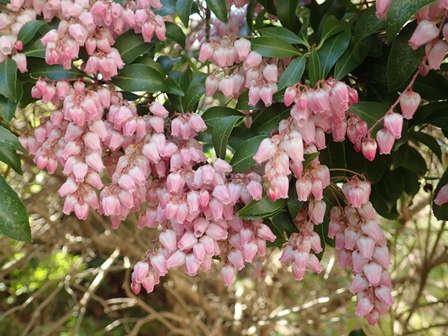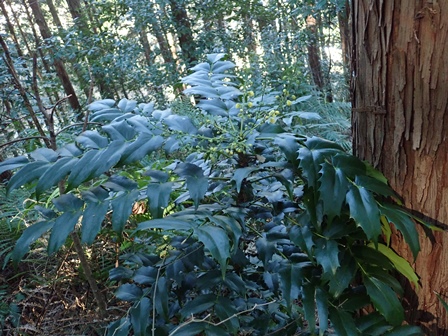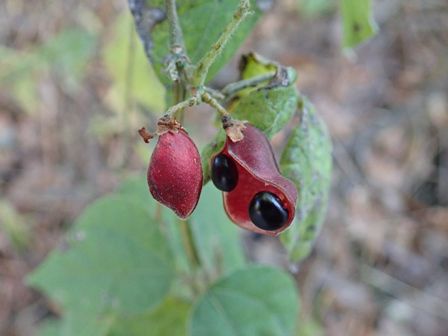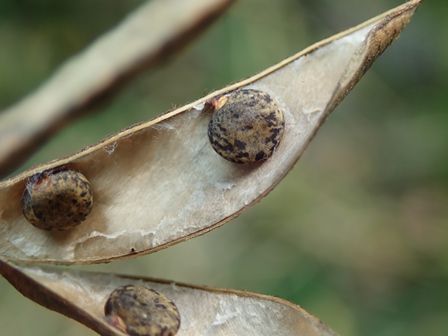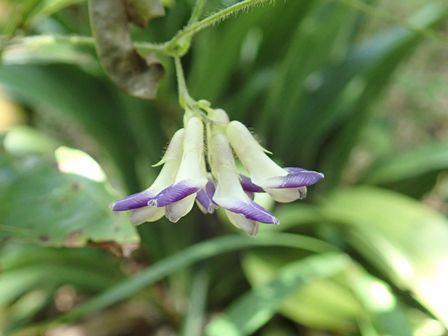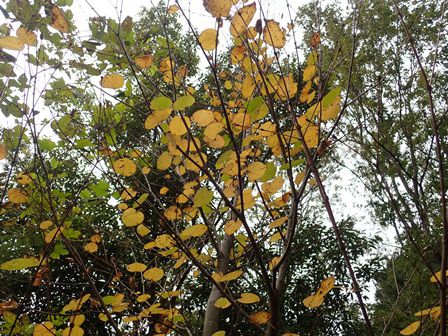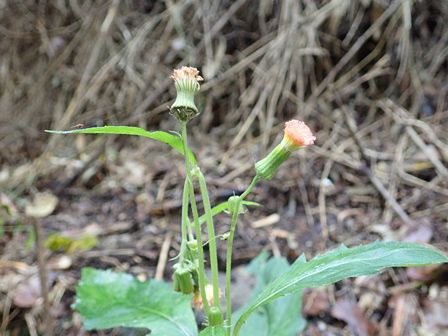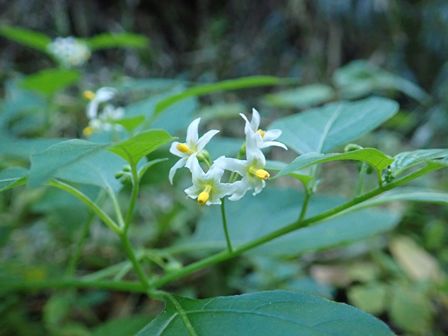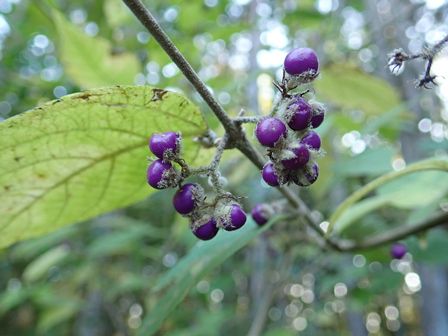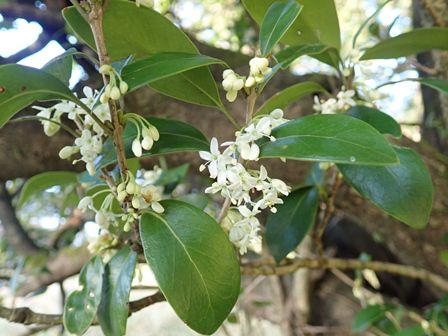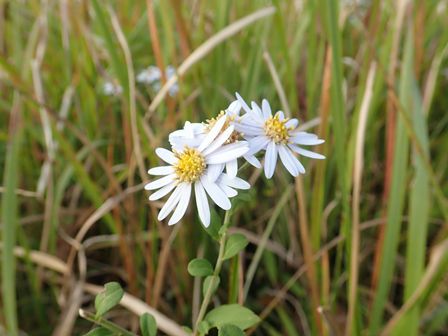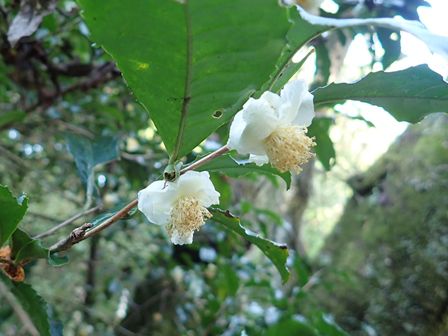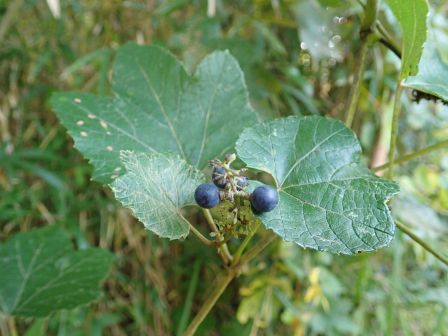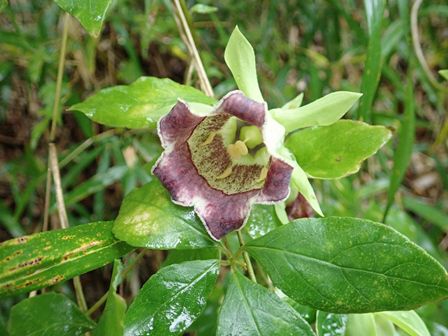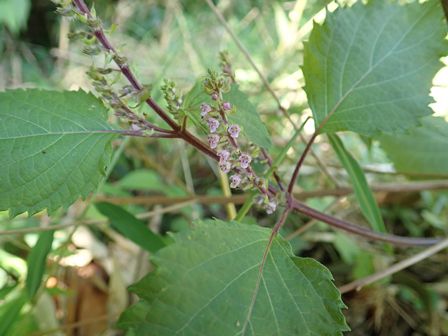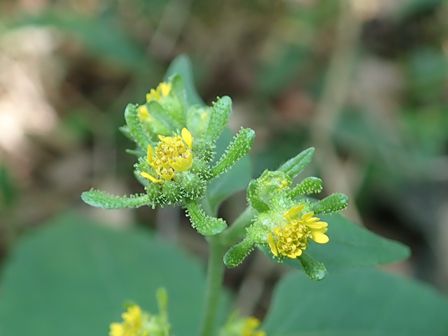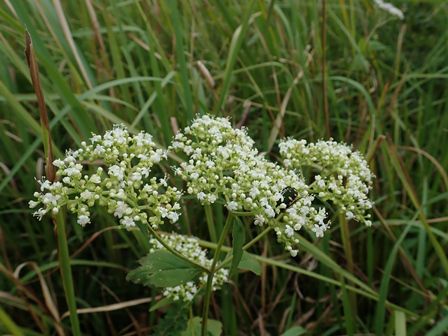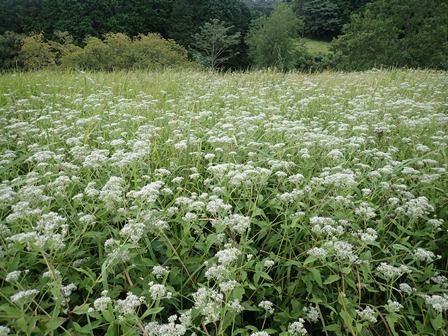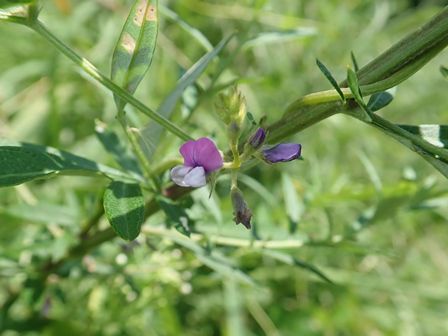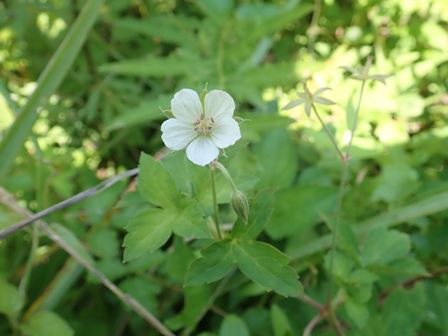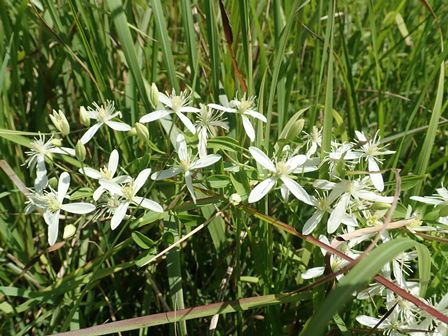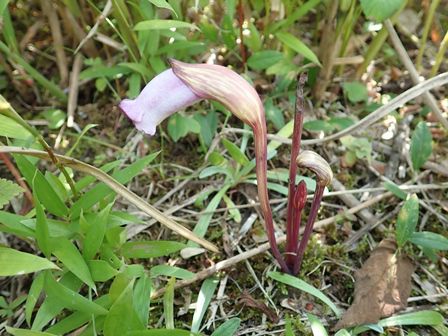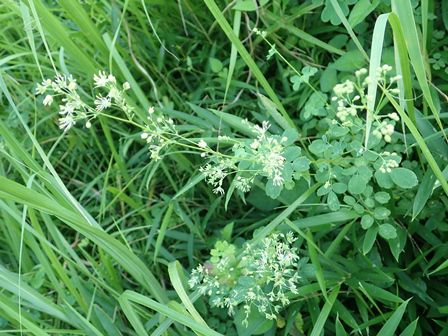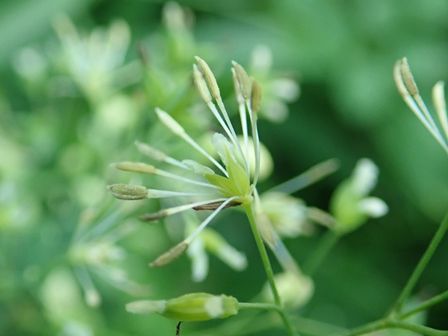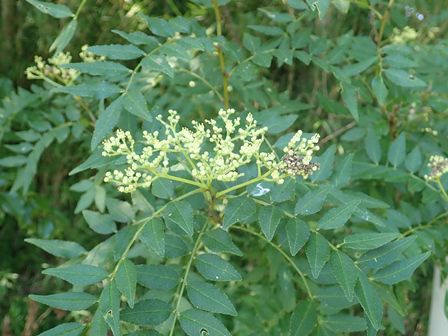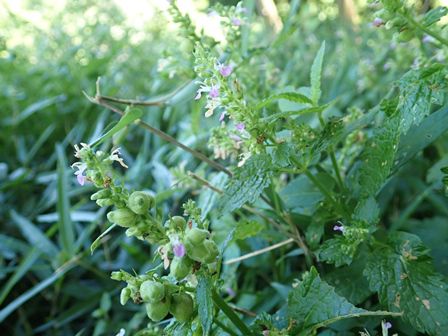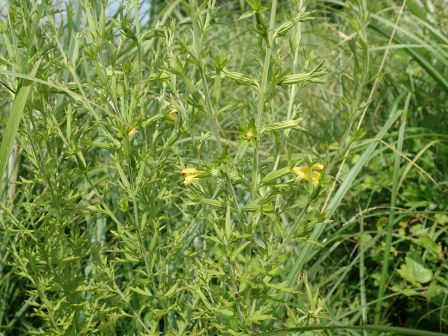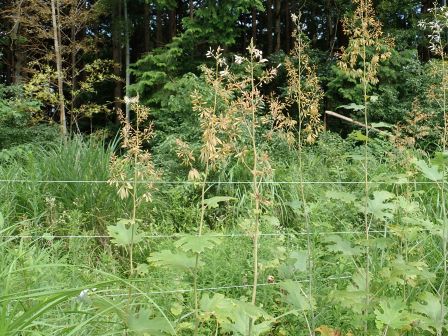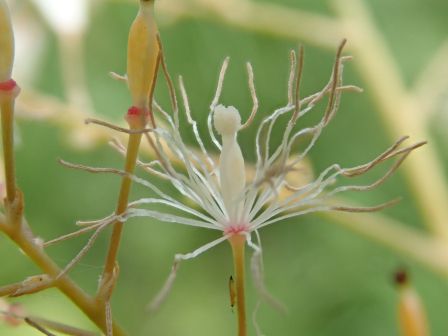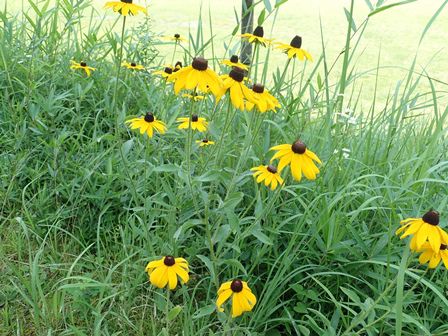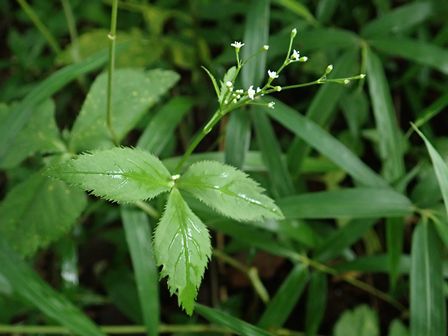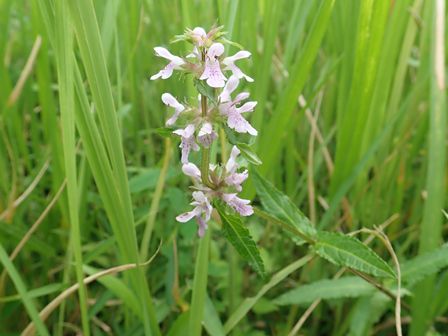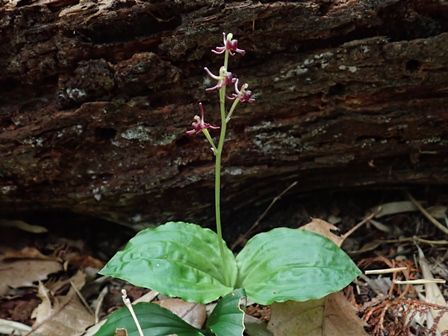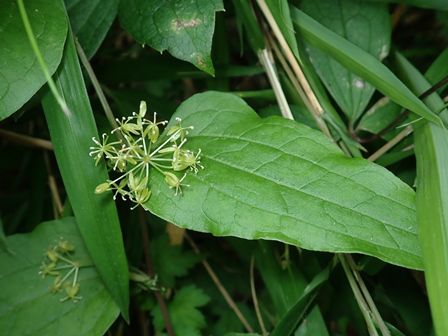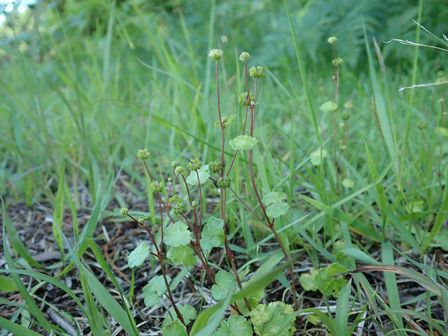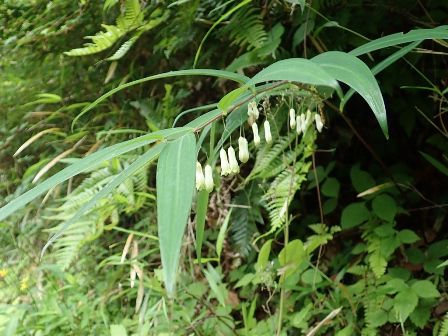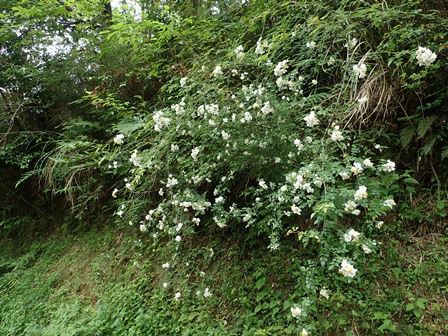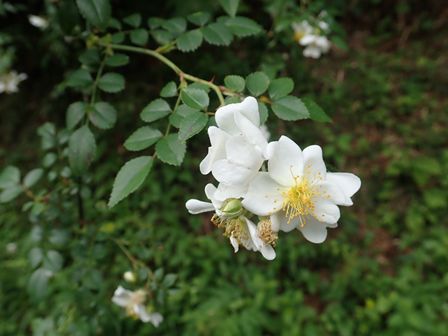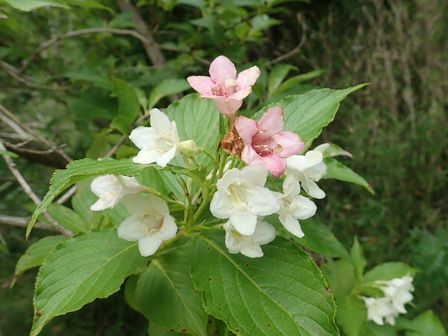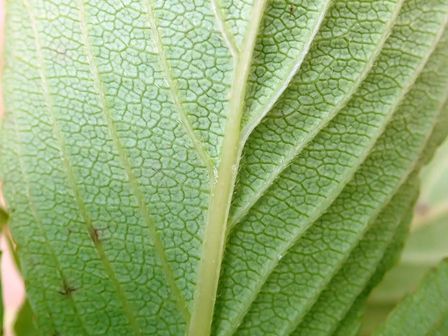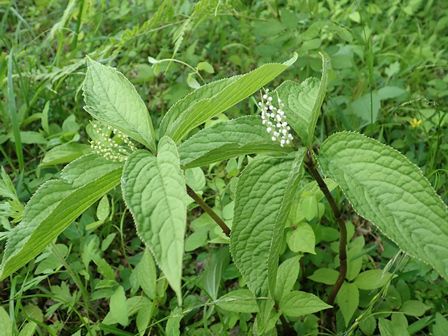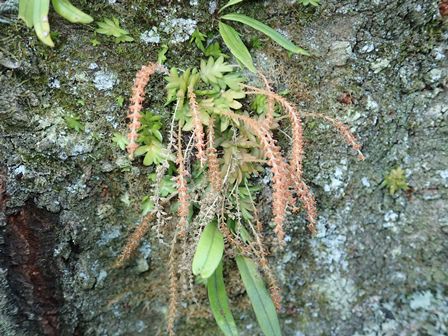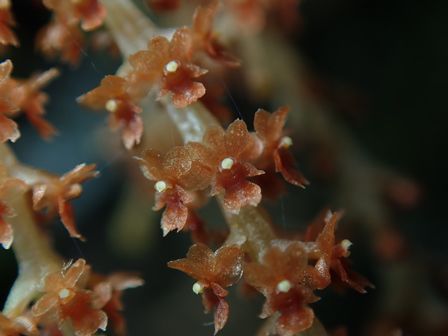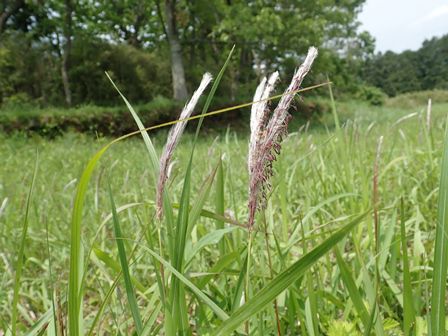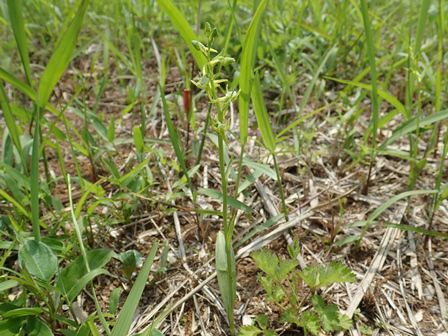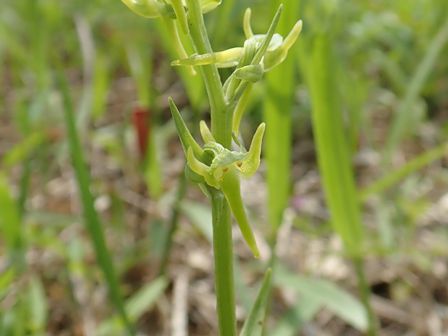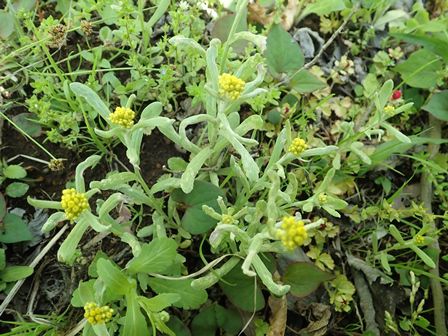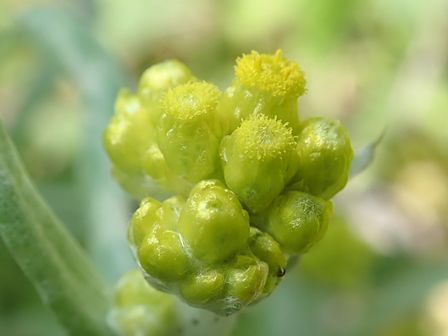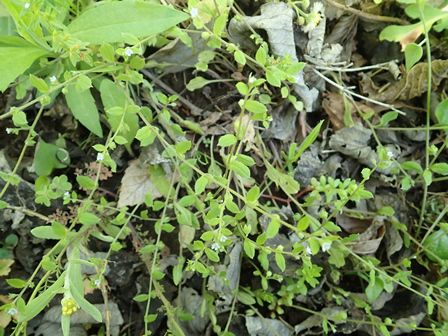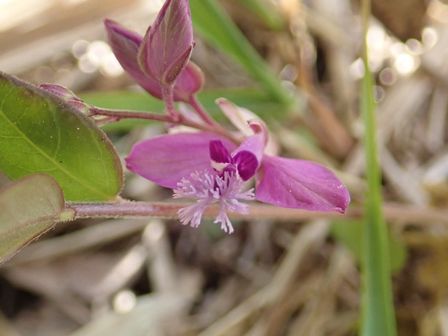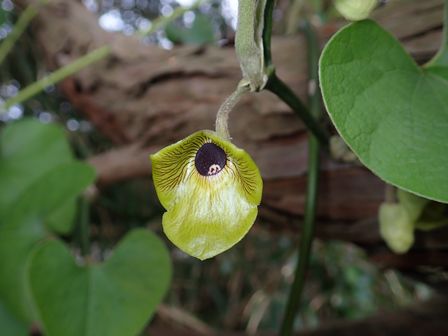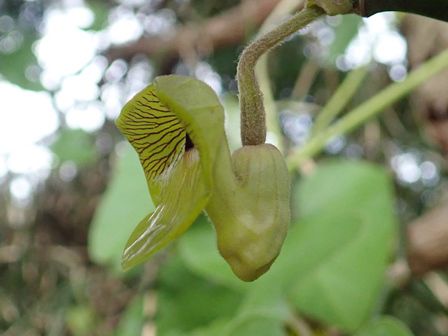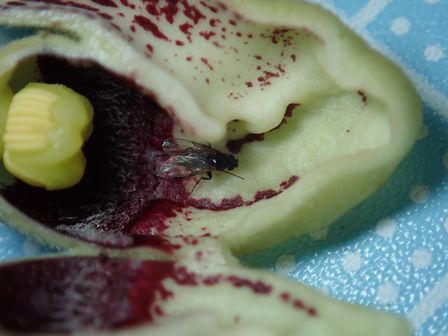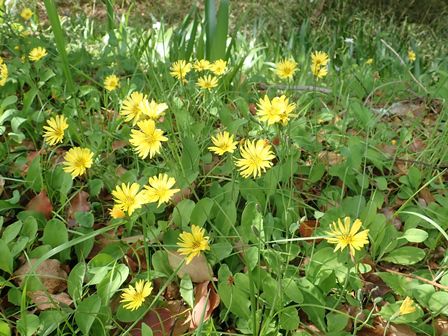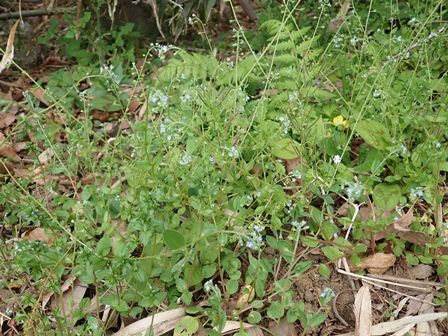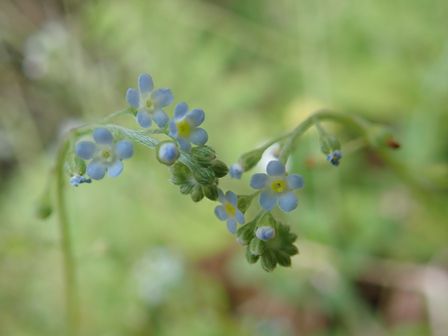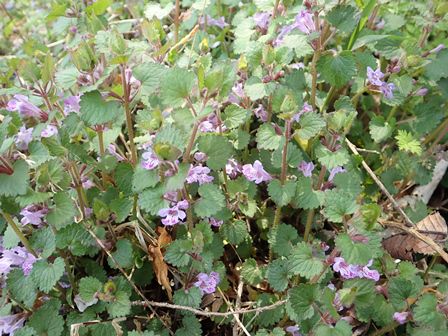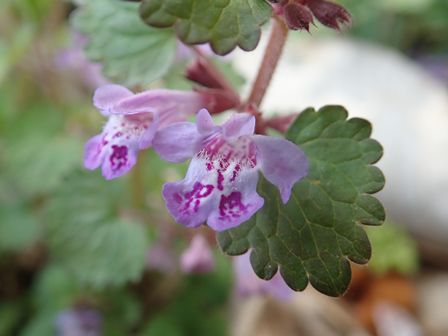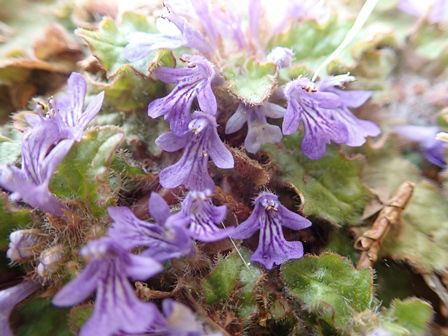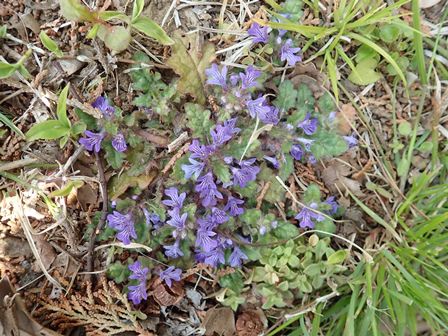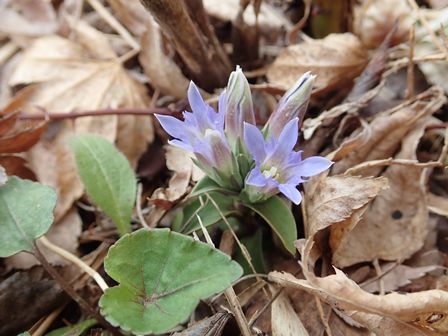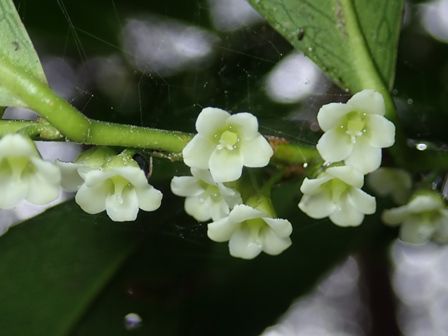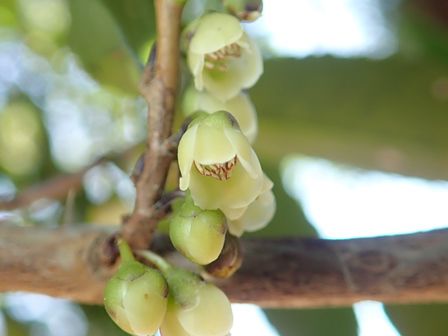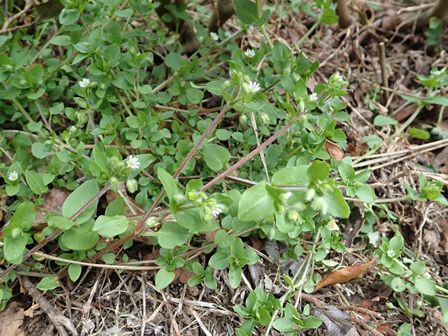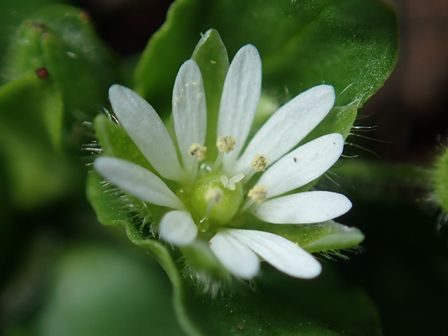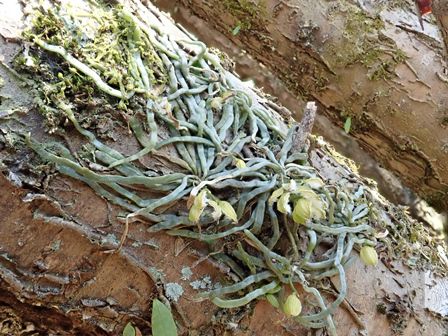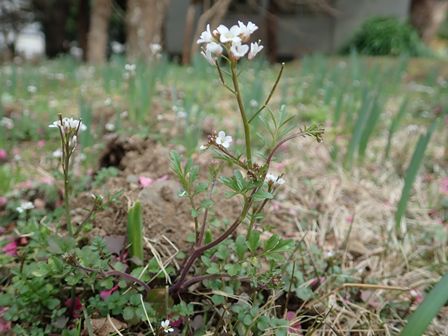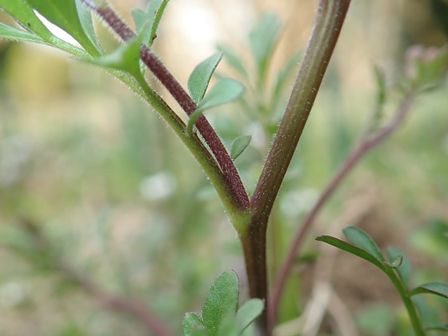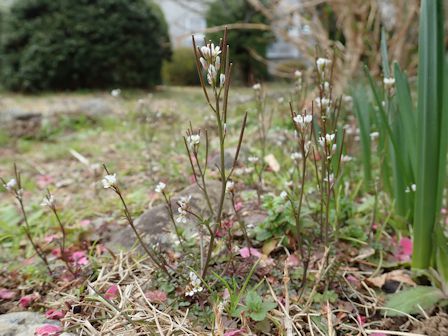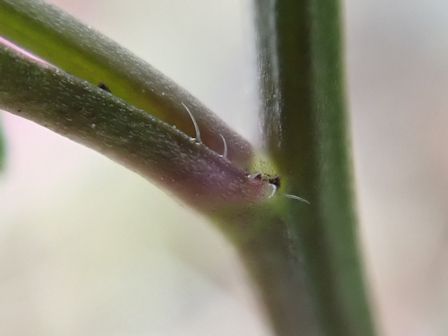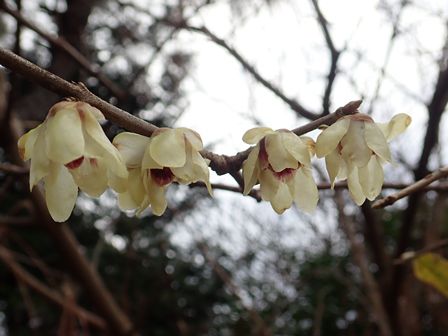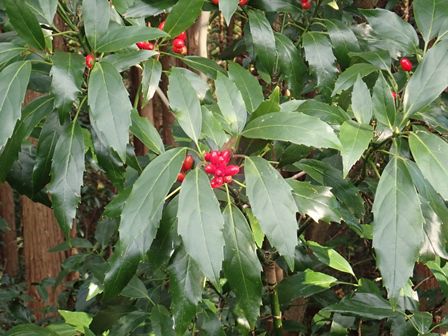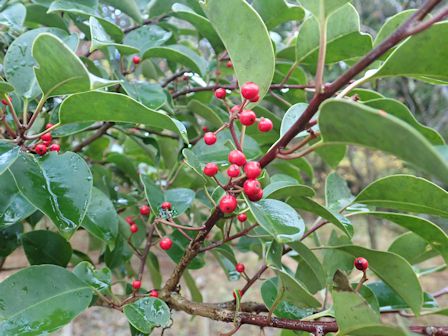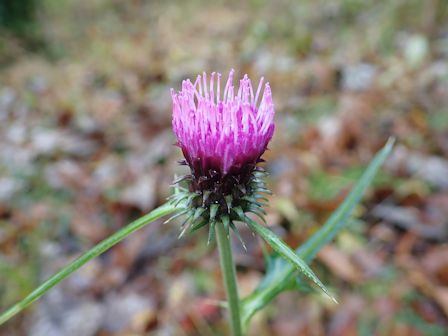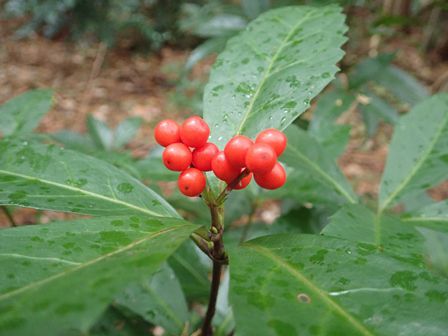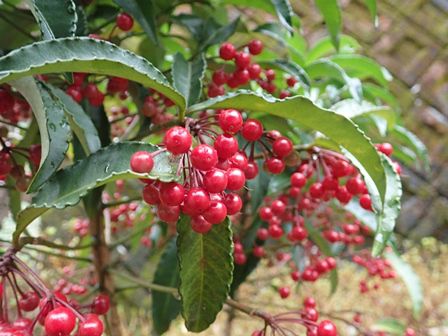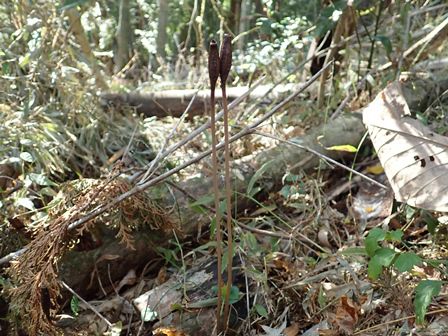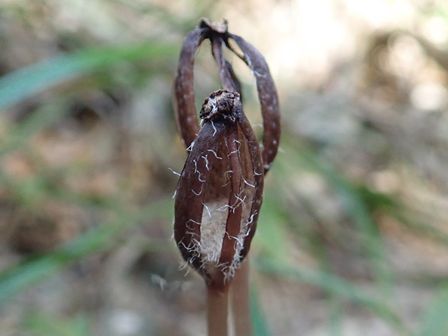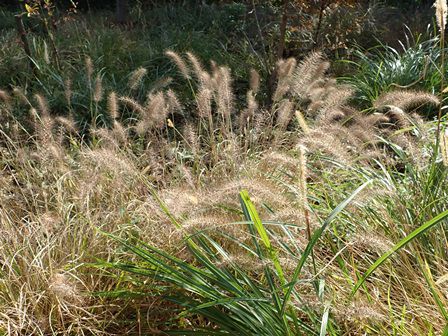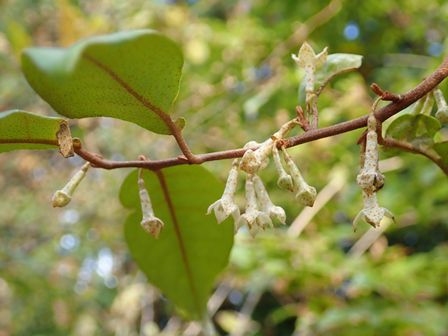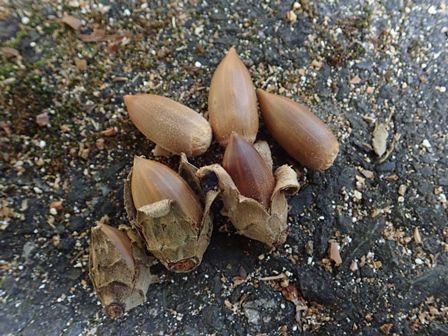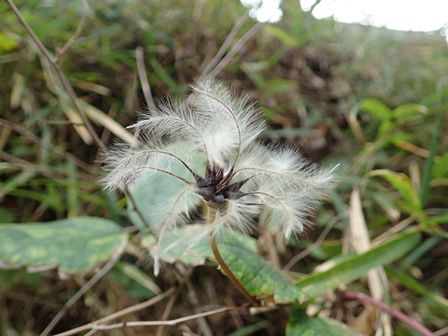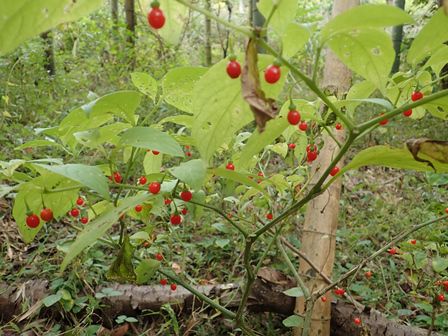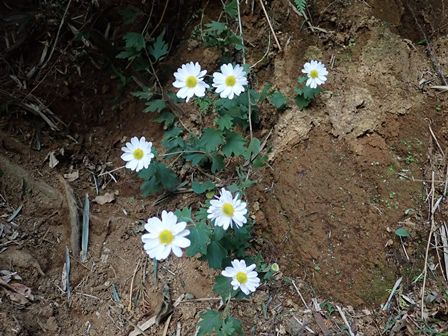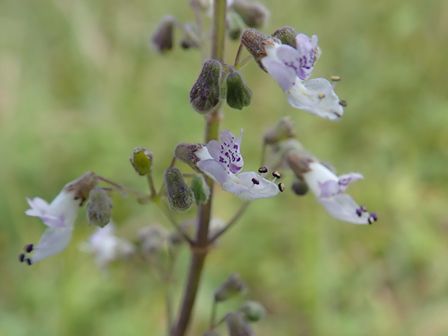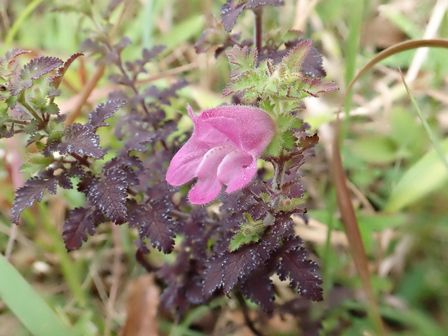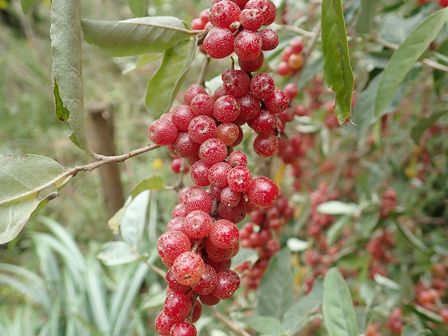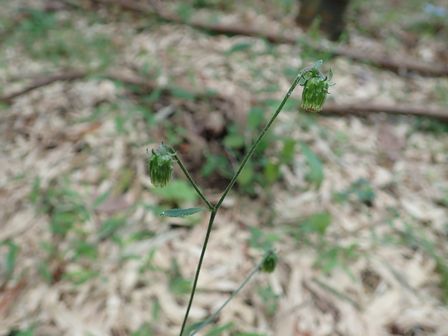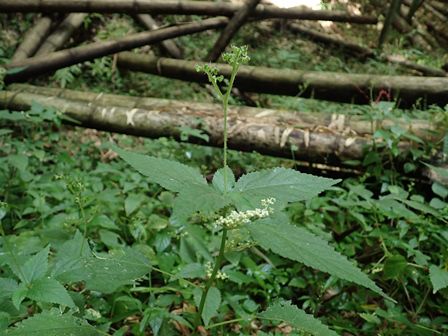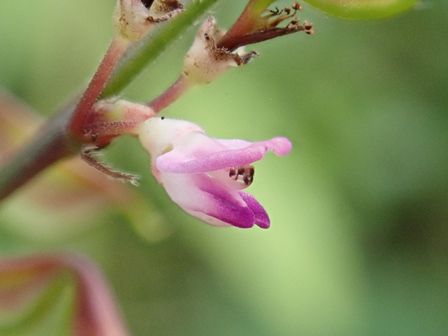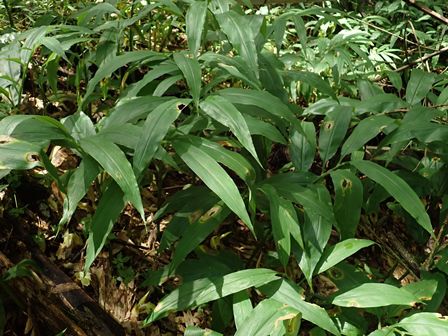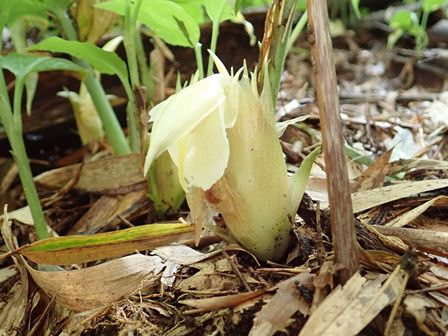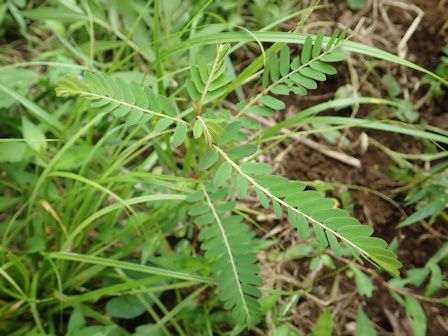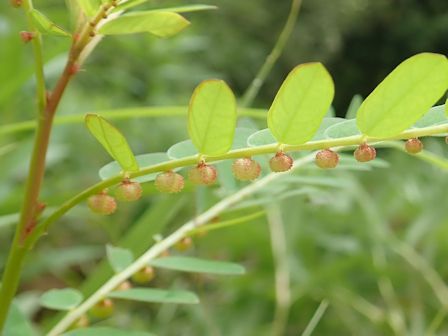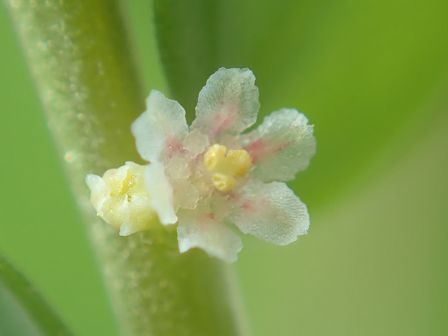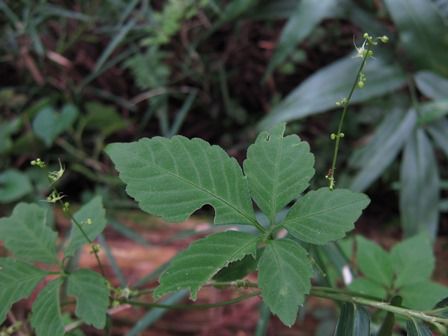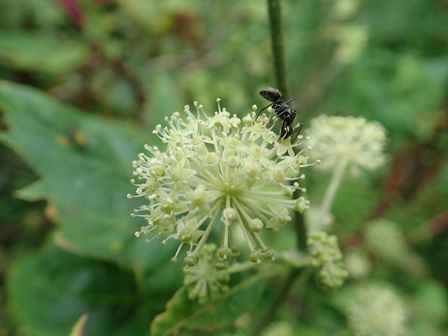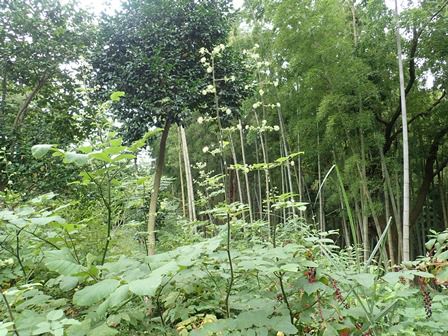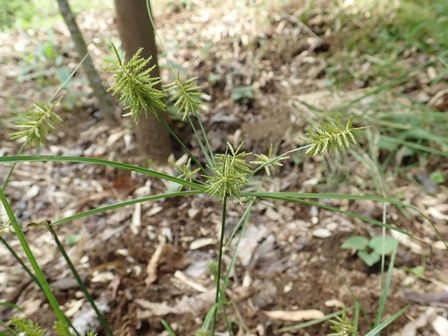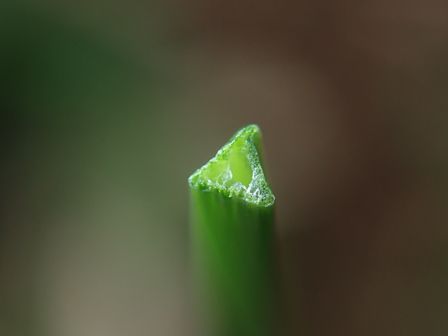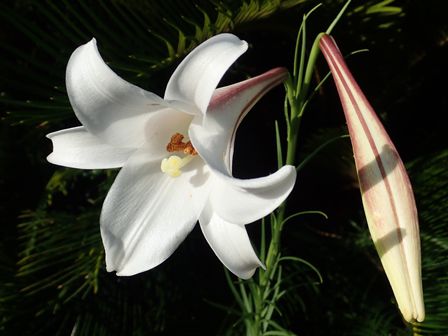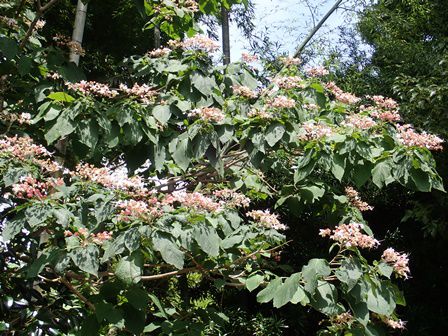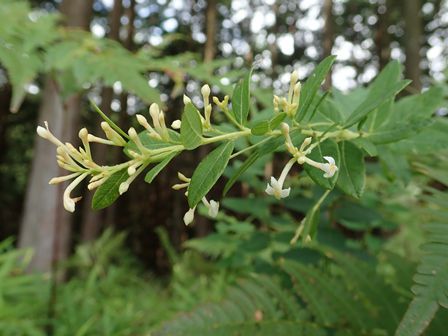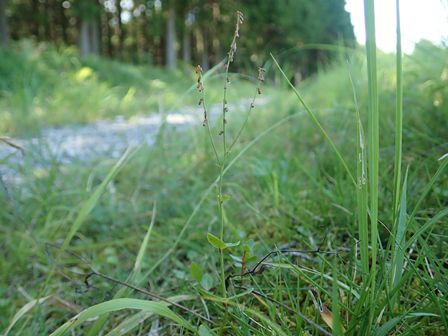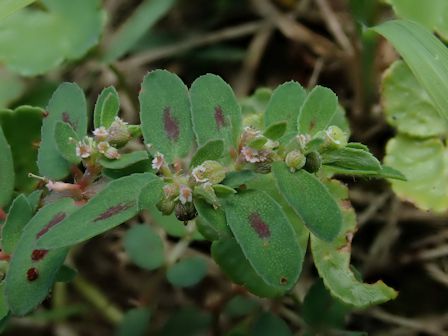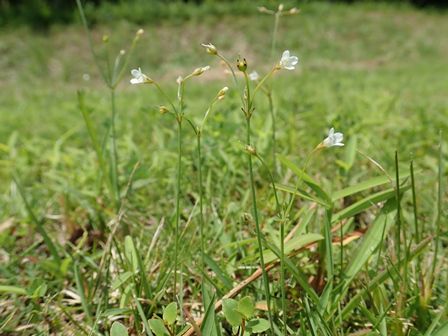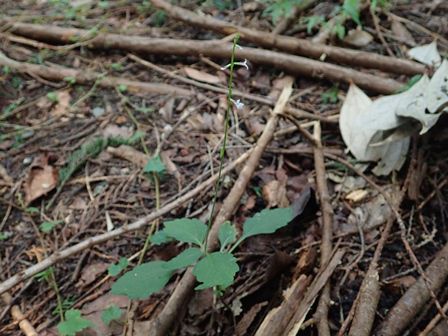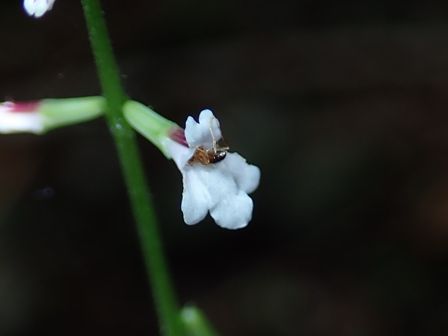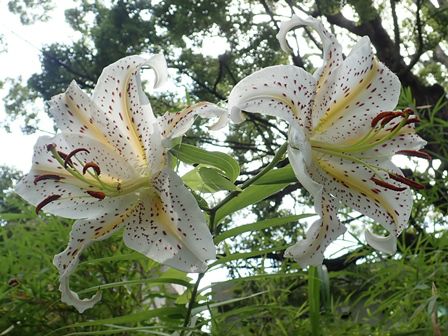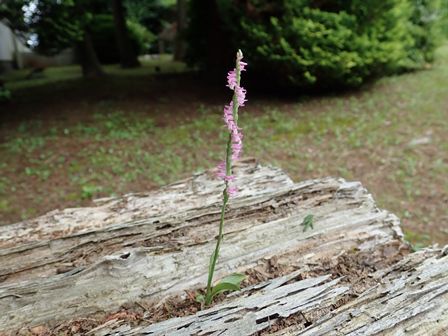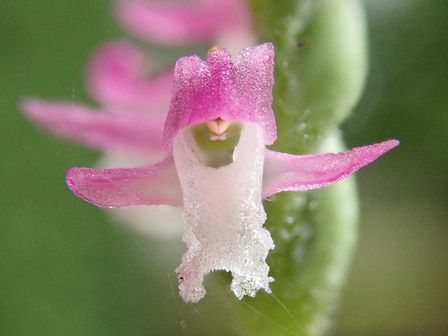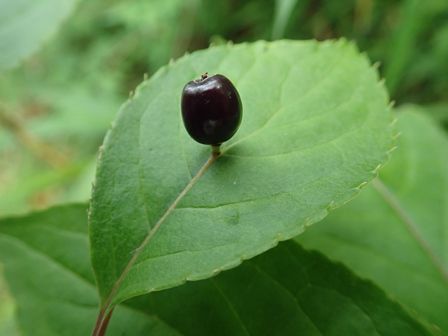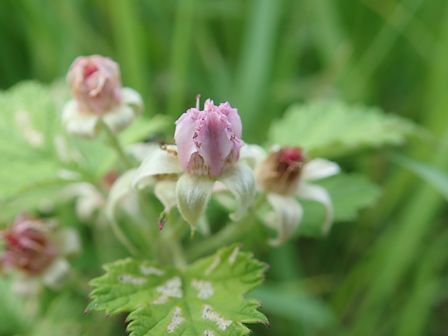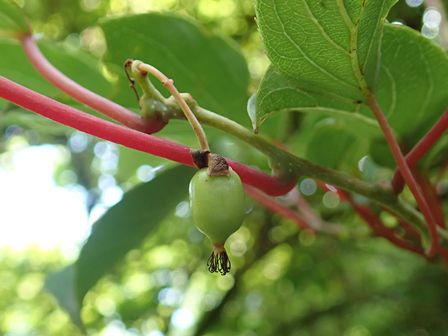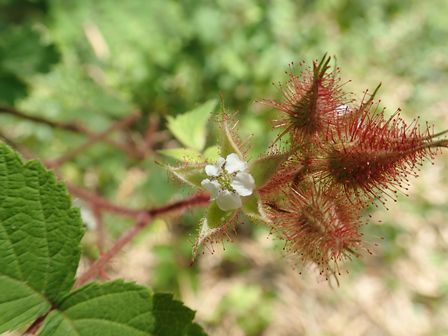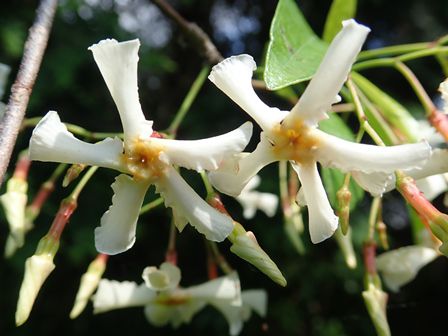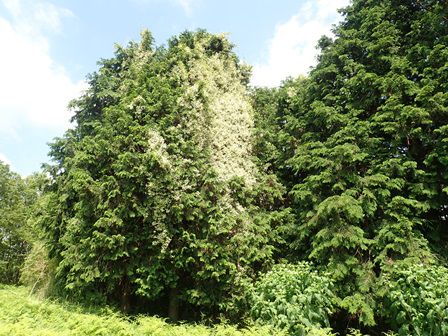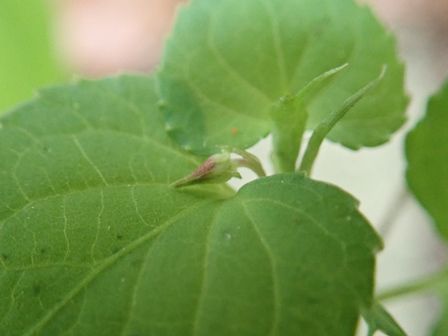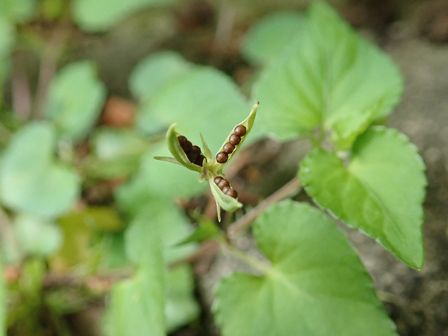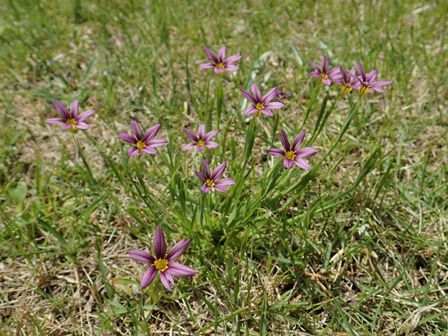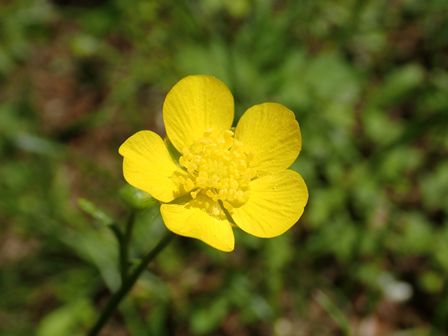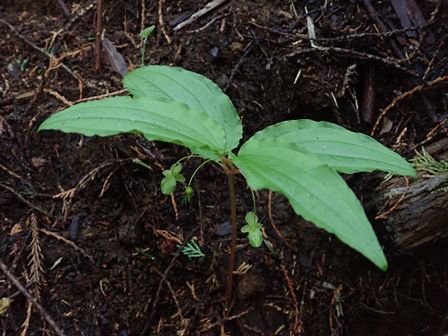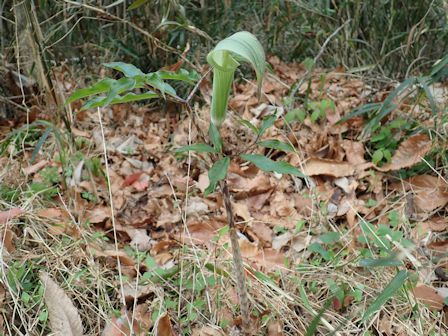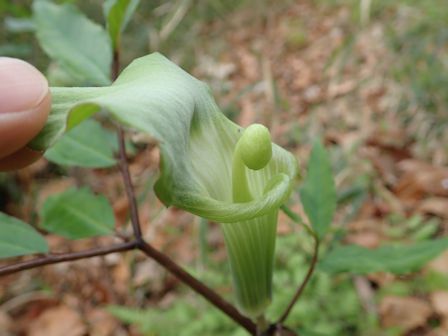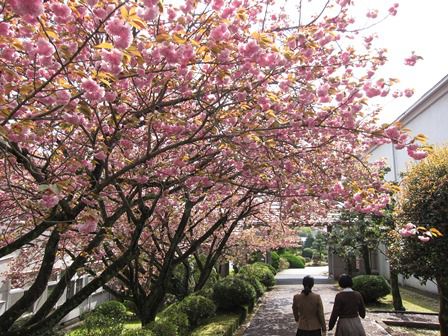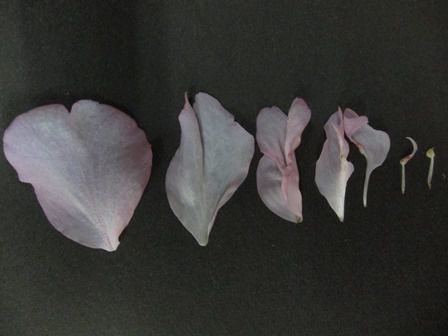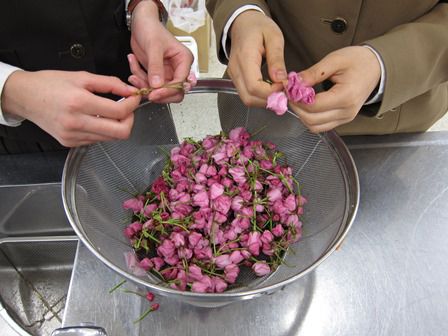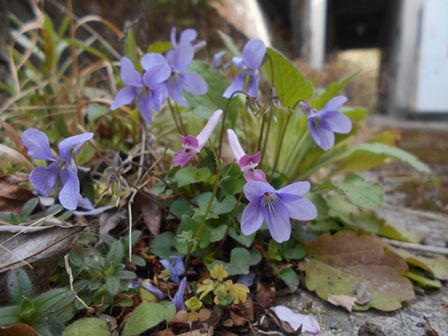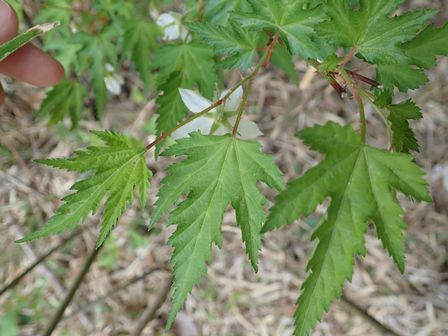フィールド日記
種子植物
2026.01.02
フユイチゴ
フユイチゴが実をつけています。バラ科の常緑小低木で、キイチゴの一種です。和名は冬に果実が熟すことに由来します。

"Fuyu-Ichigo" plants are now bearing fruits. They are small evergreen shrubs in the Rosaceae family that are a type of raspberries. The name comes from the fact that their fruit ripens in winter.
2025.12.30
トキワサンザシ
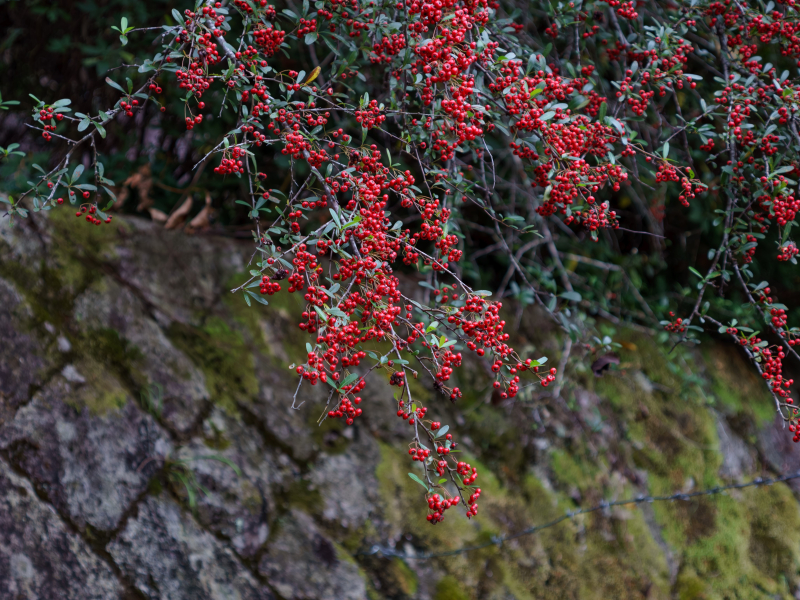
2025.12.26
コセンダングサ
コセンダングサが咲いています。熱帯に広く分布するキク科の1年草です。果実はいわゆる「ひっつき虫」で、先端にトゲが3本ほどあり、動物や衣類にくっついて運ばれます。

"Ko-Sendangusa" plants are in bloom. They are annual plants in the Asteraceae family that widely grow in the tropical regions. Their fruit, which is commonly known as "Hittsukimushi", are dispersed by animals and clothing, as the fruit have hooks at their tips.
2025.12.23
クロヤツシロラン
クロヤツシロランが種子を飛ばしていました。養分を完全に菌類から得ているラン科の多年草です。秋に咲く花は地上から数センチの高さしかなくあまり目立ちませんが、花のあと花柄が急速に伸び、ほこりのような細かい種子を放出します。

2025.12.19
ハナカンナ
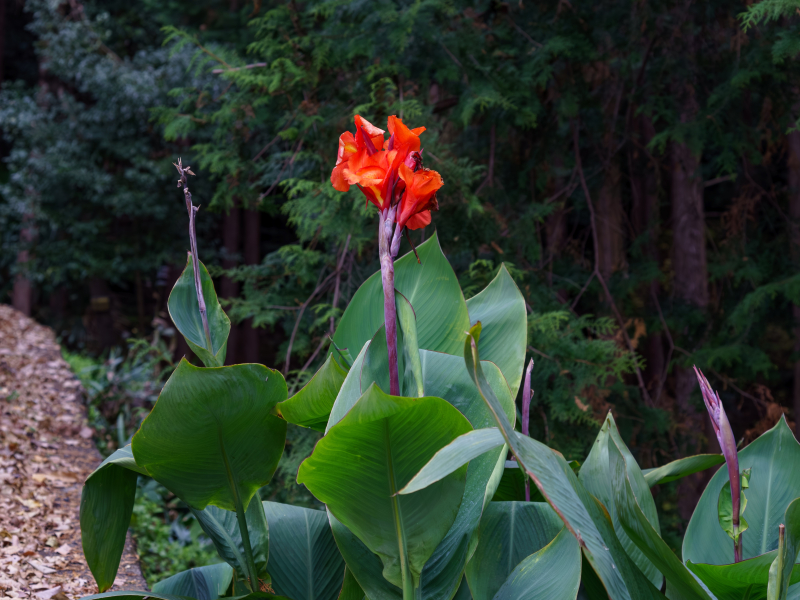
2025.12.16
シュウカイドウ
シュウカイドウが咲いています。シュウカイドウ科の多年草です。古くから栽培されており、逸出したものが人家周辺で野生化しています。花期は秋海棠(シュウカイドウ)という名前の通り秋ですが、12月に入っても開花している個体がありました。
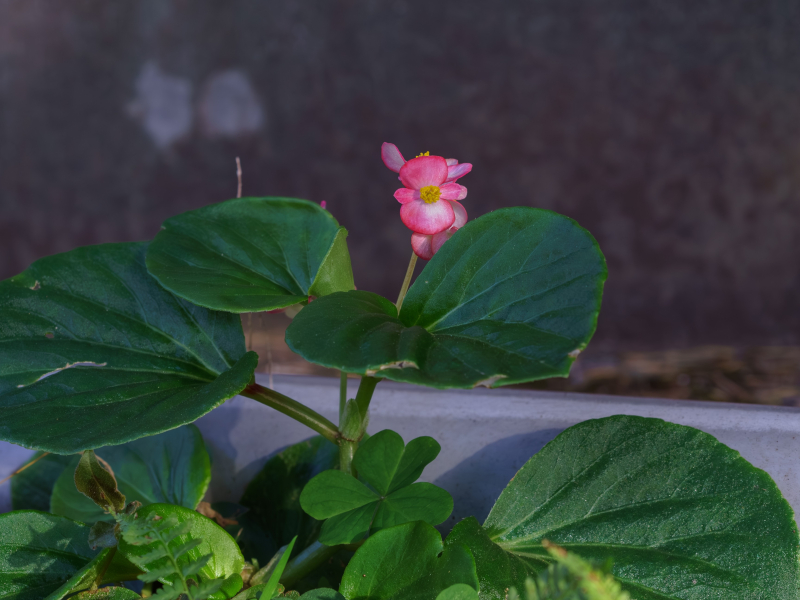
"Shuukaidou" plants are in bloom. They are perennial plants in the Begoniaceae family and have been cultivated for a long time. Some have spread into the wild and can be often found growing near houses. As their name suggests, they usually bloom in autumn, but the plant in the photo was flowering even in December.
2025.12.09
ヒメヤブラン
ヒメヤブランが実をつけています。芝地などに生えるクサスギカズラ科の多年草です。暗紫色の実は果実に見えますが、果皮は早期に失われ、種子がむき出しになって熟したものです。
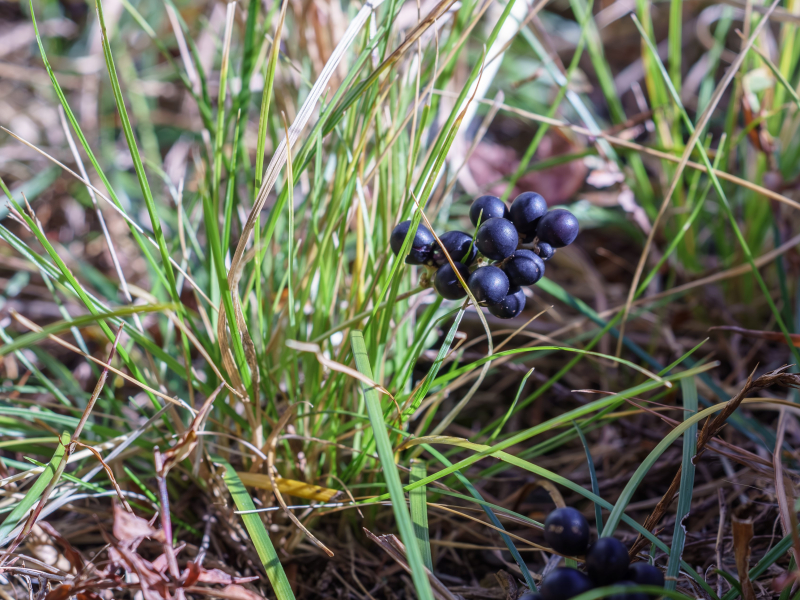
"Hime-Yaburan" plants are now bearing fruit. They are perennial plants in the Asparagaceae family that grow in grassy areas. Their black-purple ‘fruits’ are not actually fruits in botanical terms; the outer skins fall away early, and what ripens are actually seeds.
2025.12.05
ヤツデ

2025.12.02
ナルコユリ
ナルコユリの実がなっています。草地や林内に見られるクサスギカズラ科の多年草です。花は5~6月ごろに葉の付け根から数個ずつ垂れ下がって咲きます。
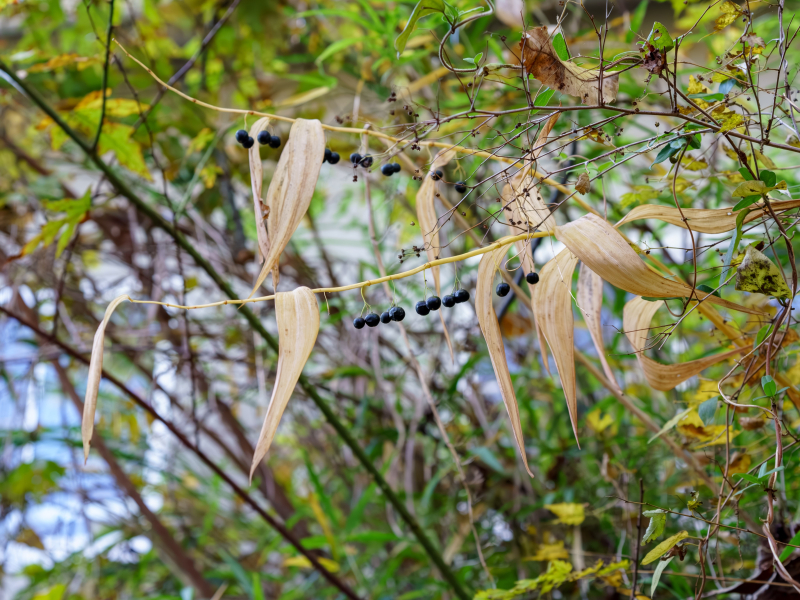
2025.11.25
コウヤボウキ
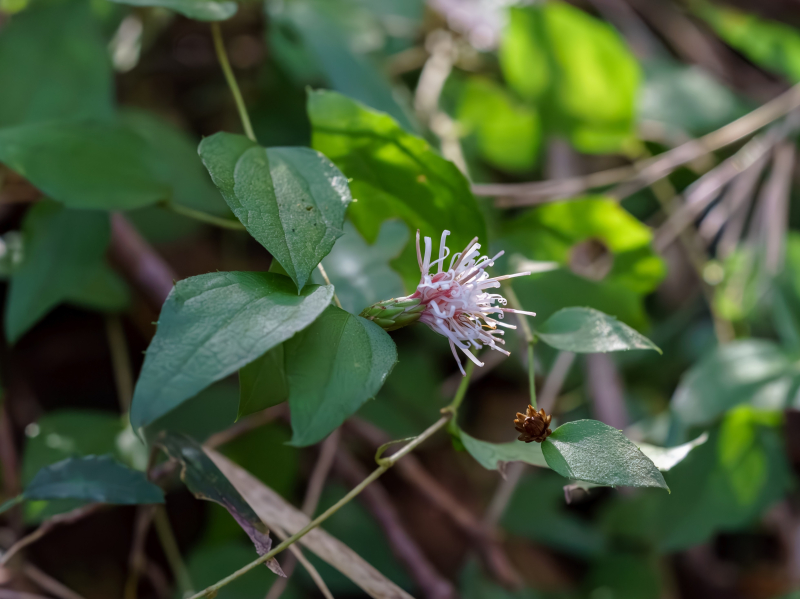
2025.11.21
センブリ
センブリが咲いています。日当たりのよい草地に生えるリンドウ科の越年草です。全草に苦みがあり、胃腸薬として知られています。和名は湯の中で千回振り出してもまだ苦み成分が出るほど苦みが強いことに由来します。
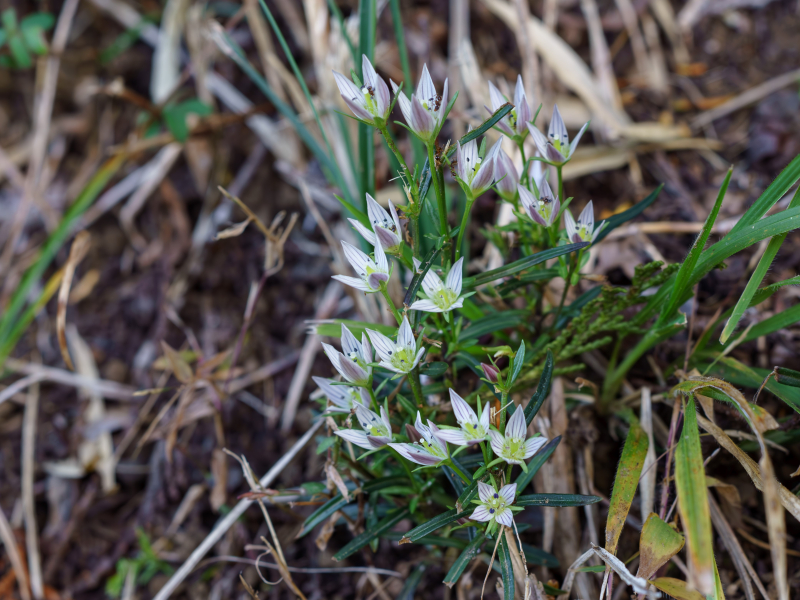
2025.11.18
コチヂミザサ
コチヂミザサが咲いています。林内など日陰に見られるイネ科の多年草です。和名のチヂミザサは葉がササの葉に似ていて、波打っていることに由来します。全体に毛が多いものをケチヂミザサと呼ぶのに対し、毛の少ないものをコチヂミザサと呼んでいます。

“Ko-Chidimizasa” plants are in bloom. They are perennial plants in the Poaceae family that grow in shady places such as forest understories. The name “Chidimizasa” comes from the wavy appearance of their leaves, which resemble those of Sasa plants. The hairier variety is called "Ke-Chidimizasa," while the less hairy one is known as "Ko-Chidimizasa".
2025.11.14
アキグミ
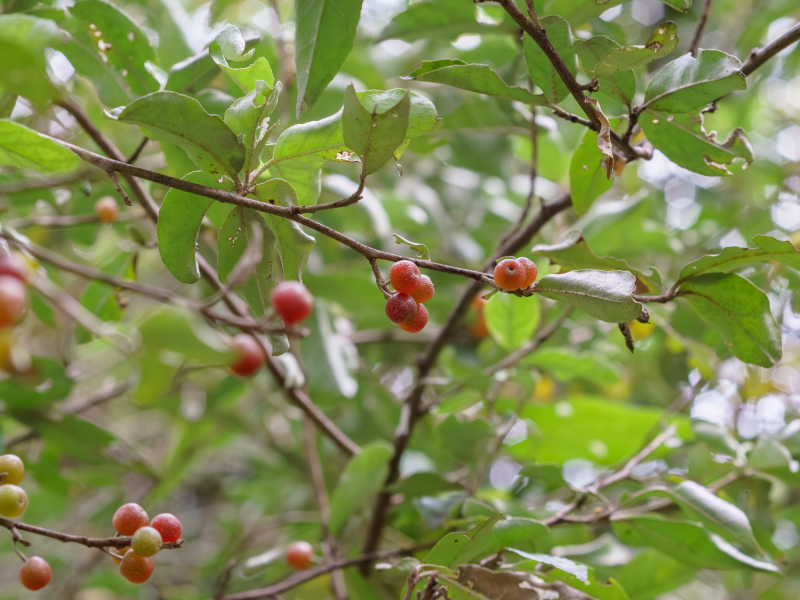
2025.11.11
アリタソウ
アリタソウが咲いています。南アメリカ原産のヒユ科の一年草です。日本各地に帰化し、道端などで普通に見られます。全体に独特な臭いがあります。
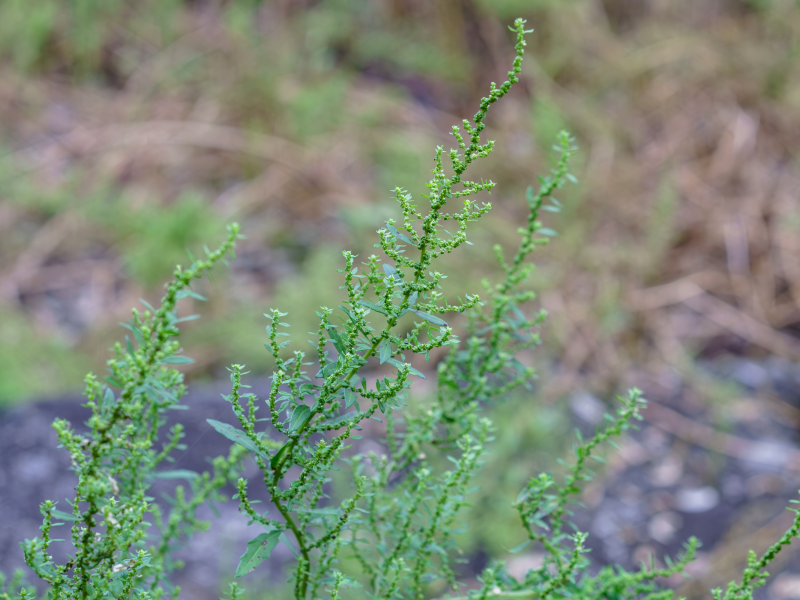
2025.11.07
ヤマハッカ
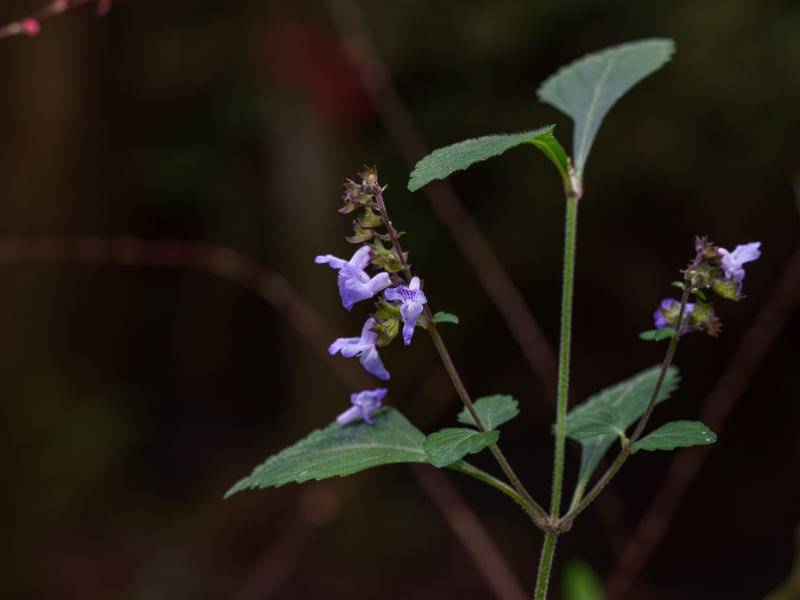
2025.11.04
クサギ
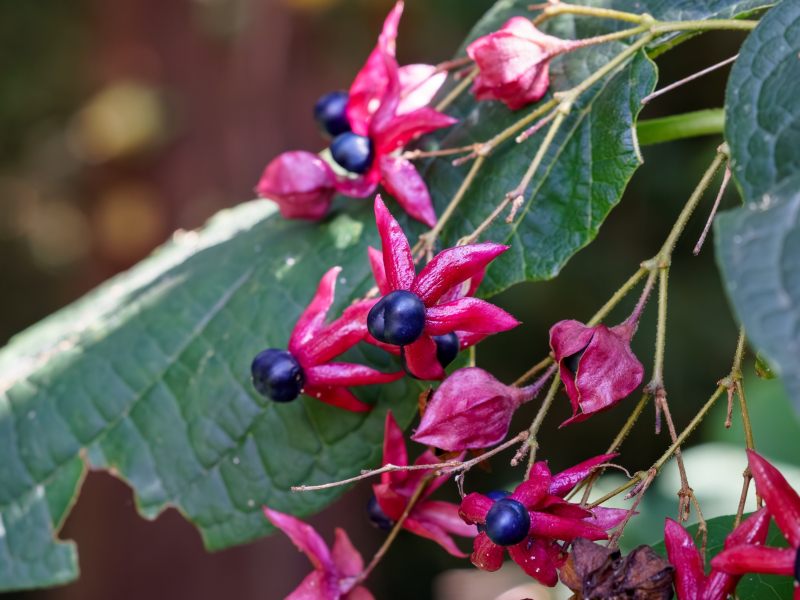
2025.10.31
テイショウソウ

2025.10.28
ミズヒキ
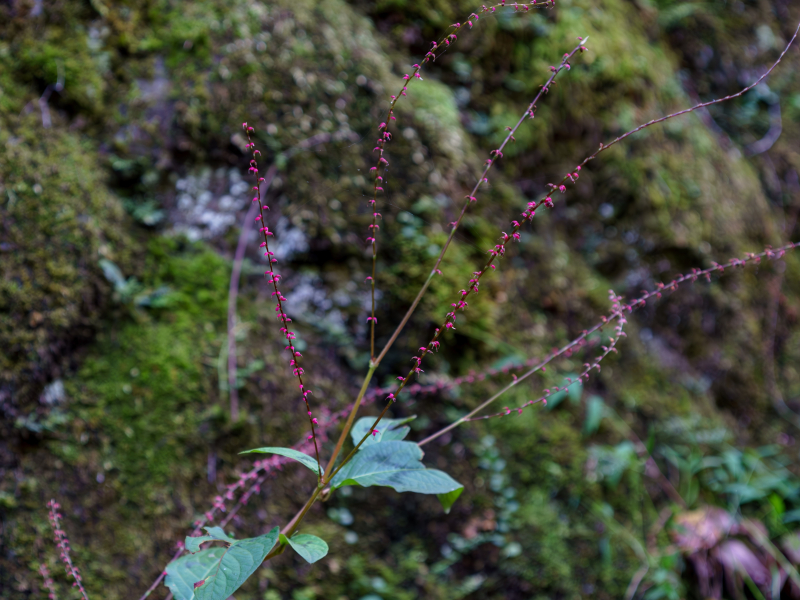
2025.10.24
キバナアキギリ
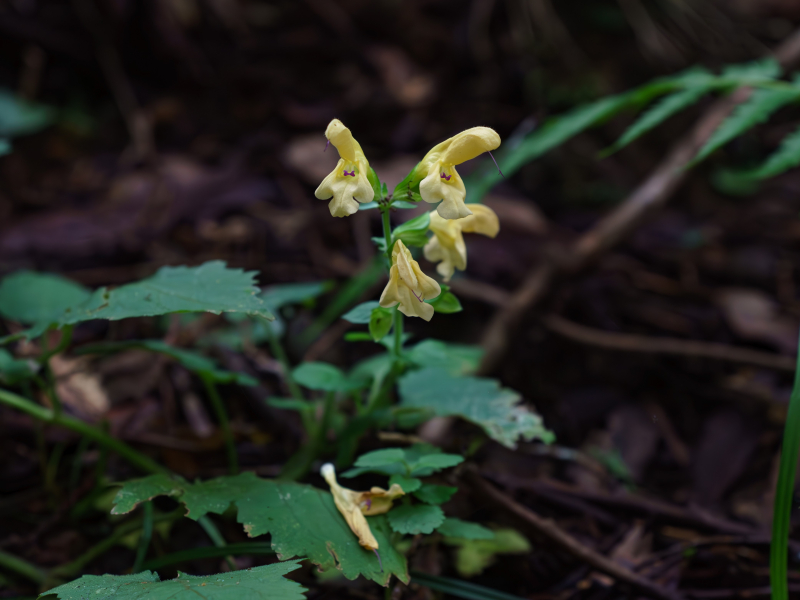
2025.10.21
ヤブマメ
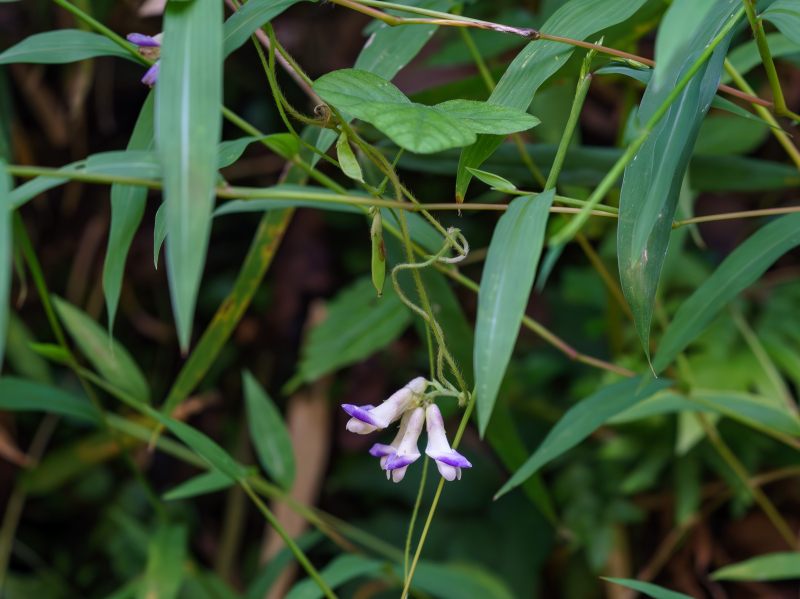
2025.10.17
ヒメクグ
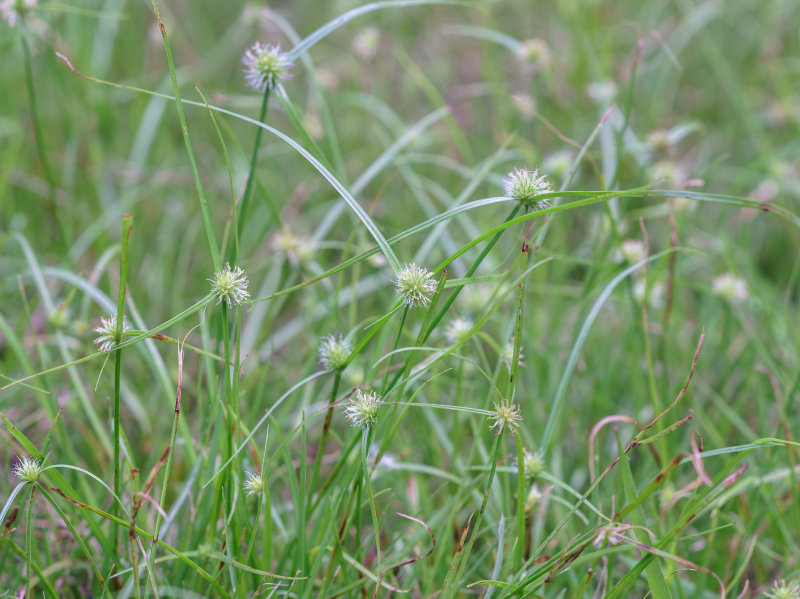
2025.10.14
ネズミノオ
ネズミノオが咲いています。道端などに見られるイネ科の多年草です。和名は、細長い花序が、ネズミの尾に見えることに由来します。

2025.10.10
エノキグサ
エノキグサが咲いています。道端などに普通に生えるトウダイグサ科の一年草です。和名は、葉がエノキという木の葉に似ていることに由来します。
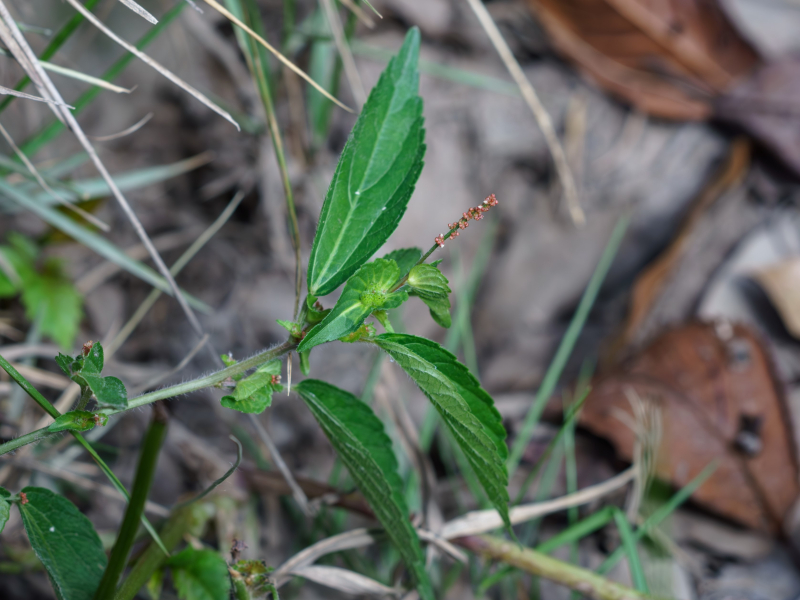
2025.10.07
ウド
ウドが咲いています。山地の林縁などに見られるウコギ科の多年草です。若芽を食用とし、畑で栽培されることもあります。

2025.10.03
ローゼル
ローゼルが咲いています。ハイビスカスティーの原料として使われるアオイ科の多年草です(日本では冬を越せないため一年草扱い)。裾野市の生産者から苗を分けていただき、生徒たちが育てています。ハイビスカスティーには花びらではなく、花の後に肥大したがくを利用します。
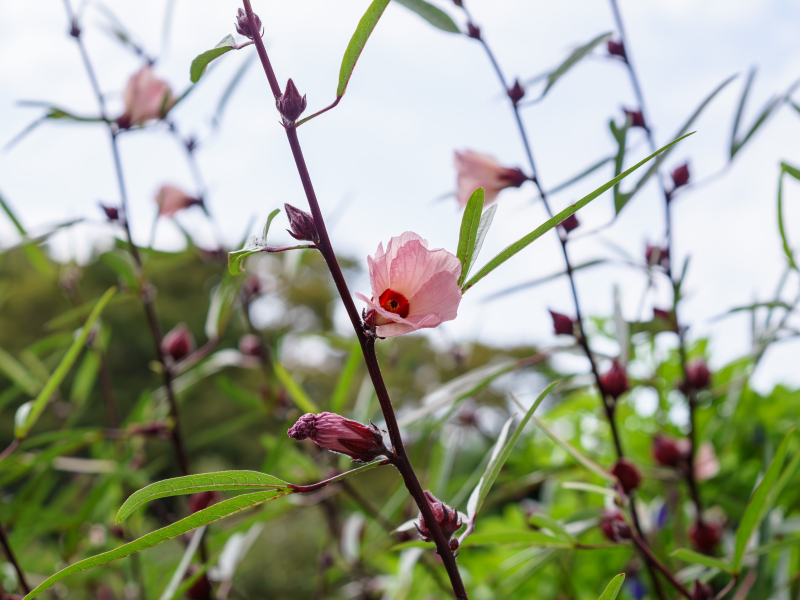
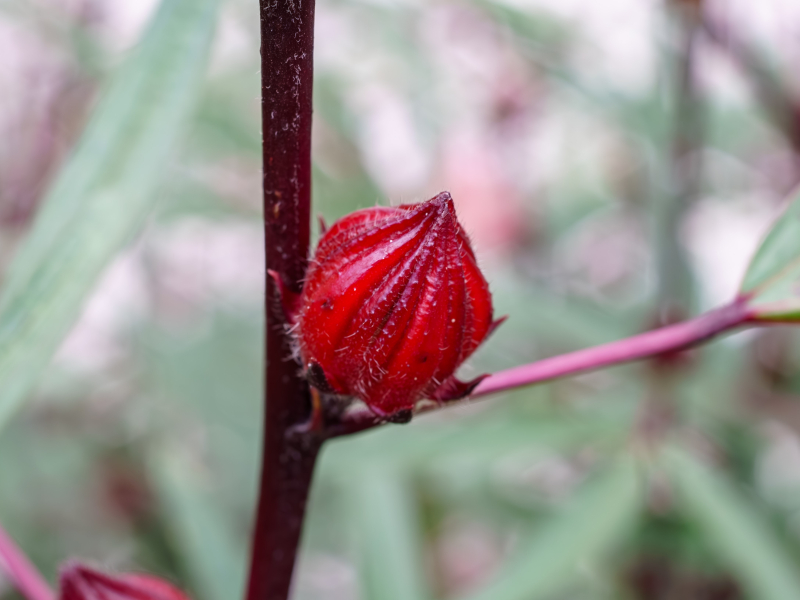
Roselle plants are in bloom. They are perennial plants in the Malvaceae family that are used to make hibiscus tea (In Japan, they are considered as annual plants because they can't survive the winter.). Our students received the seedlings from a farmer in Susono and have been cultivating them. After flowering, they use the harvested sepals, not the petals, to make hibiscus tea.
2025.09.30
バタフライピー
バタフライピーが咲いています。東南アジアなどが原産の青いハーブです。裾野市の生産者の方に種を譲っていただき、生徒たちが栽培しています。11月頃まで花が収穫できるそうです。
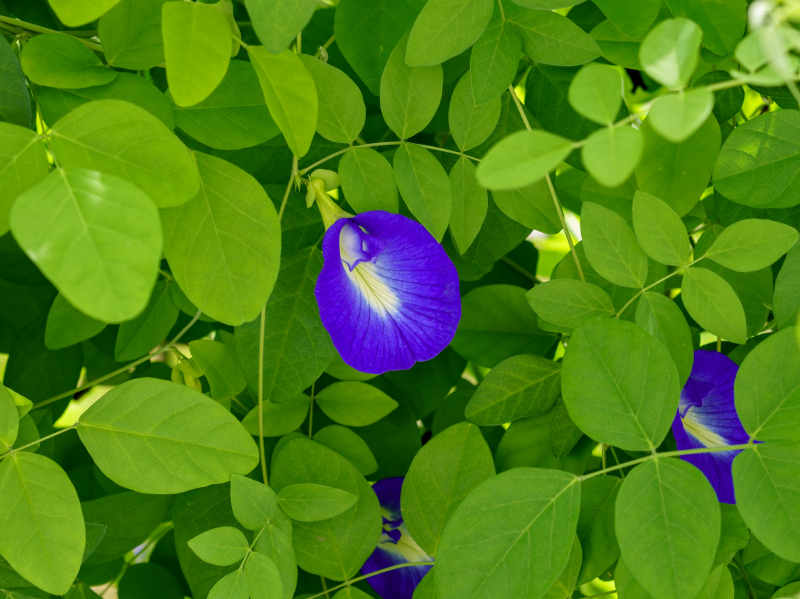
2025.09.26
フヨウ
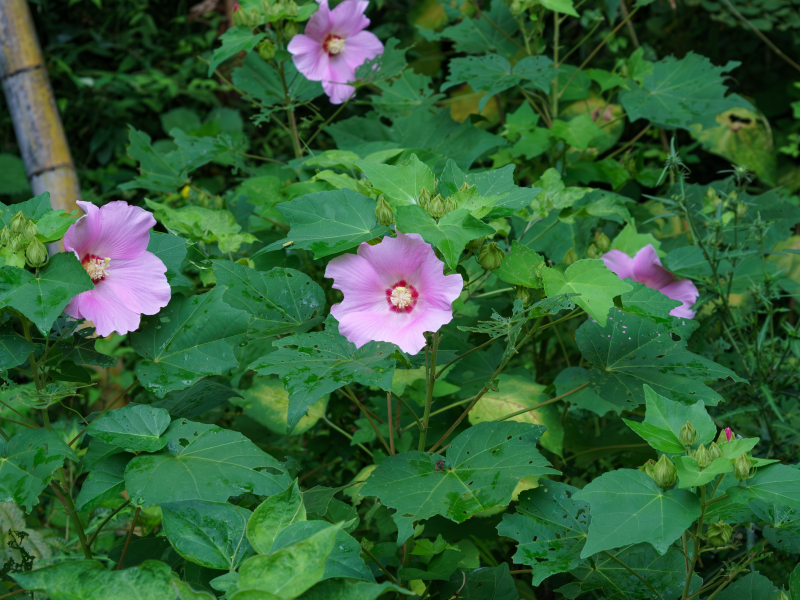
2025.09.23
オオアレチノギク
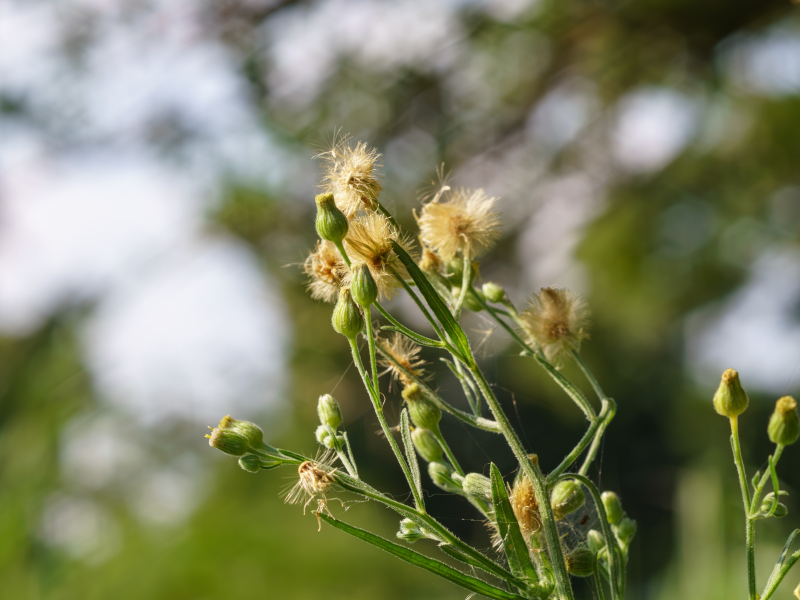
2025.09.19
ダンドボロギク
ダンドボロギクが咲いています。北アメリカ原産のキク科の一年草です。伐採跡地などによく生え、市街地よりも山地に多いようです。
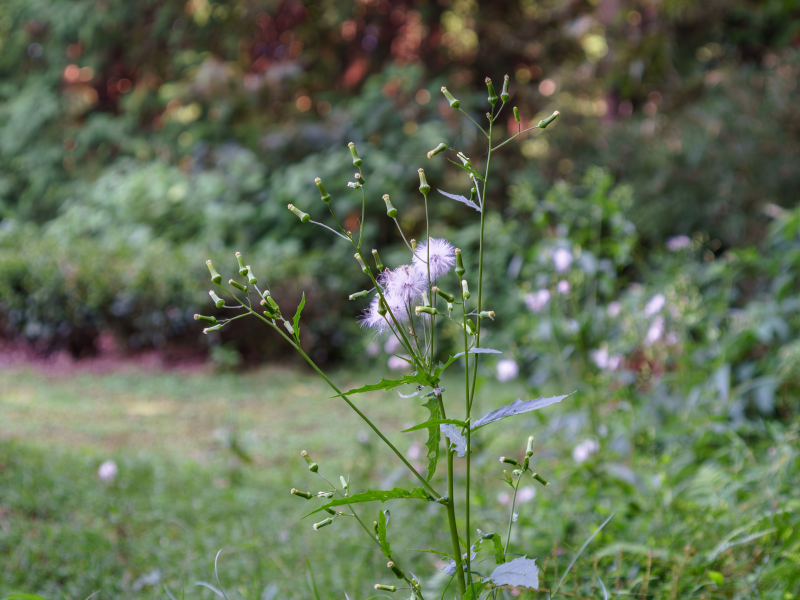
2025.09.16
ヒカゲイノコヅチ
ヒカゲイノコヅチが咲いています。林内に見られるヒユ科の多年草です。花は緑色であまり目立ちません。イノコヅチという名前は、果実がイノシシの体にくっついて散布されることに由来するようです。
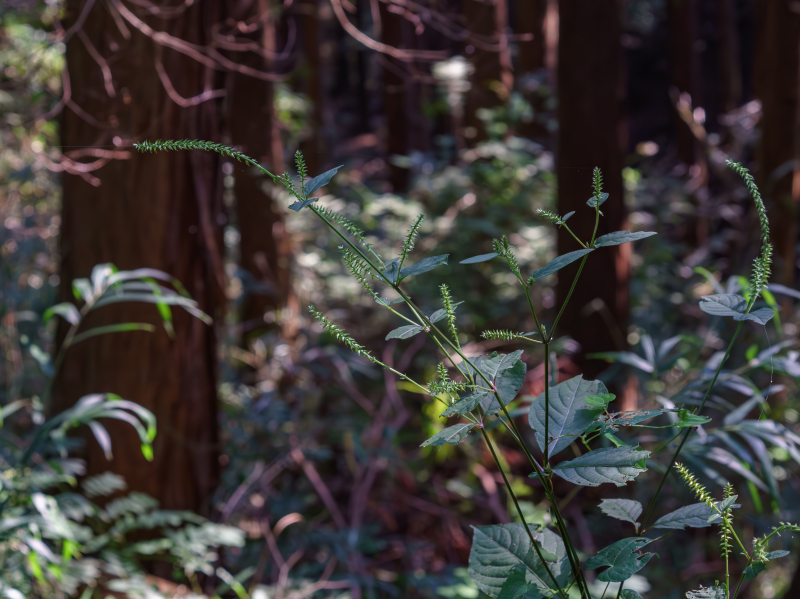
2025.09.12
アキカラマツ
アキカラマツが咲いています。草原などに生えるキンポウゲ科の多年草です。花には花弁がなく、がくも開花してすぐに脱落するため、多数のおしべだけが目立ちます。
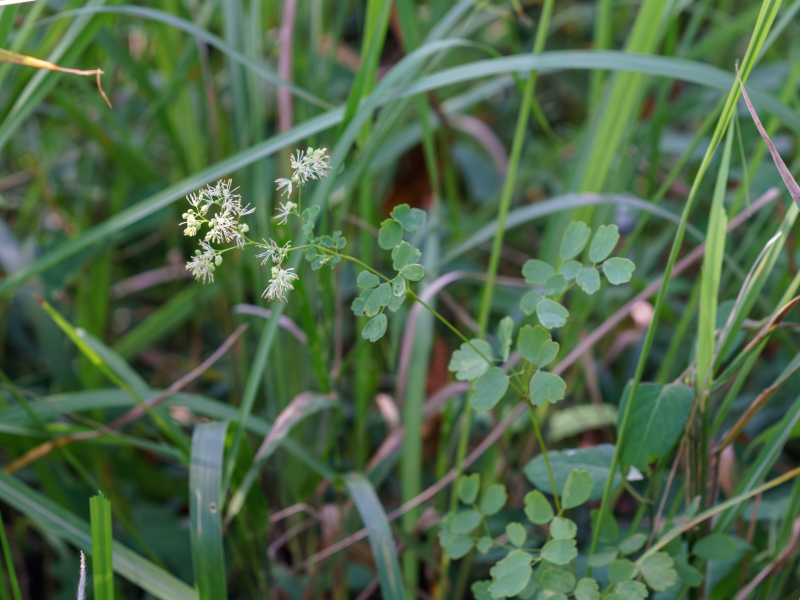
"Aki-Karamatsu" plants are in bloom. They are perennial plants in the Ranunculaceae family that grow in grasslands. Their flowers lack petals, and the sepals fall soon after flowering, leaving only the many stamens outstanding.
2025.09.09
キバナガンクビソウ
キバナガンクビソウが咲いています。林縁に生えるキク科の多年草です。単にガンクビソウとも呼ばれます。他の近縁種と同様に、和名のガンクビは花の形が、煙管(キセル)の先端部分の雁首(がんくび)に似ていることに由来します。
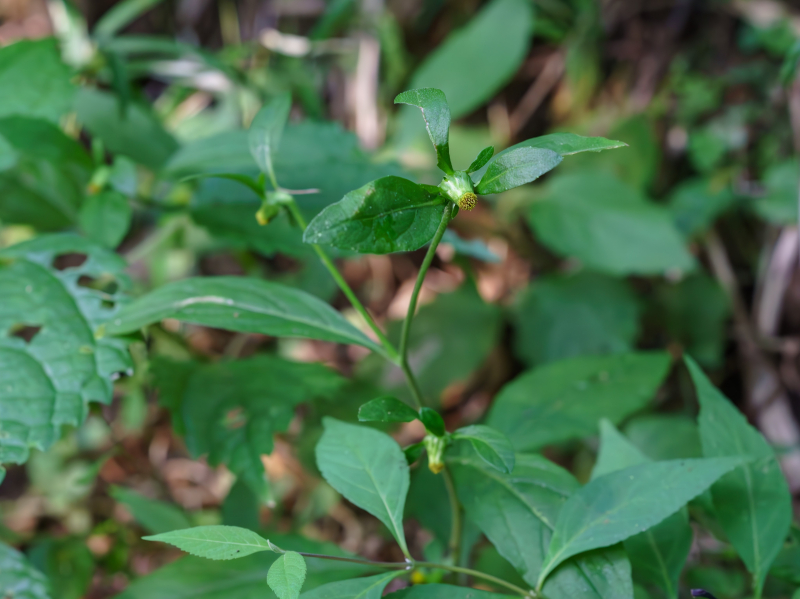
2025.09.05
ケナシヒメムカシヨモギ
ケナシヒメムカシヨモギが咲いています。空き地などに生えるキク科の越年草で、アメリカ原産の帰化植物です。西日本に多いようです。キャンパス内では茶草場で群生しています。
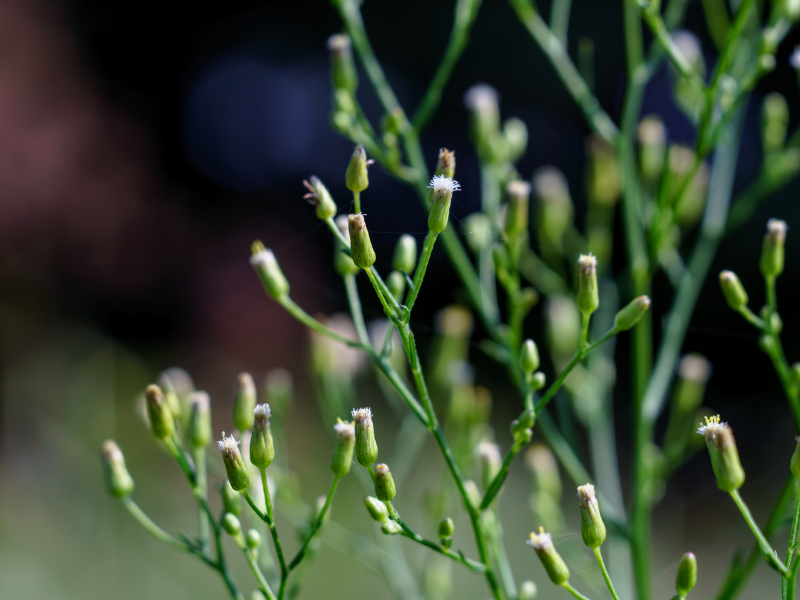
"Kenashi-Hime-Mukashiyomogi" plants are in bloom. These winter annuals in the Asteraceae family grow in vacant lots and are originally from North America. In Japan, they are more commonly found in western regions. On our campus, they grow in clusters within the Chagusaba field.
2025.09.02
ウリクサ
ウリクサが咲いています。畑などに生えるアゼナ科の一年草です。和名は、花のあと、小さいウリのような形の果実をつけることに由来するようです。

2025.08.26
タマアジサイ
タマアジサイが咲いています。沢沿いなどに見られるアジサイ科の低木です。和名はつぼみの時期に苞葉に包まれて球状になることに由来します。
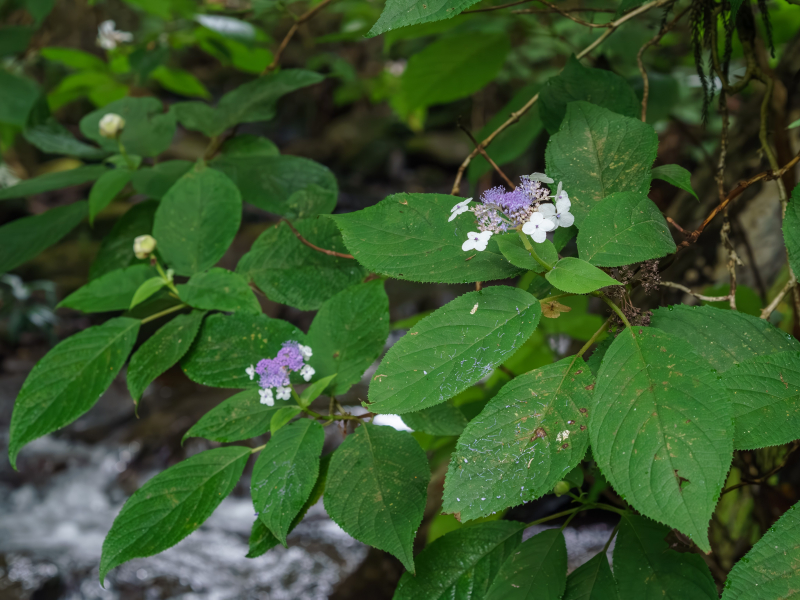
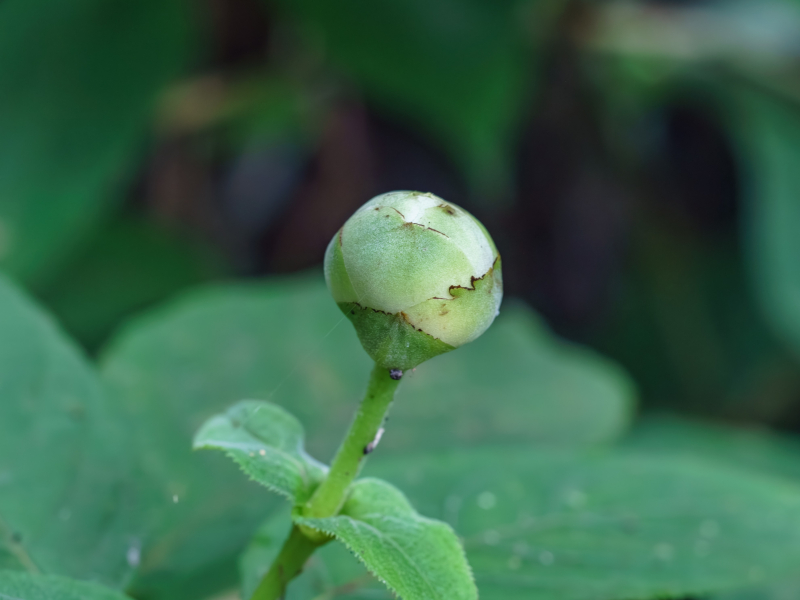
2025.08.19
ムカゴイラクサ
ムカゴイラクサが咲いています。林床に生えるイラクサ科の多年草です。葉や茎に刺毛があり、刺さると強い痛みがあります。和名の通り、葉の付け根にむかごをつけます。
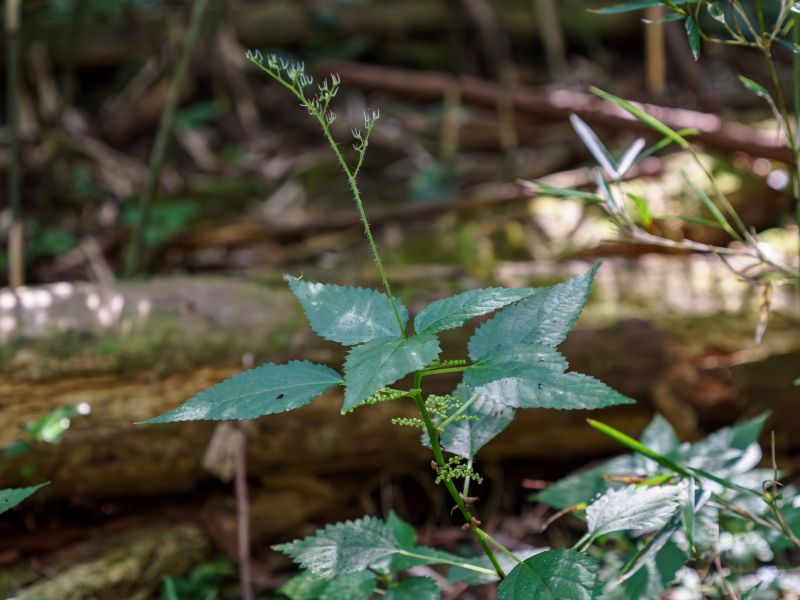
2025.08.12
フユイチゴ
フユイチゴが咲いています。林床に見られるバラ科のつる性常緑小低木です。和名は、冬に果実が熟すキイチゴであることに由来します。

2025.08.05
ツルニガクサ
ツルニガクサが咲いています。やや湿った林床などに生えるシソ科の多年草です。つる植物ではないのに、名前にツルがつきますが、これは細長い地下茎を伸ばすことが由来のようです。
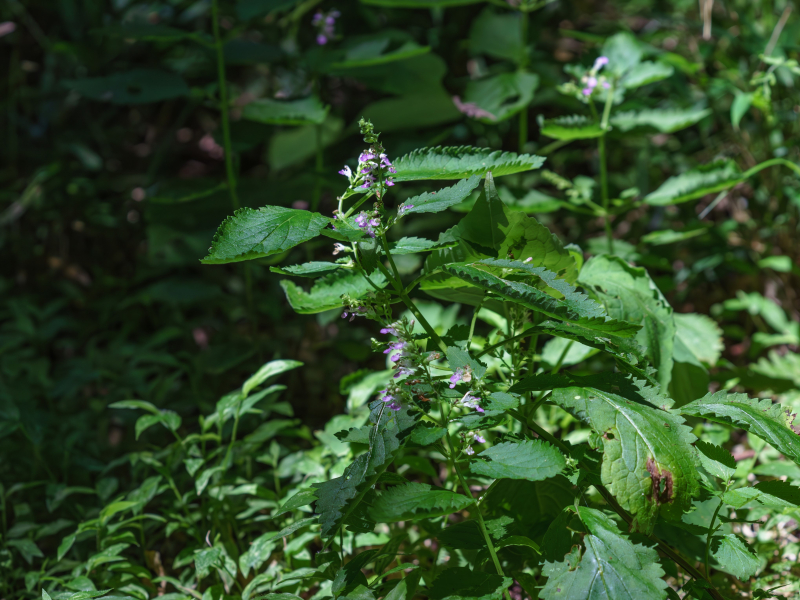
2025.08.01
ナガバハエドクソウ
ナガバハエドクソウが咲いています。林床や林縁などに普通に見られるハエドクソウ科の多年草です。和名は、有毒植物で、根を煮出した汁を用いてハエ取り紙を作ったことに由来すると言われています。

"Nagaba-Haedokusou" plants are in bloom. They are perennial plants in the Phrymaceae family that commonly grow along forest edges and on forest floors. The name comes from their poisonous nature and the fact that the broth made from their roots was once used to make flypaper.
2025.07.29
オオバチドメ
オオバチドメが咲いています。湿った林床などに見られるウコギ科の多年草です。近い仲間にオオチドメと呼ばれるものもあり、名前が似ていてまぎらわしいですが、オオバチドメの葉はオオチドメの倍以上に大きくなります。
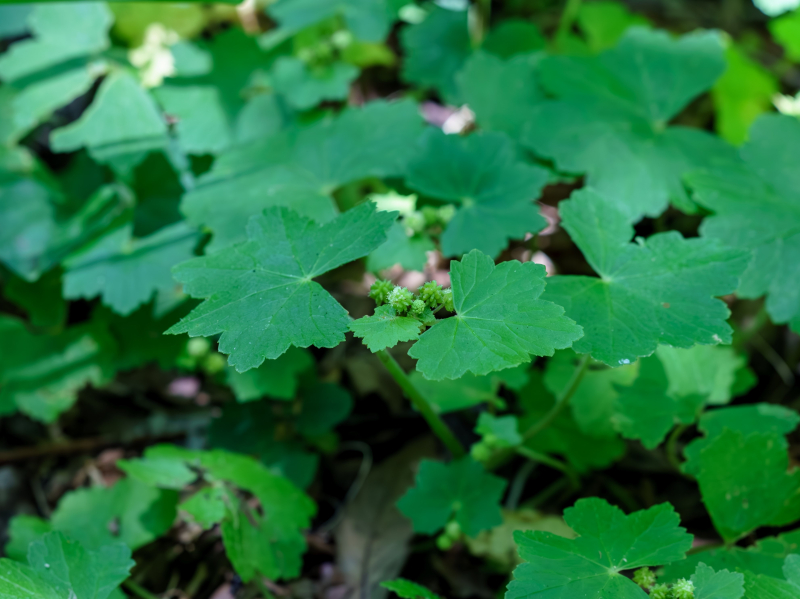
"Oochidome" plants are in bloom. They are perennial plants in the Araliaceae family that grow on slightly moist forest floors. A close relative species, called "Oochidome," has a similar name, which can be confusing. However, the leaves of "Oobachidome" grow more than twice as large as those of "Oochidome".
2025.07.25
イヌゴマ
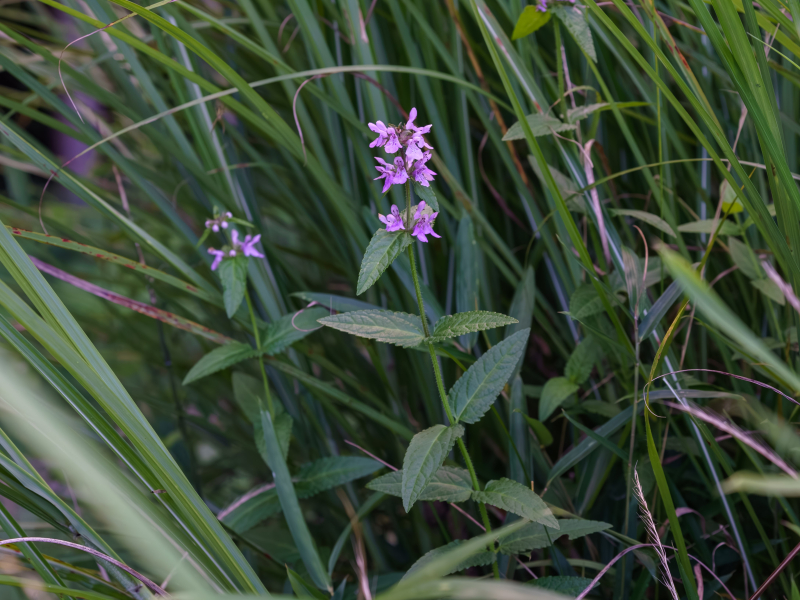
2025.07.18
ハグロソウ
ハグロソウが咲いています。林縁などに生えるキツネノマゴ科の多年草です。和名は葉黒草の意味で、葉が黒みを帯びた緑色であることに由来するといわれています。
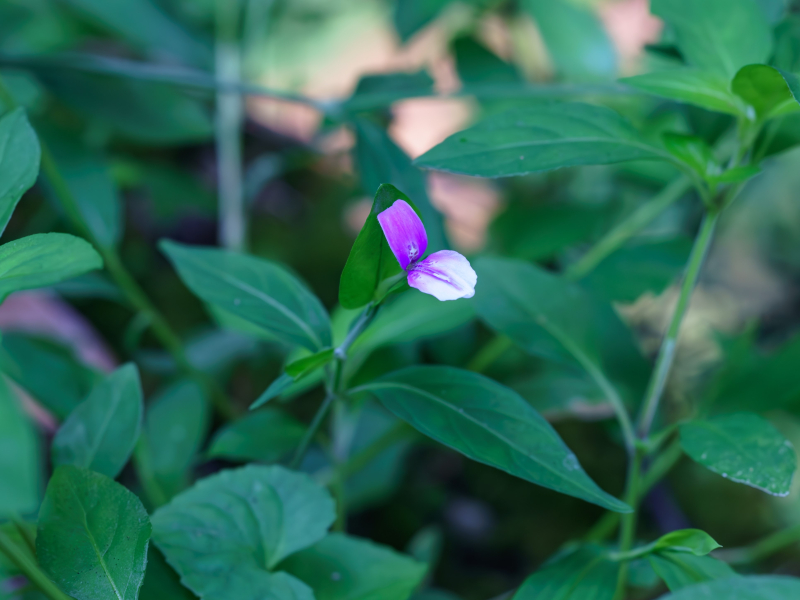
2025.07.15
クモラン
クモランが咲いています。ウメの古木などに着生するランの仲間です。葉は無く、放射状に広がる根に葉緑体を含み、光合成を行っています。和名はこの姿をクモに見立てたものです。
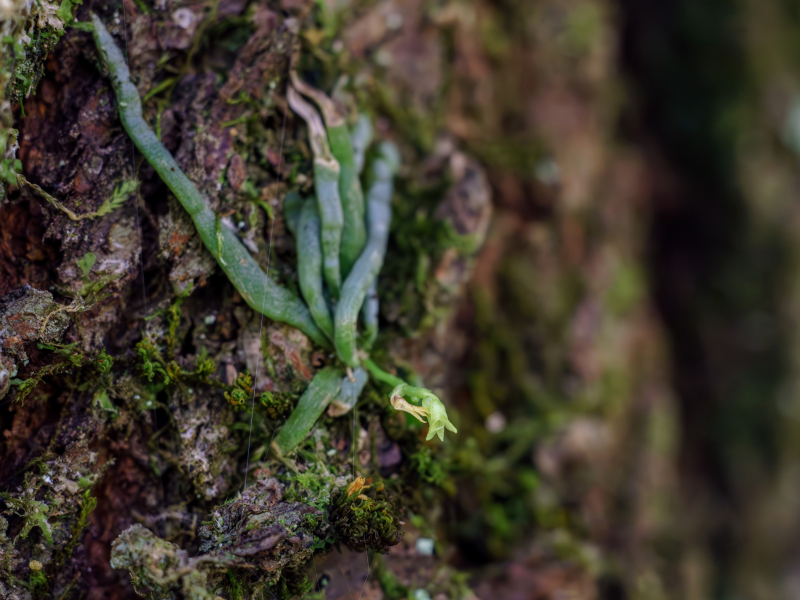
2025.07.11
トチバニンジン
トチバニンジンが咲いています。山地の林内に生えるウコギ科の多年草です。名前にニンジンとつきますが、野菜の人参(セリ科)の仲間ではなく、薬用植物として知られる朝鮮人参(高麗人参)の仲間です。
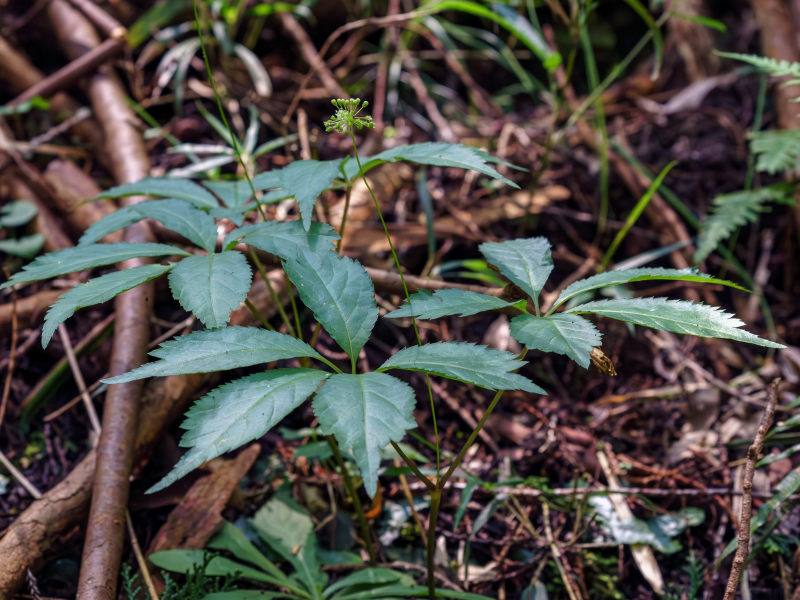
"Tochiba-Ninjin (トチバニンジン)" plants are in bloom. They are perennial plants in the Araliaceae family that typically grow in mountain forests. Despite the word "Ninjin" (carrot) in their name, they are not related to carrots, which are part of the Apiaceae family. Instead, they are closely related to ginseng.
2025.07.08
オオチドメ
オオチドメが咲いています。芝地などで普通に見られるウコギ科の多年草です。和名は、葉や茎を揉んで得られた汁を止血に用いたことに由来します。
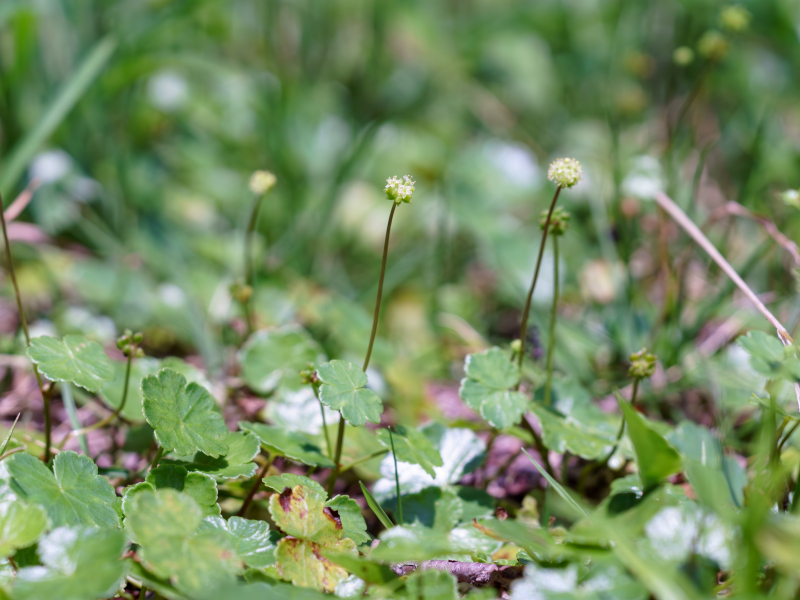
"Oochidome (オオチドメ)" plants are in bloom. They are perennial plants in the Araliaceae family that commonly grow in grassy areas. The name “Oochidome” comes from their traditional use- juice extracted from their leaves and stems was used to stop bleeding.
2025.07.04
ナワシロイチゴ
ナワシロイチゴの実がなっています。日当たりのよい草地などに生えるキイチゴの仲間です。和名は、田植えの前に稲の苗を育てる場所である苗代(なわしろ)を準備する時期に実が熟すことに由来します。
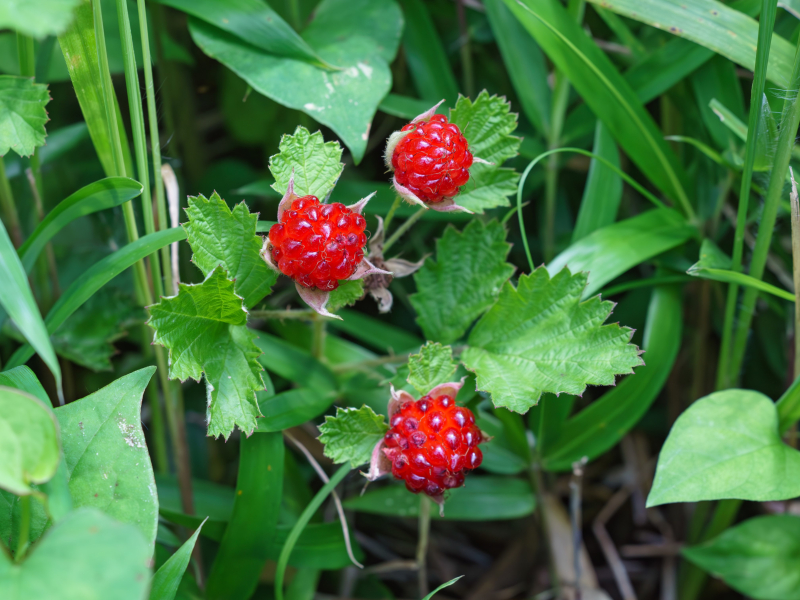
2025.07.01
タシロラン
タシロランが咲いています。光合成をしないで、養分を菌類に完全に依存しているランのなかまです。1970年代まではとても珍しいランだったそうですが、現在では分布を広げているようです。
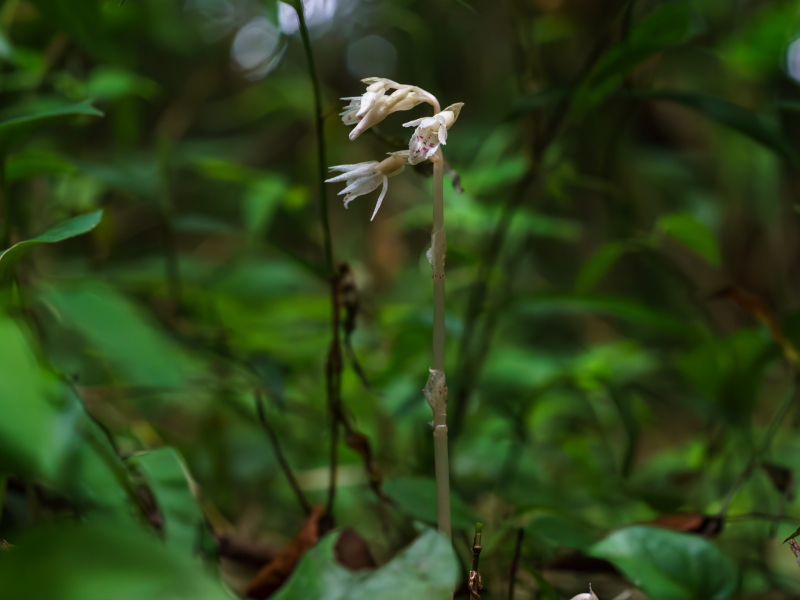
2025.06.27
ヒメヨツバムグラ
ヒメヨツバムグラが咲いています。日当たりのよい草地などによく見られるアカネ科の多年草です。名前にムグラとつく仲間は多く、互いによく似ていています。本種は比較的身近な場所でよく見られます。

2025.06.24
ブタナ
ブタナが咲いています。ヨーロッパ原産の帰化植物で、タンポポに似た花を咲かせます。空き地などに真っ先に侵入しますが、周りの植物の草丈が高くなると姿を消していくようです。キャンパス内ではよく芝刈りがされる場所にかえってよく生えています。
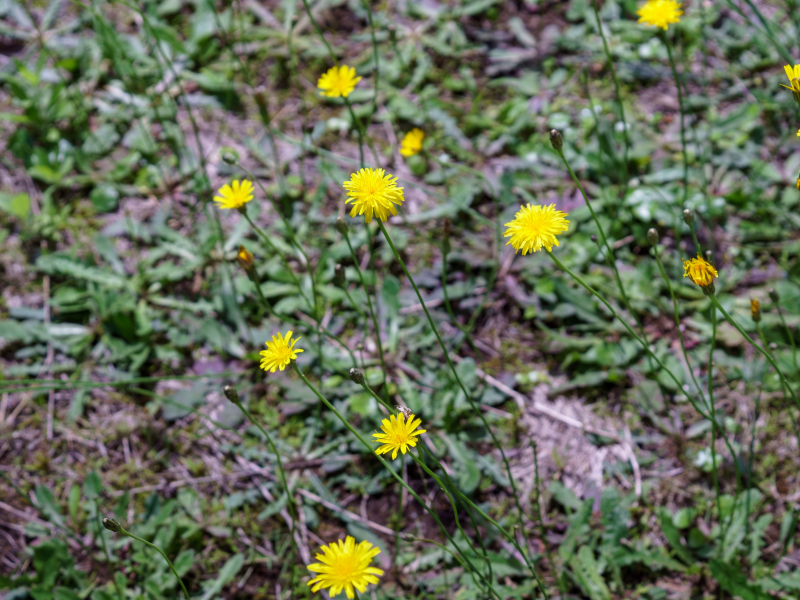
2025.06.20
ヤマホタルブクロ
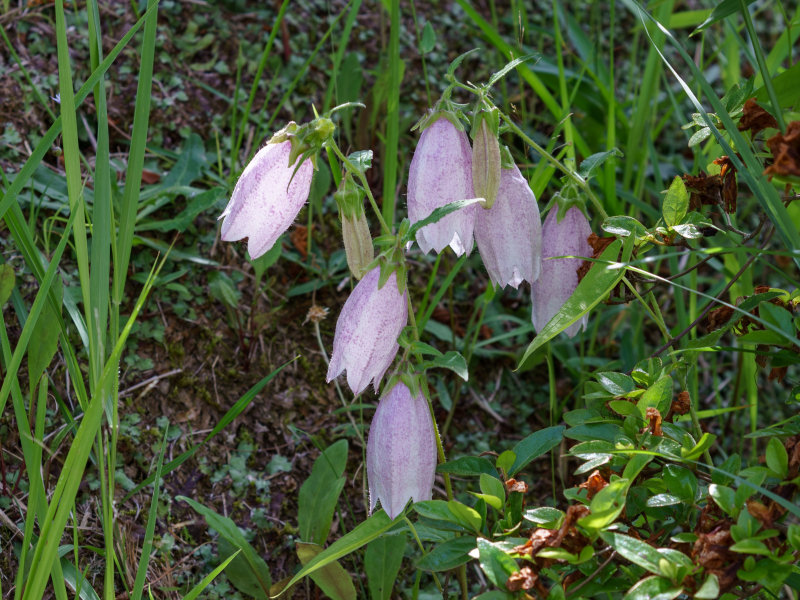
2025.06.17
マメグンバイナズナ
マメグンバイナズナが咲いています。北アメリカ原産のアブラナ科の越年草です。明治時代に入ってきたそうですが、現在では空き地などで普通に見られます。
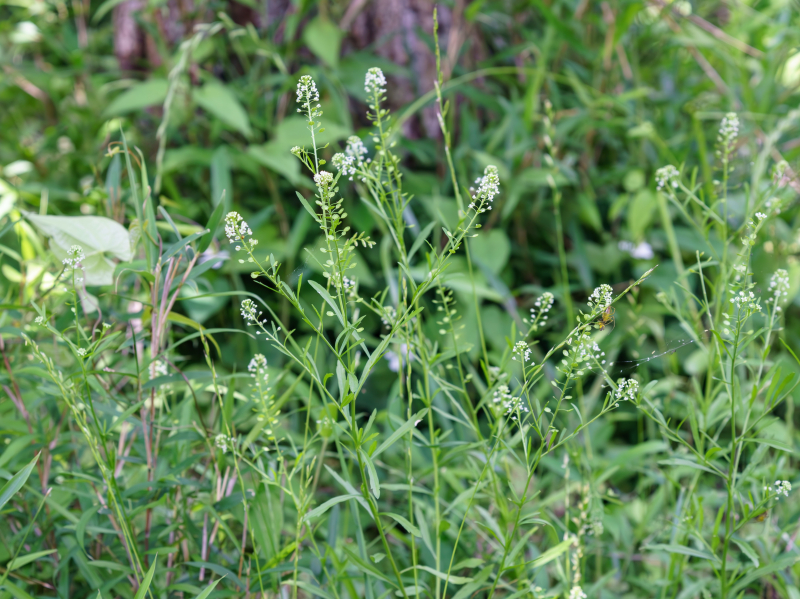
2025.06.13
トキワツユクサ
トキワツユクサが咲いています。名前の通り、ツユクサ科の常緑の多年草です。北アメリカ原産で、園芸種が野生化したものです。繁殖力が強く、生態系への影響が懸念されています。
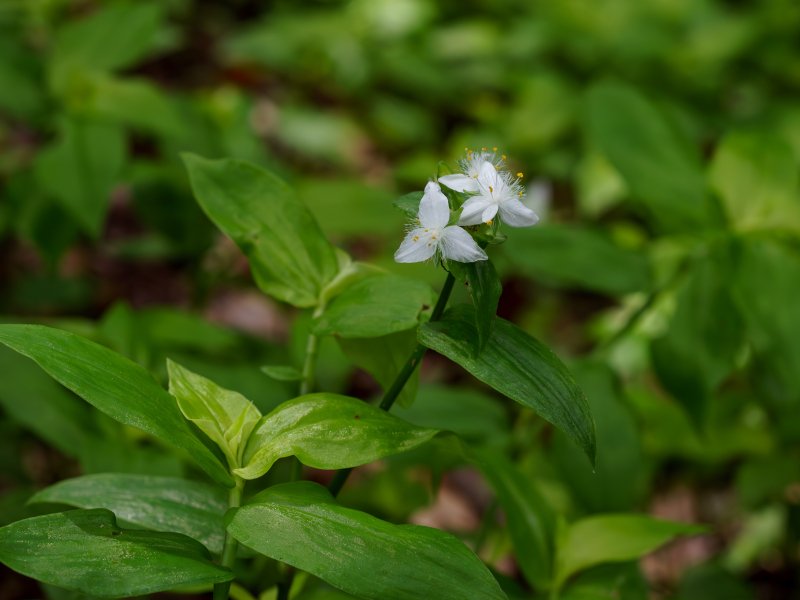
"Tokiwa-Tsuyukusa (トキワツユクサ)" plants are in bloom. As their name suggests, they are evergreen perennial plants in the Commelinaceae family. They originally come from North America and cultivated ones have spread into the wild. Due to their strong reproductive ability, there are concerns about their impact on the ecosystem.
2025.06.10
ユキノシタ
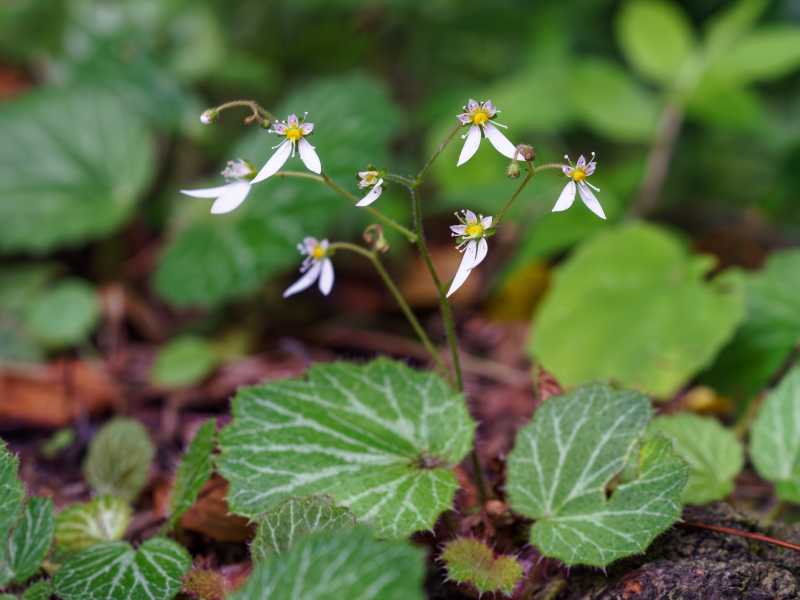
2025.06.06
オニマタタビ
オニマタタビの花が咲いています。マタタビ科の落葉つる性木本で、別名のキウイフルーツのほうが一般的です。果樹として栽培されていたものが逸出、野生化したものが分布を広げているようです。雄木と雌木に分かれており、写真の個体は雄木のため、残念ながら果実はできません。
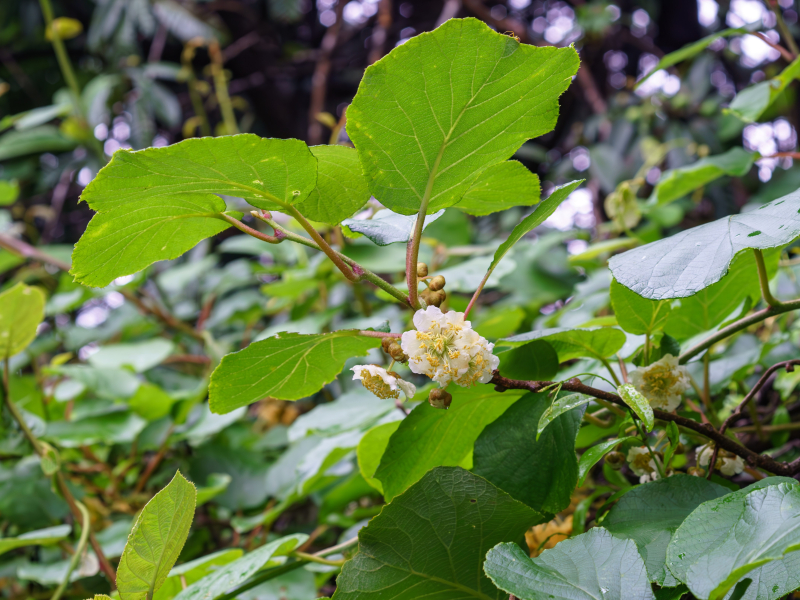
2025.06.03
クモキリソウ
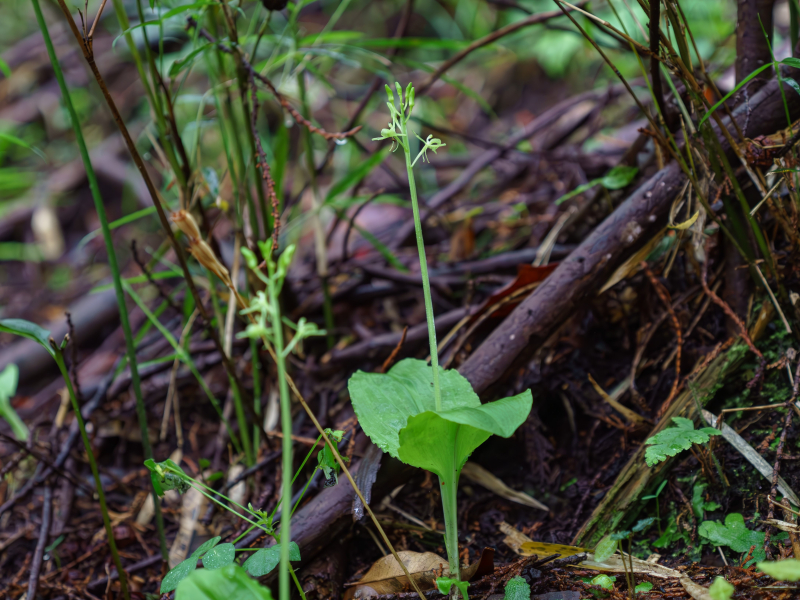
2025.05.30
サンショウ
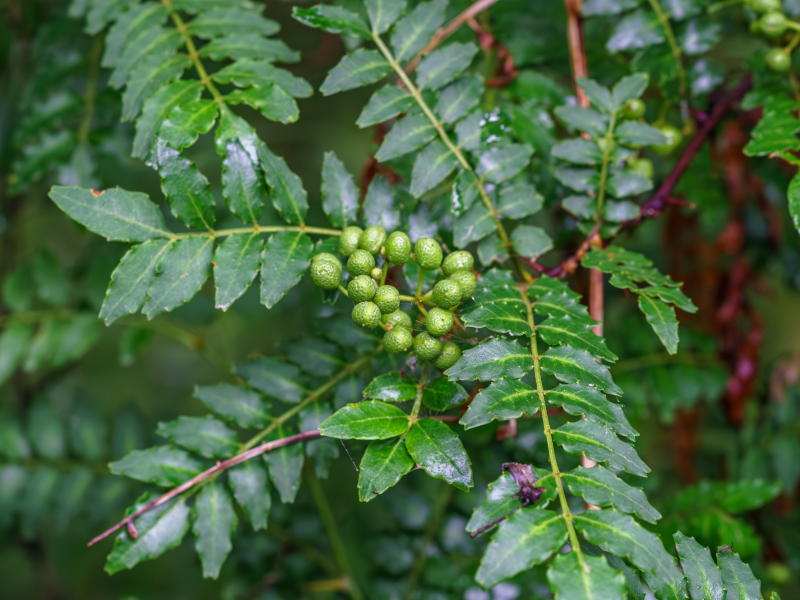
2025.05.27
スイカズラ
スイカズラが咲いています。スイカズラ科のつる性木本で、林縁や道端などでもよく見られます。花ははじめ白色で、後に黄色に変化することから、キンギンカ(金銀花)という別名もあります。
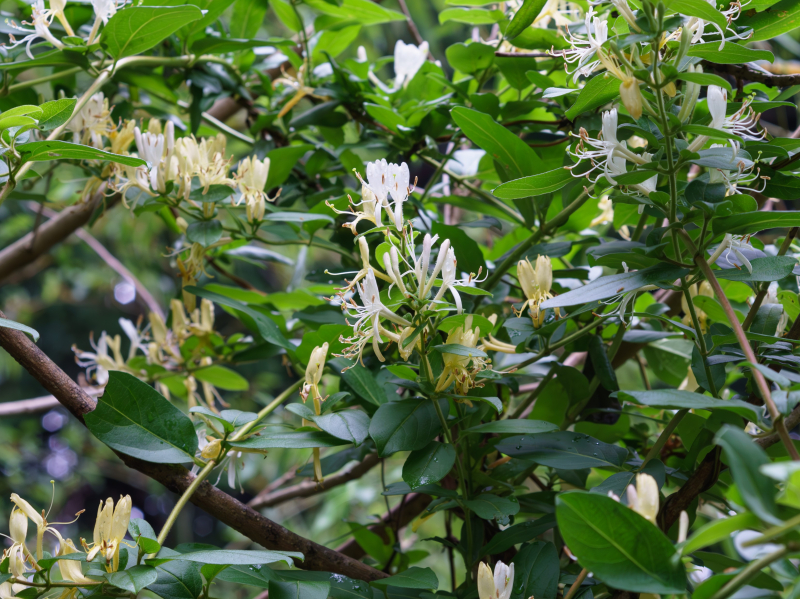
"Suikazura (スイカズラ)" trees are in bloom. They are woody vines in the Caprifoliaceae family that grow on the edges of forests and roadsides. Their flowers start out white and gradually turn yellow, which is why they are also called "Kin-Gin-ka (キンギンカ)", which means "Gold and Silver-flower" in Japanese.
2025.05.23
ヤマサギソウ
ヤマサギソウが咲いています。日当たりのよい草地に生えるランの仲間です。草地の減少などから多くの地域で絶滅が危惧されています。不二聖心では茶草場農法によって草地に生息する貴重な動植物の生育環境が維持されています。
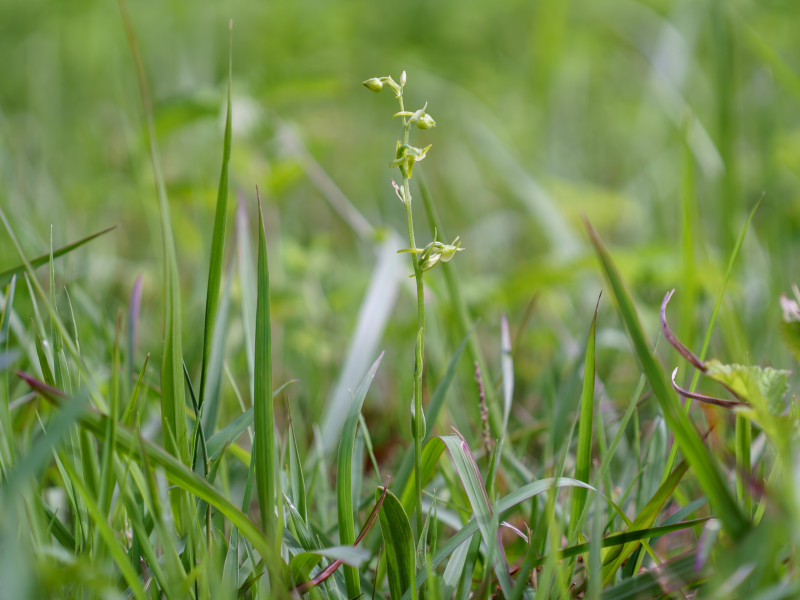
2025.05.20
オカウコギ
オカウコギが咲いています。ウコギ科の落葉低木で、落葉樹林内に見られます。近縁種のヤマウコギととても似ているようですが、葉の表面に立毛があることなどで見分けることができます。若芽は食用となります。
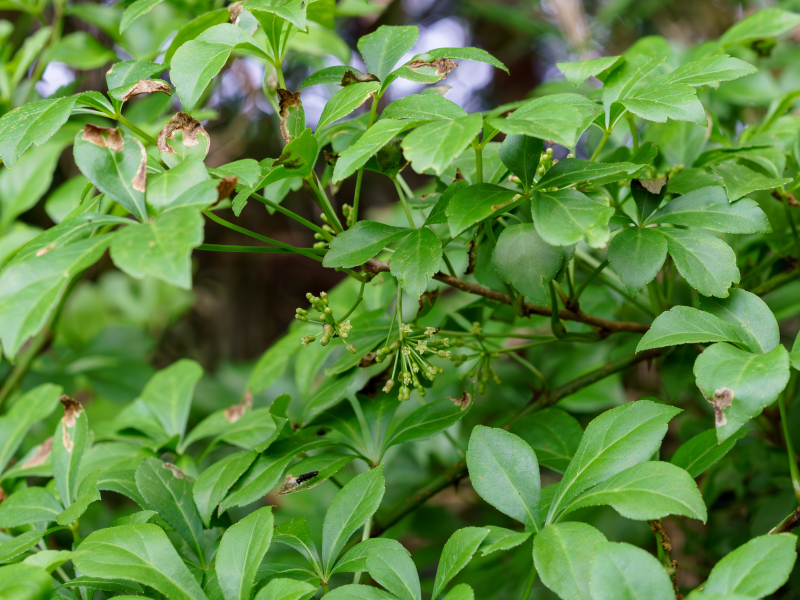
2025.05.16
クロチク
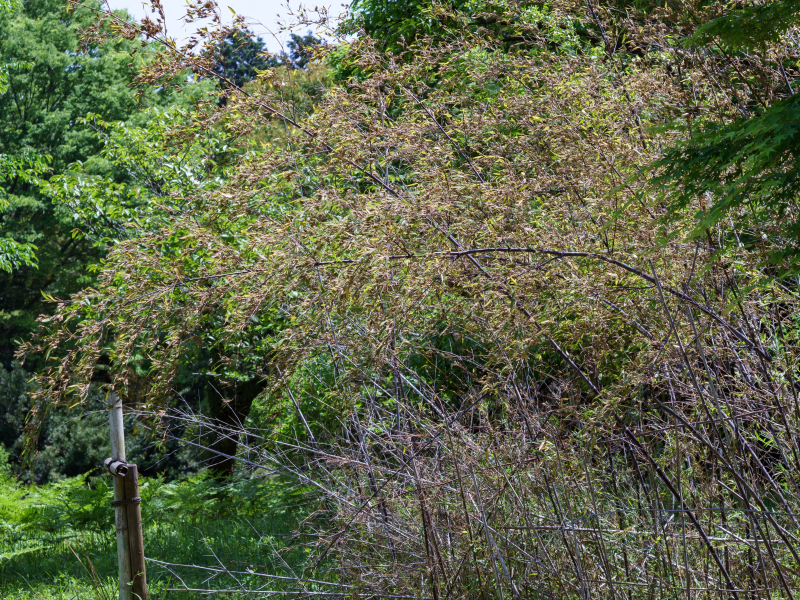

2025.05.13
ポポー
ポポーが咲いています。北アメリカ原産のバンレイシ科の落葉樹で、春にチョコレート色の花を咲かせます。秋に熟す果実は食用となります。雑木林などに逸出したものが見られることがあり、この個体もヒノキ林の林縁に生えていました。
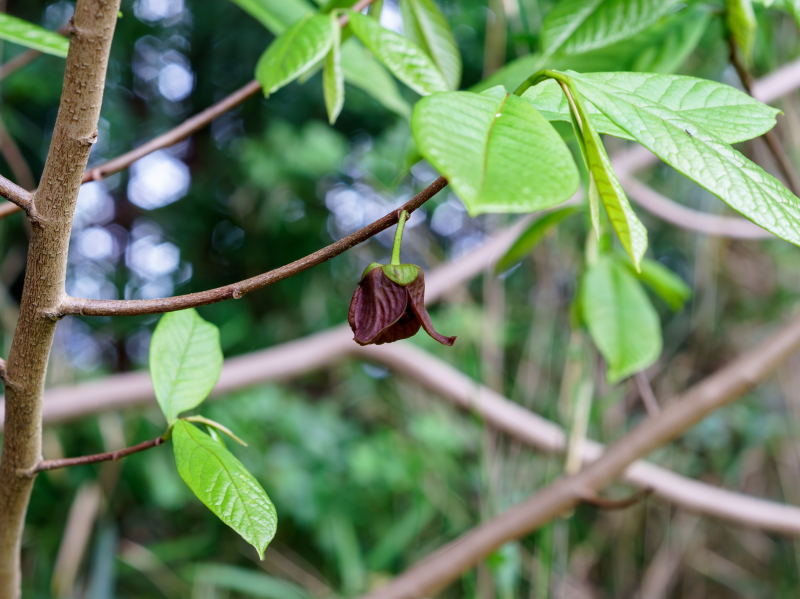
Pawpaw trees are in bloom. They are deciduous trees native to North America and produce chocolate-colored flowers in spring. Cultivated trees sometimes spread into woods, and the one in the photo is growing on the edge of a Japanese cypress forest.
2025.05.09
アマドコロ
アマドコロが咲いています。草地や明るい林内に生えるキジカクシ科の多年草です。花は近縁のナルコユリに似ていますが、アマドコロは茎に稜があることで見分けることができます。

2025.05.06
フジ
フジが咲いています。マメ科のつる性落葉木本です。他の樹木に巻きつき、樹冠をおおうほど高く上ります。古くから観賞用に栽培され、各地に藤の名所があります。
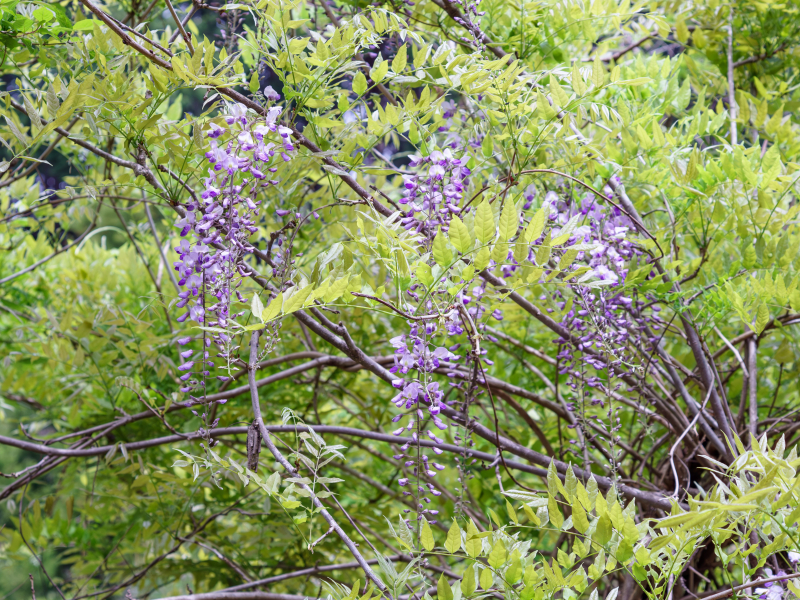
2025.05.02
サンショウ
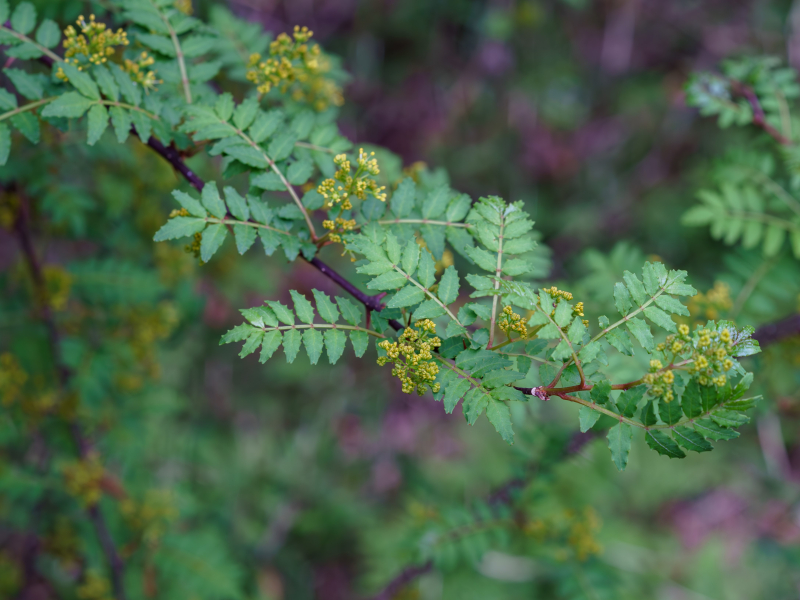
2025.04.29
ムラサキケマン
ムラサキケマンが咲いています。道端などに生えるケシ科の越年草です。近縁種のなかで最も普通に見られます。
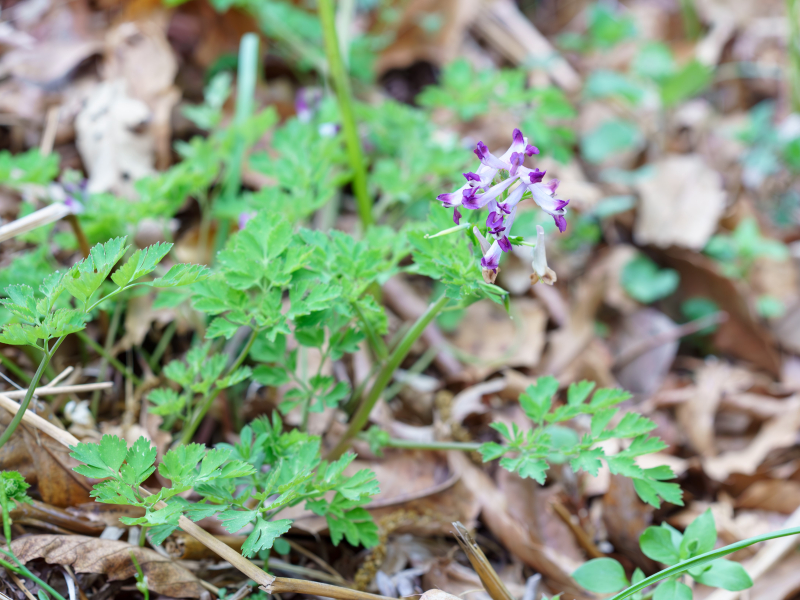
2025.04.22
サルトリイバラ
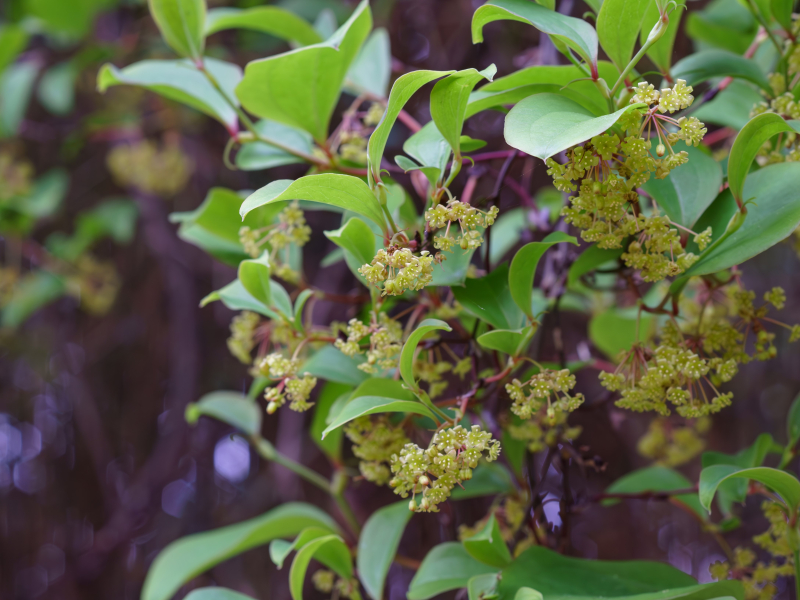
"Sarutoriibara (サルトリイバラ)" trees are in bloom. They are deciduous climbs that are often seen on the edges of forests. The name suggests that their bushes created by their thorny branches catch monkeys.
2025.04.18
セントウソウ
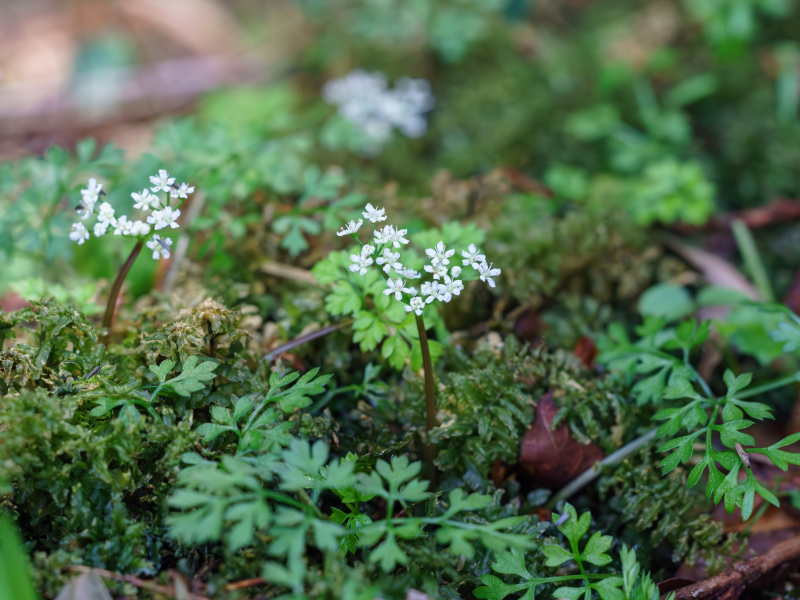
2025.04.15
コクサギ
コクサギが咲いています。林内の沢沿いに生える落葉低木です。ミカン科に属し、葉に独特の匂いがあります。和名は小臭木(こくさぎ)の意味で、独特の匂いがあることに由来します。
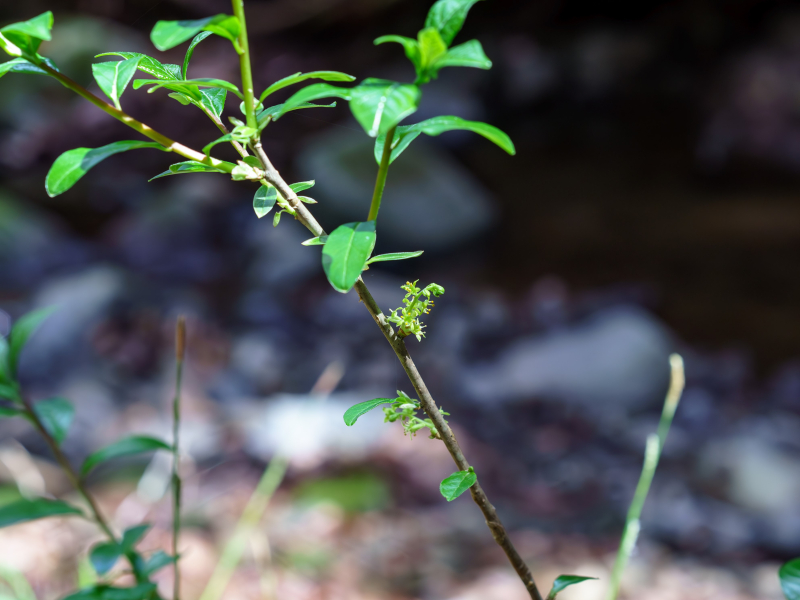
2025.04.11
カントウミヤマカタバミ
カントウミヤマカタバミが咲いています。樹林内に生え、白い花を咲かせるカタバミです。ミヤマカタバミの変種とされ、葉の裏面の毛が少ないなどの特徴があります。

2025.04.08
ソメイヨシノ
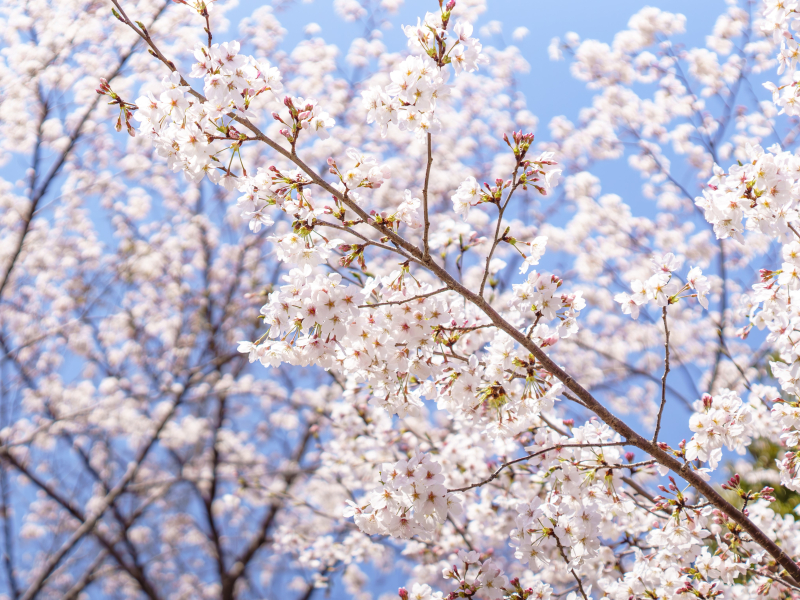
2025.04.01
タラノキ
タラノキの新芽が伸びています。伐採跡地などにいち早く生えてくる落葉低木です。新芽はタラの芽と呼ばれ、春の山菜として親しまれており、栽培品はスーパーなどでも売られています。鹿の好物でもあるらしく、キャンパス内でも食べられた跡をよく見ます。
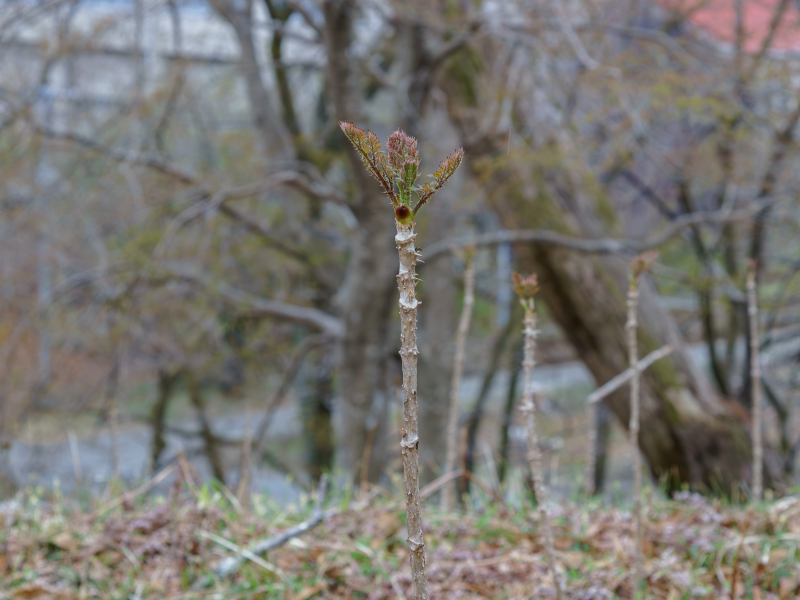
2025.03.28
キブシ
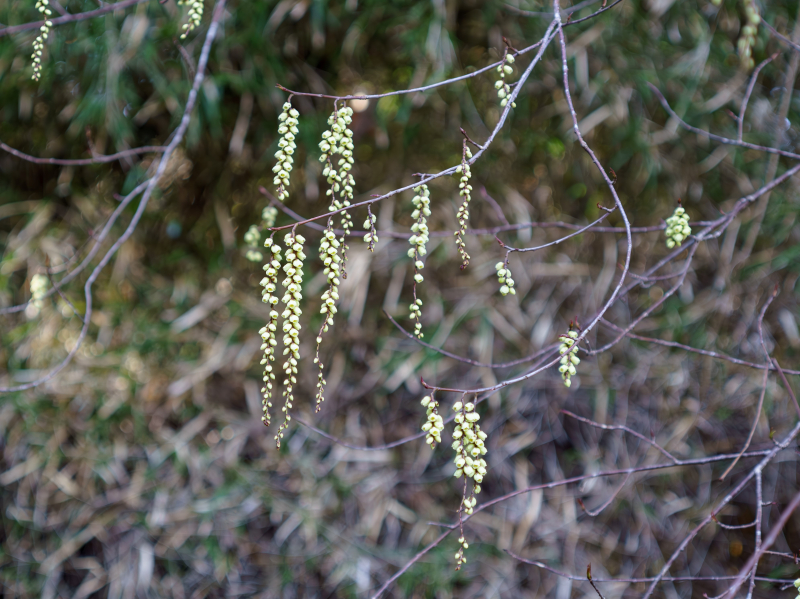
2025.03.25
バイモ
バイモが咲いています。中国原産の薬用植物ですが、観賞用に植えられることもあります。道端などには野生化したものが見られます。アミガサユリとも呼ばれ、花の内側に網目模様があることに由来するようです。
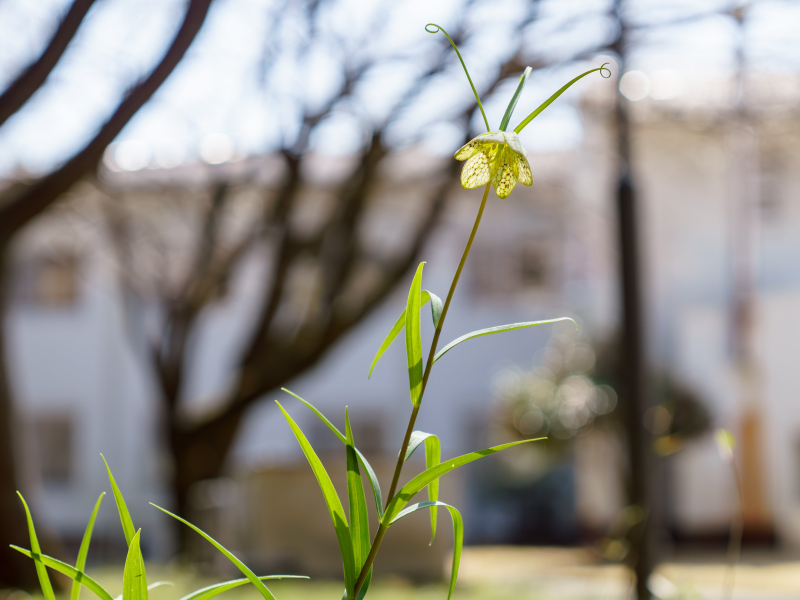
2025.03.21
ヤブツバキ
ヤブツバキが咲いています。常緑の高木で照葉樹林に見られる代表的な樹種です。多数の雄しべは根元でつながっていて筒状になっているのが特徴です。多くの栽培品種があり、庭や公園などに植栽されています。
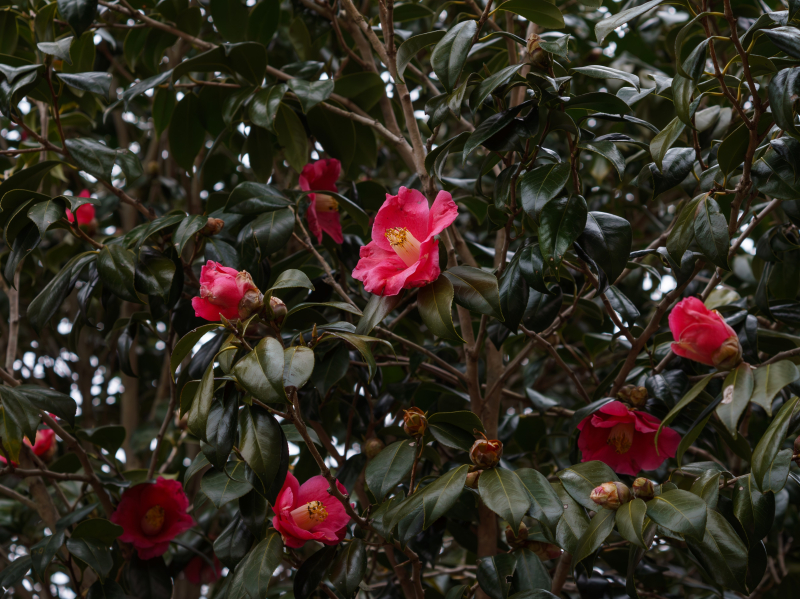
2025.03.11
ナズナ
お茶畑の周りでナズナが咲いています。空き地などで普通に見られる越年草です。和名は撫でるほどかわいらしい花という意味の「撫で菜(なでな)」から転じたものと言われています。

2025.03.04
ラッパズイセン
ラッパズイセンが咲いています。ヨーロッパ原産の園芸種で、ときに逸出して野生化しています。海岸付近で自生しているスイセンが1本の茎に複数の花をつけるのに対し、ラッパズイセンのなかまは1本の茎に1つの花をつけます。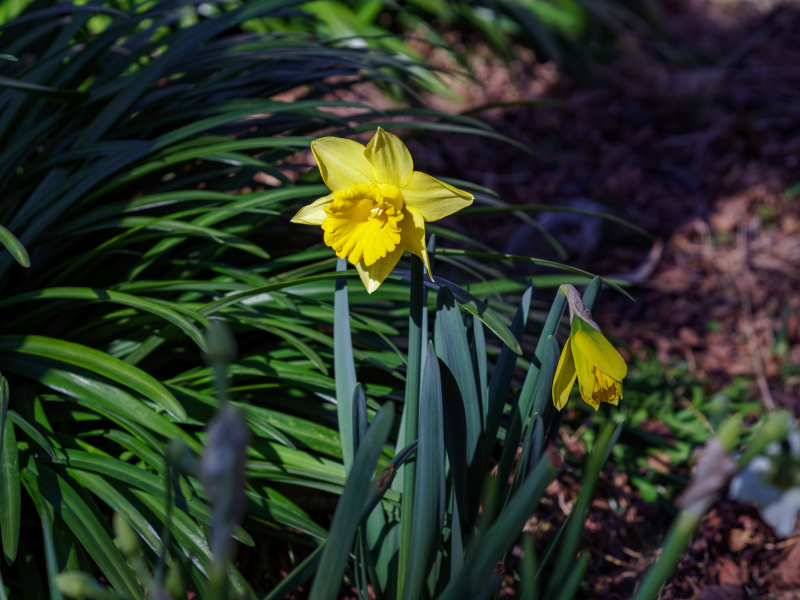
2025.02.25
スイセン
スイセンが咲いています。海岸近くに自生しているヒガンバナ科の多年草です。古い時代に中国を経由して日本に渡来したといわれています。さまざまな園芸品種があり、写真の個体は八重咲きの品種です。
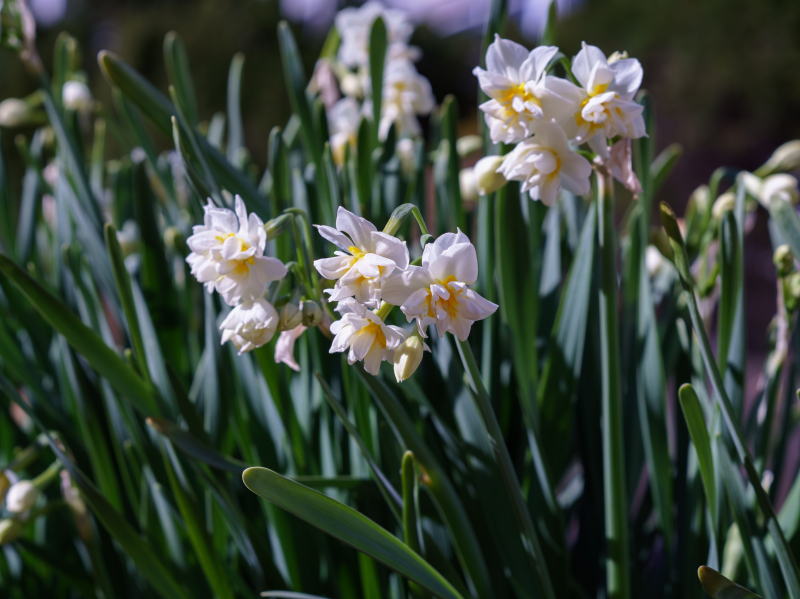
2025.02.21
バイカオウレン
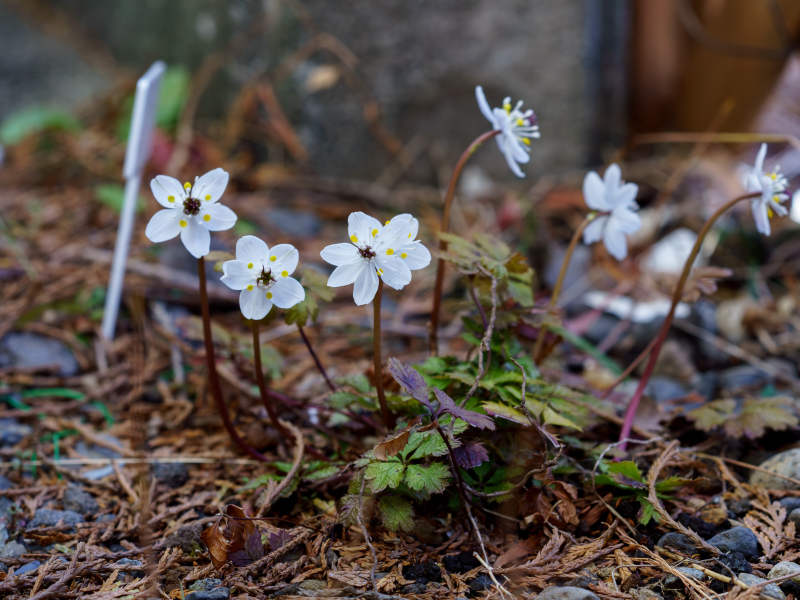
A "Baika-Ouren (バイカオウレン)" plant is in bloom on the balcony in front of the 10th-grade classrooms. They originally grow on the floors of coniferous forests. They are known as the plants loved by Dr. Makino Tomitaro, who is regarded as the father of plant taxonomy in Japan. The one in the photo was bought when a science teacher visited the Kochi Prefectural Makino Botanical Garden and was planted here.
2025.02.18
オニシバリ
オニシバリが咲いています。樹林内に見られる落葉低木ですが、多くの落葉樹とは反対に冬に葉をつけて、夏に落葉します。ふつうオニシバリの花は、がくの先端が4枚に分かれて花弁状になりますが(写真2枚目)、1枚目の写真のように6枚に分かれた花を見つけました。同じ木の他の花はふつうの花だったので、たまたまこの花だけが変異したようです。
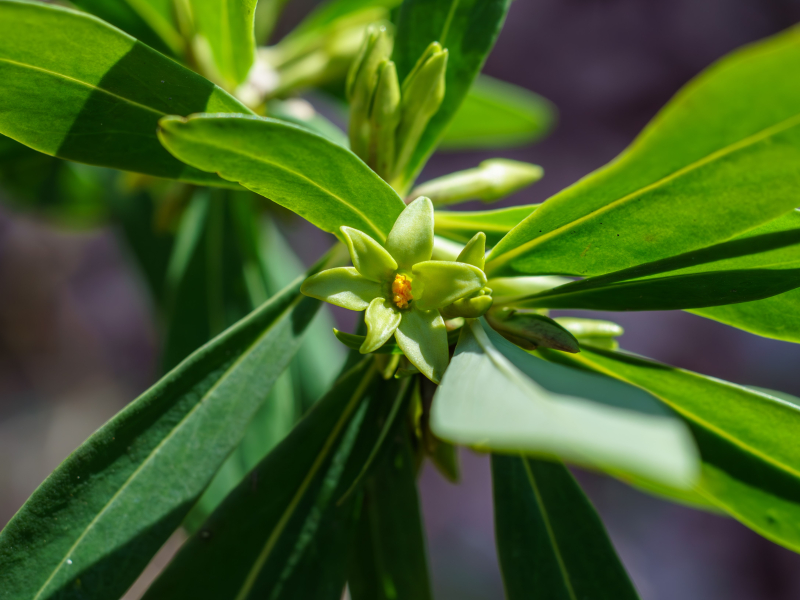
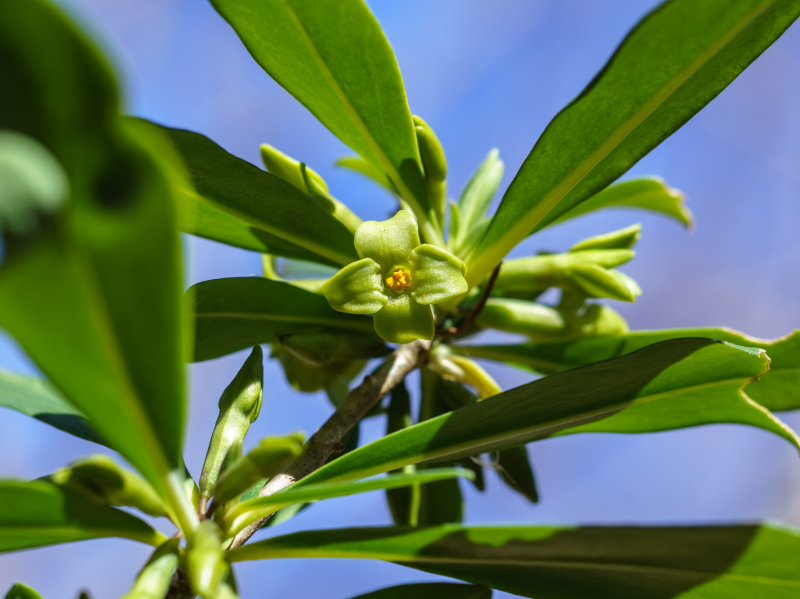
2025.02.04
サザンカ
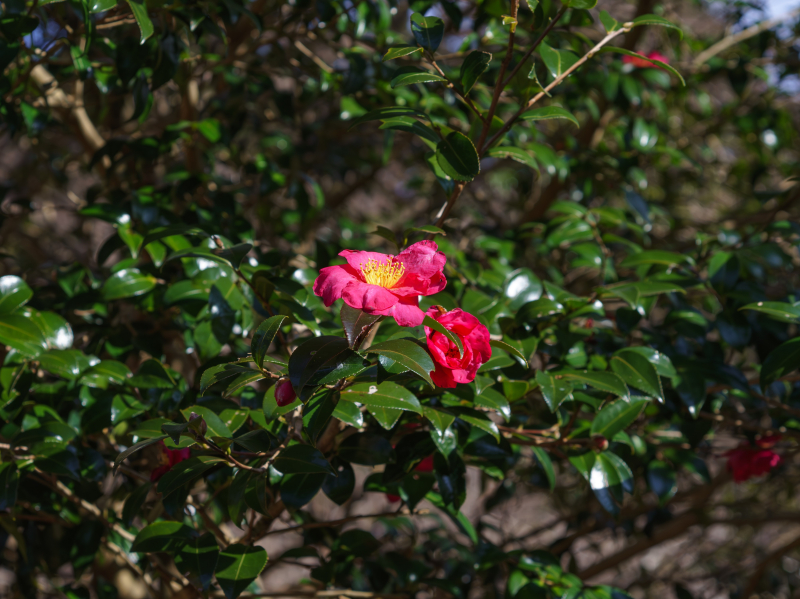
2025.01.07
シンテッポウユリ
シンテッポウユリが咲いています。タカサゴユリとテッポウユリの雑種由来の園芸品種です。野生化したものが道端などいたるところで咲いています。本来の花期は夏ですが、まれに冬になっても咲いている個体が見られます。
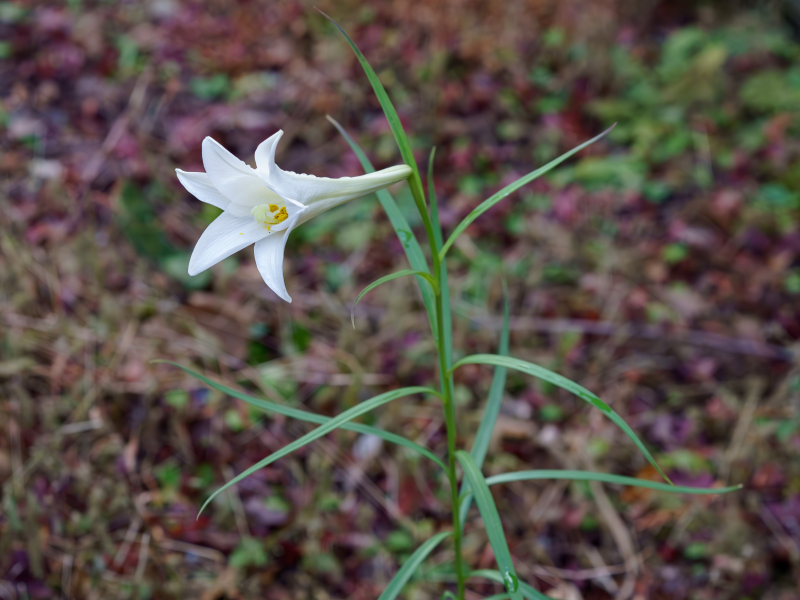
2024.12.27
コナスビ
コナスビが咲いています。サクラソウ科の多年草で、道端などで普通に見られます。冬も葉をつけたまま越冬しますが、条件によっては葉が紅葉するようです。花期は初夏とされていますが、冬でも咲いていることがあります。

2024.12.24
オモト
オモトが果実をつけています。キジカクシ科の常緑多年草です。古くから栽培され、多くの園芸品種があります。花は初夏に咲き、冬に赤い実をつけます。
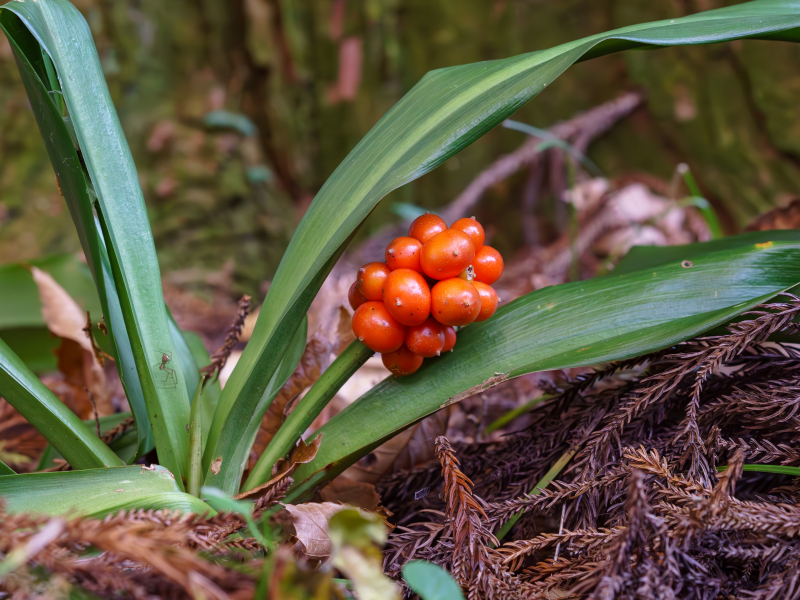
2024.12.20
ツルグミ
ツルグミが咲いています。グミ科のつる性常緑低木で、林内や林縁でよく見られます。和名はつる性のグミという意味で、果実は春に熟します。
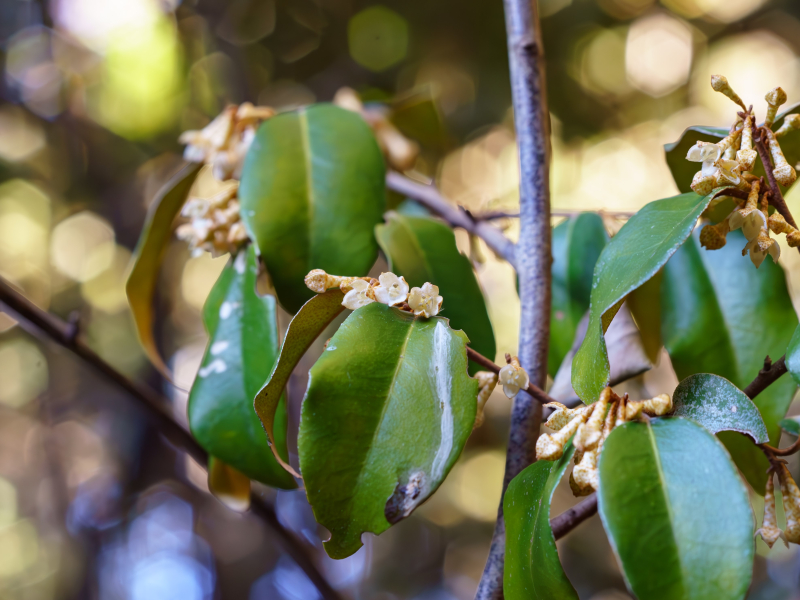
2024.12.17
シロダモ
シロダモが咲いてます。クスノキ科の常緑の中高木で、林内でよく見られます。雌雄異株で、写真は雄株です。和名は、タブノキに似ていて、葉の裏が白いことに由来するようです。
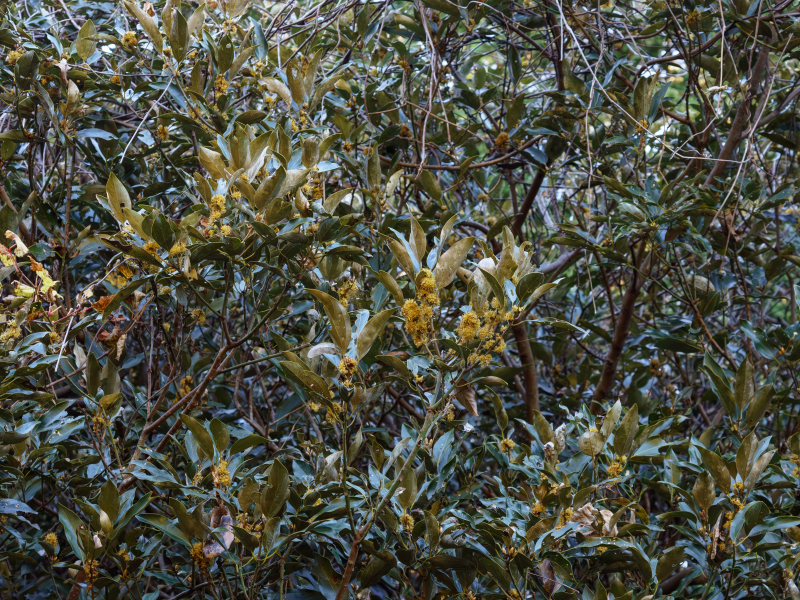
2024.12.13
ビワ
ビワが咲いています。バラ科の常緑樹で、果樹として栽培されています。花は冬に咲き、果実は翌年の初夏に熟します。
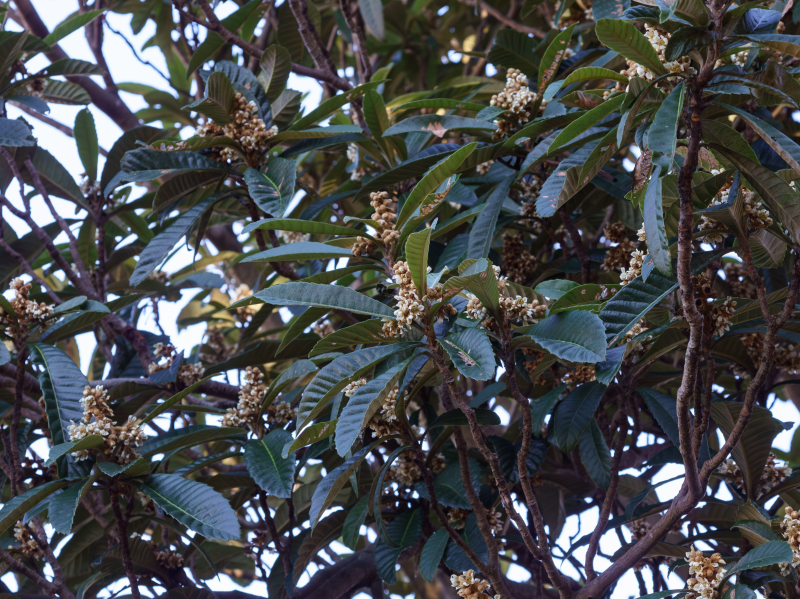
2024.12.10
ウシハコベ

2024.12.06
リュウキュウハゼ
リュウキュウハゼが紅葉しています。ウルシ科の落葉高木で、ハゼノキとも呼ばれます。果実から和ロウソクの原料となるロウをとるために植栽されたものが広がったといわれています。
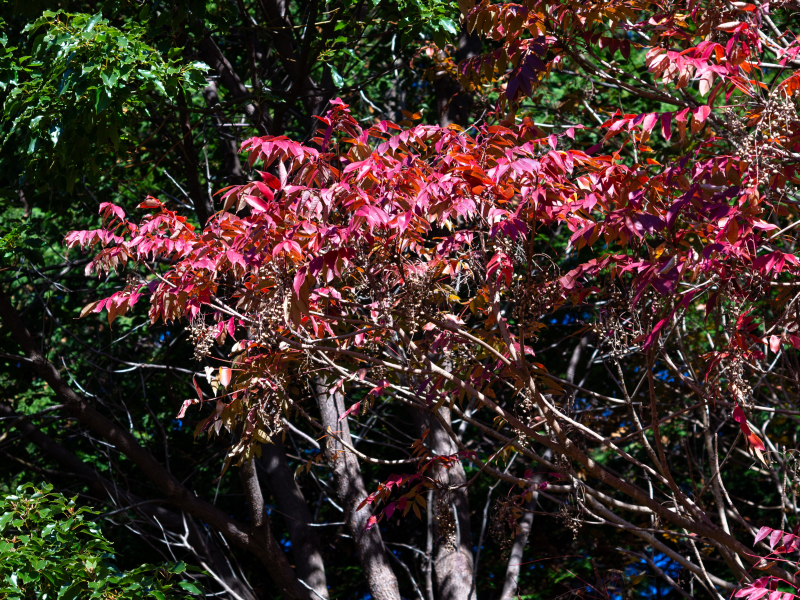
2024.12.03
カラスザンショウ
カラスザンショウが果実をつけています。ミカン科の落葉高木で、伐採跡地などにいち早く侵入する先駆樹種です。植え込みなどに幼木が生えていることもよくあります。葉を揉むと柑橘系の香りがします。和名は、本種がサンショウの仲間で、カラスが実を食べることに由来するという説があります。
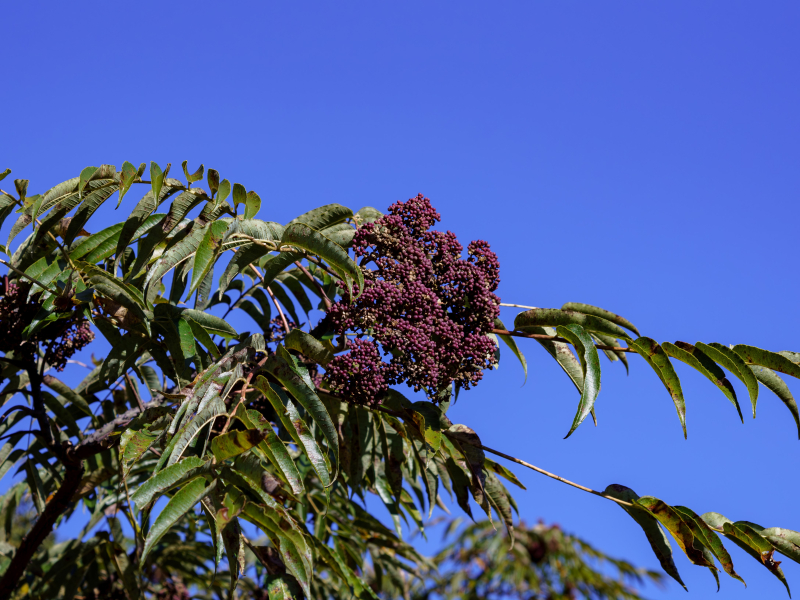
2024.11.29
イソギク
イソギクが咲いています。本来は海岸の崖などに生えるキク科の多年草です。古くから栽培されており、キャンパス内でも花壇に植えられています。和名は磯菊で本来の自生地に由来します。
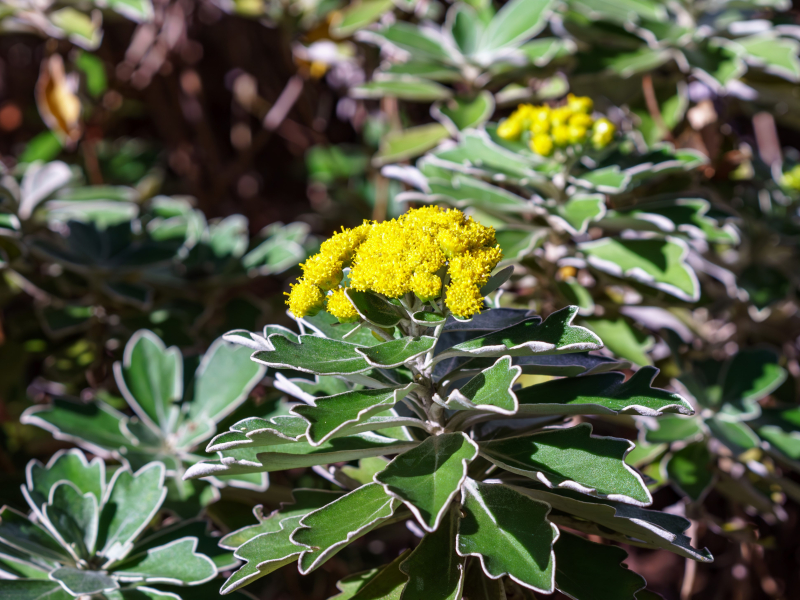
2024.11.26
ヤマノイモ
ヤマノイモがむかごをつけています。むかごは養分が蓄えられて肥大化した芽で、地面に落ちると新たな植物体となります。ヤマノイモの地下の芋(根)は自然薯と呼ばれ食用とされますが、このむかごも食用となります。
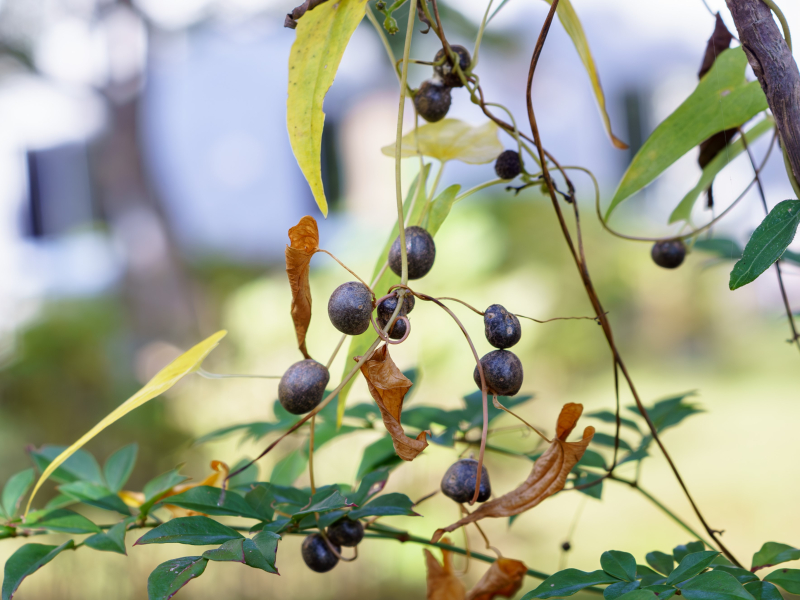
2024.11.22
アオオニタビラコ
アオオニタビラコが咲いています。道端などいろいろなところで見られるキク科の多年草です。かつてはオニタビラコと呼ばれていたものが、近年はアオオニタビラコとアカオニタビラコの2亜種に分けられています。晩秋まで見られるものはアオオニタビラコのようです。
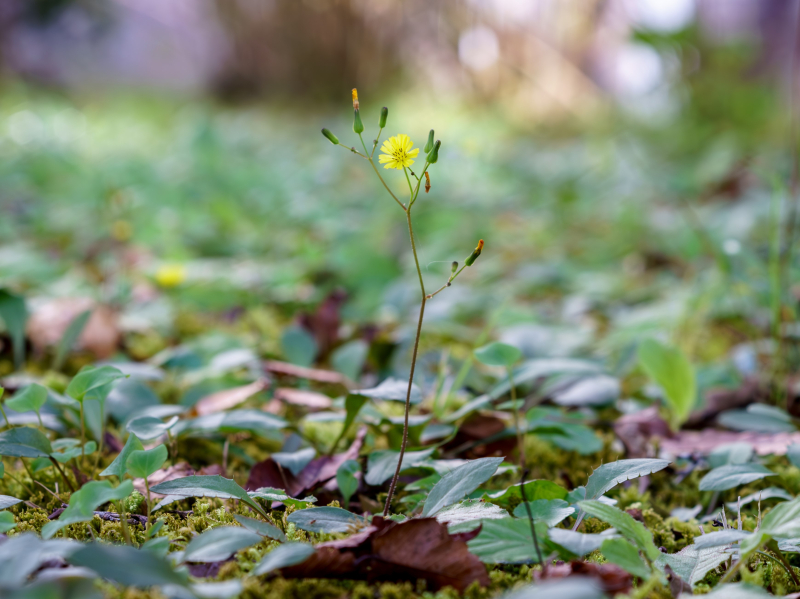
"Ao-Onitabirako (アオオニタビラコ)" plants are in bloom. They are the perennial plants of the Asteraceae that grow everywhere like on roadsides. They were called "Onitabirako (オニタビラコ)" in the past, but these days they are divided into the two subspecies "Ao-Onitabirako (アオオニタビラコ)" and "Aka-Onitabirako (アカオニタビラコ)." The ones seen until late autumn are "Ao-Onitabirako".
2024.11.19
ムラサキシキブ
ムラサキシキブが果実をつけています。林や林縁でよく見られるシソ科の落葉低木です。秋に美しい紫色の実をつけます。17世紀後半までミムラサキ(実紫)と呼ばれていましたが、その後、『源氏物語』の作者 紫式部の名をかりてムラサキシキブと呼ばれるようになったようです。
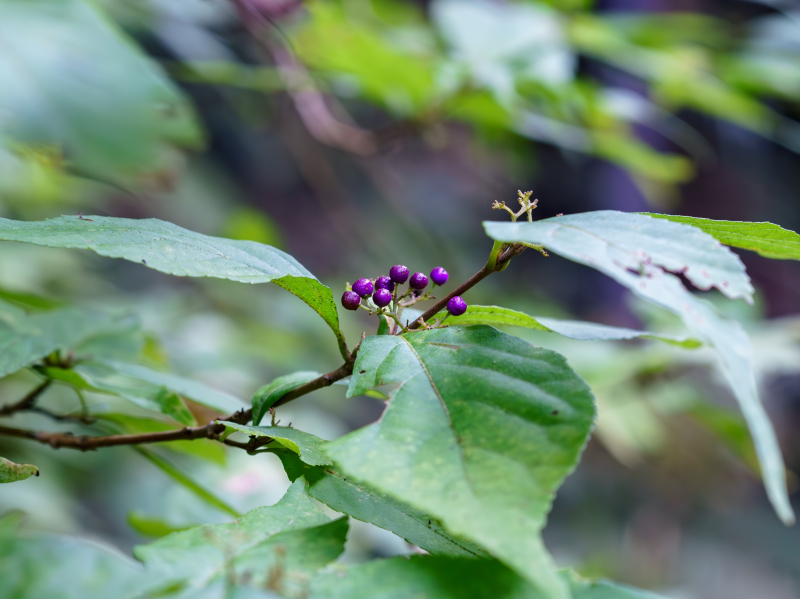
2024.11.15
ガマズミ
ガマズミが果実をつけています。丘陵から山地によく見られるガマズミ科の落葉低木です。赤い果実は食用にすることができます。
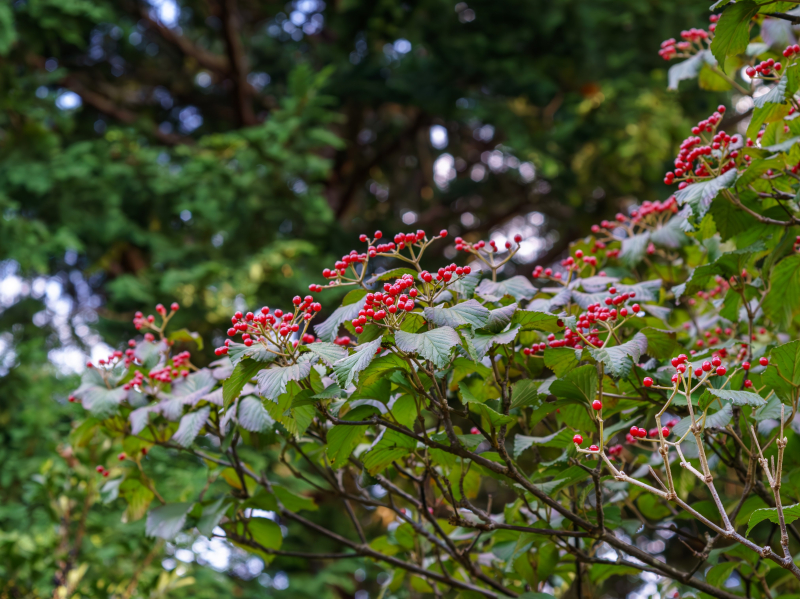
"Gamazumi (ガマズミ)" plants are bearing their fruits. They are the deciduous low trees of the Viburnaceae family that grow on hills to mountains. Their red fruits are edible.
2024.11.12
ハダカホオズキ
ハダカホオズキが果実をつけています。林縁などに生えるナス科の多年草です。光沢のある赤い実が特徴です。和名は、同じナス科のホオズキの実ががくに包まれているのに対して、本種は包まれていないことに由来します。
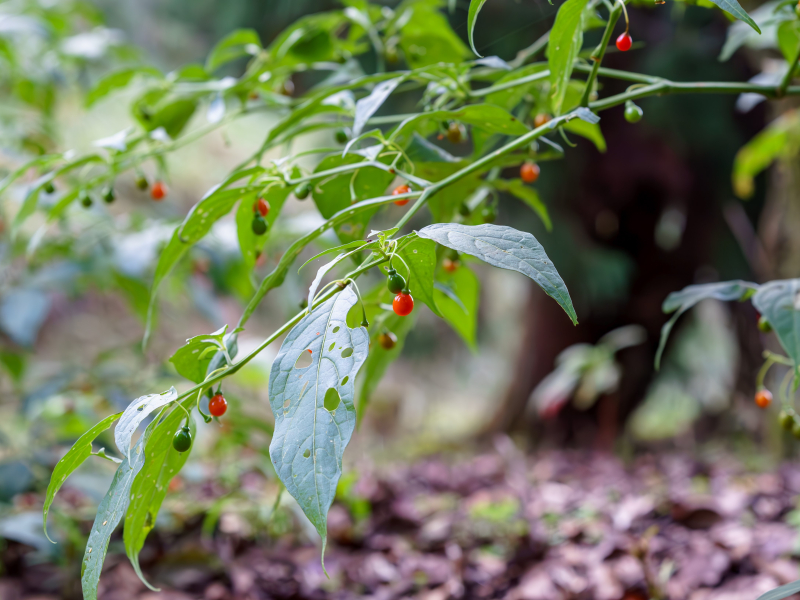
2024.11.08
ノコンギク
ノコンギクが咲いています。明るい林縁などに生える代表的な野菊です。和名は野に咲く紺色の菊という意味ですが、白色のものもあります。

"Nokongiku (ノコンギク)" plants are in bloom. They are a typical wild aster growing on the sunny edges of forests. The name means that they are wild purple asters, but some of them bloom white flowers.
2024.11.05
イシミカワ
イシミカワが果実をつけています。タデ科の一年草で草地などによく見られます。花は緑色であまり目立ちませんが、花の後にがくが発達し、きれいな瑠璃色になります。
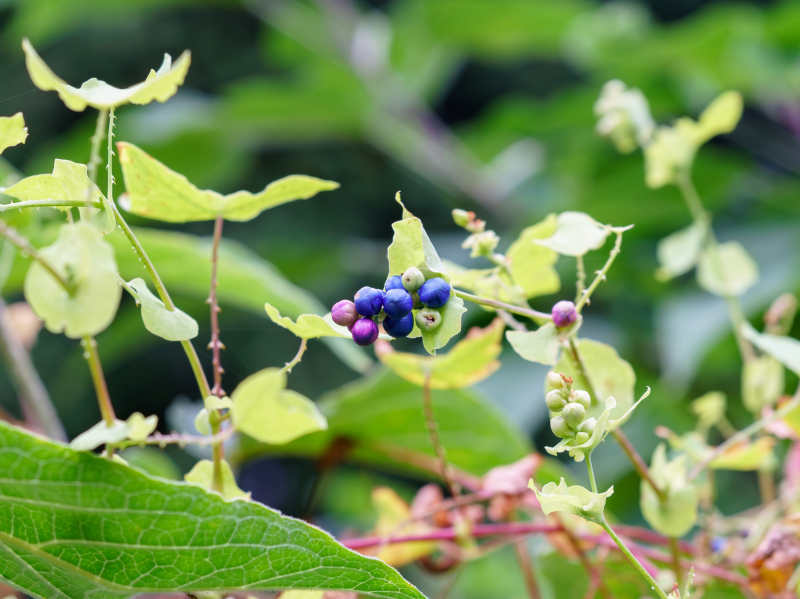
2024.11.01
シロバナキツネノマゴ
シロバナキツネノマゴが咲いています。日当たりのよい道端などに生えるキツネノゴ科の一年草です。キツネノマゴの花はふつう薄紅紫色ですが、その白花品をシロバナキツネノマゴと呼びます。
"Shirobana-Kitsunenomago (シロバナキツネノマゴ)" plants are in bloom. They are an annual plant of the Acanthaceae family that grow on sunny road sides. The flowers of Kitsunenomago are normally light red purple, but some of them bloom white flowers and they are called Shirobana-Kitsunenomago.
2024.10.29
ヤブタバコ
ヤブタバコが咲いています。キク科の一年草~越年草で、やや暗い場所でよく見られます。枝はある高さから水平に広がり、枝の下に頭花を並べてつけます。和名は、しわの多い葉が、タバコの葉に似ることに由来します。
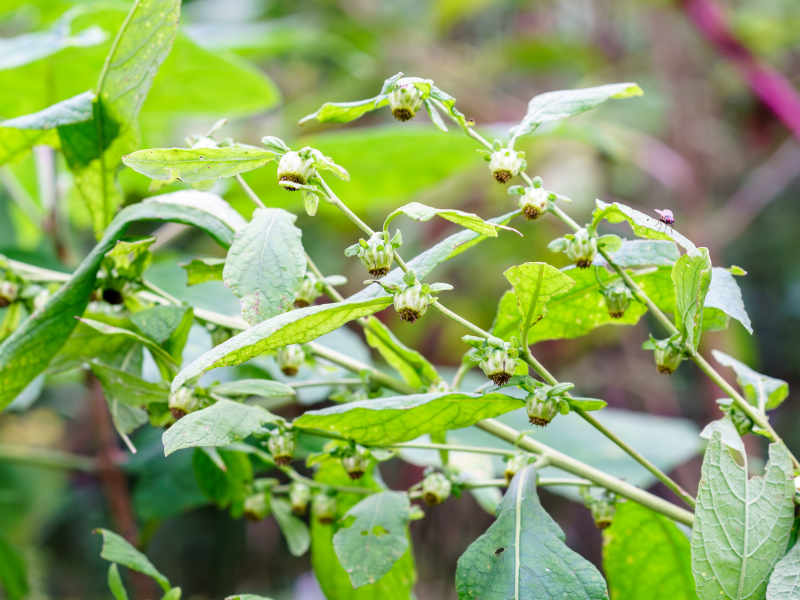
"Yabu-Tabako (ヤブタバコ)" plants are in bloom. They are the annual or biennial plants of the Asteraceae family that grow in a little dark places. The branches horizontally spread from a certain height and they bear head flowers below the branches. The name comes from the fact that their wrinkled leaves look like the ones of "Tabako (タバコ)" plants.
2024.10.22
アオミズ
アオミズが咲いています。湿ったところに生えるイラクサ科の一年草です。ミズの仲間は全体的にみずみずしく、やわらかいという特徴があります。
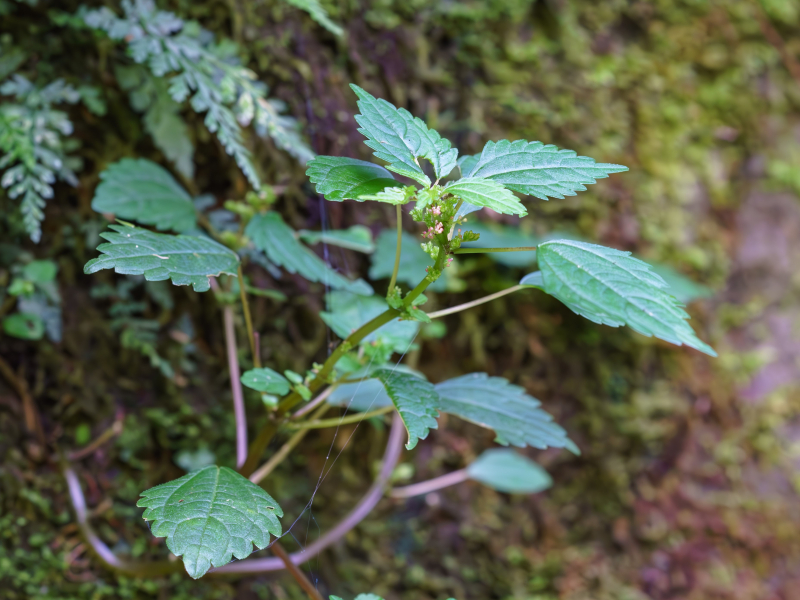
2024.10.18
マツカゼソウ
マツカゼソウが咲いています。林内に見られるミカン科の多年草です。ミカン科の中では珍しく木本ではなく草本ですが、葉には油点があり独特の匂いがあります。和名は、草姿が風に揺れる松の木に見えることに由来します。
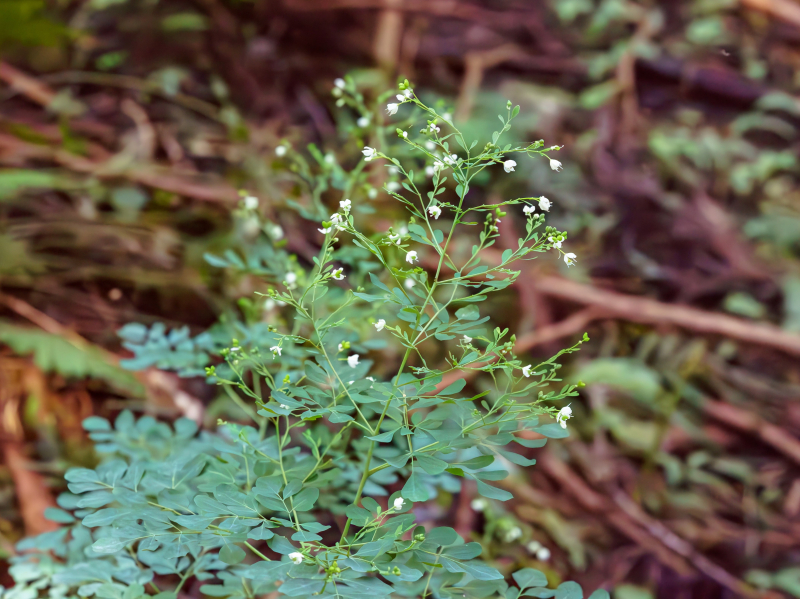
2024.10.15
ノササゲ
ノササゲが咲いています。明るい林縁などに生えるマメ科の多年草です。丘陵地から山地まで広く分布していますが、市街地ではあまり見られないようです。
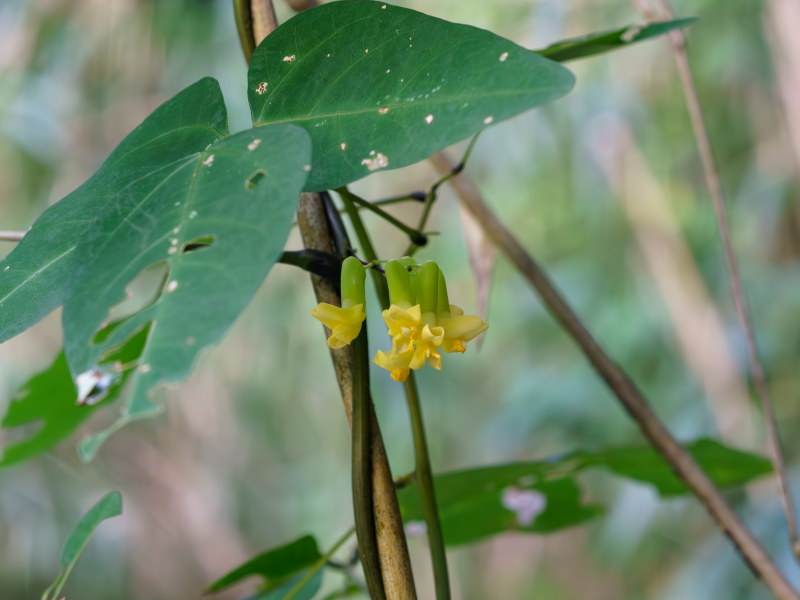
2024.10.11
オカダイコン
オカダイコンが咲いています。湿った林縁などに生えるキク科の多年草です。近年まで、近縁のヌマダイコンと同種とされていましたが、現在では別種として扱われています。名前にダイコンとつきますが、ダイコンはアブラナ科で、全く別の仲間です。
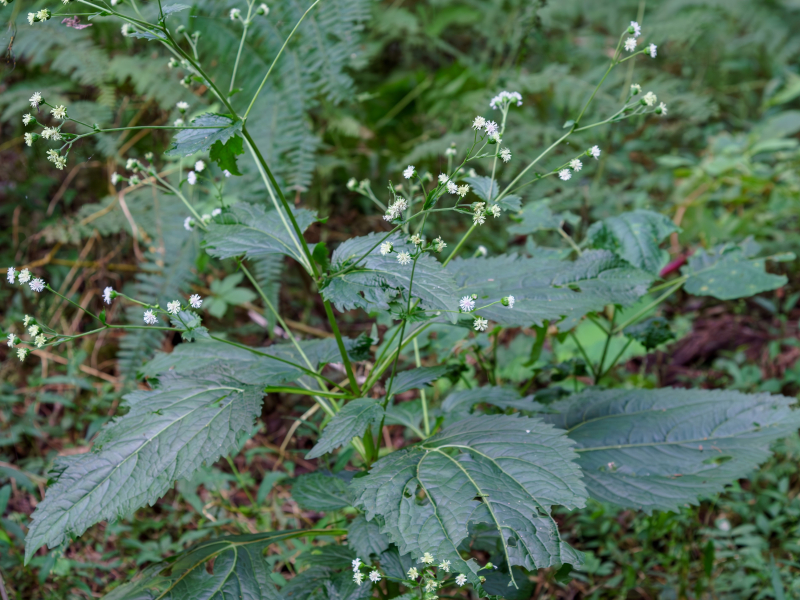
"Oka-Daikon (オカダイコン)" plants are in bloom. They are the perennial plants of the Asteraceae family that grow on the wet edges of forests. They were considered the same species as "Numa-Daikon (ヌマダイコン)" plants until recent years but they are categorized to be different species now. The name includes "Daikon (ダイコン)", which is root crops, but Daikon plants belong to the mustard family so they are far different.
2024.10.08
ワレモコウ
ワレモコウが咲いています。明るい草原などに生えるバラ科の多年草です。小さい花が多数集まって1~2cmの楕円形の花穂をつくります。草刈りなどが行われ、人為的に維持されている草地に見られることが多く、不二聖心でも定期的に草刈りが行われる茶草場で見られます。
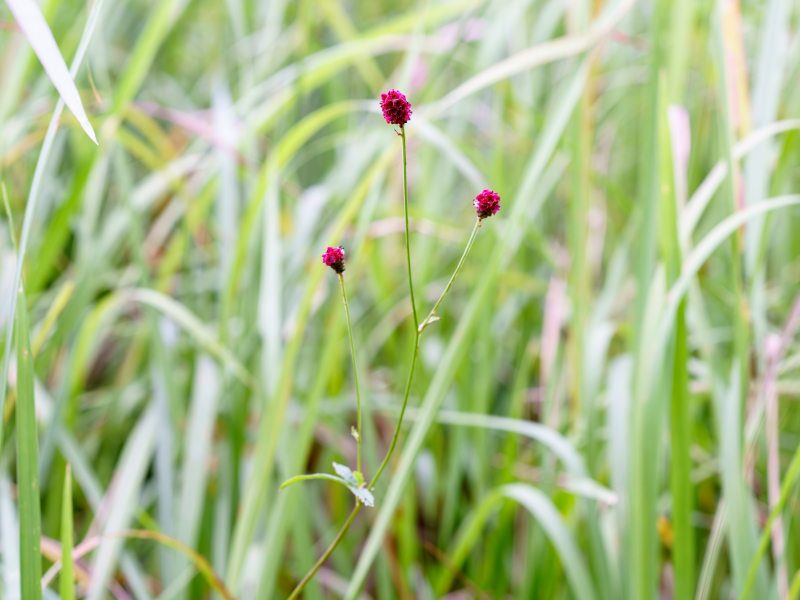
2024.10.04
チカラシバ
チカラシバが咲いています。道端によく見られるイネ科の多年草です。試験管を洗うブラシのような穂が特徴です。和名は、根がしっかり張っていて、引き抜くのに力がいることに由来します。
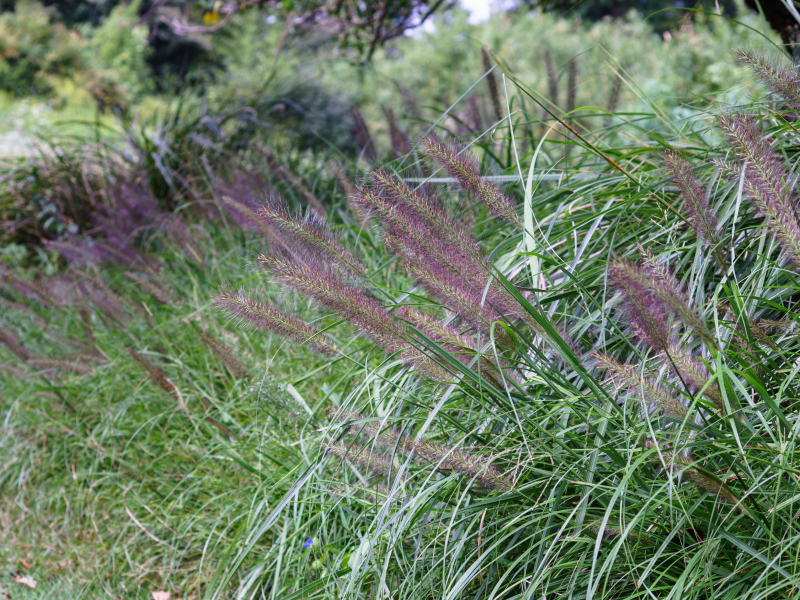
2024.10.01
メドハギ
メドハギが咲いています。草地などに生えるマメ科の多年草です。蝶形花とともに、花が開かずにつぼみのまま結実する閉鎖花をつけることが知られています。和名は、筮(めどぎ)とよばれる占いに用いる細い棒の材料として使われたことに由来します。
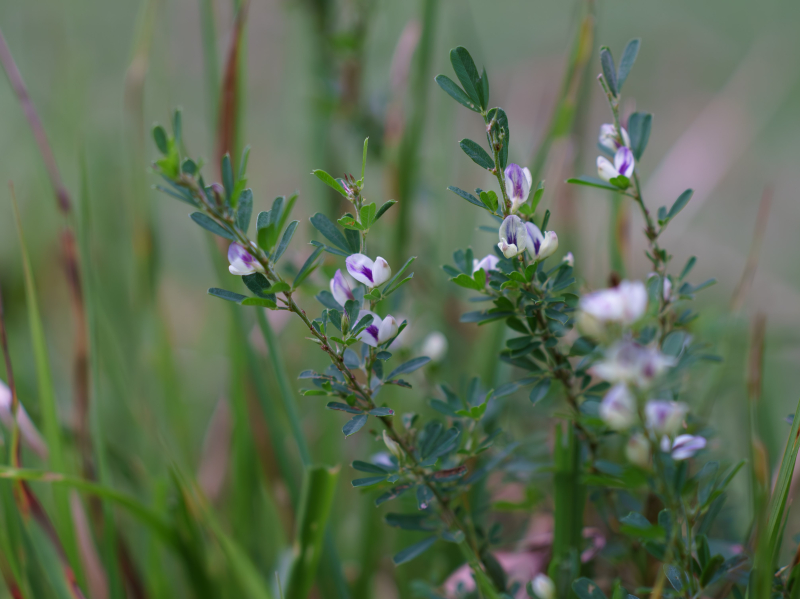
2024.09.27
ヒメキンミズヒキ
ヒメキンミズヒキが咲いています。バラ科の多年草で、林縁や道端などに生えています。キンミズヒキの仲間は互いによく似ているので、見分けがつきにくいものもあります。ヒメキンミズヒキは近縁のキンミズヒキに比べて小型で、雄しべが少ないことが特徴です。

"Hime-Kinmizuhiki (ヒメキンミズヒキ)" plants are in bloom. They are the perennial plants that belong to the rose family and grow on the edge of forests and on roadsides. The species that belong to the Kinmizuhiki group are very similar to each other so it's sometimes difficult to tell one from others. "Hime-Kinmizuhiki" is relatively small and has less stamens.
2024.09.24
シロバナマンジュシャゲ
シロバナマンジュシャゲが咲いています。ヒガンバナの白花品に見えますが、ショウキズイセンとヒガンバナの交雑種とされています。ショウキズイセンが黄色で、ヒガンバナが赤色なので、その交雑種が白色というのは不思議な感じがします。
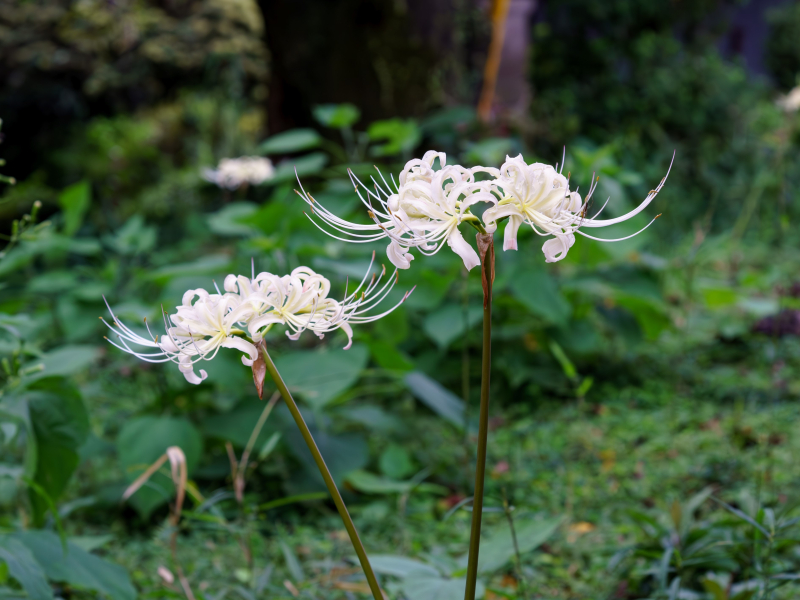
2024.09.20
ヒヨドリバナ
ヒヨドリバナが咲いています。山地の草原などに生えるキク科の多年草です。キャンパス内では9月にススキ野原で群生します。和名はヒヨドリが鳴くころに咲くことに由来するという説と、乾燥した花がらを火おこしに使ったことから火取花(ひとりばな)と呼ばれ、ヒヨドリバナになったという説があります。
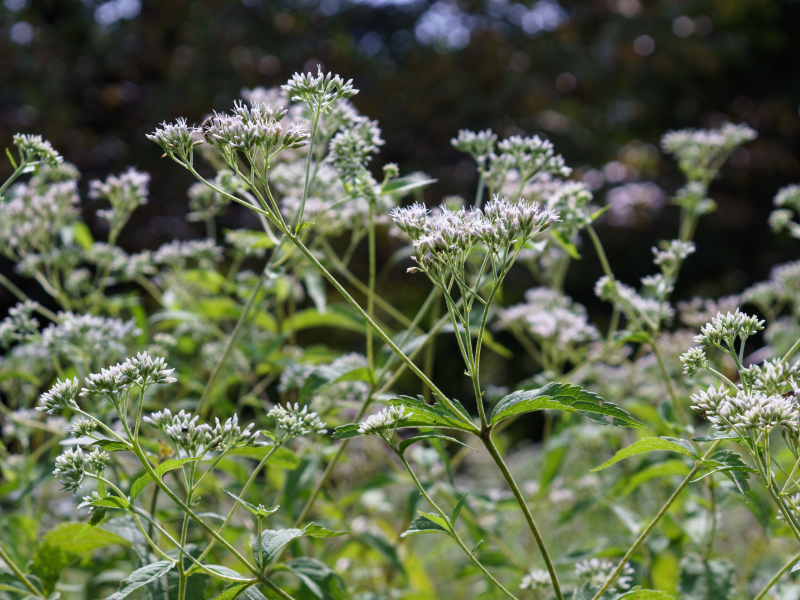
"Hiyodori-Bana (ヒヨドリバナ)" plants are in bloom. They are the perennial plants of the Asteraceae family that grow on the grass fields in mountains. They grow in colonies on the Japanese pampas grass field in September on our campus. There are two possible origins for its name: the one is that they bloom when "Hiyodori (ヒヨドリ)" birds sing and the other is that the dead flowers are used to start a fire.
2024.09.17
ヤブハギ
ヤブハギが咲いています。マメ科の多年草で、和名は藪に生える萩(ハギ)という意味です。近縁種が数種あり、互いによく似ています。本種は葉が茎の一部に集まってつき、葉の裏面に毛が少ないことで見分けることができます。
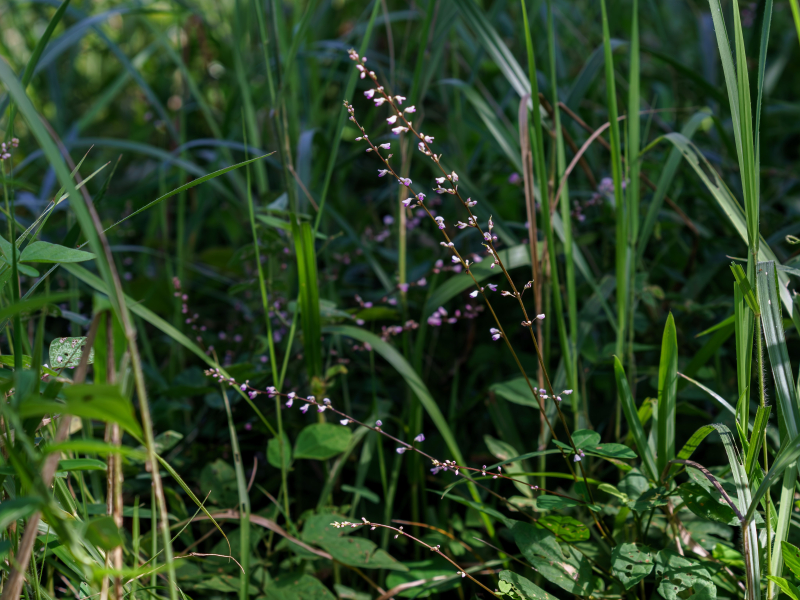
"Yabuhagi (ヤブハギ)" plants are in bloom. They are the perennial plants that belong to the leguminous plants. The name comes from the fact that they look like "Hagi (ハギ)" plants and grow in bushes. There are a few relative species and they are very similar to each other. You can tell Yabuhagi from the others by the fact that they bear their leaves on the same area on the stem and there is less hair on the back of their leaves.
2024.09.13
カナムグラ
カナムグラが咲いています。つる性の多年草で、茎には下向きのトゲがあります。花は風媒花で、あまり目立ちませんが、たくさんの花粉を作ります。秋の花粉症の原因の一つとされる一方で、薬草として利用されている植物でもあります。
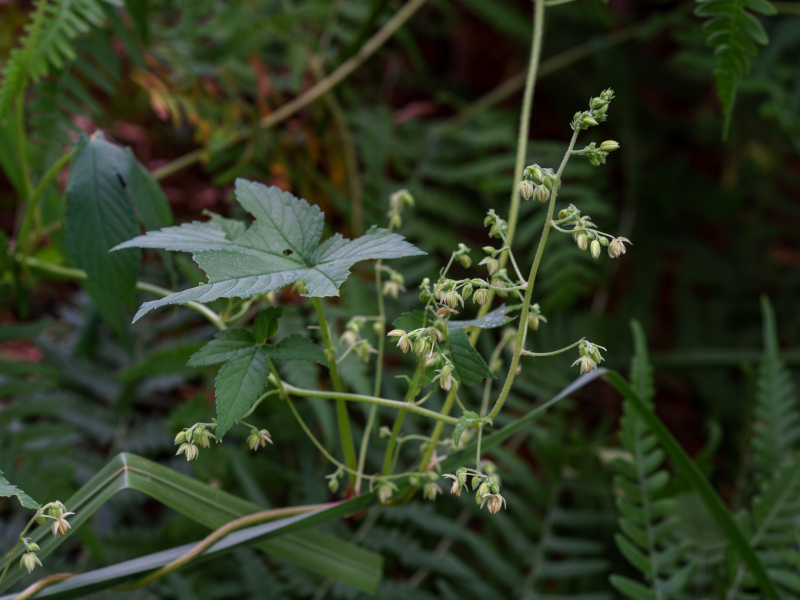
2024.09.10
カワラケツメイ
カワラケツメイが咲いています。明るい草地に生えるマメ科の植物です。花はマメ科によく見られる蝶形花ではなく、5枚の花弁がほぼ同じ大きさ同じ形です。和名は中国から伝わった決明(ケツメイ)という生薬と似た薬効があり、河原に自生することに由来します。
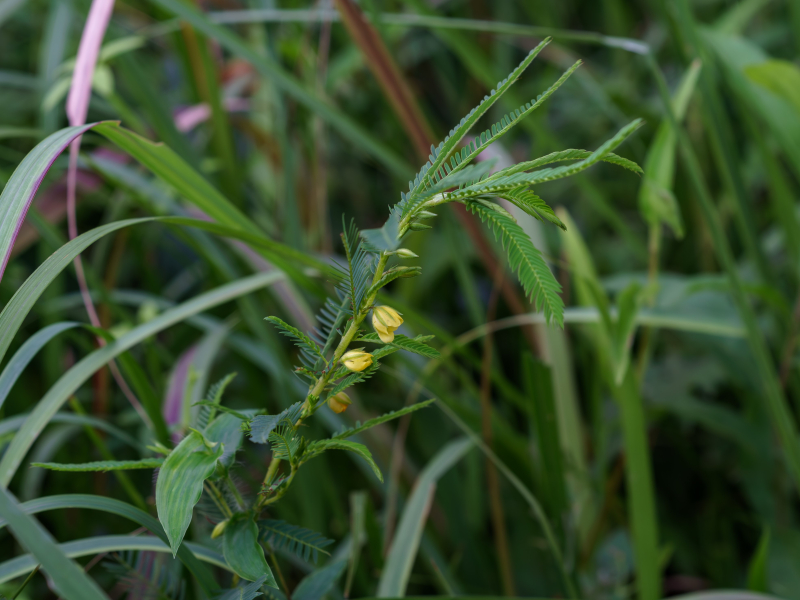
2024.09.06
ツルボ
ツルボが咲いています。地下に球根のある多年草で、葉が春と秋の2回出ることが特徴です。春に出た葉は夏に枯れます。そのため、夏に草刈りが行われるような場所では、他の植物が刈られてしまった後に葉を伸ばし花を咲かせることができるため、ツルボが群生していることがあります。

2024.09.03
オトコエシ
オトコエシが咲いています。草地など明るいところに生える多年草です。同じ属で秋の七草のひとつオミナエシ(女郎花)と比べて、茎や葉が大きく、全体に毛が多いなどの特徴からオトコエシ(男郎花)と呼ばれています。
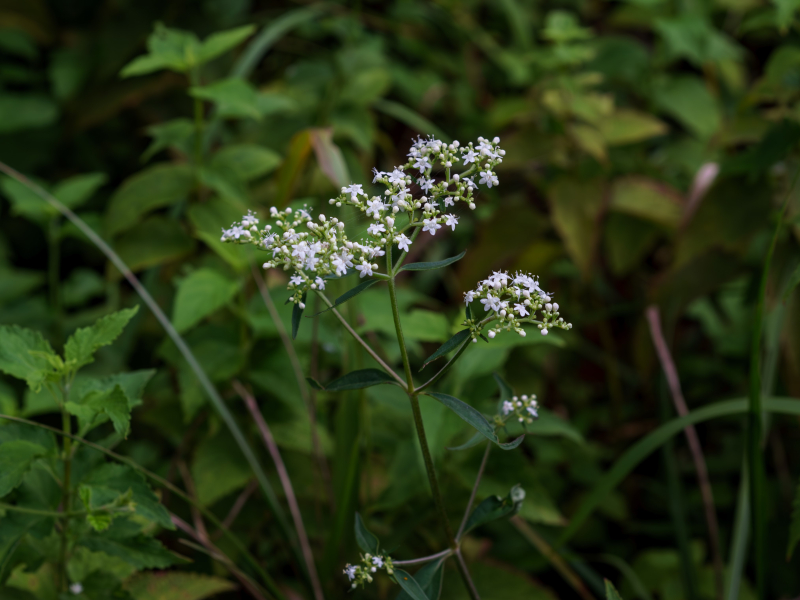
"Otokoeshi (オトコエシ)" plants are in bloom. They are the perennial plants that grow in well-lighted places such as grass fields. The name comes from the fact that they have masculine characteristics such as bigger stems and leaves and much hair compared to "Ominaeshi (オミナエシ)", which belongs to the same group and is listed as one of the seven fall harbs "Akino-Nanakusa (秋の七草)".
2024.08.30
ヘクソカズラ
ヘクソカズラが咲いています。和名は葉をもむと嫌な臭いがすることに由来します。別名として花の中心の赤い部分をお灸のあとに見立ててヤイトバナ(灸花)や、花を田植えをする早乙女の帽子に見立ててサオトメバナ(早乙女花)とも呼ばれます。
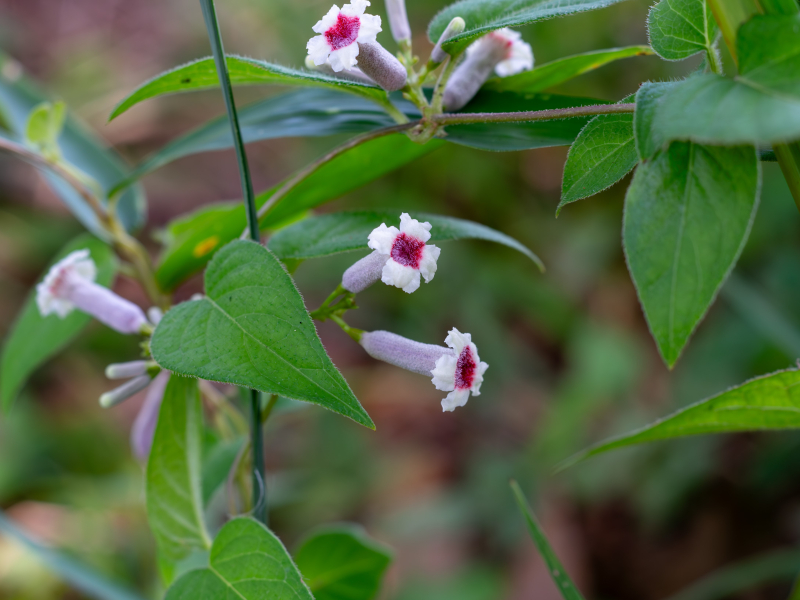
2024.08.27
ツユクサ
ツユクサが咲いています。理科の教材としてもなじみ深い植物です。
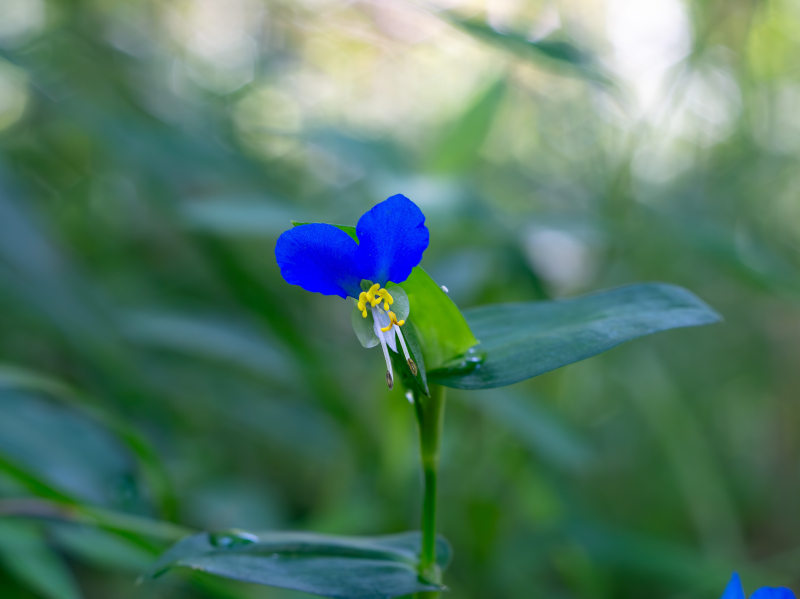 ]
]
雄しべは短いもの3本、長いもの2本、中間のもの1本の6本からなりますが、そのうち2本のみ花粉をつけます。
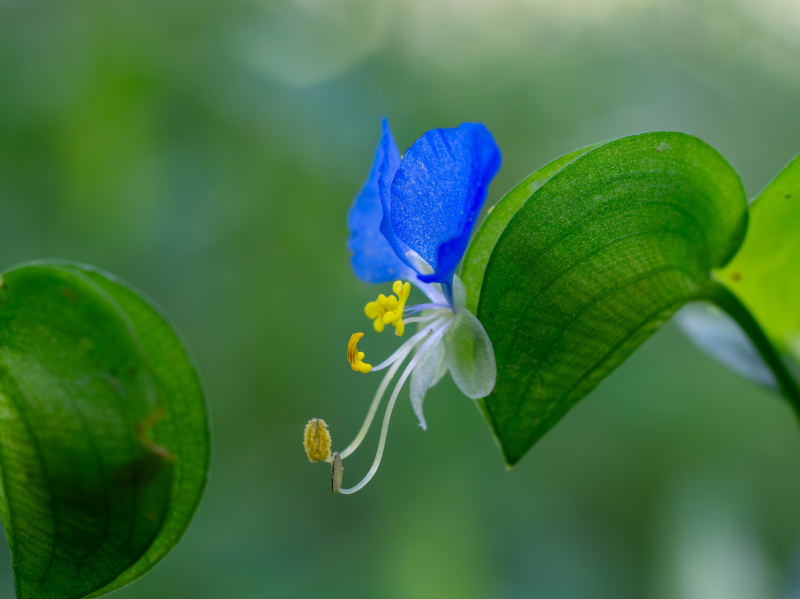
2024.08.23
オトギリソウ
オトギリソウが咲いています。草原に生える多年草で、古くから薬草として知られていたようです。和名は弟切草の意味で、本種を鷹の秘密の傷薬として使っていたある鷹匠が、この秘密を他人に漏らしてしまった弟に激怒して切り殺してしまったというちょっと恐ろしい伝説に由来します。
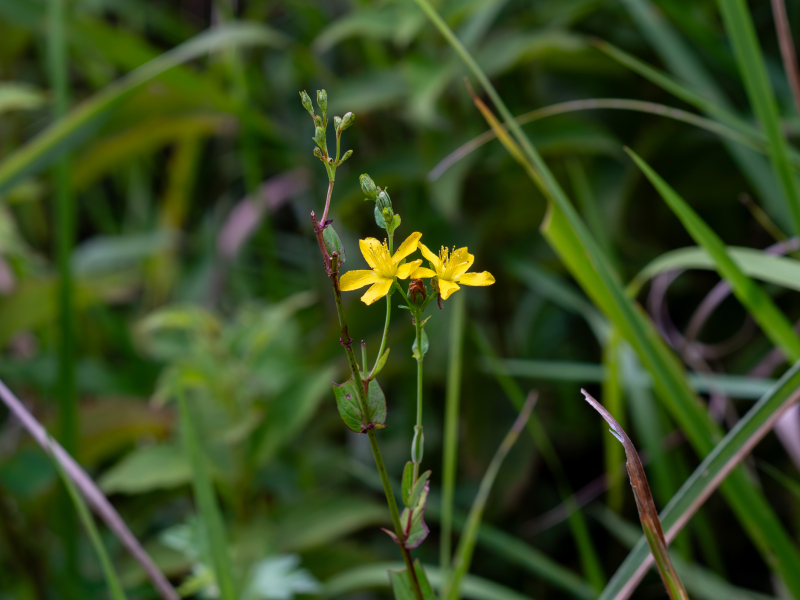
2024.08.20
アイナエ
アイナエが咲いています。芝地などに生える一年草です。葉は地面から数センチまでのところにまとまってついています。生育地の減少などが原因で多くの地域で数を減らしていますが、定期的に芝刈りが行われているオークヒルは生育に適した環境のようです。
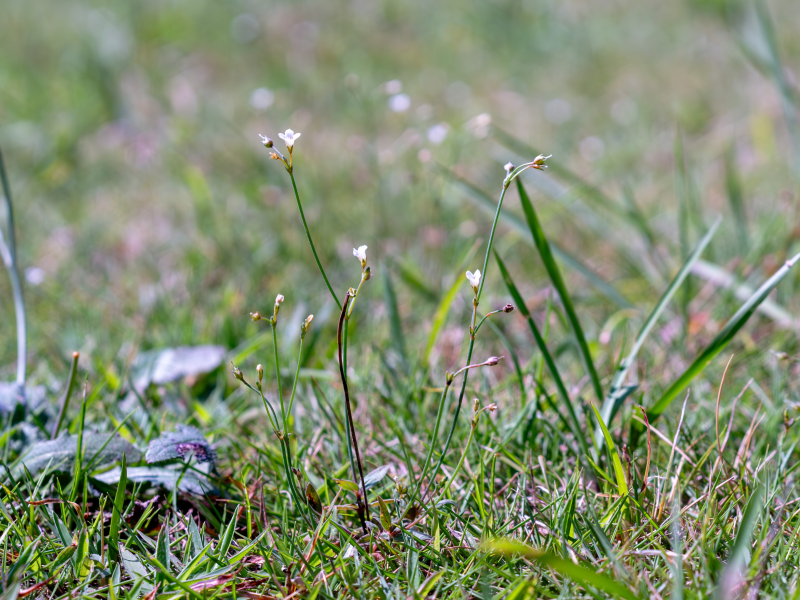
2024.08.16
ツチアケビ
ツチアケビの果実が赤く色づいていました。和名はこの果実をアケビに見立てたものです。果実の中には、ランの仲間にしては比較的大きい種子がたくさん入っています。ツチアケビの果実は古くから薬用とされていたようです。
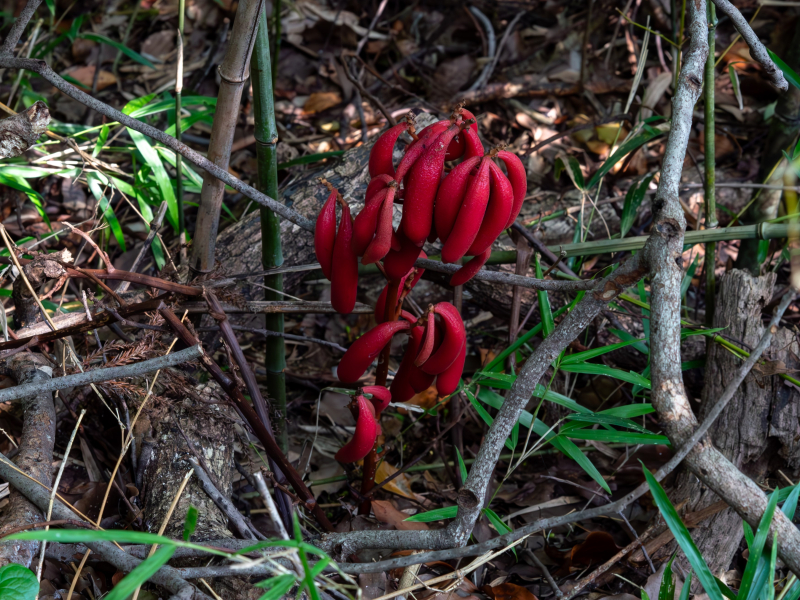
2024.08.13
イヌザンショウ
イヌザンショウが咲いています。サンショウにとても似ていますが、サンショウに比べて香りが良くないため、食用には利用されません。サンショウは春に咲くのに対し、イヌザンショウは夏に咲きます。
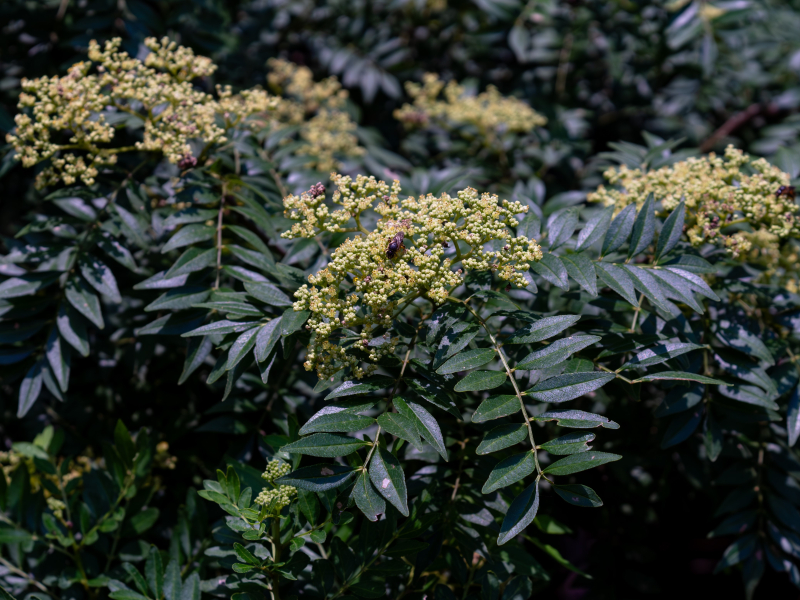
2024.08.09
ムラサキニガナ
ムラサキニガナが咲いています。丘陵地から山地の林内や林縁に生えるキク科の多年草です。名前の通り、1cmほどの紫色の花を下向きにつけます。
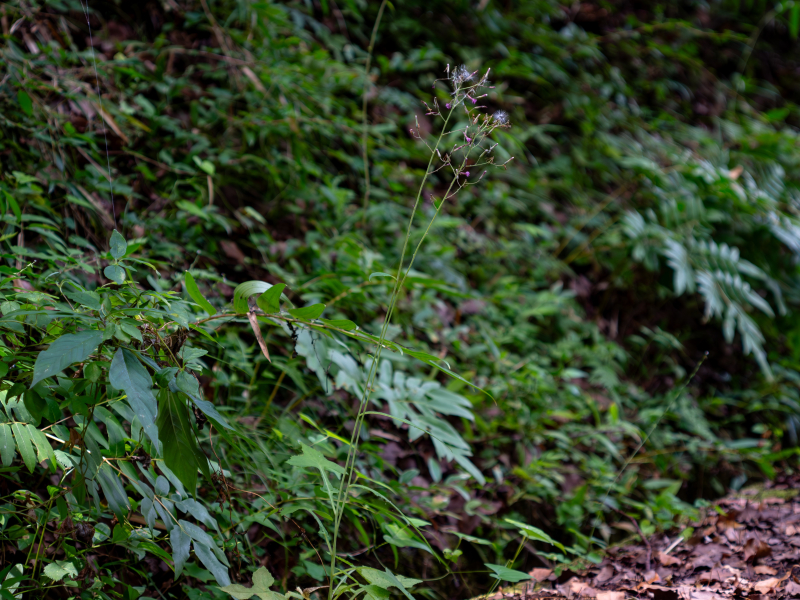
2024.08.06
コオニユリ
コオニユリが咲いています。草原に生える野生のユリです。地下の球根はゆり根として食用になります。食用になるユリは数種類ありますが、スーパーなどで野菜として売られている栽培品のゆり根はほとんどがこのコオニユリを品種改良したものです。
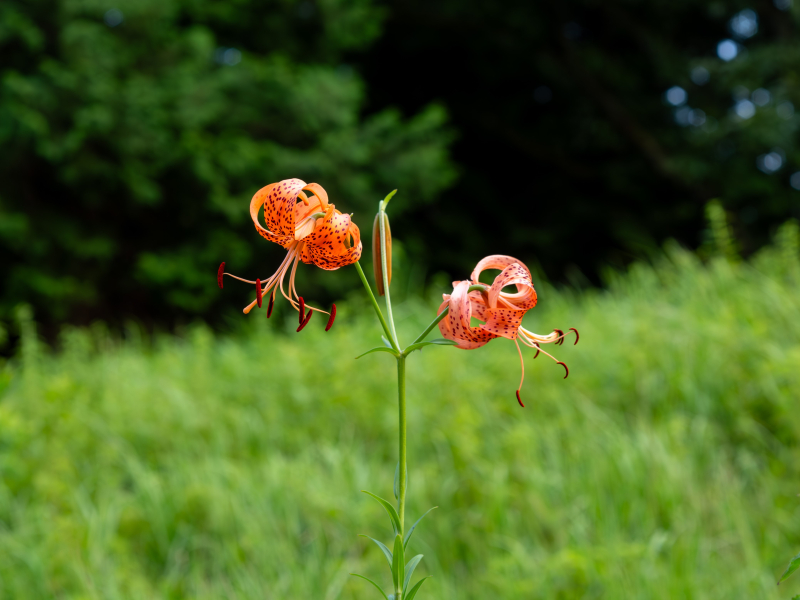
2024.08.02
シオデ
シオデが咲いています。林縁に見られるつる性の草本植物です。花は、緑色で目立ちませんが、花火のような球形になります。若い芽は食用になります。
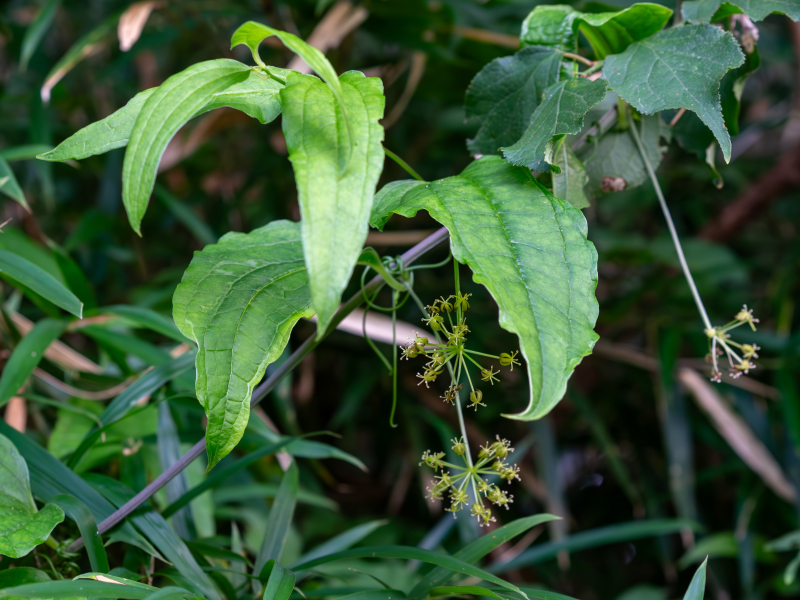
"Shiode (シオデ)" plants are in bloom. They are the herbaceous vines that grow on the edges of forests. Their flowers are green and inconspicuous, but they form a spherical shape that looks like fireworks. Their young sprouts are edible.
2024.07.30
ミズタビラコ
ミズタビラコが咲いています。水辺に生える多年草です。ムラサキ科に属し、近縁のキュウリグサと同様に花びらの根元にはふくらんだ部分があります。近隣の神奈川県や愛知県では絶滅が危惧されています。

2024.07.26
ミツバ
ミツバが咲いています。葉にさわやかな香りがあり、栽培されたものが野菜としてスーパーなどで売られています。野生のものは山地の林縁などで普通に見られます。

2024.07.23
タケニグサ
タケニグサが咲いています。2mほどに成長する大型の多年草です。花は花弁がなく、多数の雄しべが目立ちます。和名は茎が中空で竹に似ていることに由来するという説があります。
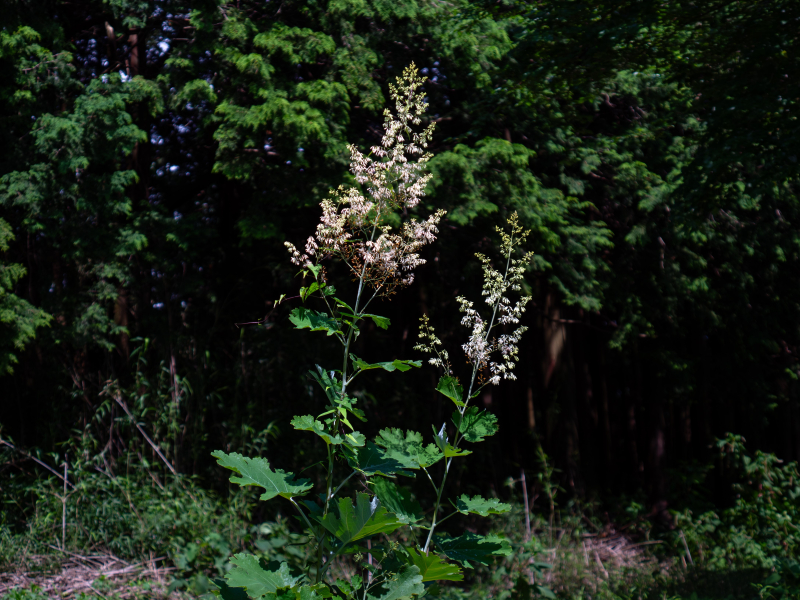
2024.07.19
ショクヨウホオズキ
ショクヨウホオズキが咲いています。北アメリカ原産の帰化植物で、名前の通り、食用になるホオズキです。観賞用のホオズキと同じように、花のあと、がくが肥大し、果実を包みます。栽培されていたものが逃げ出し、野生化しているようです。
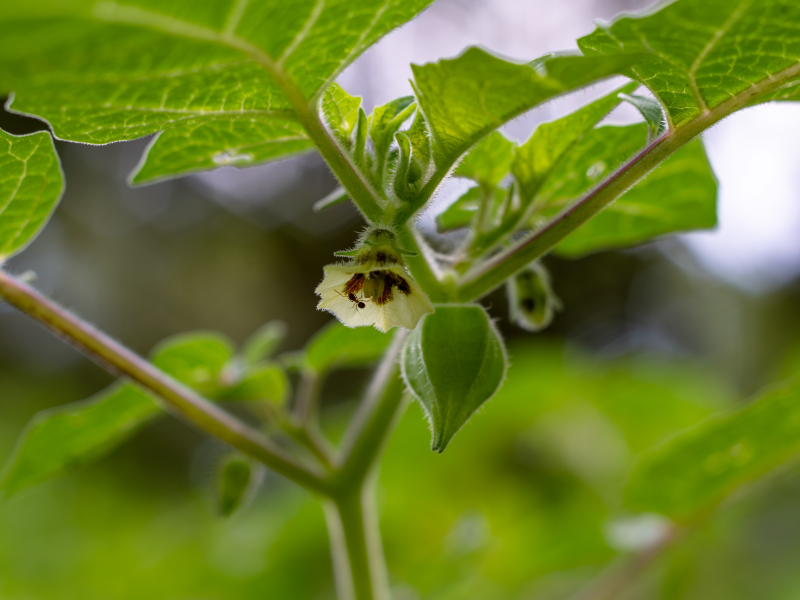
2024.07.16
ネムノキ
ネムノキが咲いています。マメ科の落葉高木で、山地の林縁や土手などでよく見られます。花は多数の赤い長い雄しべがよく目立ちます。和名は眠の木の意味で、夜になると葉が閉じることに由来します。

2024.07.12
オオバノトンボソウ
オオバノトンボソウが咲いています。やや乾燥気味の林床に生えるランの一種です。キャンパス内では林縁で見られます。花は黄緑色で、茎に著しい稜があることが特徴です。

2024.07.09
コクラン
コクランが咲いています。複数の県で絶滅危惧種に指定されているランの一種です。和名は黒っぽい色の花をつけることに由来します。
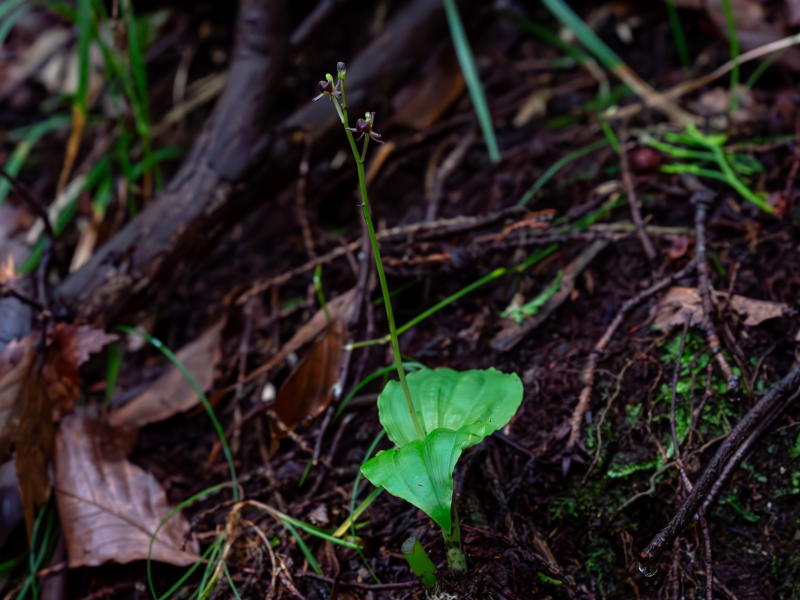
2024.07.05
ツチアケビ
ツチアケビが咲いています。ランの仲間で、光合成をせずに、栄養を完全に菌類に依存しています。和名は、秋に小さいアケビの実のような赤い果実をつけることが由来です。キャンパス内では毎年同じ場所で開花するわけではなく、数年に1度くらいの頻度で見ることができます。
2024.07.02
ヒトツバハギ
ヒトツバハギが咲いています。林縁などに生える落葉低木です。写真は雄株で、葉の付け根に花を多数の雄花をつけています。ハギと名前がついていますが、マメ科のハギ(萩)の仲間ではなく、コミカンソウ科に属する別の仲間です。静岡県のレッドリストでは絶滅危惧ⅠB類に分類されています。

2024.06.28
ヤブジラミ
ヤブジラミが咲いています。セリ科の越年草で、道端や藪でよく見られます。和名は藪に生え、果実に先端がかぎ状に曲がった刺毛が密にあり、動物やヒトの服にくっつくことに由来します。
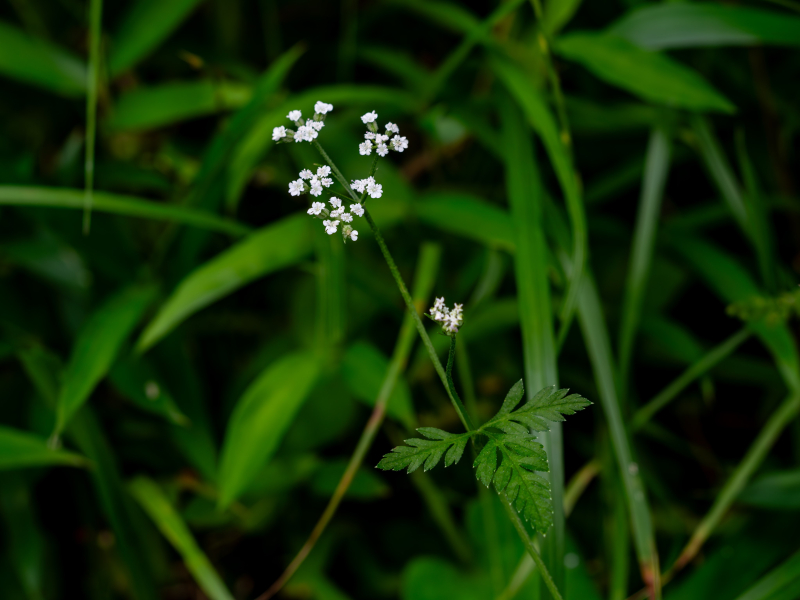
2024.06.25
ホタルブクロ
ホタルブクロが咲いています。キキョウ科の多年草で、釣鐘型の花冠が特徴です。和名は、子どもたちが、ホタルを花冠の中に入れて遊んだことに由来するといわれています。
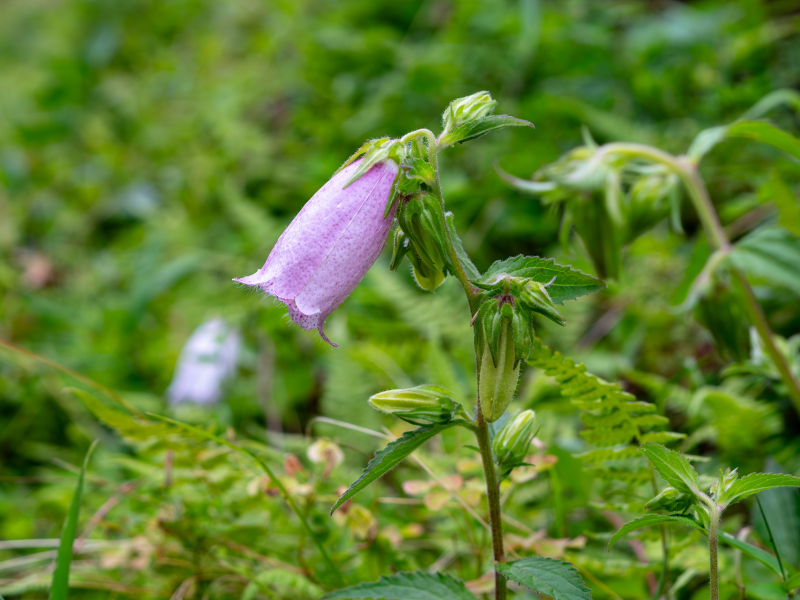
2024.06.21
アカメガシワ
アカメガシワが咲いています。伐採跡地や崩落地などにいち早くみられる落葉高木です。雌雄異株で、写真は雌花です。和名の「アカメ」は、新芽が赤いことに由来します。
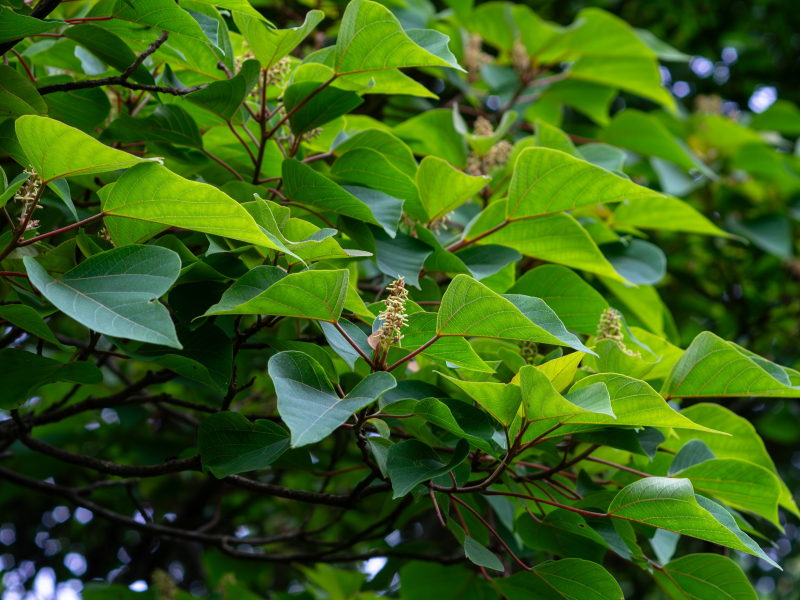
"Akame-Gashiwa (アカメガシワ)" trees are in bloom. They are the tall trees growing in logging sites and landslide areas. They are divided into two groups: the male trees and the female trees. The one in this photo is a female tree. "Akame (アカメ)" in its name indicates that their sprouts are red.
2024.06.18
ヨツバムグラ
ヨツバムグラが咲いています。日当たりの良い草地や明るい林内などに見られる多年草です。花は小さくあまり目立ちませんが、キャンパス内ではさまざまな場所で見ることができます。和名のヨツバは葉が4枚輪生することに由来します。
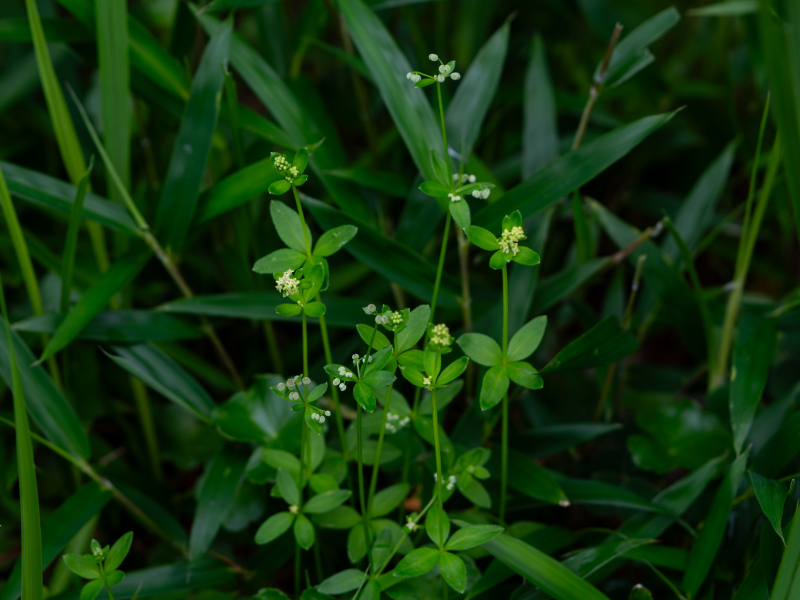
"Yotsuba-Mugura" plants are in bloom. They are perennial plants growing in sunny grass fields and forests. They are not so noticeable because their flowers are small, but they grow in many places on our campus. "Yotsuba" in its name means "four leaves" and it comes from the fact that they have four verticillate leaves.
2024.06.14
ノアザミ
ノアザミが咲いています。草原に生えるアザミの仲間で、春から咲き始めます。白い毛が密に生え、頭花は上向きに咲きます。キャンパス内ではススキ野原でよく見られます。
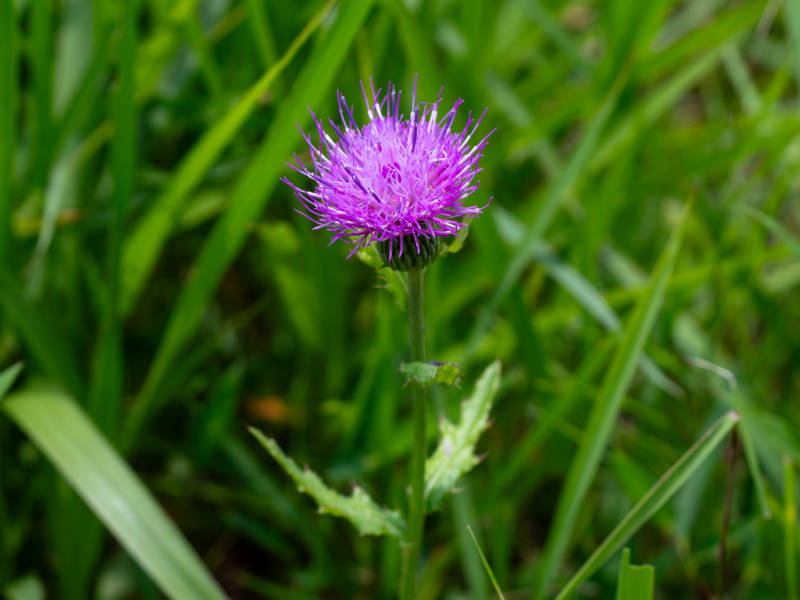
2024.06.11
ヤブムラサキ
ヤブムラサキが咲いています。庭木としてよく植栽されるムラサキシキブのなかまです。全体に星状毛が多いのが特徴です。秋に美しい紫色の果実をつけます。
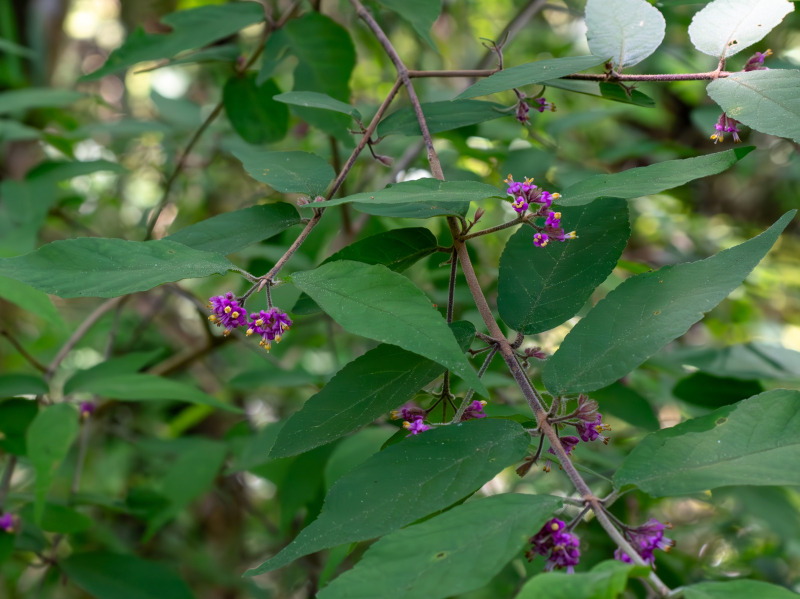
2024.06.07
ヒメシャラ
ヒメシャラが咲いています。山地に見られる落葉高木ですが、なめらかな赤褐色の樹皮も美しく、庭木としてよく植えられています。キャンパス内にも複数のヒメシャラが植栽されていますが、駐車場近くの木が一番大きく、多くの花をつけています。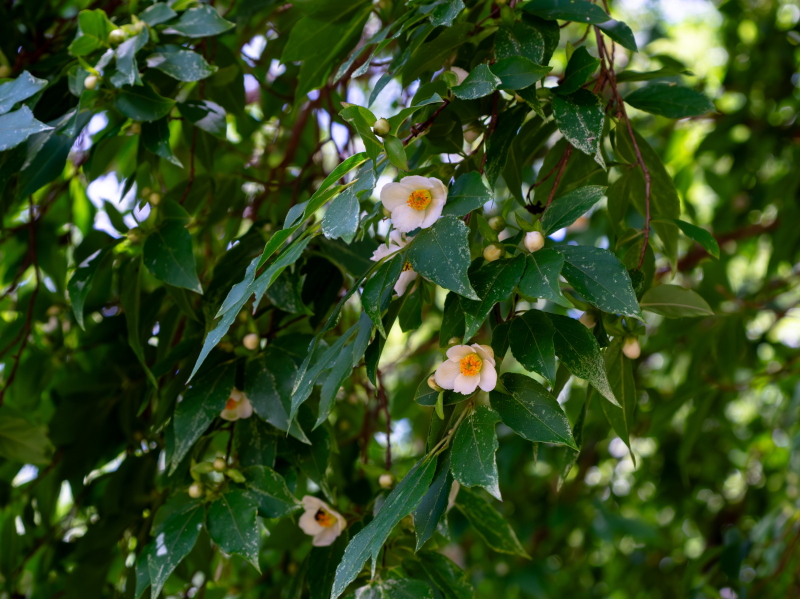
2024.06.04
セッカニワゼキショウ
セッカニワゼキショウが咲いています。ニワゼキショウは北アメリカ原産の帰化植物で、よく芝生の中に混ざって咲いています。写真のように純白色の花を咲かせるものを特にセッカニワゼキショウと呼ぶことがあります。和名のセッカは雪花を意味し、雪の結晶のように見える純白色の花に由来します。
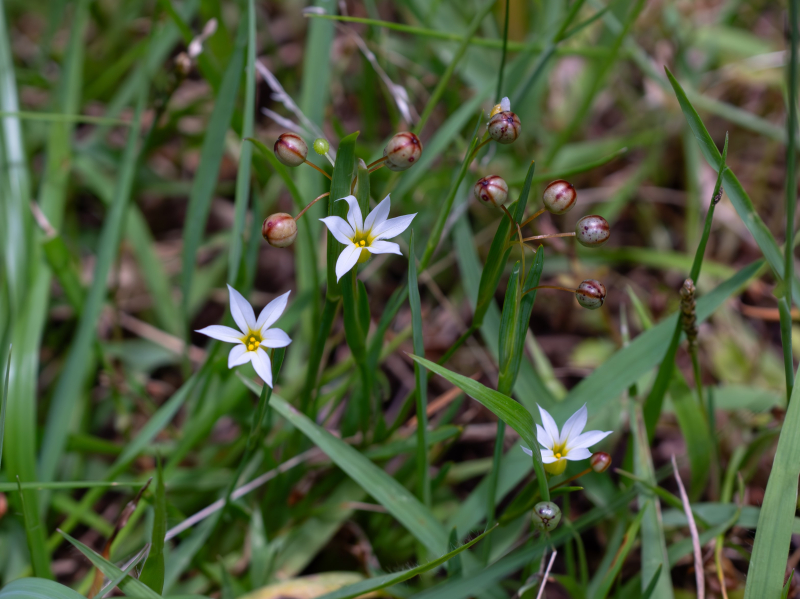
"Sekka-Niwazekishou (セッカニワゼキショウ)" plants are in bloom. "Niwazekishou (ニワゼキショウ)" plants originally came from North America and often grow in lawns. The ones that bloom white flowers seen in the photo are especially called "Sekka-Niwazekishou." "Sekka (セッカ)" means "snow flower" and comes from the fact that the flower looks like a snowflake.
2024.05.31
ムラサキカタバミ
ムラサキカタバミが咲いています。南アメリカ原産の帰化植物で、観賞用に育てられていたものが野生化したと言われています。カタバミの仲間は花がきれいで、育てやすく、属名のオキザリスという名前で様々な品種が園芸店で売られています。しかし、その強い繁殖力のために雑草化しているものもあるようです。

2024.05.28
ガマズミ
ガマズミが咲いています。丘陵から山地によく見られる落葉低木です。白い花を密につけ、多くの昆虫が集まっています。秋に熟す赤い実は食用になります。

"Gamazumi (ガマズミ)" trees are in bloom. They are deciduous low trees that often grow in hills and mountains. They densely bloom many small white flowers and attract many insects. Their red fruits that ripen in fall are edible.
2024.05.24
イボタノキ
イボタノキが咲いています。林縁などに普通に見られる低木です。本種に寄生するイボタロウカイガラムシが分泌するロウが薬用となり、イボ取りなどに使われました。和名は「イボ取りの木」が変化したものと言われています。

2024.05.21
キュウリグサ
キュウリグサが咲いています。道端などによく見られる越年草です。花序の先のほうは巻いており、2mmほどの小さな花を咲かせながら伸びていきます。和名は、植物体をもむとキュウリのにおいがすることに由来します。
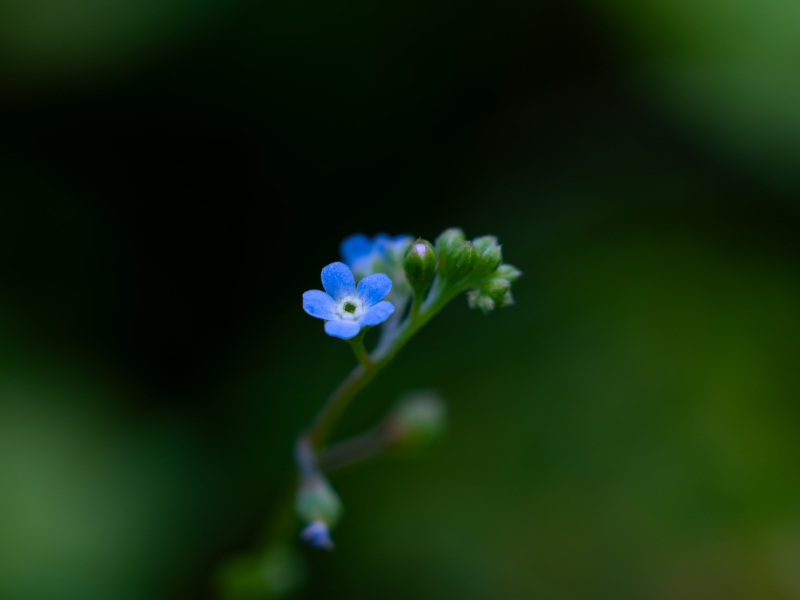
2024.05.17
ムラサキサギゴケ
ムラサキサギゴケが咲いています。水田のあぜ道などによくみられる多年草です。花は近縁種のトキワハゼに似ていますが、本種は長い走出枝をだして広がっていくことで区別することができます。めしべの先端は2つに分かれていますが、花粉がつくなどの刺激を受けると閉じることが知られています。

2024.05.14
ヨウラクラン
ヨウラクランが咲いています。着生ランの一種で、木の幹にくっついて生育しています。木から直接栄養を奪っているわけではなく、生育の場として木の幹を利用しています。花は1~2mmほどで、ラン科の中で世界最小級です。

2024.05.10
コゴメウツギ
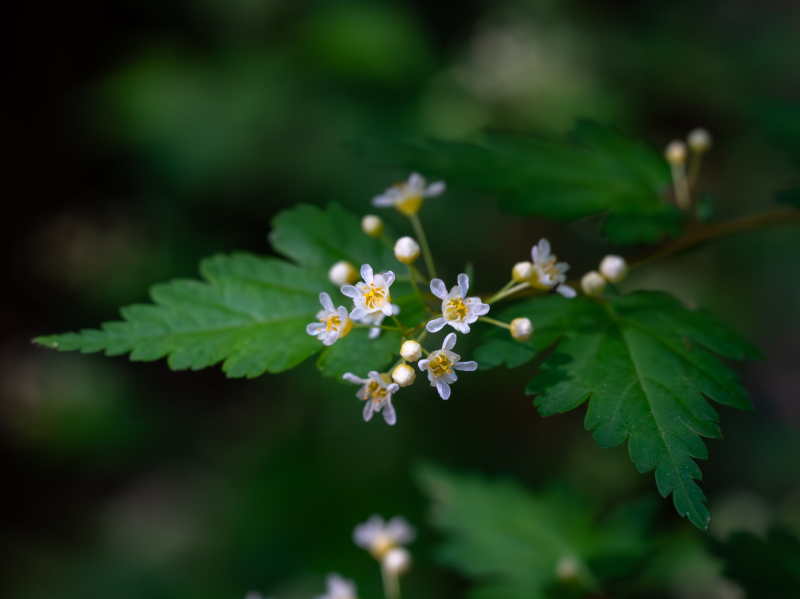
2024.05.07
マツバウンラン
マツバウンランが咲いています。北アメリカ原産の帰化植物で、キャンパス内ではお茶畑の周りにたくさん咲いています。和名は、ウンランという植物に近い仲間で、葉が松の葉のように細いことに由来します。

"Matsuba-Unran (マツバウンラン)" plants are in bloom. They originally come from North America. On our campus, many of them grow around the tea plantation. The name comes from the fact that they are a relative species to the "Unran" plants and their leaves look like those of pine trees.
2024.05.03
ヒメハギ
ヒメハギが咲いています。明るい草地に生える多年草ですが、市街地では減少しています。不二聖心では定期的な草刈りによって草地が維持されている茶草場でよく見ることができます。花の先端に房状の付属体があるのが特徴です。
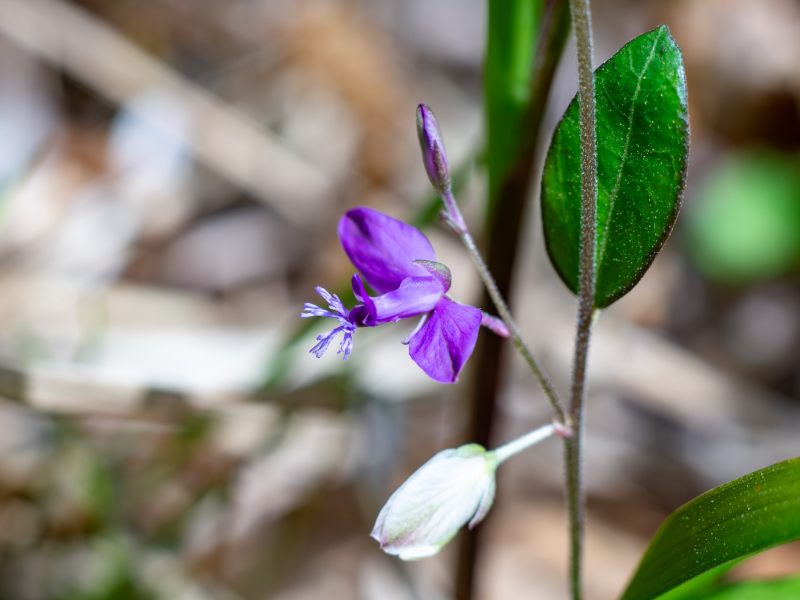
2024.04.30
キンラン
キンランが咲いています。野生ランの一種で、よく手入れのされた雑木林などに生えています。生育場所の減少や園芸目的の採取によって数を減らしており、全国で絶滅危惧種に指定されています。
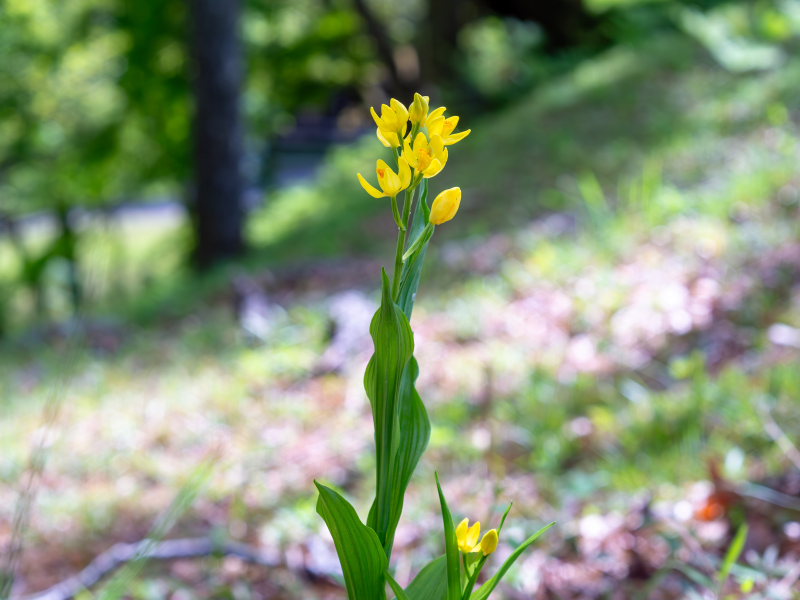
2024.04.26
ウマノアシガタ
ウマノアシガタが咲いています。キンポウゲ科の多年草です。本来は八重咲きのものをキンポウゲと呼んでいましたが、現在では本種の別名をキンポウゲとしているようです。花弁には光沢があり、クヌギ林の木漏れ日でキラキラと光って見えます。
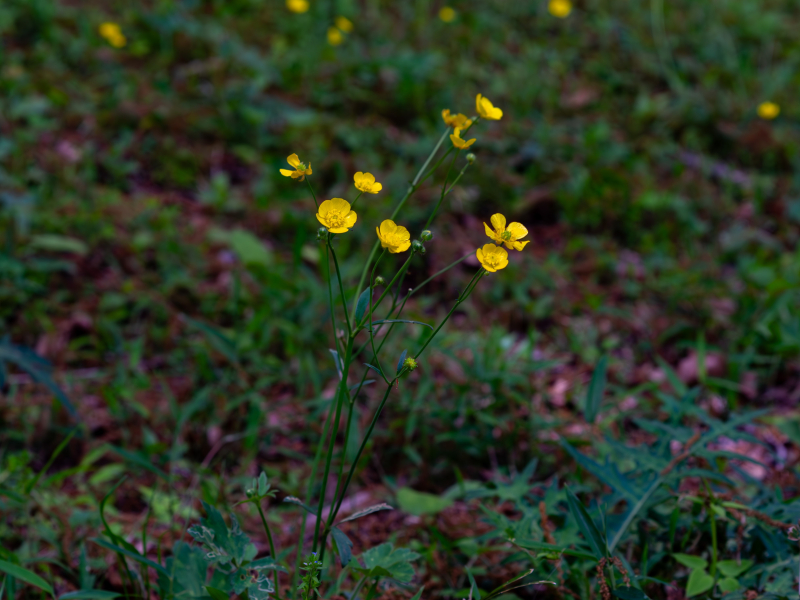
"Umano-Ashigata (ウマノアシガタ)" plants are in bloom. They are perennial plants that belong to the "Kinpouge (キンポウゲ)" family. The double‐flowered ones were originally called "Kinpouge," but now, "Kinpouge" is used as an alias of this species. Their petals are reflective, so they are shiny under the sunlight coming through the leaves in the Japanese chestnut oak woodland.
2024.04.23
ナベワリ
ナベワリが咲いています。樹林内に生える多年草で、不二聖心ではヒノキ林の林床にまれに見られます。有毒植物で、舐めると舌が割れるほどの刺激があり、「舐め割り」がなまってナベワリとなったという説があります。
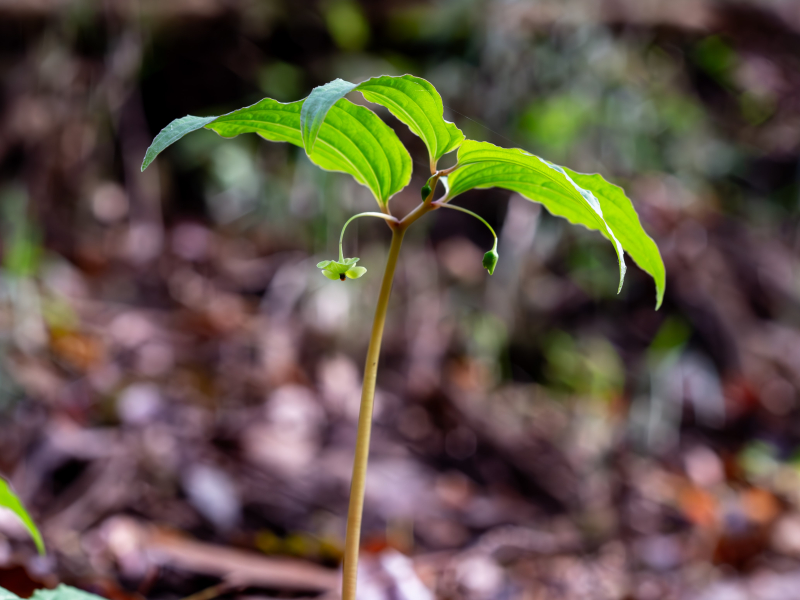
2024.04.19
イロハモミジ
イロハモミジが咲いています。キャンパス内には、不二聖心の前身である温情舎小学校の創立者 岩下清周が京都から取り寄せたと言われるイロハモミジの木がたくさんあり、秋には美しい紅葉を楽しむことができます。春には写真のような暗紅色の小さい花をつけます。
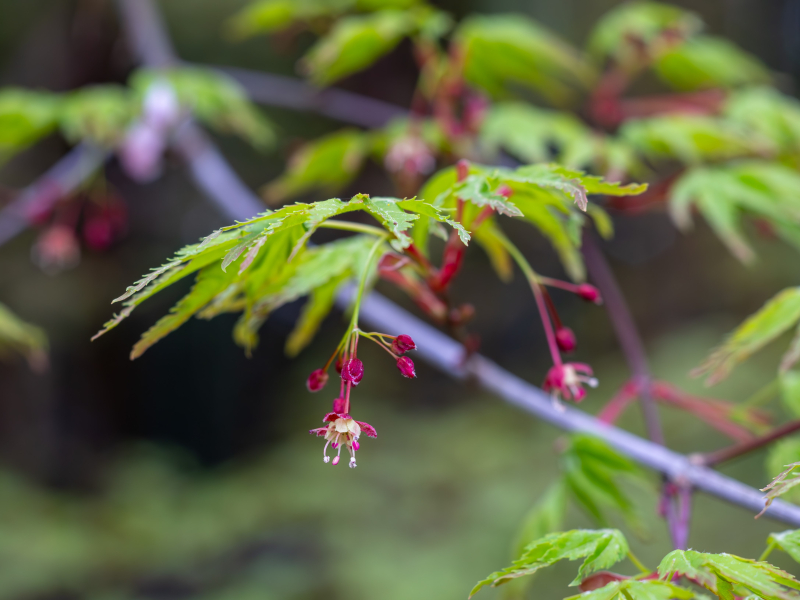
2024.04.16
ウラシマソウ
ウラシマソウが咲いています。花は仏炎苞と呼ばれる苞葉に包まれています。花には付属体と呼ばれるものがあり、その先端は糸状に伸びて地面まで達しています。和名は、この伸びた付属体の先端を浦島太郎の釣り竿に見立てたことによります。
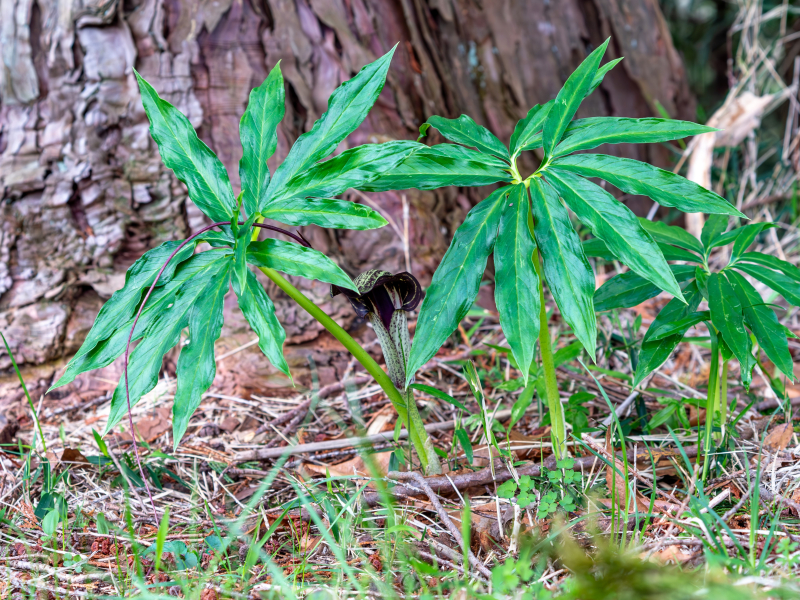
"Urashima-Sou (ウラシマソウ)" plants are in bloom. Flowers are covered with a bract leaf that is called "Butsuen-Hou (仏炎苞)". The flowers have an appendage. The tip of their appendages grow like strings and reach to the ground. The name comes from the fact that the tip of the appendage reminds us of the fishing rod of Urashima Taro, who is the main character of a Japanese folk tale.
2024.04.12
シュンラン
シュンランが咲いています。林床に生える野生のランの一種です。花を食用とするなど身近な蘭ですが、近年は人為的な採集などによって数を減らしています。不二聖心ではシカに食べられているようで、開花している個体は少ないです。
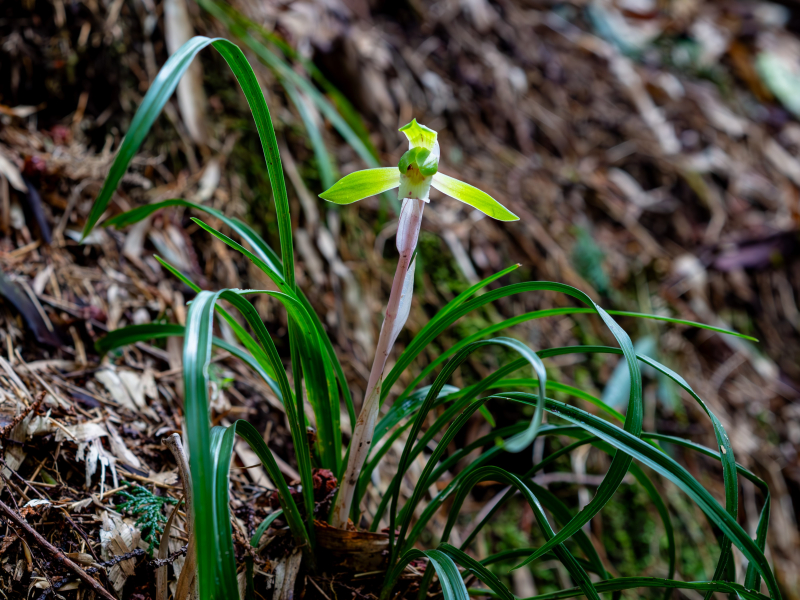
2024.04.09
ミツバアケビ
ミツバアケビが咲いています。和名は、1枚の葉が3個の小葉からなる3出複葉のアケビであることに由来します。果実は秋に熟し、果肉は甘く食用になります。また、地域によっては果実の皮の部分も食用とするようです。
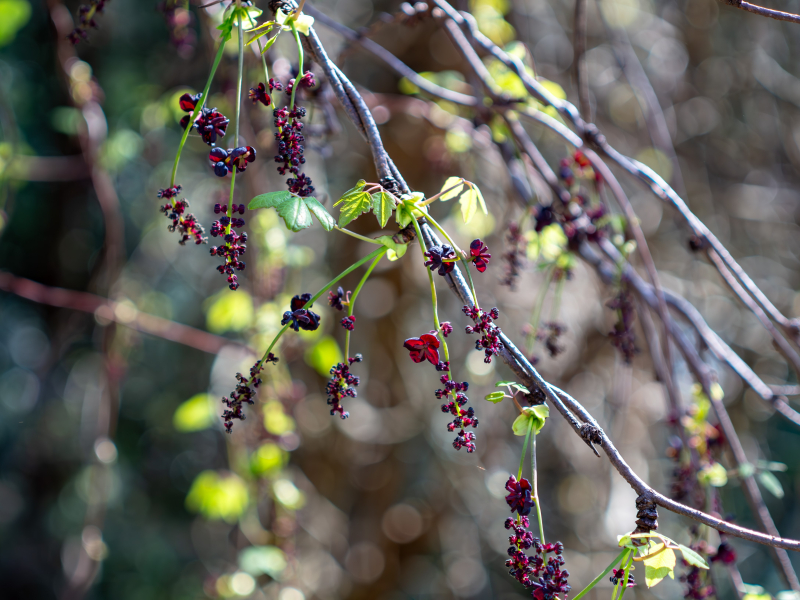
"Mitsuba-Akebi (ミツバアケビ)" trees are in bloom. The name comes from the fact that their leaf consists of three leaflets and that they belong to the "Akebi (アケビ)" group. Their fruits ripen in fall and the flesh of them are sweet and edible. People in some regions eat the peels of the fruits.
2024.04.05
アオキ
アオキが咲いています。樹林内によく見られる常緑低木です。和名は冬でも葉や茎が青々としていることに由来します。シカの食害を受けやすいらしく、不二聖心ではあまり多くありません。
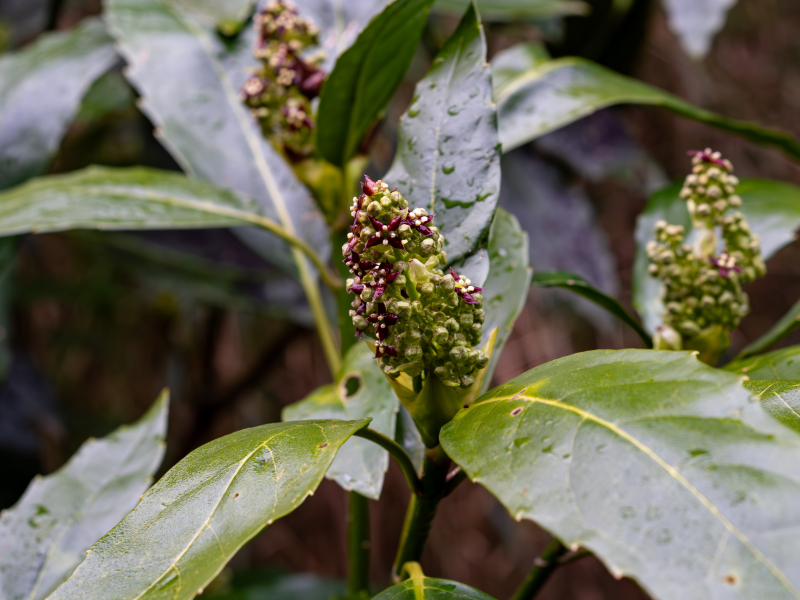
2024.04.02
フサザクラ
フサザクラが咲いています。渓流沿いに多い落葉樹です。花は葉に先立って咲き、多数の暗紫色の雄しべが目立ちます。和名は、この花の咲く様子を桜に見立てたものと考えられます。花びらやがくはなく、原始的な植物の一種といわれています。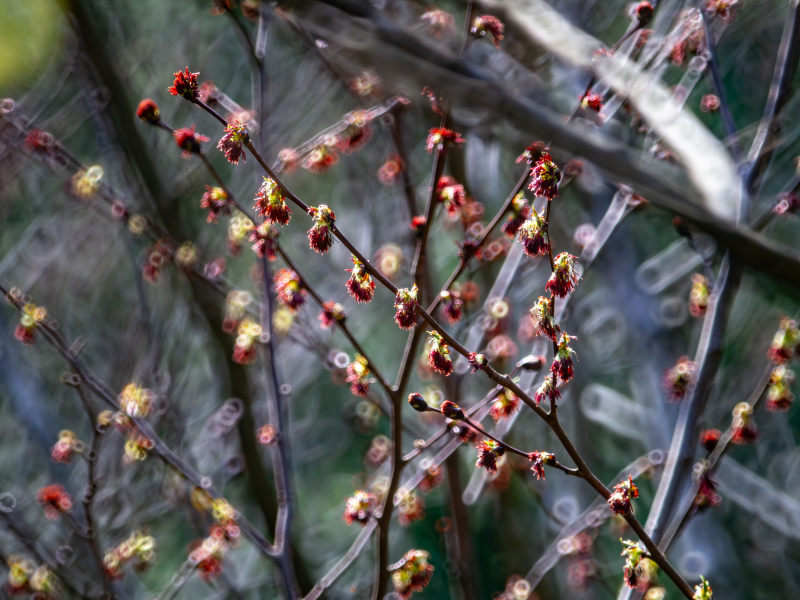
"Fusa-Zakura (フサザクラ)" trees are in bloom. They are deciduous trees that often grow along mountain streams. They bloom before spreading their leaves and their dark red stamens are outstanding. The name comes from the fact that their way of blooming seems to be that of cherry blossoms. They are considered as a primitive species because their flowers don't have their petals or sepals.
2024.03.29
ニッコウネコノメ
ニッコウネコノメが咲いています。しめった場所に生育する小型の多年草です。ネコノメソウのなかまは互いによく似ていますが、雄しべの個数や葯の色、がくの開き方などから見分けることができます。
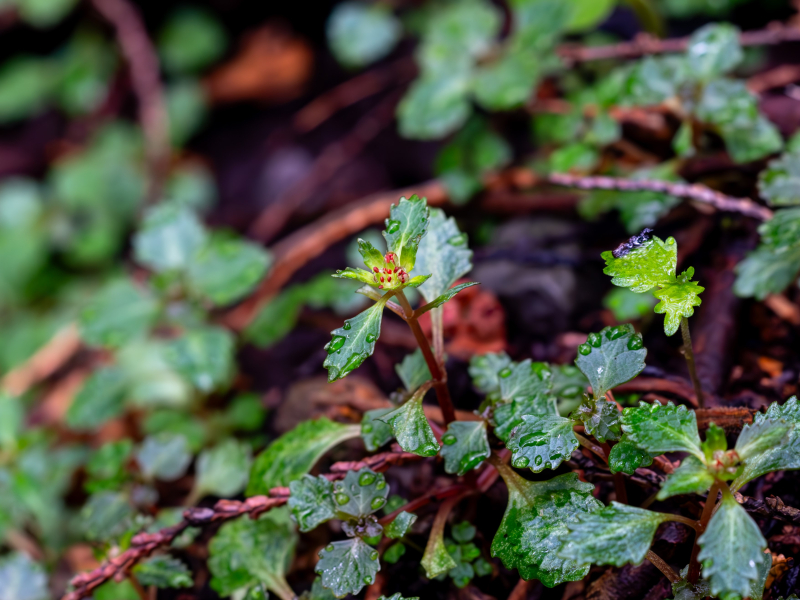
"Nikko-Nekonome (ニッコウネコノメ)" plants are in bloom. They are small perennial plants growing at wet places. The species belonging to the "Nekonome-Sou (ネコノメソウ)" group look very similar to each other. You can tell this species from others by checking the number and color of its stamens and the way their sepals open.
2024.03.26
ミツマタ
ミツマタが咲いています。中国からヒマラヤが原産で、室町時代に渡来し、かつては和紙の原料として広く栽培されていました。現在でも日本の紙幣の原料として使われています。和名は、枝が3つに分かれることに由来しています。
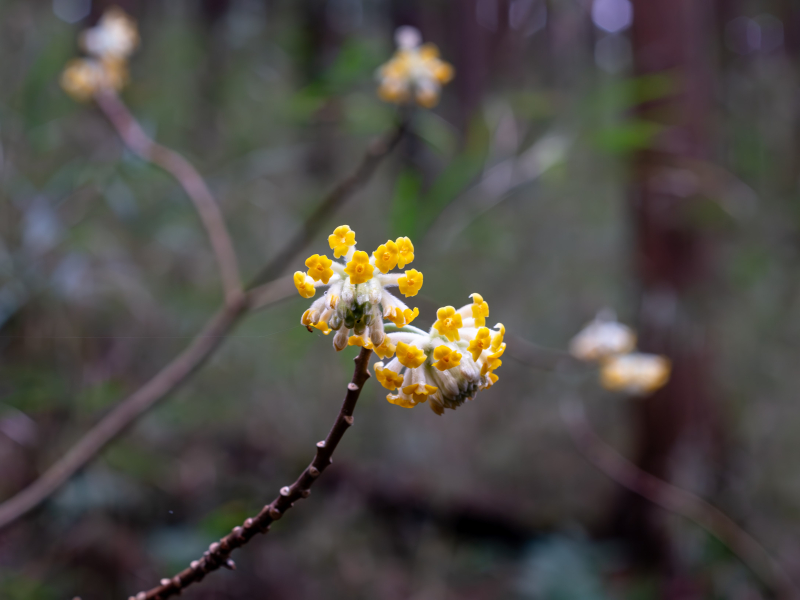
"Mitsumata (ミツマタ)" trees are in bloom. They originally grow in the regions from China to Himalayan and finally came to Japan. People used to cultivate them for making paper. Japanese bills are made from this tree even today. The name comes from the fact that each new branch branches into three.
2024.03.22
コハコベ
コハコベが咲いています。春の七草の一つで食用になります。また、ひよこなどの小鳥の餌として使われたことからひよこ草とも呼ばれています。花びらは5枚ですが、1枚の花びらが根元から深く2つに裂けているため、10枚あるように見えます。

2024.03.19
ホトケノザ
ホトケノザが咲いています。全国でよく見られるシソ科の越年草です。和名は、葉の形が、仏像の台座としてよく見られる蓮華座に似ていることが由来です。春の七草の一つに「ほとけのざ」がありますが、これは本種ではなくキク科のコオニタビラコを指しています。
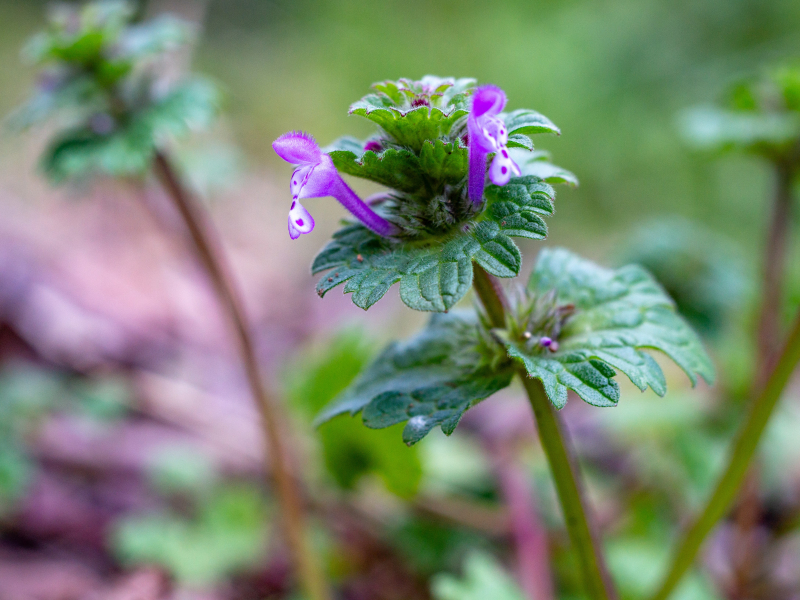
2024.03.15
オオイヌノフグリ
オオイヌノフグリが咲いています。ヨーロッパ原産の帰化植物で、学名はVeronica persicaといいます。Veronica (ヴェロニカ)は、十字架を背負って歩くキリストに顔を拭う布をささげたとされるカトリックの聖人ヴェロニカにちなんでいます。
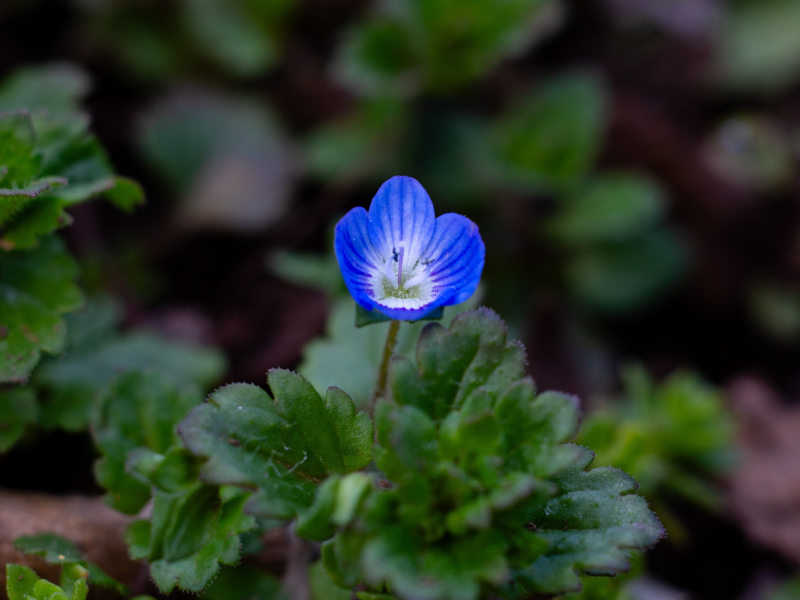
2024.03.12
ヒメリュウキンカ
ヒメリュウキンカが咲いています。ヨーロッパ原産で、栽培品が野生化したものが各地で見られます。花弁には強い光沢があります。全体が大型なものや八重咲のもの、花の色が異なるものなど、いくつかの品種があります。
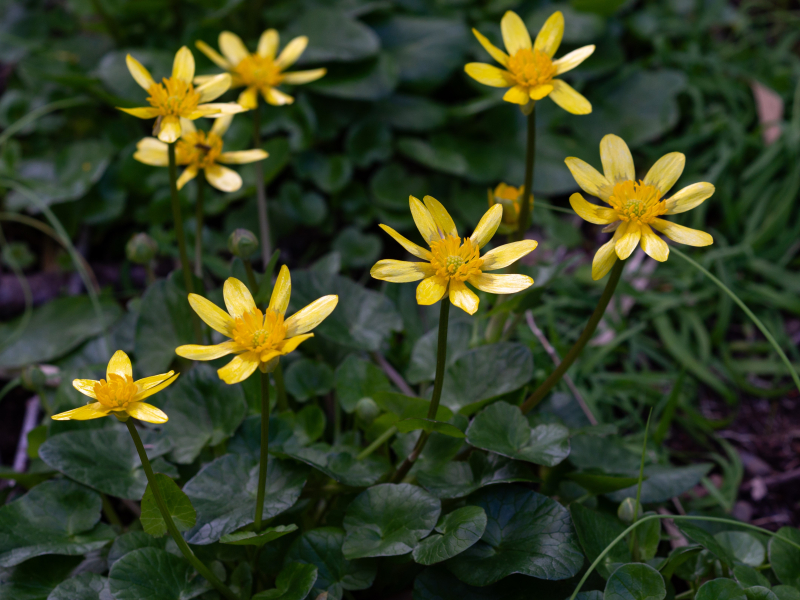
2024.03.05
スギ
スギが雄花をつけています。林業で重要な樹種として広く植林されていますが、花粉症の原因としてもよく知られています。近年では花粉の少ない少花粉スギや・花粉をつくらない無花粉スギの開発が進んでいます。林野庁のホームページによると、現在ではスギの苗木生産量のうち、約5割を花粉の少ないスギが占めていますが、2033年度までに約9割とすることを目指しているそうです。
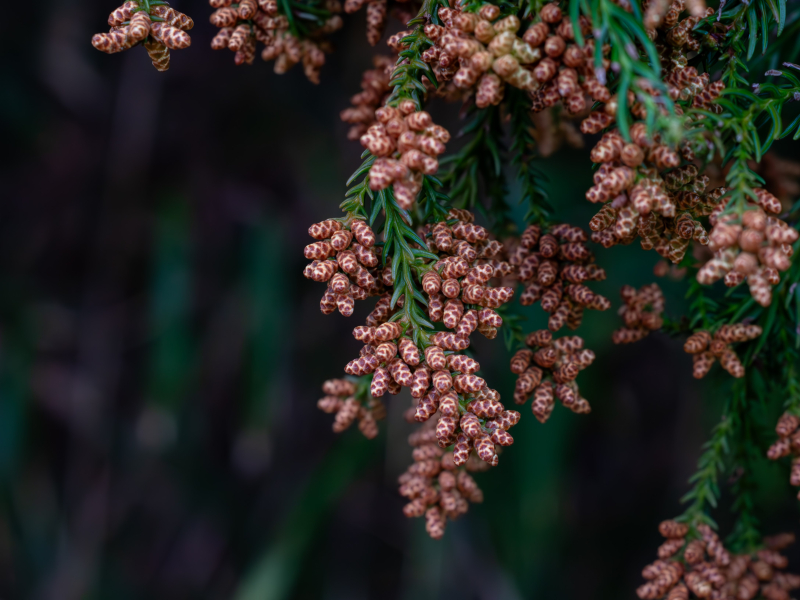
2024.03.01
フキ
フキノトウが出てきました。春に、葉よりも先に伸びだしたフキの花茎をフキノトウと呼び、食用にもなります。

2024.02.23
アセビ
アセビが咲いています。山地に自生するほか、公園などにも良く植えられる身近な木ですが、漢字では馬酔木と書き、食べた馬が中毒で酔ったようになる有毒植物であることを示しています。写真の個体は花が赤味を帯びている園芸品種で、ベニバナアセビと呼ばれています。
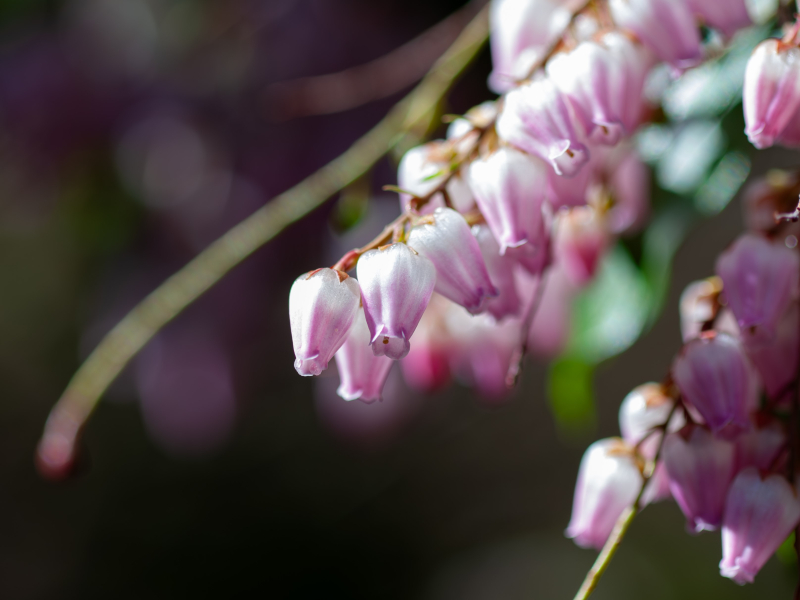
2024.02.20
カワヅザクラ
カワヅザクラが咲いています。2月ごろから咲き始める早咲きの品種です。1955年ごろ、名前の由来となった静岡県河津町で偶然発見された品種です。また、比較的花が咲いている期間が長く、約1か月ほど花を楽しむことができるのも特徴です。
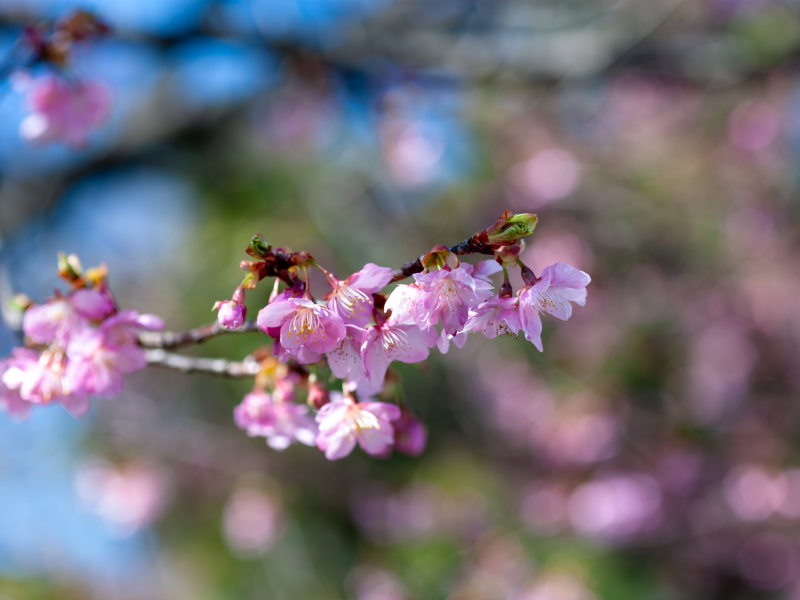
"Kawazu-Zakura (カワヅザクラ)" trees are in bloom. They are early-blooming cherry blossoms that start to bloom in February. Around 1955, the origin of this variety was found by chance in Kawazu, Shizuoka, which became a part of its name. They bloom relatively for a long time, so we can enjoy the flowers for almost a month.
2024.02.09
タネツケバナ
タネツケバナが咲いています。田んぼの近くでよく見られますが、道端などにも見られます。和名は種漬花で、イネの種を水につけて苗を育てる準備をする時期に咲くことが由来といわれています。都市部ではより乾燥に強いヨーロッパ原産のミチタネツケバナがよく見られます。
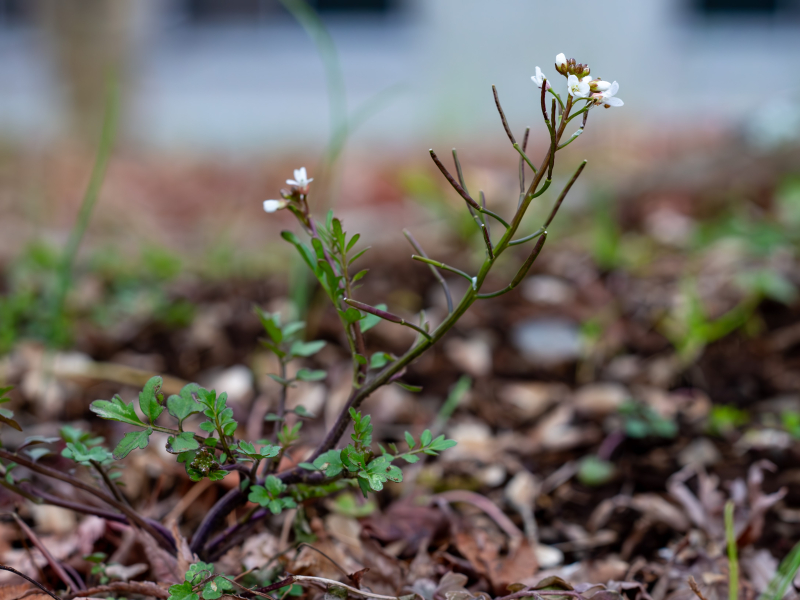
"Tanetsuke-Ban (タネツケバナ)" plants are in bloom. They are often seen around rice fields but sometimes on roadsides. The name comes from the fact that they bloom in the season when people in the past put rice seeds in water to prepare for growing rice seedlings. In the cities, we see their relative plant more often called "Michi-Tanetsuke-Bana (ミチタネツケバナ)," which is resistant to dryness and originally came from Europe.
2024.02.06
オニシバリ
オニシバリが咲いています。ジンチョウゲの仲間の落葉小低木です。落葉樹は冬に葉を落とすものが多いですが、オニシバリは夏に落葉して、秋に新しい葉が展開するという変わった特徴を持っています。和名は、鬼が縛れるほど強靱な樹皮をもつという意味です。

"Oni-Shibari (オニシバリ)" trees are in bloom. They are deciduous shrubs belonging to the "Jinchoge (ジンチョウゲ)" Family. Many deciduous trees fall their leaves in winter, but "Oni-Shibari" trees do it in summer and sprout new leaves in fall. The name "Oni-Shibari" means "Tying up demons" and it comes from the fact that their barks are so strong as if we could tie up demons with them.
2024.01.30
ウメ
築山でウメが咲いています。梅には多くの品種があり、花の色や花弁の数はさまざまです。築山では紅梅に少し遅れて白梅が咲き始めました。
2024.01.26
ヒメツルソバ
ヒメツルソバが咲いています。ヒマラヤ地方原産の園芸植物ですが、野生状態で生えていることもよくあります。花は一年中見ることができます。
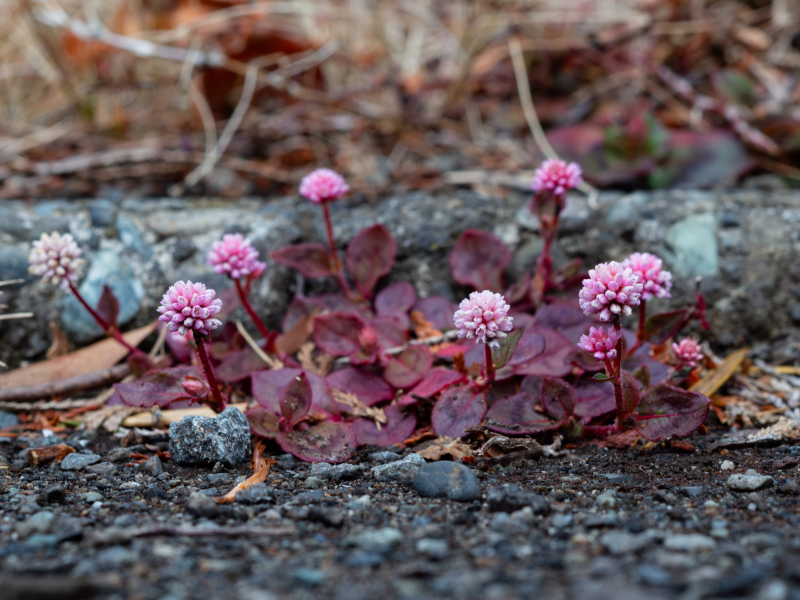
2024.01.23
スイセン
スイセンが咲いています。12月から3月に香りのある花を咲かせます。もともとは古い時代に中国を経由して渡来したといわれ、海岸近くでは野生化しています。花の後に種子はできず、球根によってふえていきます。
"Suisen (スイセン)" plants are in bloom. They bloom fragrant flowers from December to March. They came to Japan in old times by way of China and started to grow wildly along coasts. After flowering, they don't bear seeds, so they spread by their bulbs.
2024.01.16
ロウバイ
ロウバイが咲いています。中国原産の落葉低木で、よく庭木として植栽されています。1月ごろ、葉よりも先に黄色い花を咲かせます。花びらは透明感があり、ろう細工のようです。ふつう花の中心の花びらは赤紫色ですが、すべて黄色いものをソシンロウバイといい、こちらもよく植栽されています。
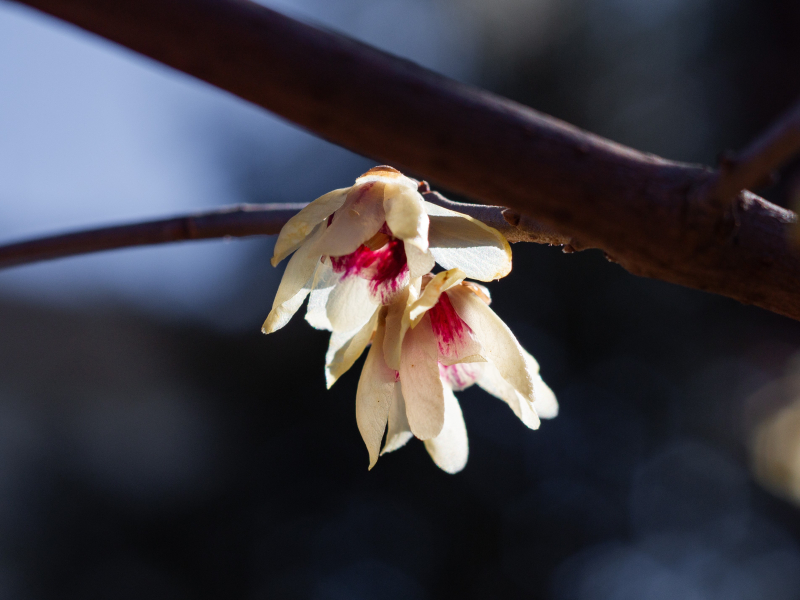
2024.01.05
アマチャヅル
アマチャヅルが果実をつけています。黒緑色で環状の模様があるのが特徴です。和名のアマチャヅルは、葉を乾燥させて煎じたものに甘味があり、つる性の植物であることに由来します。
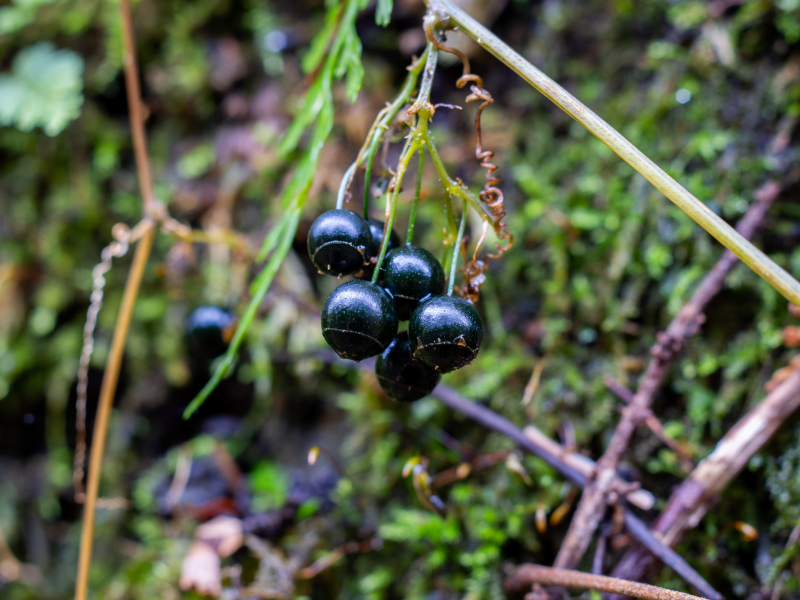
2024.01.02
キミノセンリョウ
キミノセンリョウが果実をつけています。センリョウは通常赤い実をつけますが、黄色の実をつける品種をキミノセンリョウ(黄実のセンリョウ)と呼んでいます。センリョウは正月に赤い実をつけることから、縁起の良い木としてよく栽培されています。
"Kimi-No-Senryou (キミノセンリョウ)" trees are bearing their fruits. "Senryou" trees usually bear red fruits, but some of them bear yellow fruits and are called "Kimi-No-Senryou," which means yellow fruit Senryou. Senryou trees bear their red fruits in the New Year so they are regarded as a fortunate tree and, therefore, they are popular and often planted.
2023.12.29
アラカシ
アラカシがどんぐりをつけています。よく見られる常緑のどんぐりの木です。カシは漢字では木へんに「堅」と書きます。カシの木の仲間は材がかたく、工具の柄などに用いられています。
2023.12.26
サルトリイバラ
サルトリイバラが果実をつけています。林縁によく見られる、つる性の低木です。和名は猿捕り茨の意味で、茎にある刺に猿が絡まって捕らえられるという意味のようです。
2023.12.22
イイギリ
イイギリが果実をつけています。10m以上になる高木で、高いところに赤い実をたくさんつけています。人家に植えられることも多く、人里に近い山林によく見られるようです。イイギリは雌雄異株といい、雄花だけを付ける雄株と雌花だけをつける雌株に分かれています。この木は雌株になります。
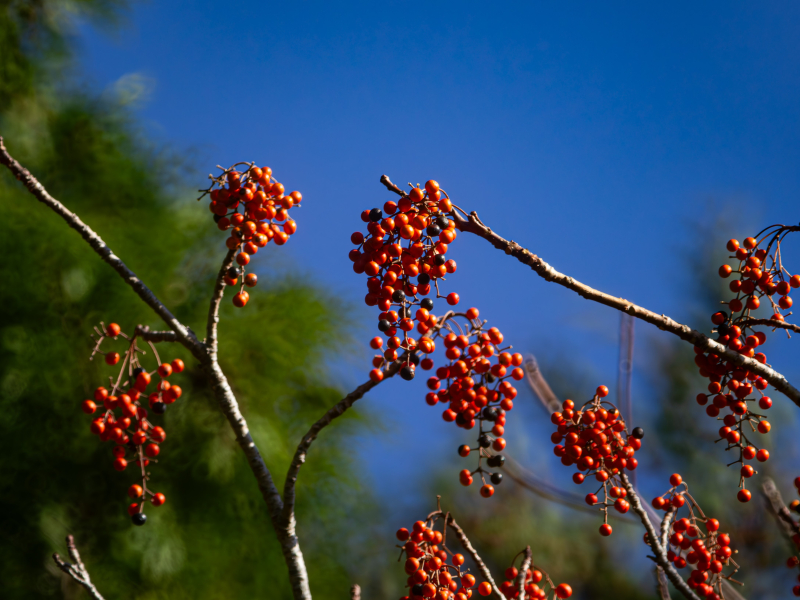
2023.12.19
センニンソウ
センニンソウが果実をつけています。日本に自生するクレマチスの仲間で、果実から生える羽毛状の毛が良く目立ちます。和名は、仙人草の意味で、この毛を仙人の白髪に見立てています。
"Sennin-Sou (センニンソウ)" plants are bearing their fruits. They are clematis that grow in the wild in Japan. The feather-like hair on their fruits are eye-catching. Their name, "Sennin," means hermits, those who live in solitude especially for religious reasons, and it comes from the feather-like hair that looks like hermit's gray hair.
2023.12.15
ジャノヒゲ
ジャノヒゲが種子をつけています。細い葉に隠れて、あまり目立ちませんが、きれいな瑠璃色の種子です。果実のように見えますが、果皮は早い段階で失われ、種子がむき出しになっています。
"Janohige (ジャノヒゲ)" plants are bearing their seeds. Their seeds are very beautiful ultramarine blue, though, in this picture, they don’t stand out very much behind narrow leaves. The seeds look like fruit, but their fruit skin disappears in the early stage of their growth, followed by the explosion of the seeds.
2023.12.12
アズマイバラ
アズマイバラが果実をつけています。低山や丘陵によく見られる野生のバラの一種です。学院では、聖心橋を過ぎたあたりの斜面に見られます。花は5月から6月に咲きます。
"Azuma-Ibara (アズマイバラ)" plants are bearing their fruits. They are a wild rose growing in low mountains and hills. On our campus, you can see them on the slopes after passing the Seishin bridge. They bloom from May to June.
2023.12.08
ハキダメギク
ハキダメギクが咲いています。世界に広く分布しており、日本には大正時代に入ってきたと言われています。和名のハキダメは掃き溜めのことで、ゴミ捨て場を意味しますが、畑や道端など、さまざまな場所で見ることができます。
"Hakidame-Giku (ハキダメギク)" plants are in bloom. They grow widely in the world and came to Japan in the Taisho Era. "Hakidame" literally means "garbage dump." However, they are seen in various places such as fields and road sides.
2023.12.05
ハンショウヅル
ハンショウヅルが果実をつけています。野生のクレマチスの仲間です。他の仲間と同様に、花の後は雌しべの花柱が伸び、その毛も伸びて羽毛状になります。
"Hanshou-Zuru (ハンショウヅル)" plants are bearing their fruit. They are wild clematis. Like other relatives, after flowering, the styles of their pistils grow and the hair on the styles also grows like feathers.
2023.12.01
ヒイラギ
ヒイラギが咲いています。葉の付け根に良い香りのする小さい白い花が集まって咲きます。ヒイラギは、葉にトゲがあるイメージがありますが、トゲがあるのは若いときだけで、成木になるとトゲがなくなります。
"Hiiragi (ヒイラギ)" trees are in bloom. Small fragrant white flowers bloom gathering on their leaf axils. We have an image that "Hiiragi" trees have spiky leaves. However, only when they are young, they have spiky leaves. When the trees become an adult, they lose spikes on their leaves.
2023.11.28
ツワブキ
ツワブキが咲いています。海岸近くなどに自生するキク科の多年草です。古くから栽培されており、江戸時代から続く品種もあるようです。初冬に咲く花だけでなく、厚く光沢のある葉も鑑賞の対象とされています。
"Tsuwabuki (ツワブキ)i" plants are in bloom. They are perennial composite flowers that grow in coastal areas. They have been cultivated for a long time and some cultivars have lasted since the Edo era. People appreciate not only their flowers, which bloom in early winter, but also their thick shiny leaves.
2023.11.24
リュウノウギク
リュウノウギクが咲いています。野生のキクの仲間で、山地の斜面などによく見られます。和名は葉を揉むと、竜脳という香料のような香りがすることに由来します。
"Ryunou-Giku (リュウノウギク)" plants are in bloom. They are a wild Chrysanthemum and often seen on the slopes of mountains. The name comes from the fact that they smell like borneol, which is called "Ryunou" in Japanese, when you rub their leaves.
2023.11.21
アキノキリンソウ
アキノキリンソウが咲いています。ススキ野原や明るい林縁などに生えるキク科の多年草です。別名をアワダチソウといい、同じ仲間に北アメリカ原産のセイタカアワダチソウがありますが、本種は在来種です。
"Akino-Kirinsou (アキノキリンソウ)" plants are in bloom. They are perennial composite flowers that grow in the Japanese pampas grass field and on the sunny edges of forests. "Akino-Kirinsou" plants are a native plant, while they have another name "Awadachisou (アワダチソウ)" and have the relative plants called "Seitaka-Awadachisou (セイタカアワダチソウ), which comes from the North America.
2023.11.17
シラヤマギク
シラヤマギクが咲いています。和名は、山に生える白い菊という特徴がそのまま由来となっています。秋にはキャンパス内に数種類の野生の菊が見られますが、本種は下部の葉が三角形(心形)であること、花びらのように見える舌状花が少なくすき間があいていることなどの特徴があります。
"Shira-Yama-Giku (シラヤマギク)" plants are in bloom. The name comes from the fact that they are a white composite flower that grows in mountains. You can see several wild composite flowers on campus. This species has some characteristics: The plant has triangle-shaped leaves on the lower part of its stem and it has less ligulate flowers, which look like petals.
2023.11.14
サラシナショウマ
サラシナショウマが咲いています。和名は、若芽を食用にするときに、水にさらしてアクを抜くことに由来します。また、根を乾燥させたものを升麻(ショウマ)といい、生薬として利用されています。
"Sarashina-Shouma (サラシナショウマ)" plants are in bloom. The name comes from the fact that when we eat their young leaves, we put the leaves in the water to remove harshness. Their dried roots are used as herbal medicine.
2023.11.10
タイアザミ
タイアザミが咲いています。関東地方では最も身近なアザミの仲間です。和名の由来ははっきりしないようですが、葉にするどい刺があり、触ると「痛いアザミ」からタイアザミとなったという説があります。
"Tai-Azami (タイアザミ)" plants are in bloom. They are the most common plants in the Kanto region that belong to the "Azami" group. The origin of its name is not so clear, but some people say that the name comes from the fact that the plants have thorns on their leaves and they hurt you when you touch them.
2023.11.07
コシオガマ
コシオガマが咲いています。コシオガマはハマウツボ科の半寄生植物で、自ら光合成をする一方で、根で他の植物に取り付き、栄養を奪っています。同じハマウツボ科の寄生植物が世界中で農作物に大きな被害を及ぼしていることから、日本原産のコシオガマは寄生に関する研究のモデル植物として用いられています。

2023.11.03
ハナタデ
ハナタデが咲いています。近縁種に比べて小型で、花数が少ないのが特徴です。牧野富太郎博士によると、本種をハナタデと呼ぶのは間違いで、より花が密につく現在イヌタデと呼ばれている植物が、本来ハナタデと呼ばれるべき植物だそうです。そのため本種をヤブタデと呼ぶこともあります。
"Hana-Tade (ハナタデ)" plants are in bloom. They are smaller and bear less flowers compared to the relative species. According to Dr. Tomitaro Makino, it's wrong to call this species "Hana-Tade". Instead, what we now call "Inu-Tade (イヌタデ)", which are densely flowered plants, should be called "Hana-Tade". Therefore, "Hana-Tade" plants are also called "Yabu-Tade (ヤブタデ)".
2023.10.31
チャ
お茶の花が咲いています。植物としての種の名前はチャまたはチャノキと呼ばれています。ツバキやサザンカのなかまで、花の形がよく似ています。
Tea trees are in bloom. They are called "Cha (チャ)" or "Chanoki (チャノキ)" as a plant. "Cha" plants belong to the same group as "Tsubaki (ツバキ)" plants and "Sazanka (サザンカ)" plants, so the shape of "Cha" flowers are similar to those of "Tsubaki" plants and "Sazanka" plants.
2023.10.27
セキヤノアキチョウジ
セキヤノアキチョウジが咲いています。山地の林縁などに生えるシソ科の多年草です。和名は関屋の秋丁字の意味で、箱根の関所の近くで見つかったことに由来しますが、実際には関東と中部地方の太平洋側に分布しています。
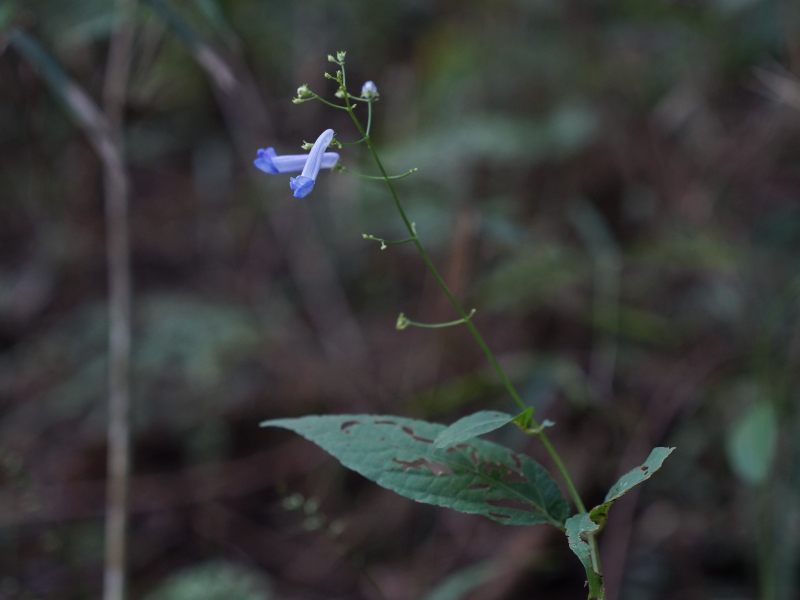
2023.10.24
ヒキオコシ
ヒキオコシが咲いています。和名は、弘法大師が病人に、この草の汁を飲ませたところ、たちまち起き上がったという故事に由来します。強い苦みがあり、古くから民間薬として用いられていたようです。和名と同様の由来でエンメイソウ(延命草)という別名もあります。
2023.10.20
イヌショウマ
イヌショウマが咲いています。多数のおしべがある小さい白い花が穂状につき、よく目立ちます。和名は、食用となり薬草としても利用されるサラシナショウマに似ているものの、本種は利用されないことに由来します。
"Inu-Shouma (イヌショウマ)" plants are in bloom. They are outstanding because they bear white small flowers with a lot of stamens on spikes. The name comes form the fact that although they look like the "Sarashina-Shouma (サラシナショウマ)" plants, which are edible and are used as medicine, the "Inu-Shouma (イヌショウマ)" plants are not used as such.
2023.10.17
チヂミザサ
チヂミザサが咲いています。和名は葉がササの葉に似ていて、波打っていることに由来します。花はあまりめだちませんが、よく見ると羽毛状の毛の生えた雌しべと、ぶら下がった雄しべがあり、繊細な作りをしていて美しいです。
"Chijimi-Zasa (チヂミザサ)" plants are in bloom. The name comes from the fact that their leaves are wavy and look like the leaves of Sasa plants. The flowers are not so outstanding. However, looked at closely, they are delicately beautiful because they have pistils with feathery hair and hanging stamens.
2023.10.13
イヌトウバナ
イヌトウバナが咲いています。やや湿った樹林内や林縁によく見られる多年草です。似た仲間が多く、葉の裏の腺点やがくの毛などが見分けるポイントになります。
"Inu-Toubana (イヌトウバナ)" plants are in bloom. They are perennial plants growing in wet forests and the edges of forests. There are many similar plants, but you can identify "Inu-Toubana" by seeing the glands on the back of leaves and the hair of calyces.
2023.10.10
シソ
シソが咲いています。食用に古くから広く栽培されており、道端などに野生化したものが見られます。葉が紫色のものや、しわがあるものなど、さまざまな品種があります。
2023.10.06
ヤマホトトギス
ヤマホトトギスが咲いています。和名のホトトギスは、花弁の模様が、鳥のホトトギスの胸のもように似ていることに由来するようです。ホトトギスやヤマジノホトトギスなど、花が似ている近縁種がありますが、ヤマジノホトトギスの花は他の近縁種に比べて花弁が強く反り返るという特徴があります。
"Yama-Hototogisu (ヤマホトトギス)" plants are in bloom. A part of their name "Hototogisu (ホトトギス)" comes from the fact that their patterns on the petals are similar to those on the chest of a bird called "Hototogisu (ホトトギス)". "Yama-Hototogisu (ヤマホトトギス)" plants have a characteristic that their petals strongly bend backward more than other relative species like the "Hototogisu (ホトトギス)" plants and the "Yamajino-Hototogisu (ヤマジノホトトギス)" plants, which bloom similar flowers as those of "Yama-Hototogisu (ヤマホトトギス)".
2023.10.03
ツリガネニンジン
ツリガネニンジンが咲いています。和名のツリガネは花の形に由来し、ニンジンは高麗人参の意味で、根の形が似ていることに由来します。明るい草地や林縁に見られますが、生育地の減少などによって数を減らしている地域もあるようです。
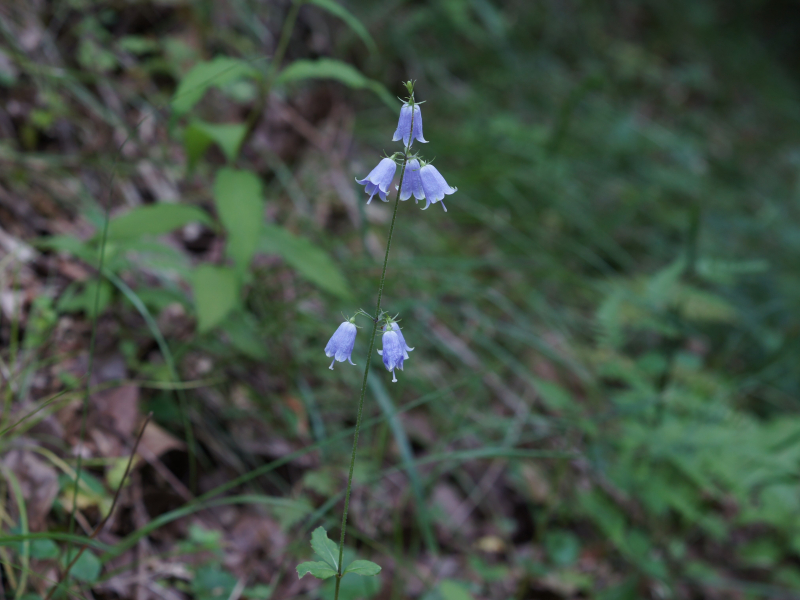
2023.09.29
ツルマメ
ツルマメが咲いています。草原や土手などによく見られるつる性の一年草です。ダイズの原種と考えられており、本種が品種改良されて今日のダイズになったといわれています。
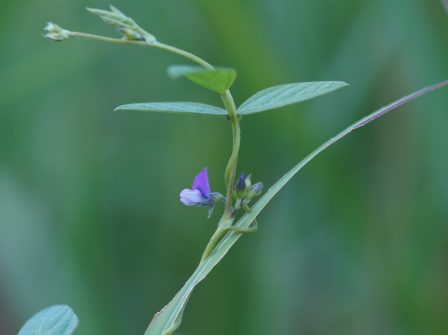
2023.09.26
キンエノコロ
キンエノコロが穂を出しています。和名は、エノコログサに似ていて、穂の毛が黄金色であることに由来します。特に逆光で見ると、黄金色に輝いて見えてきれいです。
2023.09.22
センニンソウ
センニンソウが咲いています。明るい草地などに生えるつる性植物です。学名はClematis ternifloraで、日本に自生するクレマチスの一種です。綺麗な白い花を多数咲かせますが、汁に触れるとかぶれることもある有毒植物なので注意が必要です。

2023.09.19
ヒガンバナ
ヒガンバナが咲いています。秋に一斉に花を咲かせるヒガンバナですが、葉がないことに気が付きます。葉は花の後に伸びてきて、春には枯れてしまいます。また、ヒガンバナは花の後、種ができないことから、地下の球根でなかまをふやしていると考えられます。
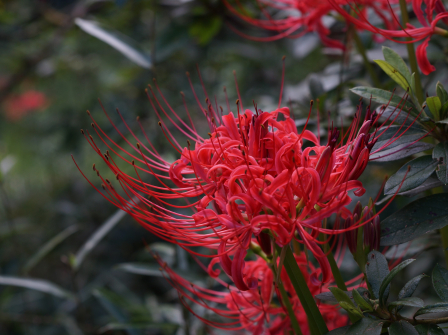
2023.09.15
サワヒヨドリ
サワヒヨドリが咲いています。和名は、湿った場所に生えるヒヨドリバナのなかまという意味です。不二聖心ではススキ野原でよく見られ、実際には比較的乾燥した場所にも生えるようです。
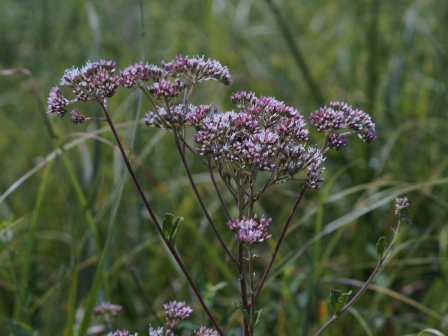
"Sawa-Hiyodori (サワヒヨドリ)" plants are in bloom. The name means that they are in the "Hiyodori-Bana" group growing in wet places and are usually seen in the Japanese pampas grass field on campus. Actually, it seems that "Sawa-Hiyodori" plants grow in relatively dry places too.
2023.09.12
ゲンノショウコ
ゲンノショウコが咲いています。市街地から山地まで、草原的な環境に広く見られる多年草です。古くから薬草として知られています。和名は現の証拠(げんのしょうこ)の意味で、薬効がすぐに現れることに由来するそうです。

"Genno-Shouko (ゲンノショウコ)" plants are in bloom. They are perennial plants that grow in grass fields in various places such as cities and mountains. They have been known as a medicinal herb since a long time ago. The name comes from the fact that their medicinal effect appears quickly.
2023.09.08
コガンピ
コガンピが咲いています。草地に生える落葉小低木ですが、草地の減少に伴い数を減らしています。近縁のガンピやサクラガンピは高級和紙の原料として利用されてきましたが、本種は樹皮がもろく、和紙の原料としては利用できません。
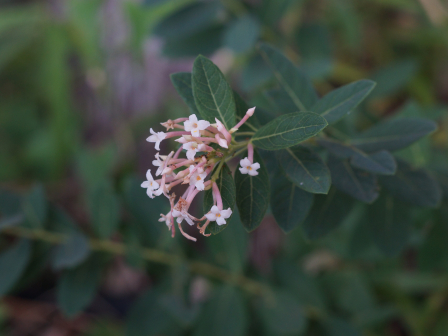
"Ko-Ganpi (コガンピ)" trees are in bloom. They are small deciduous shrubs that grow in grass fields. These days we see less "Ko-Ganpi (コガンピ)" as we have less grass fields. Although "Ganpi (ガンピ)" and "Sakura-Ganpi (サクラガンピ)" trees, which are close relatives to "Ko-Ganpi", have been used for making quality Japanese paper, "Ko-Ganpi" can not be used because their bark is not strong enough.
2023.09.05
ヒキヨモギ
ヒキヨモギが咲いています。ヒキヨモギは葉緑体をもち自ら光合成をする一方で、地下で他の植物から養分を奪って生きている半寄生植物です。明るい草地に生える一年草ですが、草地の減少に伴って数を減らしている植物の一つのようです。
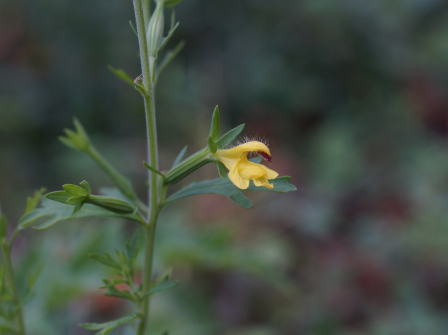
"Hikiyomogi (ヒキヨモギ)" plants are in bloom. They are semi-parasitic plants that take nutrients from other plants underground while they have chloroplasts and carry out photosynthesis. They grow in sunny grass fields. However, they are the one of the plants that are decreasing in number as sunny grass fields are decreasing.
2023.09.01
ヒメガンクビソウ
ヒメガンクビソウが咲いています。和名は花の形が、煙管(キセル)の先端部分の雁首(がんくび)に似ていて、近縁種の中で小型であることに由来します。キャンパス内ではヒノキ林の林床や林縁によく見られます。
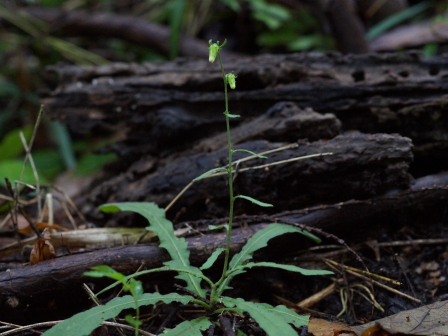
"Hime-Gankubi-Sou (ヒメガンクビソウ)" plants are in bloom. The name comes from the fact that the shape of their flowers looks like "Gankubi", which means the tip of smoking pipes, and "Hime-Gankubi-Sou" are smaller than other relative species. They are usually seen on the edges and the floors of the Japanese cypress woodland.
2023.08.29
キバナノマツバニンジン
キバナノマツバニンジンが咲いています。アメリカ原産の帰化植物で、道端などに生える多年草です。キャンパス内ではオークヒルでよく見られます。
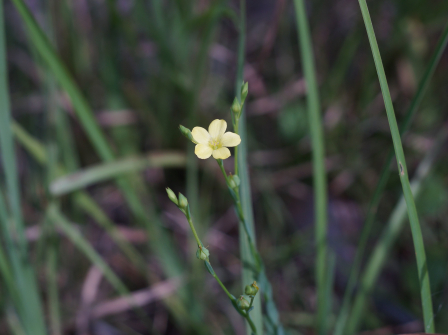
"Kibana-Matsuba-Ninjin (キバナマツバニンジン)" plants are in bloom. They originally come from North America. They are perennial plants that grow on roadsides. They are usually seen in the Oak Hill on campus.
2023.08.25
ガガイモ
ガガイモが咲いています。明るい草地などに生えるつる性の多年草です。ピンク色の星形の花びらには白い軟毛が生えています。名前のイモ(芋)は、長さ10cmほどになる果実に由来します。
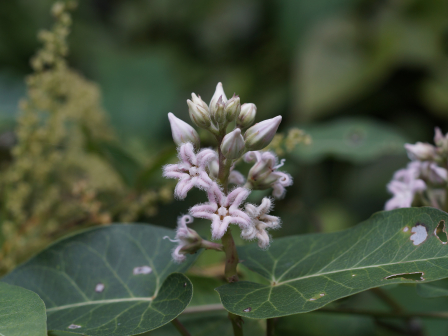
"Gaga-Imo (ガガイモ)" plants are in bloom. They are perennial vine plants that grow in sunny grass fields. The pink star-shaped petals have white soft hair. "Imo" in its name means "potato" and comes from the fact that they bear their fruits like potatoes that grow up to 10 cm.
2023.08.22
クサギ
クサギが咲いています。和名は、臭木の意味で、葉をちぎると独特のにおいがします。しかし、夏に咲く花はとても良いにおいがします。

"Kusagi (クサギ)" trees are in bloom. The name means "stinky tree" because the leaves smell bad when you rip them. However, the flowers smell very good.
2023.08.18
アリノトウグサ
アリノトウグサが咲いています。細い茎に小さい花がついています。アリノトウグサは1つの花で、雄花の時期と雌花の時期が分かれています。これは自分の花粉で受粉しないための工夫と考えられます。2枚目が雄花の時期で、3枚目が雌花の時期です。
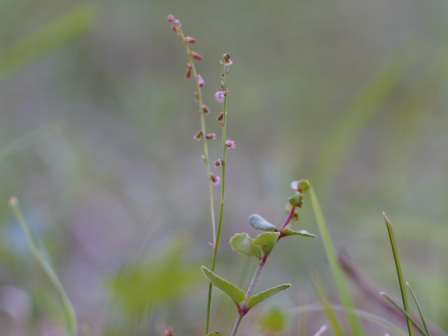
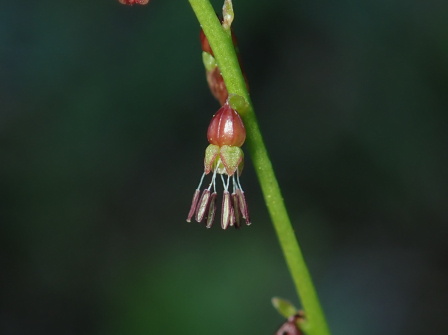

2023.08.15
ヤブミョウガ
ヤブミョウガが咲いています。和名は葉がミョウガに似ていて、藪に生えることに由来します。花も同じ時期に咲きますが、ヤブミョウガはツユクサ科、ミョウガはショウガ科に属しており、違う仲間の植物です。
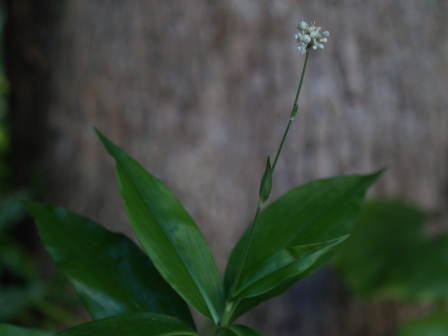
"Yabu-Myouga (ヤブミョウガ)" plants are in bloom. The name comes from the fact that their leaves look like the leaves of "Myouga (ミョウガ)" plants and that they grow in bushes, which is called "Yabu" in Japanese. However, "Yabu-Myouga" plants and "Myouga" plants belong to the "Tsuyukusa (ツユクサ)" family and the "Shouga (ショウガ)" family respectively, so they are far diffrent plants.
2023.08.11
アキノタムラソウ
アキノタムラソウが咲いています。名前にアキノとついていますが、夏から咲き始めます。同じ仲間にナツノタムラソウもあり、花の咲く時期が重なっているためまぎらわしいです。
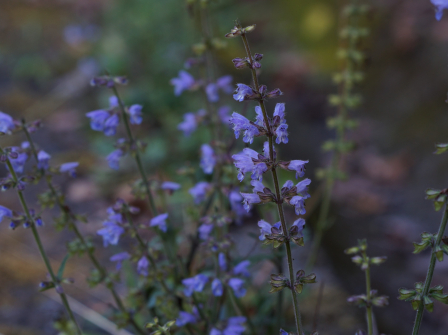
アキノタムラソウは下の写真のように、葯が開くころ、おしべが下向きに強く曲がるという特徴があります。
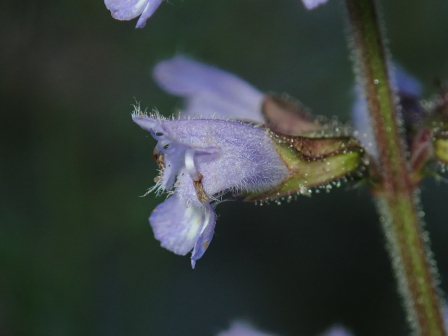
"Akino-Tamurasou (アキノタムラソウ)" plants are in bloom. "Akino" in the name means "fall" but they start to bloom in the summer. There is a relative species called "Natsuno-Tamurasou (ナツノタムラソウ)" and "Natsuno" in the name means "summer." Both of the flowering periods of "Akino-Tamurasou" and "Natsuno-Tamurasou" are overlapping each other and it is difficult to tell one from the other. One of the differences is the stamens of "Akino-Tamurasou" bend downward when their anthers are opening.
2023.08.08
コマツナギ
コマツナギが咲いています。1m前後になる落葉小低木ですが、不二聖心では定期的に草刈りが行われているため、はうように生育しています。和名のコマとは馬のことで、由来は馬をつないでおけるほど茎が丈夫だからという説と、馬が好んで食べるためその場に留めておくことができるからという説があります。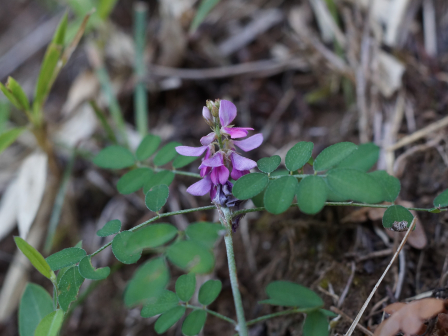
2023.08.04
キツネノマゴ
キツネノマゴが咲いています。日当たりのよい畑や道端に見られる1年草です。中央に密に集まった花序がありますが、たいてい1~2個ずつ順番に花を咲かせています。和名はその花序をキツネのしっぽに見立てたことに由来するといわれています。

"Kitsune-No-Mago (キツネノマゴ)" plants are in bloom. They are an annual plant growing in the fields and on the road sides. They have a dense flower spike on the center, but the spike usually bears only a few flowers at a time one after another. The name comes from the fact that people see the spike as the tail of a fox.
2023.08.01
ミョウガ
ミョウガが咲いています。古い時代に中国から伝わり、栽培されているほか、人家に近い林で野生化しています。野菜として食べている部分は花穂の部分で、花が咲く前のものが食べごろです。

"Myouga (ミョウガ)" plants are in bloom. They came from China a long time ago. they are cultivated and grow in the wild in woods near houses. The part that we eat as a vegetable is a flower spike. The flower spikes before flowering are the best to eat.
2023.07.28
ニガクサ
ニガクサが咲いています。湿った明るい草地に生えるシソ科の植物です。シソ科の花は唇のように花びらが上下2つに分かれた唇形花をもつものが多いですが、本種は上側の花びらが極端に小さいため、下側の花びらしかないように見えます。和名は苦草ですが、茎や葉は特に苦くはないそうです。
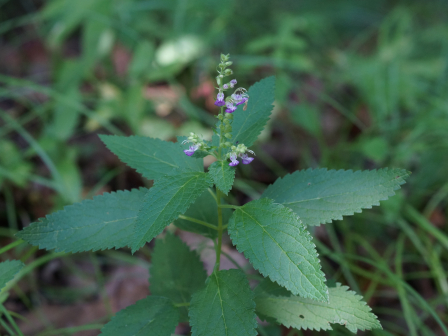
2023.07.25
アラゲハンゴンソウ
アラゲハンゴンソウが咲いています。北アメリカ原産の帰化植物です。名前にアラゲとあるように、茎には硬い毛が生えています。きれいな花ですが、在来種の生息域を奪うなどの生態系への影響が心配されています。
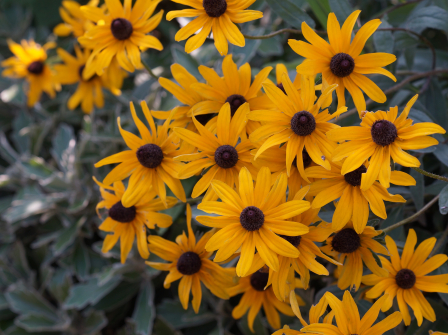
"Arage-Hangon-Sou (アラゲハンゴンソウ)" plants are in bloom. They come from North America. As its name "Arage (アラゲ)" suggests, they have hard hair on their stems. Their flowers are beautiful, but there is a concern for their effect on the ecosystem because they are taking over the habitats of local plants.
2023.07.21
マンリョウ
マンリョウが咲いています。林内に生える低木で、夏に腺点のある白い花を咲かせます。冬に赤い実を多数つけることから縁起の良い木とされ、庭などに植栽されることも多いです。
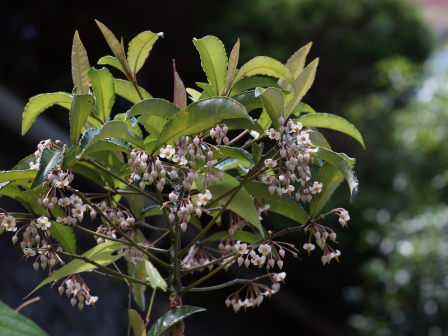
"Manryou (マンリョウ)" trees are in bloom. They are shrubs that grow in forests and bear white flowers that have glands in summer. Since they bear a lot of red fruits in winter, they are known as lucky trees and are planted in gardens.
2023.07.18
ヤマユリ
ヤマユリが咲いています。強い芳香のある野生のユリで、日本固有種です。林縁などに普通に見られるユリですが、栽培しようと思うと案外難しいようです。
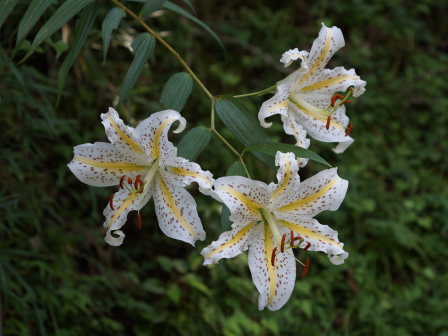
"Yamayuri (ヤマユリ)" plants are in bloom. They are wild lilies with strong fragrance that are an endemic species to Japan. They are commonly seen on the edge of forests, but unexpectedly, it's difficult to grow them in gardens.
2023.07.14
ヒメヤブラン
ヒメヤブランが咲いています。地下にはう茎を出してなかまを増やし、芝地などに群生します。芝生に混じって生えているとあまり目立ちませんが、よく見ると紫色のかわいらしい花を咲かせています。
"Hime-Yaburan (ヒメヤブラン)" plants are in bloom. They spread by developing their underground stems and grow in cluster on grass fields. They are not outstanding in the grass, but they bear cute purple flowers.
2023.07.11
ウツボグサ
ウツボグサが咲いています。草地や道端に生える多年草です。和名は、花穂が弓矢を収納するための道具である靭(うつぼ)に似ていることに由来するそうです。
"Utsubo-Gusa (ウツボグサ)" plants are in bloom. They are perennial plants that grow in grass fields and roadsides. The name comes from the fact that their flower spikes look like the boxes for storing traditional bows and arrows called "Utubo (靭)."
2023.07.07
コウゾリナ
コウゾリナが咲いています。草地などに普通に見られるキク科の越年草です。全体に赤褐色の剛毛があり、触るとザラザラしています。このようすから男性のひげ剃りを連想し、「顔剃菜(かおそりな)」または「剃刀菜(かみそりな)」から転じてコウゾリナと呼ばれるようになったといわれています。
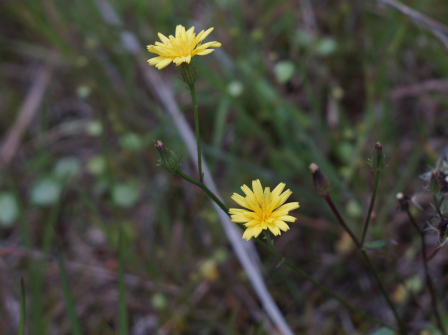
2023.07.04
カナビキソウ
カナビキソウが咲いています。明るい草地に生える多年草です。自ら光合成をする一方で、根の一部が吸盤状となり、他の植物の根から養分を吸収する半寄生植物です。和名は「鉄引草(かなびきそう)」といいますが、由来は不明だそうです。
"Kanabiki-Sou (カナビキソウ)" plants are in bloom. They are perennial plants that grow in sunny grass fields. They are a semi-parasitic plant. While they photosynthesize, some part of their roots become sucker and take nutrition from other plants. It is uncertain where their name comes from.
2023.06.30
ナワシロイチゴ
ナワシロイチゴが咲いています。明るい草地などに生える、キイチゴのなかまです。赤く熟した果実は食べることができます。花の形は少し変わっていて、ピンク色の花弁は、おしべとめしべを包むように直立しています。
"Nawashiro-Ichigo (ナワシロイチゴ)" plants are in bloom. They are a wild berry growing in sunny grass fields. Their red berries are edible. Their flowers are a little bit strange as its pink petals stand upright covering its stamens and pistils.
2023.06.27
テイカカズラ
テイカカズラが咲いています。つる性の木本で、他の木によじ登り、芳香のある白い花を咲かせます。和名は鎌倉時代の歌人・藤原定家(ふじわらのていか)に由来します。定家が恋した式子内親王の墓石にからみついた本種をテイカカズラと呼ぶようになったそうです。
"Teika-Kazura (テイカカズラ)" trees are in bloom. They are woody vines that climb other trees and bear white fragrant flowers. The name comes from a poet of Kamakura period, "Fujiwara-No-Teika (藤原定家)". People started to call this species "Teika-Kazura", because the plants climbed around the tombstone of Imperial Princess Shikishi, who Teika loved.
2023.06.23
ネジバナ
ネジバナが咲いています。希少な種も多いランのなかまでは、最も普通な種で、芝地や道路わきなどでも見られます。しかし、他のランのなかまと同様に、地下で菌根菌と共生しており、栽培しようと思うと意外に難しいようです。和名は、花がらせん状につくことに由来しますが、らせんの向きや強さには変異があります。

2023.06.20
ムラサキシキブ
ムラサキシキブが咲いています。各地の山野に見られる落葉低木です。秋に美しい紫色の果実をつけることで有名ですが、初夏に咲く花も紫色で美しいです。ちなみに、園芸用にムラサキシキブという名前で売られているものは、より実つきのよい近縁のコムラサキであることが多いようです。
"Murasaki-Shikibu (ムラサキシキブ)" trees are in bloom. They are deciduous shrubs that grow in fields and mountains. They are well known for bearing their beautiful purple fruits in fall, but their purple flowers that bloom in early summer are also beautiful. However, the trees called "Murasaki-Shikibu", which are sold for gardening, are often a relative species "Ko-Murasaki (コムラサキ)" and bear more fruits.
2023.06.16
ドクダミ
ドクダミが咲いています。独特の匂いがする多年生で、日陰でもよく育ちます。4枚の白い花弁をもつように見えますが、白い部分は総苞と呼ばれる花の集まりを包む葉が変化したものです。中央の黄色い部分が小さい花のあつまりで、1つ1つの花は花弁やがくをもたず、1本のめしべと3本のおしべからなります。
"Dokudami (ドクダミ)" plants are in bloom. They are perennial plants that have unique smell. They grow well even in the shade. They look like they have four white petals, but the white parts in the photo that look like petals are not petals. The white parts are called involucre, which are the leaves looking like flowers that wrap the flowers. The yellow part in the center actually consists of flowers. They are a pistil and three stamens and have no petals or sepals.
2023.06.13
コモチマンネングサ
コモチマンネングサが咲いています。道端や植え込みなどでよく見られます。和名のコモチとは子持ちの意味で、葉の付け根にむかごをつけてなかまを殖やすことに由来します。コモチマンネングサは花が咲いても種子ができず、ほとんどむかごによってなかまを殖やしているようです。
"Komochi-Mannengusa (コモチマンネングサ)" plants are in bloom. They usually grow in roadsides and shrubberies. "Komochi (コモチ)" itself means "having children" coming from the fact that they bear the bulbils on the bases of their leaves and leave their offsprings. Even though “Komochi-Mannengusa” plants bloom, they don't produce seeds. Therefore, they almost depend on bulbils for spreading.
2023.06.09
ニガナ
ニガナが咲いています。道端や林縁などに普通に見られるキク科の多年草です。花は5枚の花弁をもつように見えますが、タンポポなど他のキク科のなかまと同様に、1枚の花弁に見える部分が1つの花です。
"Nigana (ニガナ)" plants are in bloom. They are perennial plants belonging to the composite family and commonly seen on roadsides and the edge of forests. The flowers seem to have five petals, but the part that looks like a petal is actually a flower, which is the same characteristic that the other plants also have, such as dandelions, belonging to the composite family.
2023.06.06
コナスビ
コナスビが咲いています。道端や畑地などに普通に見られる小型の多年草です。和名は、花後の果実のようすが小型のナスのように見えることに由来します。しかし、コナスビはナス科ではなくサクラソウ科に属します。
"Ko-Nasubi (コナスビ)" plants are in bloom. They are perennial plants commonly seen in roadsides and fields. The name comes from the fact that, after the flowering period, their fruits look like small eggplants. However, "Ko-Nasubi" belong to the primrose group, not the eggplant group.
2023.06.02
アメリカフウロ
アメリカフウロが咲いています。名前の通り北アメリカ原産の帰化植物で、道端や空き地などでもよく見かけます。在来種のゲンノショウコと似ていますが、アメリカフウロのほうが花期が早く、葉も深く切れ込みます。
"America-Fuuro (アメリカフウロ)'' plants are in bloom. The name indicates that they are from North America. They are often seen in roadsides and vacant lots. "America-Fuuro'' resembles a native species "Gen-No-Shouko (ゲンノショウコ)". "America-Fuuro" blooms earlier and has more deeply lobed leaves than those of "Gen-No-Shouko".
2023.05.30
ハコネウツギ
ハコネウツギが咲いています。花は初め白色ですが、しだいに赤色に変わっていくため、一本の木に白色と赤色の花が混じって咲いているように見えます。和名に箱根とつきますが、全国の沿岸地に広く見られるようです。
"Hakone-Utsugi (ハコネウツギ)" trees are in bloom. Their flowers are white when they start to bloom, and then they gradually turn red. Because of this, it looks like each tree has both white and red flowers. The Japanese name includes "Hakone (箱根)", which is a Japanese town, but "Hakone-Utsugi" trees grow widely in coastal areas in Japan.
2023.05.26
ヤマボウシ
ヤマボウシの花が咲いています。花弁のように見える白い部分は総苞と呼ばれる花の集まりを包む葉が変化したものです。北アメリカ原産のハナミズキ(別名アメリカヤマボウシ)に似ており、どちらも庭木などとして植栽されることが多いですが、ヤマボウシは日本の山地や丘陵地に自生もしています。
"Yamaboushi (ヤマボウシ)" trees are in bloom. The white parts in the photo that look like petals are not petals. They are called involucre, the leaves looking like flowers that wrap the flowers. "Yamaboushi" trees look like "Hanamizuki (ハナミズキ)" trees, which originally come from North America. Both “Yamaboushi” and “Hanamizuki” are often planted in gardens, but "Yamaboushi" trees also grow in mountains and hills in Japan.
2023.05.23
フタリシズカ
フタリシズカが咲いています。和名は能の『二人静』に由来します。写真のように茎の先端に2本の花穂をつけますが、花穂が3本以上のこともよくあります。花は変わった形をしていて、花弁やがくはなく、白い部分は雄しべです。
"Futari-Shizuka (フタリシズカ)" plants are in bloom. The name comes from a play called "Futari-Shizuka" of the Japanese traditional theatrical art "Noh (能)". They bear two flower spikes as you can see in the photo, but they often bear more than three. Their flowers are unique. The flowers have no petals or sepals. The white parts in the photo are their stamens.
2023.05.19
ニワゼキショウ
ニワゼキショウが咲いています。北アメリカ原産の帰化植物で、日当たりのよい芝地などによく見られます。花のあとには球形の果実ができます。和名は、セキショウという植物に葉のつき方が似ていて、庭に生えることに由来します。
"Niwa-Zekishou (ニワゼキショウ)" plants are in bloom. They originally come from North America and often grow in sunny grasslands. After flowering, they bear round fruits. The name comes from the fact that they grow in gardens and that the way their leaves are attached look like the plants called "Sekishou (セキショウ)".
2023.05.16
ホオノキ
ホオノキの花が咲いています。15cmほどの大きな花が咲く落葉高木です。写真の花は開き始めであまり目立ちませんが、雄しべの花糸(葯を支える柄の部分)は赤味を帯びています。葉がたいへん大きいのも特徴で、30cmほどもあり、古くから食べ物を包んだり、盛ったりするのに使われてきました。
"Hoo-No-Ki (ホオノキ)" trees are in bloom. They are deciduous tall trees blooming 15cm large flowers. Their filaments are red, which we hardly see in the photo because the flower is just starting to open. One of their characteristics is their large leaves, which are about 30 cm in length and have been used for wrapping and serving food since a long time ago.
2023.05.12
ギンラン
ギンランが咲いています。野生の蘭の一種で、林内や林縁に見られます。ギンランは地下で菌根菌と共生しており、また、菌根菌はクヌギなどの樹木と共生しているため、ギンランの生育環境は三者の共生関係によって成り立っています。しかし、生育環境の減少や園芸目的の採取によって数を減らしており、多くの自治体で絶滅が危惧されています。
2023.05.09
ハンショウヅル
ハンショウヅルが咲いています。林縁に見られるつる植物です。和名は、花の形が小型の釣鐘である半鐘(はんしょう)に似ていることに由来します。学名はClematis japonicaで日本のクレマチスを意味します。
"Hanshou-Zuru (ハンショウヅル)" plants are in bloom. They are a vine plant that grows on the edge of forests. The Japanese name comes from the fact that their flowers look like "Hanshou (ハンショウ)", which means a small hanging bell. Its scientific name "Clematis japonica" means Japanese clematis.
2023.05.05
ツリバナ
ツリバナが咲いています。山地に普通に見られる落葉低木です。名前の通り、花は枝から吊り下がって咲きます。秋には鮮やかな赤い実をつけて、よく目立ちます。
2023.05.02
カキドオシ
カキドオシが咲いています。湿った道端や林縁に生えるシソ科の多年草で、葉をもむと良い匂いがします。和名は垣通し(かきどおし)の意味で、花の後につるを伸ばし、垣根を越えて広がっていくようすに由来します。
2023.04.28
ヒメコウゾ
ヒメコウゾの花が咲いています。一見、花には見えないユニークな形をしていますが、写真の赤い毛の生えた球体は雌花の集まりで、赤い毛の一本一本が雌しべです。ヒメコウゾは雌雄同株で、雄花の集まりも同じ木に見られますが、この写真には写っていません。林縁に見られる落葉低木で、樹皮は和紙の原料として使われていました。
"Hime-kouzo (ヒメコウゾ)" trees are in bloom. They might not be recognized as flowers at a glance. The spheres with red hair in the photo are the clusters of their flowers and every single red hair is their pistil. "Hime-kouzo" are monoecious, so each tree has both male and female flowers. However, we can’t see male flowers in the photo here. They are deciduous shrubs that are often seen in the edge of forests. Their barks were used for making Japanese paper.
2023.04.25
ホウチャクソウ
ホウチャクソウが咲いています。林内に普通に見られる多年草で、不二聖心では校舎裏に群生しています。花は下向きに咲き、釣り鐘のような形をしています。この形が、寺院などに吊り下げられる宝鐸(ほうちゃく)という飾りに似ていることが、和名の由来です。
"Houchaku-Sou (ホウチャクソウ)" plants are in bloom. They are common perennial plants that grow in woods. They grow in clusters behind the school building on campus. Their flowers bloom downward and look like hanging bells. Their name comes from the fact that the shape of their flowers looks like a "Houchaku (宝鐸)", which is an ornament hanging on temples.
2023.04.21
シャガ
シャガが咲いています。人里に近い林に生える多年草で、もともとは中国から渡来したと言われています。花は一日花で、朝開いて夕方にはしぼみます。花は咲くものの種子はできないため、地下茎が伸びて広がるか、人によって運ばれて分布を広げていると考えられます。
2023.04.18
ハナイカダ
ハナイカダが咲いています。山地に見られる落葉低木で、葉の真ん中に花をつけるというユニークな特徴をもっています。雌花だけをつける木と雄花だけをつける木にわかれている雌雄異株です。雌花はふつう1つだけつき、雄花は数個つきます。写真は雄花です。
"Hana-Ikada (ハナイカダ)" trees are in bloom. They are deciduous shrubs that grow in mountains. They have a unique characteristic that their flowers bloom in the center of their leaves. "Hana-Ikada" trees are dioecious. Some trees bloom only female flowers and the others bloom only male flowers. The female trees normally have one female flower on a leaf and the male trees have a few male flowers on a leaf. The flowers in the photo are male flowers.
2023.04.14
クサボケ
第1オークヒルでクサボケが咲いています。日当たりのよい草地や雑木林、林縁などに生える落葉低木です。和名は、庭木などとして植えられることが多いボケに似ていて、丈が低いことに由来します。夏から秋にかけて3〜4cmほどの梨のような果実をつけます。
"Kusa-Boke (クサボケ)" trees are in bloom on the First Oak Hill. They are deciduous shrubs that grow on sunny grasslands, wooded areas and forest edges. The name comes from the fact that Kusa-Boke trees are similar to a relative species "Boke (ボケ)", which is often planted in gardens, and that they are shorter than Boke. They bear pear-like 3 to 4 cm fruit from summer to spring.
2023.04.11
ヒメフタバラン
ヒノキ林でヒメフタバランが咲いていました。和名のフタバランは2枚の葉をもつランのなかまという意味です。環境省のレッドリストには載っていないものの、多くの自治体で絶滅が心配されている貴重なランです。
"Hime-Futaba-Ran (ヒメフタバラン)" plants are in bloom in the Japanese cypress woodland. The Japanese name "Futaba-Ran" means orchids having two leaves. Although they are not designated in the Red List of the Ministry by Environment, they are such precious orchids and are considered to be endangered species in many municipalities.
2023.04.07
ジロボウエンゴサク
ジロボウエンゴサクが咲いています。スプリング・エフェメラル(=春のはかないもの)と呼ばれる植物の一種です。スプリング・エフェメラルとは、春、他の草木が生い茂る前に芽を出し、花を咲かせて種子をつくり、他の草木が生い茂るころには地上部は枯れて、その後は地下の球根で次の春を待つような生活を送る植物の総称です。
"Jirobou-Engosaku (ジロボウエンゴサク)" plants are in bloom. They are called "Spring Ephemeral" . "Spring Ephemeral" is a general term for the plants that sprout in spring before other plants spread their leaves. Then they bloom and produce seeds. While other plants grow leaves well, their aboveground parts die and their bulbs underground wait for the next spring.
2023.04.04
ヤマザクラ
ヤマザクラが咲いています。山地に自生するサクラの代表的な種です。公園によく植栽されるソメイヨシノは葉が開くよりも先に花が咲きますが、ヤマザクラは葉と花が同時に開きます。葉はふつう、開き始めに赤味を帯びています。
"Yama-Zakura (ヤマザクラ)" trees are in bloom. They are typical cherry blossoms growing in mountains. Cherry blossoms, called "Somei-Yoshino" and often planted in parks, bloom before spreading their leaves. On the other hand, "Yama-Zakura" trees bloom and spread their leaves at the same time. Their leaves are normally reddish when they start to open.
2023.03.31
タチツボスミレ
タチツボスミレが咲いています。最も普通に見られるスミレです。写真のような咲き始めの時期には目立ちませんが、地上茎があるタイプです。通常は茎に毛がなく、花は淡紫色ですが、毛の有無や色の濃淡には変異があります。

2023.03.28
フデリンドウ
フデリンドウが咲いています。明るい草地や雑木林に生える越年草です。不二聖心のススキ野原は、茶草場として利用されており、不二農園の方々によって毎年冬に草刈りが行われます。そのおかげで、フデリンドウの生育に適した明るい草地が維持されています。
"Fude-Rindou (フデリンドウ)" plants are in bloom. They are biennial plants that grow on sunny grasslands and wooded areas. The grassland on our campus is used as a "Chagusaba (茶草場)", so the farmers cut the grass every winter. Therefore, the grassland is kept as a sunny grassland that is a good place for "Fude-Rindou" plants.
2023.03.24
モミジイチゴ
モミジイチゴが咲いています。モミジの葉のように葉が切れ込み、花は下向きに咲きます。キャンパス内で見られるキイチゴのなかまの中では最も早く咲きます。果実は黄色に熟し、食用になります。
"Momiji-Ichigo (モミジイチゴ)" trees are in bloom. They have lobed leaves like "Momiji (Maple)" trees and they bloom downward. "Momiji-Ichigo" trees bloom earliest in the "Ki-Ichigo (キチイゴ)" group that we can see on campus. Their fruit ripen to yellow and are edible.
2023.03.21
ヒサカキ
ヒサカキが咲いています。強い独特な芳香があり、この時期にキャンパスを歩いていると花を見るよりも先に、匂いでヒサカキが咲き始めたことに気が付きます。雌雄異株で、写真は雄花です。通常は白い花を咲かせますが、写真のようにピンクがかった花を咲かせる個体もあります。
"Hisakaki (ヒサカキ)" trees are in bloom. They have a strong unique scent. Walking on the campus in this season, you can notice they are starting to bloom by their fragrence before seeing their flowers. They are dioecious, and the flowers in the photo are male flowers. They normally have white flowers, but some have pinkish flowers.
2023.03.17
キランソウ
築山の周りでキランソウが咲いています。道端などでよく見られる身近な野草です。地面をはうように広がるようすを蓋に見立てて、ジゴクノカマノフタ(地獄の釜の蓋)という別名を持っています。ちょっと恐ろしい名前ですが、薬草として利用され病気を治す(=地獄の釜の蓋が閉じる)という良い意味が由来のようです。
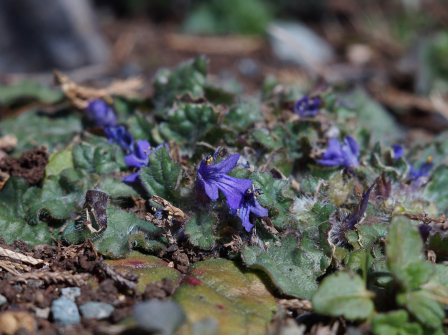
"Kiransou (キランソウ)" plants are in bloom around the artificial hill. They are a common wild flower that can be seen on road sides. They have an alias "Jigokuno-Kamano-Futa (ジゴクノカマノフタ)", as we see them spreading on the ground as a lid. The alias means "Lid of Hell's Cauldron" so it sounds a little scary. However, the alias also implies a the good meaning that they are used as medicinal herb and cure diseases ( = so the plants cover Lid of Hell's Cauldron.)
2023.03.14
ミチタネツケバナ
築山でミチタネツケバナが咲いています。ヨーロッパ原産の帰化植物です。在来種のタネツケバナに似ていますが、茎の途中にはあまり葉をつけないことや、果実が茎や花に寄り添ってつくことなどから見分けることができます。
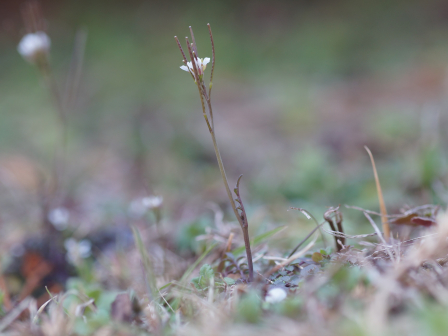
"Michi-Tanetsuke-Bana (ミチタネツケバナ)" plants are in bloom on the artificial hill. They originally come from Europe. They resemble a native species "Tanetsuke-Bana (タネツケバナ)." You can tell "Michi-Tanetsuke-Bana" from "Tanetsuke-Bana" because "Michi-Tanetsuke-Bana" has fewer leaves along its stems and its fruits surround its flowers.
2023.03.10
ヒイラギナンテン
林内でヒイラギナンテンが咲いています。学名をBerberis japonicaといい、「日本の」を意味する種小名をもっていますが、ヒマラヤから台湾、中国が原産で日本には17世紀に渡来したといわれています。庭や公園などによく植栽されますが、逸出したものが林内でも見られます。
"Hiiragi-Nanten (ヒイラギナンテン)" trees are in bloom in forests. Although their scientific name is "Mahonia japonica" and their species name "japonica" means "Japanese", they originally grew spreading from the Himalaya region to Taiwan and China and came to Japan in the 17th century. "Hiiragi-Nanten" trees are often planted in gardens and parks, but you can see the trees that have escaped into forests.
2023.03.07
ナツトウダイ
クヌギ林でナツトウダイが咲いています。名前にナツがつきますが、花は春に咲きます。
花には先のとがった三日月形の腺体が4個ついており、蜜を分泌しています。
The "Natsu-Toudai (ナツトウダイ)" plants are in bloom in the Japanese chestnut oak woodland. The name has "Natsu (ナツ)", which means "summer", but they bloom in spring. The flowers have four crescent-pointed glands, producing nectar.
2023.03.03
クモラン
梅の木に着生しているクモランが果実をつけています。クモランは葉をもっておらず、代わりに葉緑体をもった根が放射状に広がり、光合成をしています。このユニークな姿を蜘蛛に見立ててクモランと呼ばれています。花は初夏に咲きますが、果実は翌春に熟します。写真のクモランも、まもなく果実が開き、ほこりのような細かい種子を飛ばすと思われます。
The "Kumo-Ran (クモラン)" orchids growing on a plum tree are bearing their fruit. They have no leaves, so they photosynthesize with their roots having chloroplasts that spread out radially. The name comes from the fact that people view the shape of its roots as a spider. They bloom in early summer and bear fruit in the following spring. The fruit of the "Kumo-Ran" in the photo will probably ripen and spread its seeds soon.
2023.02.21
アワブキ
写真は共生の森のアワブキの冬芽です。アワブキの冬芽は裸芽で、小さい葉がむき出しになっています。冬芽は褐色の毛に覆われていて、手袋のようなユニークな形をしています。和名は、生木を火にくべると、切り口から泡をふくことに由来します。
The photo shows a winter bud of an "Awabuki (アワブキ)" tree growing in the "Kyosei-Forest (共生の森)". The bud is categorized as "naked buds", exposing their small leaves. The bud is covered with brown hair and it uniquely looks like a glove. The name comes from the fact that when we put its green wood into the fire, it produces bubbles from its cut.
2023.02.10
クロモジ
写真はクロモジの冬芽です。中心にある細長い冬芽が葉芽で、左右の丸い冬芽が花芽です。クロモジは葉や枝を傷つけるとよい香りがし、つまようじの原料として利用されています。
The photo shows the winter buds of a "Kuromoji (クロモジ)" tree. The slender bud on the center is a leaf bud and the rounded buds on the both sides are flower buds. Scratching their leaves or branches, they smell uniquely good. Scratching their leaves or branches, they smell uniquely good. They are used for making toothpicks.
2023.02.07
コウバイ
築山のコウバイ(紅梅)が咲いています。ウメにはたくさんの園芸品種があり、花の色や花弁の枚数、咲く時期などさまざまです。これは薩摩紅梅という品種で、不二聖心では一番早く咲き始めます。
A red plum tree is in bloom on the artificial hill. "Ume (ウメ)" trees have many cultivated varieties. Each variety is different in color, the number of petals and when to bloom. This one is called "Satsuma-Koubai (薩摩紅梅)", and it starts to bloom earliest on campus.
2023.02.03
コブシ
写真は共生の森の近くに見られるコブシの冬芽です。写真のように暖かそうな長い毛に覆われていている冬芽は花芽で、成長すると花が咲きます。花は3月から4月に咲きます。
The photo shows the winter buds of a "Kobushi (コブシ)" tree near the Kyosei-Forest(共生の森). The winter buds with long hair ,looking warm, are flower buds and are going to bloom. They bloom from March to April.
2023.01.31
クロガネモチ
共生の森に植栽されたクロガネモチが赤い実をつけています。関東以西の照葉樹林内に生育する高木ですが、公園や庭によく植えられます。若い枝や葉柄が黒紫色になることが特徴です。雌雄異株で、赤い実をつけるのは雌木だけです。
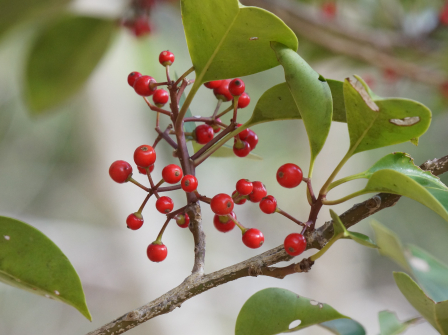
A "Kurogane-Mochi (クロガネモチ)" tree planted in the Kyosei-Forest(共生の森) is bearing red fruits. They are tall trees that originally grow in evergreen forests in the west of Kanto region, but they are often planted in parks and gardens. It's their characteristic that their young branches and leaf stems are purple. They are dioecious, so only female trees bear red fruits.
2023.01.27
センリョウ
聖心坂の近くの林内にセンリョウの赤い実が見られます。正月に赤い実をつける縁起のよい木として知られ、庭などに植えられることもあります。同じく縁起の良い木として知られるマンリョウと一緒に栽培されることもありますが、それぞれマンリョウはサクラソウ科、センリョウはセンリョウ科に属し、植物の仲間としては遠い関係にあります。

The "Senryou (センリョウ)" trees are bearing red fruits in a forest near the "Seishin Zaka(聖心坂)". They are known as lucky trees because they bear red fruits in January. "Senryou" trees are sometimes planted together with "Manryou (マンリョウ)" trees, which are known as lucky trees like the "Senryou" trees. However, the "Manryou" trees and the "Senryou" trees belong to the "Primulaceae" family and the "Chloranthaceae" family respectively, so they are not relatives to each other.
2023.01.24
ヤブムラサキ
ヒノキ林でヤブムラサキが果実をつけていました。ヤブムラサキは不二聖心の森でよく見られる木の1つです。すでに葉も実もなくなっている個体も多いですが、この個体は葉はすべて落としていますが、美しい紫の果実を多く残していました。
2023.01.20
ナンテン
聖心坂でナンテンの赤い実がなっています。縁起が良い木とされ、庭や公園にもよく植栽されています。キャンパス内では植栽されたものとともに、この個体のように栽培品が逸出したと思われるものが林縁に見られます。
The "Nanten (ナンテン)" trees are bearing red fruit on the "Seishin Zaka(聖心坂)". They are regarded as lucky trees, so they are often planted in parks and gardens. On campus, like a tree in the photo, we can see "Nanten" trees that seem to have escaped from cultivated ones as well as the ones we planted.
2023.01.17
アオキ
聖心坂の途中のアオキが赤い実をつけています。一年を通して葉や枝が青々としていることが名前の由来です。花は春に咲きますが、果実は冬に赤く熟します。アオキは雌雄異株(しゆういしゅ)といい、雄花のみが咲く雄株と雌花のみが咲く雌株に分かれています。赤い実がなっているこの木は雌木ということになります。
2023.01.13
ツワブキ
校舎の周りのツワブキが綿毛をつけ始めました。タンポポに比べると小さめですが、淡褐色の丸い綿毛をたくさんつけていて、よく目立ちます。本来は海岸近くに自生しているようですが、庭などによく植えられています。
The "Tsuwabuki (ツワブキ)" plants are bearing puffballs around the school building. Although their puffballs are a little smaller than those of dandelions, they stand out because they have many light brown round-shaped puffballs. "Tsuwabuki" plants originally grow near coasts, but they are often planted in gardens.
2023.01.10
キッコウハグマ
ヒノキ林でキッコウハグマが果実をつけています。果実にはがくが変化した羽毛状の冠毛があります。花は秋に咲きますが、蕾状のまま花が開かない閉鎖花をつけることが多く、キャンパス内では花びらが開いた状態の開放花を見たことがありません。
The "Kikkou-Haguma (キッコウハグマ)" plants are bearing fruits in the Japanese cypress woodland. Their fruits have plumy crests on its top, which are transformed from calyxes. They bloom in fall, but in most cases, they bear cleistogamous flowers that don't open their petals. I have never seen their chasmogamous flowers on campus that open their petals.
2023.01.06
マルバウツギ
マルバウツギの果実が見られます。林縁によく見られる低木で、花は春に咲きます。果実はカップ状で、中には細かい種子が入っています。果期にも5枚のがくが残っており、上から見ると星形に見えます。
The "Maruba-Utsugi (マルバウツギ)" trees are bearing fruits. They are shrubs that are usually seen at forest edges and bloom in spring. Their cup-shaped fruits contain many small seeds inside. Their five sepals still remain during the fruiting period, so they look like a star seen from above.
2022.12.30
ヒサカキ
ヒサカキが黒紫色の果実をつけています。ヒサカキは近縁のサカキとともに神棚に飾られる植物です。スーパーなどで榊(サカキ)として売られているものも、実際は本種であることもあります。花は春の早い時期に咲くため、すでに枝の先の方には蕾が見られます。
The "Hi-Sakaki (ヒサカキ)" trees are bearing dark purple fruit. The "Hi-Sakaki" trees and their relative species "Sakaki (サカキ)" trees are displayed on the household altar. The "Sakaki" trees that are sold in supermarkets are sometimes this species "Hi-Sakaki". They bloom in early spring, so they are already starting to bear flower buds on the tip of their branches.
2022.12.27
シロミノマンリョウ
前回紹介したマンリョウには果実が白色や黄色の品種があり、それぞれシロミノマンリョウ、キミノマンリョウと呼ばれています。写真は共生の森で見られるシロミノマンリョウです。
2022.12.23
マンリョウ
マンリョウの実が赤く色づいています。つやのある赤い実を多数つけることから、縁起の良い植物として知られています。植栽されることが多いですが、校内では鳥が運んだ種から発芽したと思われる個体があちこちで見られます。日本では縁起物とされていますが、アメリカのフロリダ州では園芸目的で持ち込まれた個体が広がり、侵略的外来種とされているようです。
The fruits of "Manryou (マンリョウ)" trees are turning red. They are well-known as lucky trees because they bear a lot of shiny red berries. They are often planted, however on our campus, you can find the trees here and there that have probably grown from the seeds that birds dropped. In Florida, America, they are considered as an invasive alien species because the trees brought in for horticultural purposes have spread, although they are considered as lucky trees in Japan.
2022.12.20
イロハモミジ
ススキ野原のイロハモミジが紅葉していました。最も普通に見られるカエデで、よく植栽もされています。不二聖心には多くのイロハモミジの木がありますが、それぞれ紅葉するタイミングが少しずつ違っていて、長く紅葉を楽しむことができます。
"Iroha-Momiji (イロハモミジ)" trees are turning autumn colors in the Japanese pampas grass field. They are the most common maple trees in Japan and they are often planted. We have many "Iroha-Momiji" trees on campus and each tree turns autumn colors at a slightly different timing, so we can enjoy their autumn colors for a long time.
2022.12.16
ヒイラギモチ
校舎裏でヒイラギモチの木がたくさんの赤い実をつけています。中国原産で、庭木などとして植栽されます。冬につける赤い実はクリスマスの飾りに用いられます。不二聖心でもリース作りの材料として利用しています。
A "Hiiragi-Mochi (ヒイラギモチ)" tree is bearing many red berries behind the school building. They come from China and are sometimes planted in gardens. The red berries in winter are used for Christmas ornaments. In our school, we use this fruit for making Christmas wreaths.
2022.12.13
スイカズラ
グラウンドでスイカズラの果実が見られます。光沢のある黒い果実が2つずつつくのが特徴です。葉の一部は冬でも落葉しないで越冬することから忍冬(ニンドウ)とも呼ばれています。
"Suikazura (スイカズラ)" trees are bearing their fruits on the school ground. They are characterized by having two shiny black fruits on their branches in pairs. Some of their leaves don't fall and remain over the winter. That's why they are also called "Nindow (忍冬)".
2022.12.09
イチョウ
グラウンド横に植栽されているイチョウの黄葉が進んでいます。よく見ると、木によってはすでにほとんど葉を落としてしまったものや、ちょうど黄葉が見ごろのもの、まだ緑の葉も多く残っているものもあります。
"Ichou (イチョウ)" trees planted next to the schoolground are turning autumn colors. Looking closely, some trees have already lost most of their leaves, some are just starting to show yellow leaves, and some still have many green leaves.
2022.12.06
イイギリ
温情舎小学校の跡地の近くにイイギリの木があり、赤い実がなっています。イイギリは飯桐の意味で、葉が桐の葉に似ていて、昔、ご飯を包んだことに由来します。果実は秋ごろに赤く熟しますが、長く枝に残っています。
There is a "Iigiri" tree on the site of "Onjousha" elementary school and the tree is bearing its red fruits. The name comes from the facts that their leaves resemble the leaves of the"Kiri" tree and people in the past used their leaves for wrapping rice. The fruit ripen in fall but they last long on the trees.
2022.12.02
ヤブニッケイ
裏道のヤブニッケイに実がなっていました。ヤブニッケイはシナモンの仲間で、独特な香りがあり、葉や樹皮は薬用になります。学名はCinnamomum yabunikkeiで、和名がそのまま学名に使われており、日本に自生するシナモンであることがわかります。
A "Yabu-Nikkei (ヤブニッケイ)" tree is bearing its fruit on the back road. They belong to the group of cinnamon trees, so they have unique aroma. Their leaves and barks are used as a medicine. Their scientific name is "Cinnamomum yabunikkei", which includes its original Japanese name, so it indicates they are a cinnamon that originally grows in Japan.
2022.11.29
イヌザンショウ
第1オークヒルでイヌザンショウの木が見られます。香辛料として使われるサンショウに似ていて、あまり香りがよくないことからイヌザンショウと呼ばれているようです。果実は赤く熟したあと裂開し、写真のように黒い光沢のある種子が出てきます。
There are "Inu-Zanshou" trees in the First Oak Hill. They resemble "Sanshou (サンショウ)" trees that are used as a spice, but they don't smell as good as "Sanshou" trees, so they are called "Inu-Zanshou". When their fruits ripen, they open and the shiny black seeds come out from them as you can see in the photo.
2022.11.25
カキノキ
第2オークヒルのカキノキ(柿の木)が鮮やかな赤色に紅葉していました。カキノキは広く栽培されていますが、まれに林内に逸出したものが見られます。この木もおそらく動物によって運ばれた種から自然に生えてきたものと思われ、果実は小さく食用にはならなそうですが、葉は美しく紅葉していました。
The leaves of the persimmon tree in the Second Oak Hill are turning bright red. Persimmon trees are widely cultivated and occasionally escape into forests and grow there. This tree in the photo has probably grown from a seed that a wild animal dropped. The fruit of the tree is too small to eat, but the leaves have turned the beautiful autumn colors.
2022.11.22
リュウキュウハゼ
キャンパス内で様々な樹木の紅葉が見られます。第一オークヒルには数本のリュウキュウハゼ(ハゼノキ)があり、鮮やかな赤い葉がひときわ目を引きます。
We are enjoying autumn colors of various trees on our campus. There are several "Ryukyu-Haze (リュウキュウハゼ)" (or "Hazenoki (ハゼノキ)") trees in the first Oak Hill, and their bright red leaves are very beautiful.
2022.11.18
スルガテンナンショウ
竹林でテンナンショウの仲間の果実を見つけました。キャンパス内で見られるテンナンショウの仲間のほとんどがスルガテンナンショウなので、これはスルガテンナンショウの果実だと思われます。赤いトウモロコシのような形をしていますが、毒があるため食べることはできません。
I found a fruit of a plant belonging to the "Tennanshou (テンナンショウ)" group. This fruit should be "Suruga-Tennanshou (スルガテンナンショウ)" because almost all plants belonging to the "Tennannshou" group that we can find on our campus are "Suruga-Tennanshou". The fruit looks like a red corn but it is poisonous and inedible.
2022.11.08
ヤマハッカ
クヌギ林でヤマハッカが咲いていました。和名は山に咲くハッカという意味だと思われますがハッカのような匂いはありません。よく似た種にイヌヤマハッカがありますが、ヤマハッカの花びらには紫の点があることで区別することができます。
"Yamahakka" plants are in bloom in the Japanese chestnut oak woodland. The name means that they are plants looking like "Hakka (ハッカ)" that grow in mountains, but they don't smell like "Hakka" plants. There is a close relative plant called "Inu-Yamahakka," but you can tell "Yamahakka" from "Inu-Yamahakka" by checking purple spots on the petals of "Yamahakka" plants.
2022.11.04
ツワブキ
校舎の周りでツワブキが咲いています。キク科に典型的な頭状花で、中心の両性の筒状花とその周りの雌性の舌状花からなります。本来は海岸近くに自生しているようですが、古くから栽培されており、庭など身近なところでよく見られます。
"Tsuwabuki (ツワブキ)" plants are in bloom around the school building. They have a typical flower head of the asteraceae family ,which consist of bisexual tubular flowers in the center surrounded with female ligulate flowers. "Tsuwabuki (ツワブキ)" flowers originally grow near coasts, but they have been cultivated for a long time, so you can see them in familiar places like yards and gardens.
2022.11.01
ヒノキ
キャンパス内のヒノキが黄葉しています。ヒノキは常緑樹で、葉の寿命が1年以上あるため、一斉に黄葉して葉を落とすことはありません。しかし、秋になると枝の根元に近い一部の葉は黄葉し、葉を落としているようです。
The leaves of Japanese cypress trees on the campus are turning yellow. Japanese cypress trees are an evergreen tree and the lifespan of their leaves is more than a year, so their leaves don't turn yellow and drop all at one time. However, some leaves near to the bottom of their branches turn yellow and drop in fall.
2022.10.28
リュウキュウハゼ
第一オークヒルのリュウキュウハゼが果実をつけていました。別名ハゼノキとも呼ばれます。果実はロウを含み、和ロウソクの材料として使われます。栽培されていたものが逸出し、野生化したものが見られます。
A "Ryukyu-Haze (リュウキュウハゼ)" tree is bearing its fruit in the First Oak Hill. They are also called "Hazenoki (ハゼノキ)". The fruit contain wax, and they are used to make Japanese candles. Some of the cultivated ones have spread and now grow wild.
2022.10.21
イヌコウジュ
第二オークヒルでイヌコウジュが咲いています。明るい草地などに生えるシソ科の一年草です。似ている植物にヒメジソがありますが、茎に下向きの細い毛が密生するなどの特徴から見分けることができます。
"Inu-Kouju (イヌコウジュ)" plants are in bloom in the Second Oak Hill. They are an annual mint-family plants that grow on the sunny grassland. There is a similar plant called "Himejiso (ヒメジソ)", but you can tell "Inu-Kouju" from "Himejiso" by the fact that "Inu-Kouju" has dense thin hair on its stem.
2022.10.14
ミズ
第二オークヒルでミズが咲いていました。湿った場所に生える1年草で、花は葉腋にまとまってつき、あまり目立ちません。和名は、全体に水分が多く、みずみずしいことが由来です。
"Mizu" plants are in bloom in the Second Oak Hill. They are an annual plant growing in humid places. Their flowers gather on their leaf axils and do not stand out very much. The name comes from the fact that they contain lots of water in their bodies.
2022.10.11
ススキ
キャンパス内のあちこちでススキが穂を出しています。写真の奥の株のように穂が紫色のものが混ざっており、これをムラサキススキと呼びます。しかし、中間的な色の株もあり、色の変化は連続的に思えます。
Japanese pampas grasses are in bloom here and there in our campus. You can see in the back of the photo "Murasaki-Ssusuki", the pampas grass blooming purple flowers, as well as white ones. However, some strains are intermediate in color, so you can enjoy the graduation of various colors in some places.
2022.10.07
イチョウ
グラウンド横のイチョウの木の下にギンナンがたくさん落ちています。イチョウは裸子植物ですので、植物学上は外側の果肉状の部分も含めて果実ではなく種子になります。果肉状の部分は取り除き、硬い殻につつまれた中身(胚乳の部分)を食用とします。
I have found many ginkgo nuts under an "Ichou (イチョウ)" tree by the schoolground. "Ichou (イチョウ)" trees are a gymnospermous plant, so botanically, ginkgo nuts, including an outside part that looks like a fleshy fruit, are not fruit but seeds. When we eat ginkgo nuts, we remove the part that looks like a fleshy fruit, and we eat the core covered by a hard shell.
2022.09.27
アオツヅラフジ
グラウンドでアオツヅラフジが咲いていました。がくと花弁がそれぞれ6枚ずつありますが、どちらもクリーム色をしていて花弁のように見えます。秋から冬にかけて青紫色の果実をつけ、中にはアンモナイトのような種子が入っていることで有名です。(種子のようすはこちら)
"Ao-Tsuzurafuji (アオツヅラフジ)" plants are in bloom in the school ground. They have 6 calyces and 6 petals and they are all cream-colored and look like petals. They are well known for the fact that they bear bluish purple fruit from fall to winter that contain the seeds looking like an ammonite fossil. (click here to see the seed.)
2022.09.23
イヌトウバナ
裏道でイヌトウバナが咲いていました。やや湿った林縁などによく見られます。植物では、ある植物に似て非なる植物の名前にイヌと付けることがあります。本種もトウバナに似ているので、イヌトウバナと呼ばれていると思われます。
"Inu-Toubana (イヌトウバナ)" plants are in bloom on the back road. They are often seen on the edges of humid forests. Some plants have the names starting with "Inu (イヌ)" when they look like diffrent relative species. This species has a relative species called "Toubana (トウバナ)", so this one is called "Inu-Toubana (イヌトウバナ)".
2022.09.20
キツネノマゴ
キツネノマゴが咲いています。日当たりの良い道ばたなどに生える1年草です。和名は花穂がキツネの尻尾のように見えることと、大きさが小さいことに由来するそうです。
2022.09.16
マルバノホロシ
裏道でマルバノホロシが咲いていました。紫色で、ナス科特有の形をしています。花弁が大きく反り返ることが特徴です。秋から冬にかけて赤い実をつけます。
"Marubano-Horoshi (マルバノホロシ)" plants are in bloom on the back road. The flowers are purple and their shape is unique to the eggplant family. One of their characteristics is that the petals are recurved back. They bear red fruit from fall to winter.
2022.09.09
ダンドボロギク
裏道でダンドボロギクが見られます。北アメリカ原産の帰化植物ですが、和名は日本では愛知県の段土山(だんどさん)で見つかったことに由来します。花は筒状花のみからなり、あまり目立ちませんが、花後の綿毛がよく目立ちます。
You can find "Dando-Borogiku (ダンドボロギク)" plants on the back road. They originally came from North America, but they were named after the "Dando" mountain in Aichi prefecture where they were first found in Japan. The flowers consist of only tubular flowers so they do not stand out very much but the fluffs are quite visible after the flowers have bloomed.
2022.09.06
ヒカゲイノコヅチ
裏道でヒカゲイノコヅチが咲いていました。名前の通り、日陰になる林内でよく見られます。
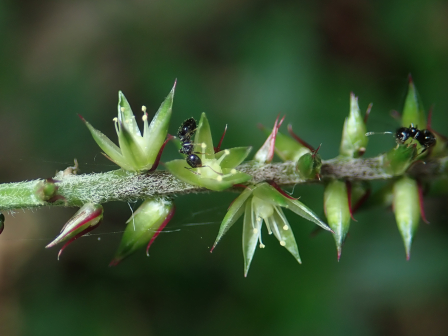
2022.08.05
マンリョウ
マンリョウの花が咲いていました。秋から冬にかけて赤い実を多数つけるため、縁起の良い木としてよく知られていますが、夏に白い花を咲かせます。花全体に小さい点(腺点)があります。
"Manryou" trees are in bloom. They are known as lucky trees because they bear a lot of red fruit form fall to winter, but they bloom white flowers in summer. The flowers have small spots (glands).
2022.07.29
ヒメヤブラン
ススキ野原でヒメヤブランが咲いています。草地や林の中に生える多年草で、小さい薄紫色の花を上向きにつけます。不二聖心ではよく芝生に混じって咲いています。
"Hime-Yaburan (ヒメヤブラン)" plants are in bloom in the Japanese pampas grass field. They are perennial plants that grow in grass fields, forests and so on, and bear small light purple flowers upward. In our campus, they are often seen in lawns.
2022.07.22
アキノタムラソウ
校舎の裏でアキノタムラソウが咲いています。アキノとつきますが、7月ごろから咲いているのを見かけます。
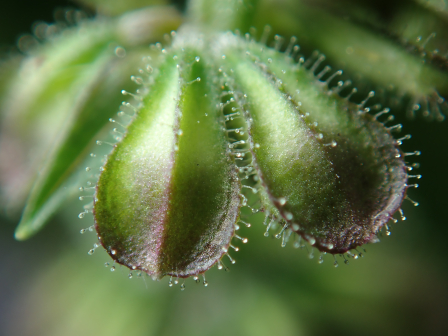
2022.07.05
ヨツバムグラ
ススキ野原にヨツバムグラが咲いていました。キャンパス内でいくつか同じ仲間の植物が見られますが、本種は明るい草地などに見られ、花序の柄が短く、花が密集して咲くことが特徴です。
"Yotsuba-Mugura (ヨツバムグラ)" plants are in bloom in the Japanese pampas grass field. You can see several similar species to this one in our campus. "Yotsuba-Mugura" plants grow in sunny grasslands and have short peduncles and bear flowers densely.
2022.07.01
アカメガシワ
共生の森でアカメガシワの花が咲いていました。アカメガシワは雄株と雌株に分かれていますが、この木は雌株です。
下の写真は雌花です。3つに分かれた黄色い柱頭が目立ちます。子房には若い葉と同様に赤い星状毛が密生し、赤く見えます。
An "Akame-Gashiwa (アカメガシワ)" tree is in bloom in the Kyoseinomori (共生の森). They are dioecious, which means that one tree has only either female or male flowers. This tree is a female one. The second photo shows female flowers. Three yellow stigmas are outstanding. Their ovaries look red because they are covered with red star-shaped hair, same as is also seen in thier read sprout covered by red star-shaped hair.
2022.06.21
ニッケイ
キャンプ場のニッケイの木の花が咲いていました。シナモンのなかまで、葉をちぎると独特な香りがあります。香辛料などに利用するため、かつてはよく栽培されていたようです。
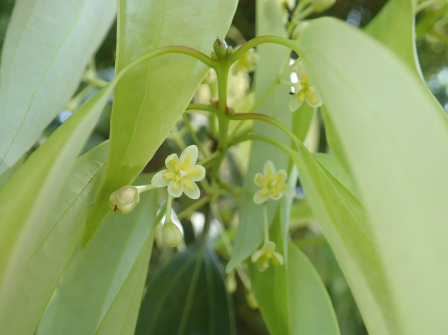
A "Nikkei" tree is in bloom in the campsite. They belong to the group of cinnamon trees, so tearing off leaves gives us a unique aroma. They were once commonly cultivated to use as spices.
2022.06.17
クリ
共生の森に植栽されているクリの木の花が咲いています。クリは雄花と雌花に分かれていますが、1本の木に両方咲いています。穂状にたくさん並んでいるのが雄花です。
雌花は下の写真のように、雄花の付け根のほうに咲きます。
"Kuri (クリ)" trees are in bloom in the Kyoseinomori (共生の森). They have distinct male and female flowers, but a tree has both flowers. The flowers aline in a spike are male flowers as you can see in the first photo. The female flowers bloom on the foot of the spike as you can see in the second photo.
2022.06.10
ヤブムラサキ
ヒノキ林でヤブムラサキの花が咲いていました。近縁のムラサキシキブとともに、秋に美しい紫色の果実をつけることで知られていますが、初夏に咲く花もかわいらしい花です。
"Yabu-Murasaki (ヤブムラサキ)" trees are in bloom in the Japanese cypress woodland. Like their close relative species "Murasaki-Shikibu (ムラサキシキブ)", "Yabu-Murasaki" are known for their beautiful purple fruit. However, the flower that blooms in the early summer is also pretty.
2022.06.07
イボタノキ
共生の森でイボタノキの花が咲いていました。和名は疣取りの木(いぼとりのき)が変化したものといわれています。この木に寄生するイボタロウカイガラムシが分泌するロウを疣(いぼ)をとるのに使われたことに由来します。
A "Ibota-No-Ki (イボタノキ)" tree is in bloom in the Kyoseinomori (共生の森). The name was originally from "Ibotori-No-Ki (イボトリノキ)", which means "wart-removing tree", and comes from the fact that people in the past used the wax produced by an insect "Ibota-Rou-Kaigaramushi (イボタロウカイガラムシ)" that parasitizes this tree for removing warts.
2022.06.03
キクムグラ
ファーストオークヒルとセカンドオークヒルの間の林道でキクムグラが咲いていました。似ている仲間が多いですが、本種は花の下に苞葉があるのが特徴です。学名をGalium kikumuguraといい、和名がそのまま学名となっていることが分かります。
"Kiku-Mugura (キクムグラ)" plants are in bloom on the path between the First and Second Oak Hill. There are many species similar to them, but you can tell "Kiku-Mugura" from others by the fact that they have a bract leaf beneath the flowers. Their scientific name is "Galium kikumugura" and it originates from their Japanese name "KiKu-Mugura".
2022.05.31
ケミミナグサ
セカンドオークヒルに、ミミナグサに混じってケミミナグサが咲いています。『神奈川県植物誌2018電子版』によると、ミミナグサよりもがく片が大きく、苞葉の縁が白膜質になるものをオオミミナグサといい、さらに腺毛をもつものをケミミナグサと呼ぶそうです。写真の個体は上記の特徴を満たすことから、ケミミナグサと判断しました。
"Ke-Mimi-Na-Gusa (ケミミナグサ)" plants are in bloom with "Mimi-Na-Gusa (ミミナグサ)" plants in the Second Oak Hill. According to "Flora of Kanagawa 2018 online version", the ones that have sepals larger than those of "Mimi-Na-Gusa (ミミナグサ)" and have white membrane-like margins on the bract leaves are called "Oo-Mimi-Na-Gusa (オオミミナグサ)". In addition, the ones that have glandular hair are called "Ke-Mimi-Na-Gusa (ケミミナグサ)". The one in the photo has the features mentioned above, so I identified it as the "Ke-Mimi-Na-Gusa (ケミミナグサ)".
2022.05.27
ミミナグサ
セカンドオークヒルでミミナグサが咲いています。和名のミミは耳の意味で、葉の形がネズミなどの動物の耳の形に見えることに由来します。また、和名のナ(菜)は本種が食べられることを示しています。
"Mimi-Na-Gusa (ミミナグサ)" plants are in bloom in the Second Oak Hill. "Mimi (ミミ)" in its name means "ear" and comes from the fact that the shape of their leaves looks like ears of an animal such as a rat. "Na (ナ)" in its name indicates that this species is edible.
2022.05.24
ウシハコベ
共生の森でウシハコベが咲いていました。ハコベに似ていて、より大型であることから牛(ウシ)をつけてウシハコベとなったといわれています。ハコベのなかまは雌しべが3つに分かれるのに対し、ウシハコベは5つに分かれることも見分けるポイントになります。
"Ushi-Hakobe (ウシハコベ)" plants are in bloom in the Kyoseinomori(共生の森). They are larger than the close relative species "Hakobe (ハコベ)". People added "Ushi (ウシ)", which means "cow", to its name "Hakobe". You can tell "Ushi-Hakobe" from others belonging to the "Hakobe" group by the fact that the pistils of "Ushi-Hakobe" are divided into five, while the others' pistils are divided into three.
2022.05.20
ヤブタビラコ
駐車場の近くにヤブタビラコが咲いていました。茎はやわらかく、倒れたり、斜上したりしながら広がります。
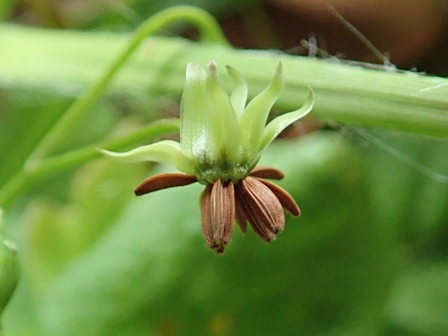
"Yabu-Tabirako (ヤブタビラコ)" plants are in bloom near the parking area. Their stems are soft, so they grow crawling and standing up.
2022.05.17
タニギキョウ
裏道でタニギキョウが咲いていました。和名の通り、山地の谷沿いなどの湿った木陰に生えるキキョウ科の多年草です。茎は柔らかく、地面をはい、上部は立ち上がって小さい白い花をつけます。
"Tani-Gikyou (タニギキョウ)" plants are in bloom on the back road. The name represents the fact that they grow in humid shady places like paths along the valleys and belong to the group of "Kikyou (キキョウ)" plants. Their soft stems crawl on the ground, and the upper parts of them stand up and bear small white flowers.
2022.05.10
ノイバラ
裏道でノイバラが咲いていました。学名をRosa multifloraといい、ラテン語でたくさんの花をつけるバラを意味します。ノイバラはこのたくさんの花をつける性質などからヨーロッパで園芸品種の改良に用いられ、現在の栽培バラの祖先として重要な役割を果たしたそうです。
"Noibara (ノイバラ)" trees are in bloom on the back road. They are scientifically called "Rosa multiflora" and it means "rose that bears many flowers" in Latin. Because of their characteristic of bearing many flowers, they were used in Europe for the improvement of roses. They played an important role as an ancestral species of cultivated roses.
2022.05.06
コバンソウ
裏門の近くでコバンソウ見つけました。和名は小穂のかたちを小判に見立てたものです。地中海沿岸原産の帰化植物で、明治時代に渡来したと言われています。ドライフラワーや花壇などに利用されています。
I found "Koban-Sou" plants near the back gate. The name comes from the fact that their spikelets look like oval gold coins called "Koban" in Japanese. They originally came from a Mediterranean region and it is said that they were firstly brought to Japan during the Meiji era. They are used for dry flowers and planted in gardens.
2022.04.26
ユズリハ
聖心坂の手前にあるユズリハが新葉と雄花序を伸ばしていました。雄花は花弁やがくがなく、紫色の葯が目立ちます。和名は新葉が出てから、古い葉を落とすことに由来します。
A "Yuzuriha (ユズリハ)" tree just by the Seishin bridge is sprouting new leaves and male inflorescences. Its male flowers have no petals or sepals, so the purple anthers are outstanding. The name comes from the fact that they let their old leaves fall after their new leaves grow.
2022.04.22
アカメガシワ
共生の森でアカメガシワが新芽を出しています。伐採跡地などによく見られる落葉高木です。和名は、春にでる新芽が赤いことに由来します。
赤い葉を双眼実体顕微鏡で見ると、星状毛と呼ばれる形の赤い毛が密に生えていることがわかります。
"Akame-Gashiwa (アカメガシワ)" trees are sprouting new shoots in the Kyoseinomori(共生の森). They are a deciduous tall tree and often seen in logging sites. "Akame (アカメ)" in its name means "red sprout" and comes from the fact that their sprouts are red in spring. Seeing red leaves under a binocular stereo microscope, you can find red star-shaped hair growing densely.
2022.04.19
ナガミヒナゲシ
グラウンドの花壇にナガミヒナゲシが咲いています。道ばたや空き地などにふつうに見られるヨーロッパ原産の帰化植物で、近年著しく増えていると言われています。この花壇のものも植えてはいないので、どこからか種が入ってきたのだと思われます。
"Nagami-Hinageshi (ナガミヒナゲシ)" plants are in bloom in the flower bed in the school ground. They originally come from Europe and are often seen in roadsides and vacant lots. It is said that they are really increasing these days. We didn't plant them in this flower bed, so they should have come from somewhere.
2022.04.15
ユキヤナギ
共生の森でユキヤナギが咲いていました。名前にヤナギがつきますが、ヤナギのなかまではなく、バラ科です。自生地は川沿いの岩場などですが、広く栽培されており、各地に逸出しています。
"Yuki-Yanagi (ユキヤナギ)" trees are in bloom in the Kyoseinomori-Forest(共生の森). They have the word "Yanagi" in their name, but they belong to the rose family, not to the family of "Yanagi". They grow originally in rocky places along rivers, but they are cultivated in many places. Some of cultivated ones have spread and grow wild there.
2022.04.08
アオキ
聖心坂の近くの森でアオキが咲いていました。林内でよく見られる低木として、生物基礎の教科書でも紹介されています。和名は、常緑樹で、枝も緑であることに由来します。雌雄異株で、写真は雄花です。
An "Aoki (アオキ)" tree is in bloom in a forest near the "Seishin Zaka(聖心坂)". In a basic-biology textbook, they are known as a low tree often seen in forests. The name comes from the fact that they are an evergreen tree and their branches are also green. They are dioecious and the photo above shows the male flowers.
2022.04.01
ヒメリュウキンカ
正門の近くでヒメリュウキンカが咲いています。ヨーロッパ原産で、各地で栽培されているものが逸出し、野生化しています。花弁には独特な光沢があります。
"Hime-Ryuukinka (ヒメリュウキンカ)" plants are in bloom near the main gate. They originally come from Europe and are cultivated in many places. Some of the cultivated ones have spread and now grow wild. Their petals have unique luster.
2022.03.29
ヒュウガミズキ
裏道でヒュウガミズキが咲いていました。近畿地方の日本海側など限られた地域にしか自生していませんが、各地で植栽されています。和名のヒュウガとは現在の宮崎県を指すと思われますが、最近まで宮崎県に自生するとは考えられていなかったため、由来はよくわかっていないようです。
A "Hyuuga-Mizuki (ヒュウガミズキ)" tree is in bloom on the back road. They, as wild plants, grow in limited areas such as the Japan Sea side of the Kinki region, but people in other places also plant the trees. "Hyuuga (ヒュウガ)" in its name could mean current Miyagi prefecture, but it's not clear where the name originally comes from, because it was found only recently that the trees grow in Miyagi prefecture.
2022.03.25
シデコブシ
共生の森に植栽されたシデコブシが咲いています。コブシに似ていますが、花びらがコブシよりもたくさんあるのが特徴です。野生として東海地方の一部のみに自生し、絶滅が危惧されていますが、庭木として各地に植栽されています。
The "Shide-Kobushi (シデコブシ)" tree planted in the Kyoseinomori-Forest(共生の森) is in bloom. They are similar to "Kobushi (コブシ)" trees, but they have more petals. "Shide-Kobushi" trees, as wild plants, grow in only a part of Tokai area and are considered an endangered species, but people in many places usually plant the trees in gardens.
2022.03.22
ニッコウネコノメ
裏道でニッコウネコノメが咲いていました。ネコノメソウの仲間は似ているものも多く、見分けるのが難しいものもあります。ニッコウネコノメはイワボタン(別名ミヤマネコノメ)の変種で、開花直後の葯が赤褐色であることと、がく片が斜開から平開することが特徴です。
"Nikkou-Nekonome (ニッコウネコノメ)" plants are in bloom on the back road. Plants belonging to "Nekonome-Sou (ネコノメソウ)" resemble each other, so sometimes it's difficult to tell one from the others. "Nikkou-Nekonome" plants are a variety of "Iwabotan (イワボタン)" plants. They are characterized by their dark red anthers immediately after flowering and their half-open or open sepals.
2022.03.18
アカマツ
写真は共生の森のアカマツの冬芽です。クロマツの冬芽は白っぽいのに対し、アカマツの冬芽は赤っぽいので簡単に見分けることができます。写真にある小さい松ぼっくりのようなものは前年の春に咲いた雌花で、今年の秋に熟します。つまり、アカマツは花が咲いてから種子ができるまで、1年半ほどかかります。
The photo shows the winter buds of an "Aka-Matsu (アカマツ)" tree planted in the Kyoseinomori-Forest (共生の森). "Aka-Matsu" trees have reddish winter buds while "Kuro-Matsu (クロマツ)" trees have whitish ones. The small pinecone-like thing in the photo is a female flower that bloomed last year and will ripen this fall. In other words, it takes "Aka-Matsu" trees a year and a half to bloom and produce seeds.
2022.03.15
ハルニレ
写真は共生の森に植栽されたハルニレの冬芽と葉痕です。春に花が咲くのでハルニレと呼ばれています。写真は昨年伸びた枝で、毛が生えています。ハルニレは街路樹として植えられることもあります。
The photo shows a winter bud and a leaf scar of a "Haru-Nire (ハルニレ)" tree planted in the Kyoseinomori-Forest (共生の森). "Haru (ハル)" in its name means "spring" and it comes from the fact that they bloom in spring. The twig in the photo grew last year, so it is hairy. "Haru-Nire" trees are often planted as roadside trees.
2022.03.08
キブシ
写真は共生の森のキブシの冬芽と葉痕(葉が落ちた痕)です。葉痕には維管束痕(水や養分を運ぶ管の集まりの痕)が3つあり、顔のように見えます。
下の写真は花芽です。もうすぐ開花しそうです。
The first photo shows a winter bud and a leaf scar of a "Kibushi (キブシ)" tree planted in the Kyoseinomori-Forest (共生の森). Each leaf scar has three vascular bundle scars, so it looks like a face.
The second photo shows its flower buds. They will bloom soon.
2022.03.04
ホオノキ
写真はキャンプ場のホオノキの冬芽です。葉も花も大きいホオノキは、冬芽も大きく、3cm以上あります。冬芽は無毛の芽鱗に包まれています。(ホオノキの花のようすはこちら)
The photo shows a winter bud of a "Hoonoki (ホオノキ)" tree in the camp site. "Hoonoki" trees, whose leaves and flowers are large, have large winter buds, too. The winter buds are covered with hairless bud scales. (Click here to read an article about the flowers of "Hoonoki")
2022.03.01
アワブキ
写真は共生の森に植栽されているアワブキの冬芽です。冬芽は裸芽で、褐色の毛が密に生えており、手袋のような形をしています。アワブキはスミナガシやアオバセセリなどの蝶の幼虫の食樹です。
The photo shows the winter buds of an "Awabuki (アワブキ)" tree planted in the Kyoseinomori-Forest (共生の森). The buds categorized as "naked buds" are densely covered with brown hair and they look a glove. "Awabuki" trees are a host plant for the larvae of the butterflies such as "Suminagashi (スミナガシ)" and "Aoba-Seseri (アオバセセリ)".
2022.02.25
オニグルミ
写真は共生の森に植栽されたオニグルミの冬芽です。冬芽は裸芽で、短い毛が密生しています。葉痕(葉が落ちた痕)はT字型で、ヒツジやサルの顔のようにも見えます。
The photo shows the winter buds of an "Oni-Gurumi (オニグルミ)" tree planted in the Kyoseinomori-Forest (共生の森). The buds categorized as "naked buds" are densely covered with short hair. Their leaf scar is T-shaped and looks like a sheep or monkey face.
2022.02.22
スギ
写真は駐車場近くのスギの雄花と球果です。雄花はまだ開いていないようで、花粉は出ていませんでした。ニュースによると、東海や関東では暖かくなる今週末にかけて花粉の飛散がピークにはいるようです。
球果は昨年に熟したもので、中には種子が入っていました。
The first photo shows the male flowers and cones of a Japanese cedar tree near the parking area. The male flowers didn't look to bloom yet, so the pollens hadn't come out. According to the news, in the Tokai region and the Kanto region, it's getting warmer from this weekend and the pollen dispersal is going to its peak.
These corns ripened last fall and I found the seeds inside them. (second photo)
2022.02.18
キッコウハグマ
ヒノキ林の林道でキッコウハグマの果実を見つけました。和名のキッコウは亀甲のことで、葉の形が亀の甲羅の形に似ていることに由来します。キッコウハグマは花が開かずに自家受粉して結実する閉鎖花をつけることで知られています。
I found the fruit of the "Kikkou-Haguma (キッコウハグマ)" plants on the path in the Japanese cypress woodland. "Kikkou" in the name means "turtle shell" and it comes from the fact that the shape of their leaves looks like turtle shells. They are known to produce cleistogamous flowers, which are non-opening self-pollinating flowers.
2022.02.15
ヒメシャラ
共生の森に植栽されているヒメシャラに果実がついていました。冬になっても枝に残るようです。果実は硬く木質です。中には種子が入っています。
下の写真は冬芽です。5~6枚の芽鱗に覆われています。よく似たナツツバキの芽鱗は3~4枚なので、冬芽で見分けることができます。
I found the fruit of "Hime-Shara (ヒメシャラ)" tree planted in the Kyoseinomori-Forest (共生の森). The fruit remains on the branches thoughout the winter. The fruit is hard and woody. There are seeds inside the fruit.
The second photo shows their winter buds. The bud is covered by 5 or 6 bud scales. Their close relative species called "Natsu-Tsubaki (ナツツバキ)" has 3 or 4 bud scales, so you can distinguish between the two species by seeing their winter buds.
2022.02.08
イタドリ
写真はイタドリの果実です。イタドリは空き地などにいち早く侵入する先駆植物として、生物基礎の教科書にも紹介されています。果実は翼状に発達した花被片に包まれており、風にのって運ばれます。
The photo shows the fruit of the "Itadori (イタドリ)" plant. In a basic-biology textbook, they are known as a pioneer plant, which is the first species to grow wild on a vacant lot. Their fruit is wrapped with wing-shaped petals, so it is carried on the wind.
2022.02.04
タマアジサイ
冬のタマアジサイの様子です。タマアジサイの花は中心の両性花とそのまわりの装飾花からなります。装飾花は結実していませんが、中心の両性花は結実しています。
果実の中には種子が入っています。タマアジサイの種子はとても細かく、1mmほどしかありません。(タマアジサイの花のようすはこちら)
The first photo shows the "Tama-Ajisai (タマアジサイ)" plant in the winter. Their flowers consist of the bisexual flowers and the ornamental ones that margin the whole flower. The bisexual flowers bear fruit, while the ornamental ones don't.
You can find the seeds inside the fruit. The seeds are very small and about 1mm in length. (Click here to read an article about the flowers of "Tama-Ajisai").
2022.02.01
オニドコロ
オニドコロの果実を見つけました。前回紹介したヤマノイモと似ていますが、地下のイモは食べられません。ヤマノイモの果実は下向きにつくのに対し、オニドコロの果実は上向きにつきます。
また、下の写真のように、種子には片側にのみ翼があります。
I found the fruit of the "Oni-Dokoro (オニドコロ)" plant. They are similar to the "Yamano-Imo (ヤマノイモ)" plants that I posted last time, but the roots of the "Oni-Dkoro" plants are not edible. "Oni-Dokoro" plants bear the fruit upward, while "Yamano-Imo" plants bear the fruit downward.
As you can see in the second photo, the seeds have a wing on one side.
2022.01.28
ヤマノイモ
裏道のフェンスにヤマノイモが巻き付いていました。茎の太さを見ると、地下には大きなイモ(自然薯)がありそうです。イモは1m以上に成長することもありますが、イモは1年生で、毎年新しいイモに作り替えられています。
下の写真はヤマノイモの種子です。種子には翼がついていて、風に乗って運ばれます。
I found a "Yamano-Imo (ヤマノイモ)" plant vine twining on the fence in the back road. Seeing the thickness of the vine, a large tuber should be under the ground. The tubers called "Jinenjo (自然薯)" are edible. Their tubers can grow more than 1m in length, but they are dead and the new ones grow every year.
The second photo shows the seeds of the "Yamano-Imo" plants. The seeds are broadly margined by the wing.
2022.01.25
ガガイモ
ガガイモの果実が熟し、種子が出てきていました。
2022.01.14
コウヤボウキ
ヒノキ林の林道でコウヤボウキの果実を見つけました。和名は高野箒の意味で、高野山では弘法大師が竹を植えることを禁じていたため、竹箒の代わりに本種の枝を集めて箒として用いていたことに由来します。
I found the fruit of the "Kouya-Bouki (コウヤボウキ)" plants on the path in the Japanese cypress woodland. The name literally means "Mt. Kouya's Broom" and comes from the fact that a famous monk Koubou Daishi, who established a temple in Mt. Kouya, banned planting bamboos and they made brooms from the branches of this plant instead of bamboo.
2022.01.11
オモト
ヒノキ林の林床で、オモトが赤い実をつけていました。オモトは古くから栽培され、特に江戸時代にはたいへん流行したといわれています。現在でも多くの園芸品種が知られています。
I found the red fruit of the "Omoto (オモト)" plants in the Japanese cypress woodland. They started to be cultivated a very long time ago. Especially in the Edo era, which is about from 400 to 150 years ago, they became very popular. Even today, we see many cultivated varieties of the "Omoto" plants.
2022.01.07
キミノセンリョウ
聖心坂の近くの森で、キミノセンリョウを見つけました。和名の通り、赤い実がつくセンリョウに対して、黄色い実をつけます。センリョウとともに縁起の良い植物として庭などに栽培されることも多くあります。
I found the fruit of the "Kimino-Senryou (キミノセンリョウ)" plants in a forest near the "Seishin Zaka(聖心坂)". "Kimino (キミノ)" in its name means "yellow fruit" and they actually bear yellow fruit, while the close relative species "Senryou (センリョウ)" bears red fruit. Both "Kimino-Senryou" and "Senryou" plants are regarded as lucky trees and cultivated in gardens.
2022.01.04
コクラン
聖心坂の近くの森でコクランの果実を見つけました。複数の地域で絶滅が心配されているランですが、不二聖心では毎年結実しているようすを確認できます。
果実の中からは、ホコリのように細かい種子が出てきます。ランの種子は一般的に非常に細かく、風によって遠くまで運ばれます。しかし、発芽に必要な養分をもっていないため、発芽には菌根菌と共生する必要があります。(コクランの花のようすはこちら)
I found the fruit of the "Koku-Ran" orchids in a forest near the "Seishin Zaka(聖心坂)". Fprtunately, I can see them bearing the fruit every year in Fuji-Seishin, although they are designated as threatened species in several prefectures. Their very small dust-like seeds come out from the fruit. In general, orchid's seeds are very small so that they can be carried far from their parents by wind. However, they don't have enough nutrients to sprout, so they need to live together with a certain mycorrhizal fungi.
2021.12.31
ハリギリ
聖心坂の途中の森に大きなハリギリの木があります。別名センノキとも呼ばれ、木材として使われてきました。きれいな木目で、ヨーロッパでも人気だそうです。
和名の通り、若い木の幹にはトゲが見られます。
The tall trees called "Hari-Giri" grow in a forest near the "Seishin Zaka(聖心坂)". They are called "Caster aralia" in English and are used as quality wood. The wood-grain is beautiful and the wood is popular in Europe. As the name means thorns, the young trees have thorns on their stems.
2021.12.28
オオアブラギリ
聖心坂にオオアブラギリの果実が落ちていました。和名は、種子から良質の乾性油がとれることに由来します。中国原産で、亜熱帯地域で広く栽培されています。日本でも各地で栽培されていたものが逸出し、野生化しています。
I found the fruit of "Oo-Abura-Giri (オオアブラギリ)" on the "Seishin Zaka(聖心坂)". The name comes from the fact that good drying oil is produced from their seeds. They come from China and are widely cultivated over the subtropical regions. In Japan, some of the cultivated ones have spread and they now grow wild.
2021.12.14
アマチャヅル
裏道でアマチャヅルの果実を見つけました。萼や花弁の名残と思われる環状の模様があるのが特徴です。和名は葉に甘味があり、本種からつくったお茶の味が、アジサイの仲間のアマチャからつくったお茶に似ることが由来と言われています。(アマチャヅルの花のようすはこちら)
I found the fruit of "Amacha-Zuru (アマチャヅル)" on the back road. The fruit is characterized by the ring pattern on it, which is the remain of its calyx and petal. The name comes from the fact that their leaves are sweet and the tea made of their leaves tastes like the tea made of those of "Amacha (アマチャ)" plant, which belongs to the group of Hydrangea.
2021.12.10
スズメウリ
裏道でスズメウリの果実を見つけました。果実は1cmほどの球形で、はじめは緑色ですが、後に写真のように灰白色になります。和名のスズメウリは、カラスウリに対してより小型であることが由来のようです。
I found the fruit of "Suzume-Uri (スズメウリ)" plants on the back road. Their fruit is around 1 cm in diameter. They are green at first and turn ash-white later as you can see in the photo. The name "Suzume-Uri" means "sparrow-melon" and it comes from the fact that their fruit is smaller than the fruit of "Karasu-Uri (カラスウリ)" plants, whose name means "crow melon".
2021.12.07
ナンテン
ナンテンの実が赤く色づいています。関東以西に自生していますが、かつて中国から渡来した栽培品が逸出したものとも言われています。和名のナンテンが「難転、難を転ずる」に通ずることから縁起が良い木とされ、公園や庭木としてしばしば植栽されています。
The fruit of "Nanten (ナンテン)" trees has turned red. They live in the west of Kanto region, however, it's said that they derived from the cultivated trees that came from China in the past. The sound of their name can mean "turning difficulty into fortune" so they are regarded as a lucky tree. They are often planted in parks and gardens.
2021.11.30
ムラサキシキブ
裏道でムラサキシキブが紫色の実をつけています。近縁種のコムラサキよりも大型で2~3mになり、実はややまばらにつきます。庭木としては小型で実付きのよいコムラサキのほうがよく見られますが、野生のものはほとんどムラサキシキブかヤブムラサキです。
I found the fruit of "Murasaki-Shikibu (ムラサキシキブ)" on the back road. Compared to a close relative species "Ko-Murasaki (コムラサキ)", they are larger growing up to 3 m in height and bear a little less fruit. "Ko-Murasaki" trees are more often seen in gardens because they are small and bear more fruit. However, in wild, almost all trees that belong to these similar species are "Murasaki-Shikibu" or "Yabu-Murasaki (ヤブムラサキ)".
2021.11.19
センニンソウ
裏道でセンニンソウの果実を見つけました。花の後、雌しべの花柱(かちゅう、柱頭と子房の間の部分)とその羽毛状の毛が伸びます。和名のセンニンは仙人を意味しており、この果実に生える羽毛状の毛を仙人の白髪に見立てたことに由来します。(センニンソウの花のようすはこちら)
I found the fruit of "Sennin-Sou (センニンソウ)" on the back road. After their flowering period, both their style, which is the part between their ovary and stigma, and their featherlike hair on it grow. “Sennin (センニン)” in its name means hermit and it comes from their featherlike hair on the fruit that looks like the hair of a hermit. (Click here to read an article about flowers of "Sennin-Sou").
2021.11.16
ガガイモ
駐車場近くのガガイモが果実をつけていました。6cm~10cmにもなる大型の果実で、表面にはいぼ状の突起があります。名前のイモは、地下に芋ができることを意味するのではなく、この果実に由来しています。(ガガイモの花のようすはこちら)
I found the fruit of "Gaga-Imo (ガガイモ)" plants near the parking area. The large fruit with warty surface grows up to 10 cm in length. "Imo (イモ)" in its name means "tuber". However, the name doesn't mean that they have tubers underground but that the name comes from this fruit looking like a tuber. (Click here to read an article about flowers of "Gaga-Imo").
2021.11.12
アオツヅラフジ
裏道でアオツヅラフジの果実を見つけました。ブルーベリーのような見た目でおいしそうですが、有毒なため食べることはできません。
また、果実の中の種子が、下の写真のようにアンモナイトの化石のように見えることで有名です。
I found the fruit of "Ao-Tsuzurafuji (アオツヅラフジ)" on the back road. They are similar to blueberries and look tasty, but they are not edible because they are poisonous. Their seeds inside the fruit are famous for the fact that they look like fossils of ammonites.
2021.11.09
ノササゲ
裏道でノササゲの果実が紫に色づいていました。 さらに熟すと、果実が裂開し、黒い種子が出てきます。花は黄色で、9月ごろ咲きます。(ノササゲの花の記事はこちら)
The fruit of "Nosasage (ノササゲ)" plants on the back road is turning purple. When the fruit ripens more, its black seeds will come out by dehiscence. Their flowers are yellow and bloom around September. (Click here to read an article about the flowers of "Nosasage").
2021.11.05
セキヤノアキチョウジ
裏道にセキヤノアキチョウジが咲いていました。名前のセキヤとは関屋、つまり、関所の役人のいる建物を意味し、本種が箱根の関所の近くで見つかったことに由来します。岐阜県以西に分布するアキチョウジに対し、本種は栃木県から愛知県に分布しています。
"Sekiya-No-Akichouji (セキヤノアキチョウジ)" plants are in bloom on the back road. "Sekiya (セキヤ)" in its name means the buildings where checkpoint officers in the Edo era stayed and the name comes from the fact that this species was first found near the checkpoint in Hakone. These "Sekiya-No-Akichouji" plants grow in the area between Tochigi and Aichi prefecture, while the related plants called "Akichouji (アキチョウジ)" grow in the west of Gifu prefecture.
2021.11.02
サラシナショウマ
裏道でサラシナショウマが咲いていました。和名のサラシナとは晒し菜の意味で、本種の若芽を食用とするときに、水で晒してから食べることに由来します。また、本種の根は漢方薬の升麻(ショウマ)として市販されることもあります。
"Sarashina-Shouma (サラシナショウマ)" plants are in bloom on the back road. "Sarashina (サラシナ)" in its name means "rinsed vegetables" and comes from the fact that people rinse the plants in water to remove the harsh taste before eating. The roots of this plant are sold as a herbal medicine called "Shouma (ショウマ)".
2021.10.22
ヤブミョウガ
裏道でヤブミョウガの果実がなっていました。果実は光沢のある藍色ですが、この色はコガネムシの体などと同様に、構造色と呼ばれ、果皮の物理的な形状によって見えている色だといわれています。
見た目はブルーベリーのようですが、中は乾燥していて、小石のような種子が入っています。
(ヤブミョウガの花のようすはこちら)
2021.10.19
ミズヒキ
裏道でミズヒキが見られます。林縁などでよく見られるタデ科の植物です。和名は、赤い花が長い穂状につくようすを、祝儀袋などにかける飾り紐の水引に見立てたことに由来します。
白花の品種をギンミズヒキと呼びます。裏道でもときどき見られます。
I found "Mizuhiki (ミズヒキ)" plants on the back road. They are a plant that belongs to the "Knotweed" group and is often seen in forest edges. The name comes from their flowers that look like Japanese traditional ribbons called "Mizuhiki (水引)" to wrap gifts.
Their white-flower variety is called "Gin-Mizuhiki (ギンミズヒキ)". They are sometimes seen on the back road, too.
2021.10.12
ハナタデ
裏道にハナタデが咲いています。名前にタデとつく似た仲間が多くありますが、比較的花の数が少ない本種に花タデという名がついています。牧野富太郎博士によると、本種をハナタデと呼ぶのは間違いで、今日イヌタデと呼ばれている種が本来のハナタデであるそうです。
"Hana-Tade (ハナタデ)" plants are in bloom on the back road. There are many relative species whose names include "Tade (タデ)". However, among those species, this species has less flowers although "Hana (ハナ)" in its name means "flower". According to Dr. Makino, it is wrong to call this species "Hata-Tade" and another species called "Inu-Tade (イヌタデ)" should be called "Hata-Tade".
2021.10.08
チヂミザサ
裏道でチヂミザサが咲いていました。林中や林縁など、日陰によく見られます。和名はしわの多い、ササのような葉をもつことに由来します。葉などに基部のふくれた長毛が生えているものをケチヂミザサ、生えていないものをコチジミザサと2変種に分けることもあります。
"Chijimi-Zasa (チヂミザサ)" plants are in bloom on the back road. They are often seen in the shade such as on forest edges and in forests. The name comes from their wrinkled leaves resembling Sasa plant's leaves. "Chijimi-Zasa (チヂミザサ)" can be divided into two varieties. One, which has long hair with swollen bottom, is called "Ke-Chijimi-Zasa (ケチヂミザサ)". The other, which doesn't have hair, is called "Ko-Chijimi-Zasa (コチジミザサ)".
2021.10.05
ノササゲ
裏道でノササゲの花が咲いていました。街中ではあまり見かけませんが、林縁などではよく見られます。和名は野に見られるササゲという意味ですが、食用にはされないようです。
"No-Sasage (ノササゲ)" plants are in bloom on the back road. They are not often seen in the city but are often seen in forest edges. Their name comes from edible beans called "Sasage (ササゲ)" but this species is not edible.
2021.09.28
カラムシ
裏道でカラムシの花が咲いていました。写真に写っているのは雌花序で、球状に集まった雌花が、穂状についています。林縁や空き地などによく見られる植物で、かつては繊維をとるために利用されました。
"Karamushi (カラムシ)" plants are in bloom on the back road. The inflorescence in the photo is a female one, which is female flowers form spheres hanging on spikes like branches. They are often seen in forest edges and vacant lands. In the past, they were used as a material to get fibers.
2021.09.24
コムラサキ
校舎の近くのコムラサキの果実が紫に色づいています。ムラサキシキブに似ていますが、樹高が低く、紫の果実がより密につくという特徴があります。植物としては別種ですが、園芸的にはコムラサキもムラサキシキブと呼ばれることもあります。
Fruit of "Ko-Murasaki (コムラサキ)" trees by the school building is turning purple. They are similar to a relative species "Murasaki-Shikibu (ムラサキシキブ)", but "Ko-Murasaki (コムラサキ)" trees are shorter and bear their purple fruit more densely than "Murasaki-Shikibu (ムラサキシキブ)" trees. "Ko-Murasaki (コムラサキ)" and "Murasaki-Shikibu (ムラサキシキブ)" are different species, but in gardening, both of them can be called "Murasaki-Shikibu (ムラサキシキブ)".
2021.09.21
キンミズヒキ
ススキ野原でキンミズヒキが咲いています。和名は、タデ科のミズヒキに花の付き方が似ていることに由来します。しかし、キンミズヒキはバラ科で、植物としては別のグループに属しています。
"Kin-Mizuhiki (キンミズヒキ)" plants are in bloom in the Japanese pampas grass field. The name comes from the fact that the way they bloom looks like the plant "Mizuhiki (ミズヒキ)", witch belongs to the "Knotweed" group. However, "Kin-Mizuhiki (キンミズヒキ)" plants belong to the "Rose" group, witch has different characteristics from those of the the "Knotweed" group.
2021.09.17
タラノキ
駐車場の近くでタラノキの花が咲いていました。山菜として有名なタラノメは、本種の若芽です。タラノキは先駆樹種といわれ、伐採跡地などにいち早く侵入して生長します。
"Taranoki (タラノキ)" trees are in bloom near the parking area. "Taranome (タラノメ) ", which is famous as a wild edible plant, is a young bud of this species. "Taranoki (タラノキ)" trees are the first plants to colonize cut-over areas, which is called "pioneer tree".
2021.09.14
オニドコロ
駐車場近くでオニドコロが咲いていました。植え込みなど、身近なところでもよく見られるつる植物です。近縁のヤマノイモと似ていますが、つるの巻く方向が逆向きです。また写真のように雄花の花序が立ち上がることは、近縁のヒメドコロと見分ける特徴になります。
"Oni-Dokoro (オニドコロ)" plants are in bloom near the parking area. They are vine plants that are often seen in common places like bushes. The way their vines twine is opposite directions compared to their relative species "Yamanoimo (ヤマノイモ)". As you can see in the photo, you can tell them from other relative species "Hime-Dokoro (ヒメドコロ)" by the fact that their spikes of male flowers grow straight up.
2021.09.10
ヤマボウシ
プール横のヤマボウシの果実が赤く色づいていました。果実は甘く食用になります。果実は複合果(または多花果や集合果とも)と呼ばれ、複数の花の果実が集まってくっつき、1つの球形の果実をつくっています。(ヤマボウシの花のようすはこちら)
"Yamaboushi (ヤマボウシ)" fruits by the school pool are turning red. The fruits are sweet and edible. Each sphere is formed from multiple flowers, which is called "multiple fruit". (Click here to read an article about flowers of "Yamaboushi").
2021.08.31
フユイチゴ
裏道にフユイチゴが咲いていました。背丈が低く、草のようですが、木苺の仲間です。多くの木苺が春に花を咲かせ、初夏から夏にかけて果実をつけますが、フユイチゴはこの時期に花を咲かせ、冬に果実が熟します。果実は食用となります。(フユイチゴの果実のようすはこちら)
"Fuyu-Ichigo (フユイチゴ)" plants are in bloom on the back road. They are short and look like herbaceous plants but they are raspberries. Many other raspberries bloom in spring and bear their fruits in summer, but "Fuyu-Ichigo (フユイチゴ)" plants bloom now and bear their fruits in winter. Their fruits are edible. (Click here to read the article about an fruit of "Fuyu-Ichigo").
2021.08.27
ガガイモ
駐車場近くでガガイモが咲いています。花は星形で、花弁が反り返り、表面に白い軟毛が密に生えています。名前のイモは地下に芋があることを意味するのではなく、10㎝ほどになる大型の果実に由来します。
"Gaga-Imo" plants are in bloom near the parking area. The star-shaped flowers have reflexed petals on which soft white hairs grow densely. "Imo" in its name means "tuber", However, the name doesn't mean that they have tubers underground but that the name comes from their large fruits that grow up to 10 cm.
2021.08.24
シラヤマギク
校舎の裏でシラヤマギクが咲いています。山野に普通にみられる菊です。花は白い舌状花と黄色い筒状花からなりますが、舌状花はやや少なめで、疎らな印象を受けます。高さは150㎝ほどなります。
"Shira-Yama-Giku (シラヤマギク)" plants are in bloom behind the school building. They are a common species in fields and mountains. The flowers consist of white ray flowers and yellow disk flowers. There is a bit of space between petals of ray flowers, so the flowers seem to grow sparsely. They grow up to 150 cm in height.
2021.08.20
フヨウ
マリア様のご像の前のフヨウが咲いています。もともと中国語で芙蓉はハスを指しており、「ハスに似た花の咲く木」という意味でフヨウを木芙蓉と呼んでいたそうです。九州などに自生すると言われていますが、園芸植物として庭や公園に植栽されます。
"Fuyou (フヨウ)" trees are in bloom in front of the statue of Virgin Mary. The Japanese name comes from a Chinese name "芙蓉", which means lotus flowers. This species originally lived in the Kyushu region but now they are planted in gardens and parks as a gardening plant.
2021.08.10
ヒメヒオウギズイセン
校舎の裏でヒメヒオウギズイセンが咲いていました。南アフリカ原産の帰化植物です。日本へは、ヨーロッパで品種改良されたのち、130年以上前に移入されたようです。繁殖力が強く、各地で野生化した個体が見られます。
"Hime-Hiougizuisen (ヒメヒオウギズイセン)" plants are in bloom behind the school building. They originally came from South Africa. However, they were improved in Europe by breeding and then imported to Japan more than 130 years ago. They have high fertility so you can see them growing in the wild here and there in Japan.
2021.08.03
ヤブミョウガ
校舎の裏でヤブミョウガが咲いています。和名は、葉がミョウガに似ていて、藪に生えることに由来しています。しかし、ヤブミョウガはツユクサ科、ミョウガはショウガ科なので、花の様子は異なります。(ミョウガの記事はこちら)
"Yabu-Myouga (ヤブミョウガ)" plants are in bloom behind the school building. The name "Yabu-Myouga (ヤブミョウガ)" comes from the fact that they grow in bushes and their leaves look like a plant called "Myouga (ミョウガ)". However, each plant belongs to a different family, so their flowers have different characteristics. (Click here to read the article about the "Myouga (ミョウガ)" plants.)
2021.07.20
ノウゼンカズラ
ノウゼンカズラが咲いています。中国原産で、平安時代前期に渡来したとされ、かつては薬として利用されていたようです。雌しべの柱頭は2つに分かれていて、触れると閉じるという性質があります。
"Nouzen-Kazura (ノウゼンカズラ)" trees are in bloom. They came from China more than 1000 years ago, which is the early Heian era. They were once used as a medicine at that time. The stigma of their pistil is split into two and if you touch them, they will close soon.
2021.07.06
ムラサキニガナ
校舎の裏でムラサキニガナが咲いています。やや湿った樹林内や林縁に生育する多年草で、1mほどに成長します。名前の通り、紫色の花が下向きに咲きます。茎や葉を切ると、白い乳液が出てきます。
"Murasaki-Nigana (ムラサキニガナ)" plants are in bloom behind the school building. They are perennial plants that grow up to about 1m in height in a little moist forests and on the edge of forests. "Murasaki (ムラサキ)" in its name means "purple" and as the name suggests, their flowers are purple. Cutting the stem or leaves, you will see milky juice coming from the cut end.
2021.06.29
ホタルブクロ
校舎の裏でホタルブクロが咲いています。和名は、子供たちが釣鐘型の花の中にホタルを入れて遊んだことに由来すると言われています。花の色は白から赤紫まで変異があります。花の内側には紫の斑点があり、外側からも透けて見えます。
"Hotaru-Bukuro (ホタルブクロ)" plants are in bloom behind the school building. The name comes from the fact that children used to play putting fireflies into the bell-shaped flowers. Their flowers have variety of colors from white to red-violet. There are violet spots inside the flowers that are seen through from outside.
2021.06.25
ヒメフウロ
裏道でヒメフウロが咲いていました。日本ではもともと伊吹山など限られた地域でのみ自生していますが、世界的には北半球の温帯に広く分布しています。近年、園芸用に国外から持ち込まれたものが逸出し、道端などでよく見かけるようになったようです。この個体も本来の自生ではなく、園芸品の逸出と考えられます。
"Hime-Fuuro (ヒメフウロ)" plants are in bloom on the back road. In Japan, they originally grow in limited areas like Mt.Ibuki while, globally, they widely grow in the regions of temperate climate on the Northern hemisphere. These days, those brought for gardening from abroad escape to the nature and "Hime-Fuuro (ヒメフウロ)" are often seen on roadsides. This one in the photo doesn't seem to have originally lived here but escaped from a garden.
2021.06.22
ヒメコウゾ
ヒメコウゾの果実が赤く色づいていました。この実は食用になります。ヒメコウゾの樹皮はかつて和紙の原料として用いられたそうです。
"Himekouzo (ヒメコウゾ)" fruits are turning red. They are edible. Their bark was once used to make Japanese paper.
2021.06.18
ビヨウヤナギ
聖心坂でビヨウヤナギが咲いています。中国原産で17世紀に渡来したと言われています。花が美しいため、よく庭などに植えられています。ヤナギと名前がついていますが、ヤナギの仲間ではなくオトギリソウの仲間です。
"Biyou-Yanagi (ビヨウヤナギ)" trees are in bloom in the "Seishin Zaka(聖心坂)". They came from China in 17th century. They bloom beautiful flowers so they are often planted in gardens. They are called "Yanagi (ヤナギ)", but they are not related to "Yanagi (ヤナギ)" trees. Rather, they are a close relative species to "Otogirisou (オトギリソウ)" plants.
2021.06.15
クマノミズキ
共生の森でクマノミズキが咲いています。花は近縁のミズキととてもよく似ていますが、クマノミズキは葉が1か所から2枚出る対生で、ミズキは葉が互い違いに出る互生です。また花期もクマノミズキのほうが1か月ほど遅いため、見分けるのは容易です。
2021.06.08
ヤブヘビイチゴ
裏道でヤブヘビイチゴの赤い実が成っています。ヘビイチゴに比べ、全体に大型で、実は2cmほどもあります。しかし、食べてもおいしくないそうで、食用にはなりません。
ヤブヘビイチゴの赤い実は偽果と呼ばれ、実際の果実は実の表面についている粒々です。果実の表面が平滑で光沢があることもヘビイチゴと区別するときの特徴になります。
I found many fruits of "Yabu-Hebiichigo (ヤブヘビイチゴ)" plants on the back road. Thay are generally larger than "Hebiichigo (ヘビイチゴ)" plants and their fruits are about 2cm in size. However, the fruits are not tasty so they are not edible. Their fruits are botanically called 'accessory fruits' and their real fruits are the grains on the 'accessory fruits'.
You can also tell "Yabu-Hebiichigo (ヤブヘビイチゴ)" plants from "Hebiichigo (ヘビイチゴ)" plants by their smooth and shiny surface of the former.
2021.06.01
マメツゲ
築山でマメツゲの花が咲いています。イヌツゲの品種で、葉の表面が豆のように膨らむのが特徴です。庭などにしばしば植栽されます。花は小さく、ほとんど目立ちませんが、蜜をよく分泌しているようでたくさんの昆虫が訪花していました。
"Mame-Tsuge (マメツゲ)" trees are in bloom in the artificial hill. They are a variety of "Inu-Tsuge (イヌツゲ)", which is characterized by that their rounded leaves like beans. Their flowers are small and not showy but they seem to produce nectar well because lots of insects are visiting them.
2021.05.28
スイカズラ
裏道でスイカズラが咲いています。花には甘い香りがあり、付け根には蜜があります。スイカズラは吸い葛の意味で、蜜を吸うことができるつる性の植物であることを示しています。
Vine plants called "Sui-Kazura (スイカズラ)" are in bloom on the back road. Their flowers smell sweet and have nectar in the base. "Sui (スイ)" in the name means "suck" and it comes from the fact that you can suck the nectar from the flowers.
2021.05.25
ヤマボウシ
プール横でヤマボウシが咲いています。花弁に見える白い部分は、総苞(そうほう)と呼ばれる花の集まりを包む葉の変化したものです。
下の写真のように、白い総苞の中心に、緑色の小さい花が多数集まっています。
"Yamaboushi (ヤマボウシ)" trees are in boom by the school pool. The white parts that look like petals are actually not petals. After their leaves turn to white, they, which are now called "bracts", wrap flowers. As you can see in the second photo, the small green flowers are gathered in the center of white bracts.
2021.05.21
コメツブツメクサ
築山でコメツブツメクサが咲いています。ヨーロッパ原産の帰化植物で、空き地などで普通に見られます。和名は米粒のように小さくて、シロツメクサ(クローバー)に似ていることが由来です。
"Kometsubu-Tsumekusa (コメツブツメクサ)" plants are in bloom in the artificial hill. They came from Europe and are now commonly seen in vacant lands. "Kometsubu" and "Tsumekusa" in its name mean "rice grain" and "clover" respectively. They are actually small like rice grains and resemble White Clover plants.
2021.05.18
イヌガラシ
裏道でイヌガラシが咲いています。植物では、名前に「イヌ」を冠するものがよくあります。特に、別の有用植物に似ているが、役に立たない植物に多いようです。イヌガラシもからしの原料であるカラシナに似て非なるものという意味と考えられます。
"Inu-Garashi (イヌガラシ)" plants are in bloom on the back road. In Japan, there are some plants whose names begin with a word "Inu (イヌ)". This is often used to refer to plants which look like other useful species but are not actually useful themselves. In this case, "Inu-Garashi (イヌガラシ)" means that this species looks like the "Karashina (カラシナ)" plants that are used as spices called "Karashi (カラシ)".
2021.05.14
コゴメウツギ
校舎の裏でコゴメウツギが咲いています。和名のコゴメは小米の意味で、白い小さい花が多数つくことに由来します。太平洋側に多く、不二聖心でもよく見られますが、日本海側には少ないようです。
"Kogome-Utsugi (コゴメウツギ)" trees are in bloom behind the school building. "Kogome (コゴメ)" in its name means crushed rice and comes from their white small flowers. They are often seen on the Pacific side and they are often seen in Fuji-Seishin as well, but they are less seen on the Japan Sea side.
2021.05.11
イワニガナ
道路わきにイワニガナが咲いています。別名をジシバリ(地縛り)といい、茎が横にはって伸びていき、所々で根を下ろしていくため、地面をおおうように成長することに由来します。近縁種に、より大型のオオジシバリがあり、不二聖心では両方見ることができます(オオジシバリの記事はこちら)。
"Iwanigana (イワニガナ)" plants are in bloom along the roadside. They are also called "Jishibari (ジシバリ)" and it came from the way how they extend their stems on sideways and root here and there. Their close relative species are called "Oo-Jishibari (オオジシバリ)". They are literally larger than "Iwanigana (イワニガナ)". You can find both in Fuji-Seishin. (Click here to read the article about the "Oo-Jishibari (オオジシバリ)".
2021.05.07
マツバウンラン
お茶畑でマツバウンランが群生しています。北アメリカ原産の帰化植物で、道端や芝生などでよく見られます。1941年に京都市で初めて見つかり、その後分布を広げ、2000年代には関東地方の都市部でも多く見られるようになったようです。
"Matsuba-Unran (マツバウンラン)" plants grow gregariously in the tea field. They came from North America and are often seen along the roadside and in lawn, etc. They were found in Kyoto city in 1941 for the first time and have expanded their habitats. In the 2000s, they started to flourish even in the urban area of the Kanto region.
2021.04.30
ホウチャクソウ
校舎裏の斜面にホウチャクソウが咲いています。和名は、花の形が寺院に飾りとしてつるす宝鐸(ほうちゃく)と呼ばれる風鈴に似ていることに由来します。
"Houchaku-Sou (ホウチャクソウ)" plants are in bloom on the slope behind the school building. "Houchaku (ホウチャク)" in its name refers to the wind bells that are hung from the roof of temples as ornaments.
2021.04.27
ムラサキケマン
キャンプ場でムラサキケマンが咲いています。同じ仲間の中では最も普通で、道端や空き地などで見られます。花は、「距(きょ)」と呼ばれる花弁の一部が後方に袋状に突き出した構造を持っています。距の中には蜜が分泌されています。
"Murasaki-Keman (ムラサキケマン)" plants are in bloom in the campsite. They are the most common in the Kikeman group and grow along roadsides and vacant lands. Their flowers have a "spur", a backward bag-shaped feature that is a part of the petal sticking out. They produce nectar in the spur.
2021.04.20
クサイチゴ
校舎の裏でクサイチゴの花が咲いています。背丈が低いため草と名前についていますが、木イチゴのなかまです。赤く熟した果実は食用になります。
"Kusa-Ichigo (クサイチゴ)" trees are in bloom in the backyeard of the school building. Though they are named "Kusa (クサ)", which means "weed", they don't grow tall. They are a wild raspberry and categorized as a woody plant. The red ripe fruits are edible.
2021.04.09
ツメクサ
キャンプ場でツメクサが咲いていました。道端や空き地でよく見られる1年草または越年草です。葉が細く、先がとがっており、鳥の爪に似ていることからツメクサ(爪草)と呼ばれています。
"Tsume-kusa (ツメクサ)" plants are in bloom in the campsite. They are an annual plant or a winter annual plant often seen in roadsides and vacant lands. "Tsume (ツメ)" in its name means "claws". Their narrow pointed leaves look like bird claws, so they are called "Tusme-kusa".
2021.03.26
シロバナフデリンドウ
クヌギ林の林床でシロバナフデリンドウが咲いていました。フデリンドウは青紫色ですが、白花品をシロバナフデリンドウと呼び、区別しています。今年もたくさんのフデリンドウが咲いていますが、見つけられた白花品はこの1株のみでした。
A "Shirobana-Fuderindou (シロバナフデリンドウ)" plant is in bloom on the Japanese chestnut oak woodland floor. In general, the flowers of "Fuderindou (フデリンドウ)" plants are violet, but there are white ones and we call them "Shirobana-Fuderindou (シロバナフデリンドウ)". Many "Fuderindou (フデリンドウ)" plants are in bloom this year again, but I was able to find only this "Shirobana-Fuderindou(シロバナフデリンドウ)" plant.
2021.03.12
シュンラン
ヒノキ林でシュンランが咲いていました。和名は春に咲く蘭を意味します。乾燥した落葉樹林内に生えるとされますが、不二聖心ではヒノキ林の林道沿いに見られることが多いです。
"Shun-ran (シュンラン)" plants are in bloom in the Japanese cypress woodland. The Japanese name "春蘭" in Kanji means "orchids that bloom in spring". They are supposed to grow in dry deciduous forests, but in Fuji-Seishin, they are seen along the path through the Japanese cypress woodland.
2021.02.23
カワヅザクラ
講堂横のカワヅザクラ(河津桜)が咲いています。カワヅザクラは、1955年ごろに静岡県河津町で偶然発見された桜の苗から増殖された栽培品種です。2月ごろから咲き始める早咲きの桜で、約1か月にわたり花を楽しむことができます。
"Kawazu-Zakura (カワヅザクラ)" trees are in bloom near the auditorium. The species "Kawaz-Zakura (カワヅザクラ)" was a cultivar that was originally found in Kawazu, Shizuoka, by chance and has been proliferated. They are an early blooming cherry blossom starting to bloom around February, and you can enjoy the flowers for about one month.
2021.02.16
キジムシロ
ススキ野原でキジムシロが咲いています。ススキ野原では、茶草場として毎年秋に草刈りが行われています。それにより、キジムシロなどの明るい草地に生育する植物に適した環境が保たれています。和名は、花後に放射状に大きく広がる葉を、キジが休む筵(むしろ:わらなどを編んで作った敷物)に例えたものです。
"Kijimushiro (キジムシロ)" plants are in bloom in the Japanese pampas grass field. The grass in this field is cut every year to be used for "Chagusaba (茶草場)", which is a place where the grass is gathered for the tea garden. Therefore, this field is kept as a good place for the plants growing in sunny grass fields. The name means ”pheasant's straw mat” and comes from the shape of leaves that grow radially wider after their flowering period.
2021.01.01
ズソウカンアオイ
竹林でズソウカンアオイが咲いていました。カンアオイの仲間は地域ごとに種の分化が進んでおり、多くの種があります。名前のズソウとは豆相のことで、伊豆半島と相模地方に分布していることを表しています。
A "Zusou kanaoi (ズソウカンアオイ)" plant is in bloom in a bamboo forest. The plants belonging to the "Kanaoi (カンアオイ)" group have differentiated into various species depending on the regions that they live in, so there is a diversity of their species. "Zusou (ズソウ)" in its name is written like "豆相", which stands for both "伊豆半島 (Izu peninsula)" and "相模地方 (Sagami region)". The name comes from the places of their habitats.
2020.12.29
フユイチゴ
共生の森の近くでフユイチゴの赤い果実を見つけました。野生のキイチゴの一種で、果実は食用になります。他のキイチゴの多くが夏に熟すのに対して、本種は冬に果実が熟すことが和名の由来です。
I found red fruits of a "Fuyuichigo (フユイチゴ)" plant near the Kyoseinomori-Forest (共生の森). They are wild raspberry and their fruits are edible. "Fuyu (フユ)" in its name means "winter", and it comes from the fact that their fruits get ripe in winter while many other raspberries get ripe in summer.
2020.12.22
トキワハゼ
校庭の隅でトキワハゼが咲いています。名前のトキワ(常盤)は、一年中花を咲かせることに由来します。よく似た仲間に、ムラサキサギゴケがありますが、ムラサキサギゴケは春に咲きます。
"Tokiwahaze (トキワハゼ)" plants are in bloom in the corner of our school ground. "Tokiwa" in its name means "always" and they are actually in bloom all year around. There is a very similar species that is called "Murasakisagigoke (ムラサキサギゴケ)", but they bloom in spring.
2020.12.11
ハキダメギク
校庭の隅でハキダメギクが咲いています。名前のハキダメとは掃き溜めのことで、ゴミ捨て場を意味します。実際にそういった場所によく見られたことが由来といわれていますが、ちょっとかわいそうな名前です。
花はキク科らしい頭状花で、中央の黄色い筒状花とそれを囲む5個の白い舌状花からなります。
"Hakidamegiku (ハキダメギク)" plants are in bloom in the corner of our school ground. "Hakidame (ハキダメ)", which is written "掃き溜め" in Japanese, means "garbage dump". It is said they were named as such because they actually grow in such kind of places, very poor flowers!
"Hakidamegiku (ハキダメギク)" plants have flower heads as they are in the same group as chrysanthemums. There are yellow tubular flowers in the center surrounded by five white tongue-shaped flowers.
2020.12.08
マユミ
共生の森で、マユミがピンクの果実をつけていました。これは、生徒たちが植樹した木の一つです。和名は、枝がしなやかなことから、弓をつくる材料として使われたことに由来します。
A "Mayumi (マユミ)" tree is bearing pink fruits in the Kyoseinomori-Forest(共生の森). This is a tree that students planted. "Yumi (ユミ)" in its name means "bow" and it comes from the fact that their branches are so supple that they were used to make bows.
2020.12.04
アキノキリンソウ
校舎の裏の斜面にアキノキリンソウが咲いていました。名前のキリンは、動物園にいるキリンや伝説上の動物の麒麟ではなく、黄色い花が輪のように並んで咲くという意味の黄輪から来ていると考えられます。
A "Akinokirinsou (アキノキリンソウ)" plant is in bloom on the slope behind of the school building. There is a word "kirin (キリン)" in its name. In Japanese, "kirin (キリン)" could means "giraffes" or "qilins" but doesn't mean them in this case. The "kirin" in "Akino kirin sou" probably describes their yellow flowers lining in circles, which can be written "黄輪" in Kanji and can be read "kirin (キリン)".
2020.12.01
コセンダングサ
聖心橋の近くにコセンダングサが咲いています。世界の熱帯に広く分布し、日本では関東以西に帰化しています。
果実にはトゲがあり、動物などにくっつくことで分布を広げることができます。似た仲間にアメリカセンダングサがありますが、アメリカセンダングサはトゲが2本、コセンダングサは3~4本という点で区別することができます。
"Kosendangusa (コセンダングサ)" plants are in bloom near the Seishinbashi bridge. They are widespread in the tropical regions in the world and the west of the Kanto region in Japan. The fruits have thorns so they can widen their base by sticking to animals to carry their fruits. There is a similar species called "America sendangusa (アメリカセンダングサ)", but you can identify them by the number of thorns that their fruits have. "America sendangusa (アメリカセンダングサ)" fruits have two thorns and "Kosendangusa (コセンダングサ)" fruits have three or four thorns.
2020.11.27
ゴンズイ
駐車場の近くにゴンズイの木があります。鮮やかな赤色の果実が裂開し、黒い光沢のある種子が見えています。和名の由来はいくつかあり、その一つは、同じゴンズイという名前の魚に由来するという説です。
There is a "Gonzui" tree near the parking area. Its vivid red fruits have dehisced and the glossy black seeds are appearing. There are a couple of ways to explain where the name came from. One of them is that the name came from the fish that is called the same name "Gonzui".
2020.11.24
ムクノキ
聖心橋の近くのムクノキに、黒く熟した実がなっていました。実は甘く、昔は子供たちが食べたそうです。動物にとっても冬の貴重な食料になっており、ムクドリはこの木によく集まることが名前の由来といわれています。
A "Mukunoki (ムクノキ)" tree is bearing black ripe fruits near the Seishinbashi bridge. The fruits are sweet, so it is said that children in the past used to eat them. The fruits are also precious food for wild animals. There is a bird called "Mukudori (ムクドリ)" and it is said that the name comes from the fact that they come to this tree to eat the fruits.
2020.11.13
マルバノホロシ
セカンドオークヒルでマルバノホロシを見つけました。つる性の多年草で、林縁によく見られます。花は8~9月に咲きますが、秋に赤く熟す果実のほうが目立ちます。
I found a "Marubanohoroshi" plant in the Second Oak Hill. They are perennial climbing plants that are often seen at the edges of forests. The flowers bloom in from August to September, but the red fruits maturead in fall are more outstanding.
2020.11.06
イシミカワ
セカンドオークヒルでイシミカワを見つけました。草地によくみられる一年草です。茎には逆向きのトゲがあり、他の植物によりかかかりながら生長します。花の後、がくが果実を包み込み、きれいな瑠璃(るり)色になります。
I found "Ishimikawa (イシミカワ)" plants in the Second Oak Hill. They are annual plants that are often seen in fields. Their stems have thorns that face the opposite direction and they grow leaning on other plants. After flowering, sepals wrap their fruits and turn beautiful blue.
2020.11.03
アブラススキ
クヌギ林の中にアブラススキが生えていました。名前は花穂から油のような粘液を出すことに由来するようです。確かに、花穂を触るとネバネバしていました。
I found "Aburasusuki (アブラススキ)" plants in the SawTooth oak woodland. "Abura (アブラ)" in its name means "oil" and it comes from the fact that their spikes produce mucus that is similar to oil. Their spikes were actually sticky when I touched them.
2020.10.20
ネズミノオ
道端にネズミノオが見られます。花序は、花のつく枝が中軸にぴったりと沿うため、細長い穂状に見えます。この姿がネズミの尾に見えることが名前の由来のようです。
I found the "Nezuminoo (ネズミノオ)" plants on the roadsides. The inflorescence looks like a spike because the branches with their flowers stick completely to the axis. The name comes from the idea that the inflorescence also looks like a tail of a mouse.
2020.10.16
イヌショウマ
裏道でイヌショウマが咲いています。湿った林縁に見られる多年草で、本州の近畿地方から関東地方に特産します。名前は、生薬として用いられるショウマ(升麻)に似ていることが由来です。
"Inushouma (イヌショウマ)" plants are in bloom in the back road. They are perennial plants growing in the moist edges of forests. They are endemic in Honshu (Kinki district to Kanto district). The name "Inushouma (イヌショウマ)" comes from the fact it's similar to the plant called "Shoma(ショウマ, 升麻)" used as a crude drug.
2020.10.09
クロヤツシロラン
竹林の林床でクロヤツシロランが咲いていました。光合成をせず、地下で菌類から栄養を奪って生きているランの仲間です。静岡県では準絶滅危惧種に指定されています。花は褐色で地面から数センチのところに咲くため、気をつけないと見過ごしてしまいますが、果実の時期には、茎が急速に伸び、目立つようになります。(2018年に確認された果実の記事は【こちら】)
A "Kuroyatsushiroran (クロヤツシロラン)" is in bloom on the bamboo forest flooor near the Kyoseinomori-Forest(共生の森). This is a kind of orchid that does not photosynthesize, but takes nutrition from fungi underground. "Kuroyatsushiroran (クロヤツシロラン) " plants are designated as near-threatened species by Shizuoka prefecture. If you do not pay attention, you might not notice them because their flowers are dark brown and bloom above only a few centimeters from the ground. However, their fruits rapidly grow up to 20 cm to 30 cm and become outstanding.
2020.10.06
ハイチゴザサ
ヒノキ林の林床でハイチゴザサが咲いています。湿った林床に生える多年草です。名前の通り、茎の途中から根を出しながら、地面をはうように成長します。
小さくて目立たない植物ですが、花を拡大すると、ピンク色の柱頭がきれいです。
"Haichigozasa (ハイチゴザサ)" plants are in bloom on the Japanese cypress woodland floor. They are a perennial plant on moist forest floors. The name means "small bamboo grass crawling on ground". "Haichigozasa (ハイチゴザサ)" plants literally grow on the ground with their stems holding their roots and look like a small bamboo grass.
The plants are not outstanding because they are small, but when you look closely at their flowers, their pink capitals are beautiful.
2020.10.02
シュウブンソウ
ヒノキ林の林床に、シュウブンソウが咲いていました。和名は、秋分のころに咲くことに由来します。
他のキク科と同様に、たくさんの花が集まって1つの頭花をつくっています。
ヒマワリと同じように、筒状花のまわりに舌状花が並んでいますが、舌状花の花弁は小さいためあまり目立ちません。
"Shuubunso (シュウブンソウ)" plants are in bloom on the Japanese cypress woodland floor. "Shuubun (シュウブン)" in its name refers to the autumnal equinox and it comes from the fact that they bloom around the autumnal equinox.
The same as other chrysanthemums, many small flowers make a head flower. Ligulate flowers surround tubular flowers like sunflowers, but they are not outstanding because the petals of ligulate flowers are small.
2020.09.29
カラスビシャク
お茶畑の脇にカラスビシャクが咲いていました。花には仏炎苞と呼ばれる花を包む葉と、付属体と呼ばれる細長いひものようなものがあり、とても特徴的な形をしています。和名のビシャク(柄杓、ひしゃく)はこのユニークな花の形に由来します。
A "Karasubishaku (カラスビシャク)" plant is in bloom by the tea field. The flower is very unique in that it has "spathe", a special leaf wrapping the flower, and "appendage", something like a thin string. "Bishaku (ビシャク)" in its name means "ladle" and it comes from the shape of this unique flower.
2020.09.25
ワレモコウ
ススキ野原でワレモコウが咲いていました。明るい草地に見られる多年草で、古くから身近な秋の野草として人々に親しまれています。しかし、近年草地の減少に伴い、数を減らしていると言われています。不二聖心では、不二農園の方々が毎年草刈りをしてくれているおかげで、ワレモコウの生育に適した環境が保たれています。
A "Waremokou(ワレモコウ)" plant is in bloom in the Japanese pampas grass field. It is a perennial plant growing in sunny fields and is well known to Japanese as a fall wild flower from long time ago. However, these years, as we have less and less field, "Waremokou(ワレモコウ)" plants are disappearing as well. This field is being kept as a good place for the plants to grow because farmers of Fujinouen mow grasses every year.
2020.09.22
ネコハギ
ススキ野原でネコハギが咲いています。乾いた草地に見られ、茎は長く地面をはいます。同じ仲間のイヌハギに対して、全体に毛が多いことからネコハギと呼ばれるようになったと言われています。
A "Nekohagi(ネコハギ)" plant is in bloom in the Japanese pampas grass field. It grows in dry grass fields. Its stems are long and crawling on the ground. There is a plant called "Inuhagi" in the same group as "Nekohagi". "Neko" and "Inu" in each name mean "cat" and "dog" respectively. It is said the name "Nekohagi" implies that the plant is more 'hairy' than "Inuhagi".
2020.09.18
ヤマホトトギス
裏道でヤマホトトギスが咲いています。白地に紫の斑点があり、よく目立ちます。他のホトトギスの仲間に比べて、花弁が強く反り返るのが特徴です。
"Yamahototogisu(ヤマホトトギス)" plants are in bloom in the back road. Their flowers are outstanding because they have purple spots on the white background petals. So, their flowers are outstanding. Compared to other species of their group, their petals bend backward more.
2020.09.15
モミジガサ
裏道にモミジガサが咲いています。湿った林床に生える多年草で、若芽は山菜として食べられます。和名は、モミジのように切れ込みのある葉に由来します。キク科らしい頭状花で、5個の小花が集まって1個の花のように見えています。
"Momijigasa(モミジガサ)" plants are in bloom in the back road. They are perennial plants living in moist forest floors. Their young sprouts are edible. "Momiji(モミジ)" in its name means "maple tree" and it comes from their leaves that look like maple leaves. "Momijigasa(モミジガサ) " plants have flower heads as they are in the same group as chrysanthemums. The white long flowers in the photo you probably consider as one actually consist of 5 flowers.
2020.09.04
ツユクサ
ツユクサが咲いています。中学校理科の教科書に、葉の裏面の気孔を観察する材料として出てきます。花びらは3枚ですが、2枚が青色で目立つ一方、1枚は白くて小さいので目立ちません。
A "Tsuyukusa(ツユクサ)" plant is in bloom. We study Tsuyukusa in Junior High school science textbooks when we observe its pores on the back leaves. Its flower has three petals. However, while the two of them are loud blue, the rest doesn't stand out because it is small and white.
2020.09.01
アカメガシワ
共生の森で、アカメガシワが果実をつけていました。特徴的なトゲのある果実の中から、黒い種子が出てきています。名前は、新芽が赤みを帯びることと、ブナ科のカシワのように、かつてはこの葉に食物を包んだことに由来します。
A "Akamegashiwa(アカメガシワ)" tree has born its fruits in the Kyoseinomori(共生の森). Black seeds come out from its uniquely shaped prickly fruits. "Akame(アカメ)" in its name literally means "red sprout" and their sprouts are actually red. "Gashiwa(ガシワ)" in its name comes from "Kashiwa(カシワ)", which originally means leaves for wrapping food. People in the past wrapped food with this Akamegashiwa leaves, too.
2020.08.28
タマアジサイ
裏道の沢沿いでタマアジサイが咲いています。山地の谷間などに見られるアジサイの仲間です。アジサイは梅雨に咲くイメージがありますが、本種の花期は1か月以上遅く、夏から秋にかけて咲きます。
和名は、蕾が球形をしていることに由来します。
"Tamaajisai(タマアジサイ)" trees are in bloom along a stream in the back road. It is a kind of hydrangea that is usually seen in mountain valleys. We have an image that hydrangea blooms during the "Tsuyu" (Japanese rainy season). However, this species, "Tamaajisai", starts to bloom one month later than other species of hydrangea. we can enjoy "Tamaajisai" in summer and even fall.
"Tama(タマ)" in its name means "sphere" and it comes from the shape of its buds.
2020.08.21
トンボソウ
ヒノキ林の林道でトンボソウが咲いていました。山地の林内に生えるランの仲間です。全体的に小さく、花も緑色であまり目立ちません。

"Tonbosou(トンボソウ)" is in bloom on the path in the Japanese cypress woodland. This is a kind of orchid living in forests. They are small and their flowers are green so they are not showy. However, if you look at the flowers closely, their flowers are typical orchids and have a unique shape. "Tonbo" in its name means "dragonfly" and it probably comes from the shape of the flowers.
2020.08.18
サワヒヨドリ
ススキ野原でサワヒヨドリが咲いています。湿った明るい草地に生える多年草です。ヒヨドリバナに対して湿った環境に生育するためサワヒヨドリと呼ばれるようですが、ススキ野原では両種が混生しています。本校のススキ野原では、ヒヨドリバナに対してサワヒヨドリの花は赤みを帯びていて、花期も若干早いようです。
"Sawahiyodori(サワヒヨドリ)" plants are in bloom in the Japanese grass field. They are perennial plants living in sunny moist grass fields. "Sawa" in its name means "swamp". It is because they prefer moist places compared to "Hiyodoribana(ヒヨドリバナ)" plants, which is similar species to this one. You can see both "Sawahiyodori" plants and "Hiyodoribana" plants in the Japanese grass field. "Sawahiyodori" plants bloom a little earlier than "Hiyodoribana" plants and their flowers are reddish.
2020.08.14
コオニユリ
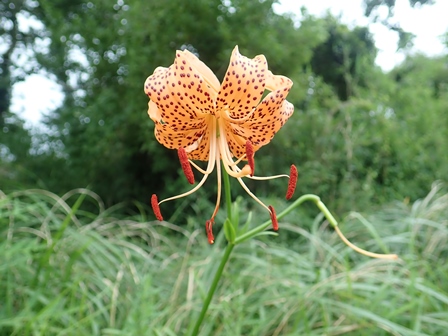
2020.08.11
ヤブカラシ
お茶畑でヤブカラシが咲いていました。いたるところで繁茂していて、まさに藪を枯らしてしまうほどの勢いです。花は蜜を分泌していて、多くの虫たちが集まっていました。しかし、東日本で見られるヤブカラシは三倍体と呼ばれる個体で、ほとんど実をつけることはないようです。
"Yabukarashi(ヤブカラシ)" plants are in bloom in the tea fields. "Yabukarashi" means "to kill bushes". Actually, they are flourished as if they were killing bushes. Their flowers have produced nectar and many insects are coming to the flowers. However, "Yabukarashi" plants that grow in Eastern Japan are botanically called "triploid" and they seldom produce their fruits.
2020.08.07
ウツボグサ
第一オークヒルでウツボグサが咲いています。日当たりの良い草地や路傍に生える多年草です。
花後、花穂は枯れて茶色くなります。この姿が矢を入れる容器である靭(うつぼ)に似ているので、ウツボグサと呼ばれています。
"Utsubogusa(ウツボグサ)" is in bloom in the First Oak Hill. It is a perennial plant living in sunny grass fields and road sides.
After flowering, its spike dies and turns brown. The shape of dead flowers looks like a case for arrows that is called "Utsubo(靭)". That is why it is named "Utsubogusa".
2020.07.21
チダケサシ
駐車場の近くにチダケサシが咲いていました。夏に、草原や湿地に見られる花です。和名は、長い茎に、同じく夏に見られるチチタケと呼ばれるキノコを刺して持ち帰ったことに由来すると言われています。
"チダケサシ(chidakesashi)" is in bloom near the parking lot. They live in grasslands and wetlands and bloom in summer. The name "chidakesashi" comes from "chichitake"(a kind of mashrooms) and "sashi"(to skewer). It is said that people in the past pick up "chichitake" mashrooms and skewered them with a long stem of "chidakesashi" to bring them home. That is why this flower is called “chidakesashi”.
2020.07.17
オオバチドメ
竹林の林床でオオバチドメが咲いていました。和名はチドメグサの仲間で一番葉が大きいことが由来です。チドメグサは血止草の意味で、葉の汁を傷口につけると血が止まることから名づけられました。他の仲間が空き地や野原などで見られるのに対し、本種は山地の湿った林床で見られます。
"オオバチドメ(oobachidome)" is in bloom on the bamboo forest floor. The name means that they have the largest leaves in the group of "チドメグサ(chidomegusa)" plant. "チドメグサ(chidomegusa)" is written like this "血止草" in kanji and it means "stop the bleeding". People used to put the sap from the leaves on their wounds to stop the bleeding. That’s why they are called "チドメグサ(chidomegusa)". The other species of this group lives on road sides or in fields but this one lives on moist forest floors in mountains.
2020.07.14
ケキツネノボタン
ヒノキ林の林縁でケキツネノボタンが咲いていました。葉が少しボタンの葉に似ていますが、花は全く似ていません。和名のキツネノボタンは、葉がボタンに似ているにもかかわらず花は全く異なるという事実が、キツネが人を化かすイメージと重ねられて名付けられたと考えられます。
I found "ケキツネノボタン(kekitsunenobotan)" blooming on the edge of the Japanese cypress woodland. Their leaves looks a little similar to "ボタン(botan)" plants but their flowers are totally different. "キツネ" in the name means "fox". And, in Japan, fox has an image that they trick people. It is because they have leaves that resemble the "ボタン(botan)" plant but their flowers don't resemble. This reminds people of a fox's image that foxes trick people. That's why they are called "ケキツネノボタン(kekitsunenobotan)".
2020.07.10
アメリカネナシカズラ
下の写真のように、ススキ野原で黄色い麺のようなものが、植物にからみついているのが見られました。アメリカネナシカズラです。北アメリカ原産の帰化植物で、葉緑体はなく寄生根によって他の植物に寄生して生きています。
和名のネナシカズラは根無し葛の意味で、他の植物から栄養や水分を吸収するようになると、自身の根は枯れてしまうことに由来しています。数年前から近くを流れる黄瀬川の河原で繁茂しているのを確認していましたが、いつの間にかススキ野原にも侵入していました。
Like in the first picture, you can see yellow noodle-like stuff in the Japanese pampas grass field. It's the "アメリカネナシカズラ(amerikanenashikazura)". They came from North America. They don't have chloroplasts and they live on other plants.
"ネナシカズラ(nenashikazura)" in the name is written like this "根無し葛" in kanji and it means "vine plant having no roots". As they grow, they spread their parasitic roots on other plants and their own roots connected to the ground die. That's why they are called "ネナシカズラ(nenashikazura)". From a few years ago, I have noticed that they have flourished on the river sides of the Kise river near here. However, I don't know when they came to this Japanese pampas grass field.
2020.07.03
オオカモメヅル
ヒノキ林の林縁でオオカモメヅルを見つけました。薄紫色の花冠の内側には、濃い紫色の副花冠と呼ばれる構造があり、よく目立ちます。
和名は、つる性の植物であることと、葉が翼を広げたカモメに見えることに由来しています。
I found "オオカモメヅル(ookammeduru)" on the edge of the Japanese cypress woodland. They have conspicuous dark-purple paracorollas inside light-purple corollas.
"カモメ(kamome)" and "ヅル(duru)" in its name means a "seagull" bird and a "vine plant" respectively. So the name derives from the two main features that it's a vine plant and their leaves looks like seagulls with opened wings.
2020.06.19
オオカナダモ
池でオオカナダモの花が咲いています。理科の観察実験でおなじみの水草ですが、南米原産の帰化植物で各地に逸出・野生化して問題になっています。日本で野生化しているのは雄株のみで、種をつけることはありません。しかし、千切れた植物体から容易に増殖し、分布を広げています。不二聖心の池でも、意図的に入れたことはありませんが、いつの間にか侵入し、繁茂してしまっています。
2020.06.09
ツボミオオバコ
オークヒルにツボミオオバコが見られます。全体に白い毛が目立つオオバコの仲間です。花弁が直立したまま開かないため、ずっと蕾のままのように見えることが名前の由来です。北アメリカ原産の帰化植物で、近年分布を広げているらしく、オークヒルでもたくさんの個体が見られます。
"ツボミオオバコ(tsubomioobako)" is in bloom now around the Oak Hill. It belongs to the "オオバコ(oobako)" plant group, which is one of the most common weeds in Japan. The plants body is dense with white hair. "ツボミ(tsubomi)" is written like this "蕾" in kanji and means "flower bud". The flower do not open and look like flower buds. That's why they are called "ツボミオオバコ(tsubomioobako)". They come from North America. These days, they are spreading around Japan and we can see them a lot around the Oak Hill as well.
2020.06.05
コモチマンネングサ
コモチマンネングサが咲いています。植え込みや道路のわきなどいたるところに生えています。和名のコモチは子持ちを意味し、葉の付け根にムカゴを作って仲間を殖やすことに由来しています。
コモチマンネングサのムカゴは下の写真に見られる丸い多肉質の葉状のものです。梅雨の時期に自然に地面に落ち、ほぼそのままの形で冬を越します。春に急速に成長をして花を咲かせます。通常は種子をつくらないため、ほとんどムカゴによって仲間を殖やしています。
"コモチマンネングサ(komochimannengusa)" is in bloom now. They live near shrubberies and by roadsides, etc. "コモチ(komochi)" is written like this "子持ち" in Kanji and it means "having children". That's because they have propagules on the base of leaves.
The small-succulent-leaf-like things, which you can see in the second picture, are propagules of "コモチマンネングサ". The propagules fall onto the ground in rainy season called "梅雨(tsuyu)", then stay as they are until spring time. In spring, they rapidly grow up and bloom. "コモチマンネングサ" usually does not bear fruits so they leave offsprings only by its propagules.
2020.06.02
フナバラソウ
クヌギ林の林縁でフナバラソウが咲いていました。明るい林縁や草地に見られます。近年生育地の減少などにより、全国的に絶滅が危惧されており、環境省のレッドリストでは絶滅危惧Ⅱ類に分類されています。不二聖心でも数株が見られるのみで、開花が確認できたのはこの1株だけでした。
"フナバラソウ(funabarasou)" is in bloom at the edge of the SawTooth oak woodland. In general, "フナバラソウ" lives at light edges of woodlands and in grasslands. However, these days, those places are decreasing due to urban development, etc. So "フナバラソウ" is classfied "Vulnerable" by the Ministry of Environment and so it considered endangered. There are a few "フナバラソウ" plants but only this one is in bloom in Fujiseishin.
2020.05.22
ホオノキ
セカンドオークヒルでホオノキの花が咲いていました。花は直径15cm、葉は長さ30cm以上あり、日本の樹木の中で花と葉が最も大きいとも言われています。この大きな葉は古くから食べ物を盛るのに使われてきました。今日でもホオノキの葉にみそや他の食材をのせて焼く朴葉みそが岐阜県・飛騨地方の郷土料理として有名です。
2020.05.19
オカウコギ
お茶畑のそばでオカウコギが咲いていました。近縁な種にヤマウコギやヒメウコギなど数種が知られていますが、互いによく似ています。また、山菜としてよく知られるタラノキやウドと同じウコギ科のなかまで、若芽は食用となります。
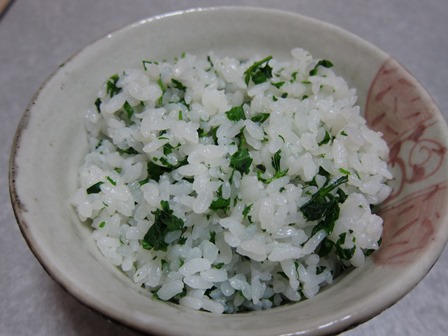
2020.05.15
ランヨウアオイ
裏道でランヨウアオイが咲いていました。ランヨウアオイの仲間(カンアオイ属カンアオイ節)は日本に50種ほどが自生しています。そのほとんどが日本固有種で、分布が限られているものが多いです。
ランヨウアオイも関東南西部から静岡県東部・山梨県南部の限られた地域に分布しています。一説には、1万年に数kmしか移動しないと言われており、この非常に低い分散能力が地域ごとの独自の進化を促したと考えられています。
"ランヨウアオイ(ranyoaoi)" is in bloom by the back road. There are about 50 species that are closely-related to this plant in Japan. Almost all of them are endemic to Japan and live only in small areas. This "ランヨウアオイ" lives only from the southwest of Kanto area to the east of Shizuoka and the south of Yamanashi. In one theory, they proceed only a few kilometers per 10,000 years. This very slow speed of spreading their seeds made them endemic to each region.
2020.05.08
エビネ
ヒノキ林の中でエビネが咲いていました。雑木林やスギやヒノキの人工林の林床に生育するランのなかまです。和名は海老根で、地下にある偽球茎(ぎきゅうけい)という構造が横に連なっている様子を海老に例えています。とても綺麗な花ですが、園芸目的の乱獲などで数が減り、全国的に絶滅が危惧されています。
I found this orchid called "エビネ(Ebine)" in our cypress woodland. "エビネ(Ebine)" is written like this "海老根" in kanji and it means "shrimp roots". They have pseudobulbs that grow in line like shrimps. The flowers are so beautiful but they are endangered because of over picking for gardens.
2020.05.05
アマドコロ
クヌギ林にアマドコロが咲いていました。近縁種のナルコユリと似ていますが、本種は茎に稜があり、角ばっている感じがします。和名は、地下茎がヤマノイモ科のオニドコロに似ていて、甘みがあることが由来です。
"アマドコロ(Amadokoro)" is in bloom in our SawTooth oak woodland. It is similar to "ナルコユリ(Narukoyuri)" that belongs to the same group but you can identify them by checking if their stems have ridges. "アマ(Ama)" is written like this "甘" in Kanji and it means "sweet". It derives from the fact that they have roots that taste sweet.
2020.05.01
ニョイスミレ
お茶畑の近くのクヌギ林にニョイスミレが咲いていました。紫の筋がある小型の白い花が特徴です。別名ツボスミレとも言いますが、牧野富太郎博士はツボスミレはタチツボスミレのことを指すので、本種の和名としてニョイスミレを提唱したそうです。ニョイ(如意)とは、僧侶が説法などの際に手に持つ仏具のことで、花と花柄の形が似ていることが由来です。
"ニョイスミレ(nyoisumire)" is in bloom in our SawTooth oak woodland near to the tea field. Its feature is a small white flower that has purple stripes. They were called "ツボスミレ(tsubosumire)" before. However, Dr. Makino Tomitaro(牧野富太郎) suggested that we should call them "ニョイスミレ" because "ツボスミレ" refers to another kind of violet. "ニョイ(nyoi)" in the name is written like this "如意" in Kanji and it means an item that monks have when they speak. The shape of the flower is likened to it.
2020.04.28
ノミノフスマ
お茶畑のわきにノミノフスマが咲いていました。コハコベやミドリハコベに似ていますが、全体が毛が無いことと、葉に柄がないことで区別することができます。和名は蚤の衾(のみのふすま)で、小さい葉をノミが使う衾(布団などの寝具のこと)に例えています。
"ノミノフスマ(nominofusuma)" is in bloom near to the tea field. It's similar to "コハコベ(kohakobe)" and "ミドリハコベ(midorihakobe)". However, you can identify the "ノミノフスマ" by the plants body having no hair and the leaves have no leafstalks. "ノミノフスマ" is written like this "蚤の衾" in Kanji and it means "flea's blanket". The small leaves metaphorically expressed as blankets used by fleas.
2020.04.24
ナツミカン
十字架の家の庭に大きなナツミカンの木があります。果実は秋に黄色く色付きますが、このときはまだ酸味が強く生食には適しません。そのまま収穫せずに、翌年の初夏まで待つと酸味が弱まり食べられるようになることからナツミカンと呼ばれています。
このナツミカンを使って修道院のシスターがゼリーを作ってくださいました。程よい酸味があり、とてもおいしかったです。
There is a large ortanique orange tree called "ナツミカン(natsumikan)" in the garden of the "十字架の家(Jujika-no-ie)". "ナツミカン" is written like this "夏蜜柑" in kanji and it means "summer ortanique orange ". The fruit turns orange in fall, but they still taste sour so we can not eat them raw. So, we wait until summer when their sourness has weakened and they become edible raw. That's why they are called “ナツミカン”.
A sister made me a cup of jelly with this "ナツミカン". It was moderately sour and tasted really good.
2020.04.21
ナツグミ
共生の森でナツグミが咲いていました。共生の森にはアキグミも植栽されており、どちらも春に花を咲かせますが、ナツグミは初夏に、アキグミは秋に果実が熟します。ナツグミはほぼ銀白色の鱗状毛のみに覆われるアキグミに対して、褐色の鱗状毛が混じるのが特徴です。
"ナツグミ(natsugumi)" is in bloom in the "共生の森(Kyouseinomori)". We also have "アキグミ(akigumi)" in the "共生の森". Both of them bloom in spring. "ナツ(natsu)" means "summer" and "アキ(aki)" means "fall". Literally, "ナツグミ" and "アキグミ" grows ripe in summer and in fall respectively. You can distinguish "ナツグミ" from "アキグミ" by their features. The leaves of "ナツグミ" are covered with white and brown hair but "アキグミ" only has white hair.
2020.04.17
スミレ
築山でスミレが咲いています。不二聖心にはタチツボスミレやアカネスミレなど、数種類のスミレが自生していますが、本種は「スミレ」という名前のスミレです。つまり、スミレはグループの総称であると同時に、特定の1種を指す和名でもあります。
"スミレ(sumire)" is in bloom in the "築山(tsukiyama)". Several species of "スミレ" live around our campus such as "タチツボスミレ(tachitsubosumire)" and "アカネスミレ(akanesumire)". "スミレ" in this picture is called "スミレ". In other words, "スミレ" is the name of this group and, at the same time, it is the name for this particular flower.
2020.04.14
ポポー
お茶畑の中に植栽されているポポーの花が咲いています。北アメリカ原産で、果実が食用となるため、各地で栽培されています。また、逸出したものが雑木林などで見られます。不二聖心でも逸出したと思われる幼木を見かけたことがあります。
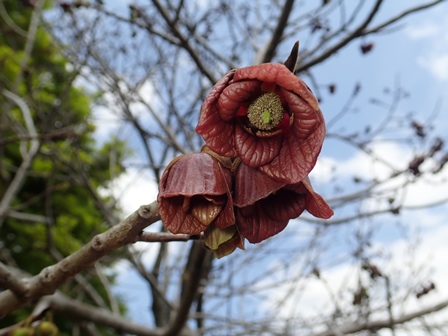
2020.04.10
アカネスミレ
スギ・ヒノキ林の日の当たる林縁にアカネスミレが咲いていました。鮮やかな紅紫色のスミレです。雑木林や草地などに一般的に見られるスミレですが、不二聖心ではそれほど個体数は多くありません。
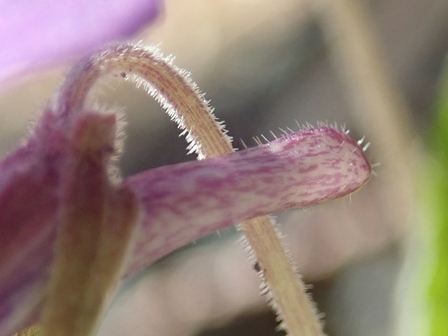
2020.04.07
オオシマザクラ
体育館の横にあるオオシマザクラが咲いています。ソメイヨシノと違って開花とほぼ同時に緑色の葉が展開します。和名は自生地である伊豆大島が由来です。桜餅の塩漬けされた桜の葉にはこのオオシマザクラの葉が使われていて、伊豆半島の松崎町が7割を生産しているそうです。
2020.04.03
ミツバツチグリ
ススキ野原にミツバツチグリが咲いています。ススキ野原には姿が似ている近縁種のキジムシロもありますが、本種は名前の通り小葉が3個である点で見分けることができます。また、根茎(こんけい、地下にある茎)が肥大するのが特徴です。西日本に分布する近縁種のツチグリの肥大した根茎は生でも食べられるそうですが、本種の根茎は硬くて食べられません。
2020.03.31
クロモジ
ススキ野原でクロモジが咲いています。和名は黄緑色の枝に見られる黒い模様を文字に見立てたものと言われています。葉や枝を傷つけると独特の良い香りがあります。また、爪楊枝の材料として古くから利用されています。

2020.03.27
クサボケ
第1オークヒルでクサボケが咲いています。近縁な種に観賞用として栽培される中国原産の木瓜(ぼけ)があります。本種は木瓜に似ていて、背丈が低く草地などに生えることから草木瓜(くさぼけ)と呼ばれています。秋に小さいリンゴに似た果実をつけます。
2020.03.24
キブシ
校内の日陰の林縁でキブシが咲いています。葉に先立って咲く黄色い花は、かんざしの垂れ飾りのようで特徴的です。和名は、本種の果実がヌルデの虫こぶである五倍子(ぶし)の代用として、黒色の染料に使われたことに由来します。
2020.03.20
ミツバアケビ
ススキ野原近くの雑木林でミツバアケビの花が咲いていました。花は濃い紫色で雄花と雌花に分かれており、写真は雌花です。本来はこの先に雄花がついていますが、虫に食べられてしまっているようでした。雌花の中心に5本の雌しべがあり、この部分が成長して果実になります。果実は近縁種のアケビと同様に食用になります。
2020.03.10
ナツトウダイ
お茶畑の近くのクヌギ林でナツトウダイが咲いています。名前にナツとついていますが、春先に近縁種の中で最も早く咲きます。
花は雄花と雌花で成熟する時期がずれていて、先に雌花が成熟し、次に雄花が成熟します。写真は雄花期で、黄色い花粉が出ています。三日月形のものは腺体と呼ばれ、蜜を分泌し、虫などを誘っています。
2020.03.06
オニシバリ
ヒノキ林の林縁でオニシバリが咲いていました。和名のオニシバリは、樹皮が強靭で、鬼も縛れるほどという意味です。
ジンチョウゲのなかまで、花の形はよく似ています。しかし、香りは弱く、近づくと微かに匂う程度です。
2020.03.03
フキ
裏の駐車場付近でフキが咲いていました。春に葉よりも先に花芽が顔を出し、これをフキノトウと呼び食用にします。数年前までは駐車場や体育館周辺に群落を見かけましたが、最近は少なくなったように思います。
フキは雄株と雌株に分かれていますが、やや複雑です。雌株の花はほとんどが雌花ですが、雄株の花は両性花で雄しべと雌しべがあります。しかし、この両性花の雌しべに花粉がついても種子ができることはありません。写真は雄株の両性花ですが、花粉が見られません。野生のフキには3倍体と呼ばれる正常な花粉をつくらないものがあり、この個体は3倍体と思われます。
2020.02.28
オオイヌノフグリ
キャンプ場でオオイヌノフグリが咲いていました。ヨーロッパ原産の帰化植物で、空き地や道端でよく見られます。和名は在来種のイヌノフグリよりも大型という意味と思われます。ちなみに、在来種のイヌノフグリは環境省のレッドリストで絶滅危惧Ⅱ類に指定されており、あまり目にする機会ありません。
花は日中開きますが、夕方には閉じてしまいます。このとき、2本のおしべも折りたたまれ、中心のめしべにくっつき受粉します。これは日中に虫などによってうまく花粉が運ばれなかった場合でも確実に受粉をする工夫と考えられます。
2020.02.25
アセビ
キャンパスに植栽されているアセビが咲いています。漢字で馬酔木と書き、有毒植物で馬が食べると中毒で酔ったようになるという意味です。本種は花が赤みを帯びた園芸品種で、ベニバナアセビと呼ばれています。アセビはやや乾燥した山地に自生するとともに、公園や庭に植えられることも多い樹木です。それほど強い香りではないですが、近づくと良い匂いがします。
2020.02.14
ヒイラギナンテン
聖心坂の途中にある林内でヒイラギナンテンが咲いていました。ヒマラヤから台湾、中国が原産の帰化植物で、江戸時代初期に渡来したと言われています。しばしば、公園や庭に植栽されており、逸出したものが林内で見られます。
和名にあるヒイラギとナンテンはそれぞれ別の植物の名前です。本種のトゲのある葉がヒイラギに似ていることと、葉のつき方や実のつき方がナンテンに似ていることからヒイラギナンテンと呼ばれています。
2019.12.10
トキリマメ
駐車場近くの植え込みでトキリマメの果実を見つけました。鮮やかな赤い果皮と光沢のある黒い種子が目立っています。果実が熟しても種子が落ちないことも特徴です。近縁種にタンキリマメがありよく似ていますが、葉の形によって見分けることができます。
2019.12.06
ヤブマメ
ススキ野原で、うずら豆のように黒い斑点模様のある豆を見つけました。ヤブマメの種子です。つる性の一年草で、林縁や草原などで普通に見ることができます。豆の模様は、地面に落ちたときに、鳥などに見つかって食べられないための迷彩的な効果があるのかもしれません。
下は10月に撮影した花の写真です。このような通常の花のほかに、地下には閉鎖花をつけ、地中にも種子をつくります。
2019.12.03
カツラ
共生の森で、高校1年生が植栽したカツラが紅葉していました。本来はもう少し標高の高い場所に自生する木ですが、庭や公園などに植栽されることも多いため、身近な樹木といえます。また、落ち葉からクッキーのような甘い香りがするのが特徴です。この日も木のまわりには独特の甘い香りが漂っていました。
2019.11.29
ベニバナボロギク
裏道にベニバナボロギクが咲いていました。アフリカ原産の帰化植物で、伐採跡地などにいち早く侵入するパイオニア植物として知られています。花は筒状花のみで目立ちませんが、よく見ると雌しべの先端が2つに分かれて、くるりと巻いているのがわかります。全体的に水分が多く柔らかい印象で、若芽は食用になるそうです。
2019.11.26
イヌホオズキ
裏道にイヌホオズキが咲いていました。道端や畑などでよく見られます。花は8月頃から見られますが、寒さに強いらしく11月になっても開花している個体もあります。オオイヌホオズキやアメリカイヌホオズキなどの近縁種との見分けが難しいですが、果実の中に種子のほかに球状顆粒を含むかどうかで見分けることができます。この個体は球状顆粒を含んでいなかったためイヌホオズキとわかります。
2019.11.22
ヤブムラサキ
共生の森の近くでヤブムラサキの果実を見つけました。同じ仲間のムラサキシキブと同様に果実は美しい紫色ですが、全体に星状毛が多いのが特徴です。ムラサキシキブはしばしば植栽されるため街中でもよく見られますが、ヤブムラサキはあまり植栽されず、山野で見ることが多いように感じます。
2019.11.19
ヒイラギ
キャンプ場の近くでヒイラギが咲いています。若木の葉には触れると痛いトゲがあり、古語でひりひり痛むことを表す「ひひらく」がヒイラギに変化したと言われています。しかし成木になるとトゲはなくなります。この個体も一部の枝を除きトゲはありません。
2019.11.12
ノコンギク
ススキ野原でノコンギクが咲いています。林道や河原など身近な場所で普通に見られる野菊の代表です。名前の通り淡い紺色をしていますが、花の色には変異があり、不二聖心で見られるものは白に近いものも多いように感じます。
2019.11.05
チャノキ
校内でお茶の花が咲いています。茶畑で栽培されるほか、逸出したものが各地の樹林内で見られます。茶畑では通常1mほどに刈り込まれていますが、樹林内で自然に育ったものは2mを超えるほどに大きく成長し、茶畑のものとは印象が異なります。不二聖心では第一オークヒルから第二オークヒルの間の道に大きな株があり、たくさんの花をつけています。
2019.11.01
エビヅル
ヒノキ林の林縁でエビヅルの果実を見つけました。ブドウ科ブドウ属の野生のブドウです。近縁のヤマブドウの方が名前が知られているかもしれませんが、ヤマブドウは標高の高いところに見られ、不二聖心で見られる野生のブドウはエビヅルです。ヤマブドウと同様に果実は食用になります。
2019.10.22
ツルニンジン
校舎裏の斜面にツルニンジンが咲いていました。キキョウ科のつる植物で、根が太く高麗人参(オタネニンジン)に似ていることからツルニンジンと呼ばれています。若芽や根は食用とすることができるそうです。
2019.10.15
シソ
駐車場の近くでシソを見つけました。葉を揉むと、シソ独特の香りがします。中国原産の一年草で、食用に栽培されているものが各地に逸出して野生化しています。葉に皴があるものや、赤紫色のもなど様々な品種があります。
2019.10.11
コメナモミ
共生の森周辺にコメナモミが咲いていました。よく似た種にメナモミがありますが、葉や茎の毛の量や長さで区別することができます。花を包む葉である苞(ほう)や花には粘液を出す腺毛が多くあるのが特徴です。
2019.10.04
オトコエシ
ススキ野原にオトコエシ(男郎花)が咲いていました。秋の七草であるオミナエシ(女郎花)に似ていますが、茎はより太く、葉も大きいことからオトコとつけたと言われています。漢名(中国での名前)を敗醤といい、生け花にすると醤油の腐ったような臭いが水に残ることが由来と言われています。
2019.10.01
ヒヨドリバナ
ススキ野原にヒヨドリバナが群生しています。一般にヒヨドリの鳴くころに咲くことが名前の由来と言われていますが、乾燥した花がらを火おこしの材料としたことから火取花と呼ばれ、それがヒヨドリバナになったという説もあります。
2019.09.24
メドハギ
ススキ野原でメドハギが咲いています。秋の七草の1つ萩(はぎ)の仲間です。直立した茎に密に葉がつく草姿は、他の萩の仲間と印象が異なりますが、花はマメ科らしい蝶形花です。和名は奈良時代から平安時代に活躍した陰陽師が使用した占い用の棒である筮(めどき)に由来するそうです。
2019.09.13
ツルマメ
ススキ野原の近くにツルマメが咲いていました。名前の通りマメ科のつる植物で、草原や林縁などに広く見られます。ダイズの原種と考えられており、本種が品種改良されて栽培種のダイズになったといわれています。
2019.09.10
ゲンノショウコ
ススキ野原にゲンノショウコが咲いていました。市街地の空き地や山地の草原まで広く見られる野草です。古くから薬草として知られ、薬効がすぐに現れるという意味で現の証拠(げんのしょうこ)と呼ばれているそうです。
2019.09.03
センニンソウ
ススキ野原でセンニンソウが咲いていました。日本に自生するクレマチスです。つる性で、地面を這うように生えており、近づくととても良い香りがしました。しかし、汁に触れるとかぶれることもあるといわれる有毒植物なので注意が必要です。
2019.08.30
ナンバンギセル
今年もススキ野原でナンバンギセルが咲いています。葉緑体をもたず、根でススキなどに寄生して生きています。宿主であるススキが生える草原が減少していることに伴って、数を減らしていると言われています。不二聖心のススキ野原は茶草場として利用されており、毎年草刈りが行われることで、ナンバンギセルが生育する環境が守られています。
2019.08.23
ツリガネニンジン
校舎裏の斜面にツリガネニンジンが咲き始めていました。名前の通り花は釣鐘形をしています。花をつける枝が数段にわたり輪生することも特徴です。明るい林床や林縁に普通に見られる種ですが、そのような生育地の減少に伴い減っているとも言われています。不二聖心では校舎裏のほかに定期的に草刈りが行われているオークヒルの土手などで見ることができます。
2019.08.20
アキカラマツ
オークヒルにアキカラマツが咲いています。名前にアキとあるように、秋に花を咲かせるカラマツソウの仲間ですが、実際には7月頃から咲き始めています。
花には花弁が無く、がくも開花すると落ちてしまうため、多数のおしべが良く目立ちます。この花の姿がカラマツの葉に似ているためカラマツソウと呼ばれています。
2019.08.16
イヌザンショウ
オークヒルの近くでイヌザンショウが咲いていました。香辛料として利用されるサンショウによく似ていますが、サンショウに比べ香りが良くなく食用には利用されないことからイヌをつけて、イヌザンショウと呼ばれています。また、花期も異なっており、サンショウは春に咲きますが、イヌザンショウは夏に咲きます。
2019.08.13
ツルニガクサ
オークヒル近くのヒノキ林の林縁にツルニガクサが咲いていました。名前にツルとついていますが、つる性ではなく、地下に細長い茎を出すことを示しているようです。また、花の時期に虫こぶをつけていることがよくあります。虫こぶとは昆虫などが寄生し、植物の組織が異常に発達したものです。下の写真に見られる緑色のふくらみは果実ではなく虫こぶで、ツルニガクサにはグンバイムシのなかまが寄生することが知られています。
2019.08.02
ヒキヨモギ
ススキ野原でヒキヨモギが咲いていました。ヨモギとつきますが、キク科のヨモギの仲間ではなく、ハマウツボ科に属します。葉緑体をもち、自ら光合成をして養分をつくる一方で、地下では他の植物から養分を奪って生きている半寄生植物です。日当たりの良い草地を好み、環境省による指定はありませんが、多くの自治体で絶滅が心配されている植物です。ススキ野原が茶草場として定期的に草刈りが行われることにより、ヒキヨモギの生育に適する環境が維持されていると考えられます。
2019.07.30
タケニグサ
共生の森でタケニグサが咲いています。大型で、草姿が竹に似ていることが和名の由来です。花期も終わりに近づき、下のほうの果実は大きくふくらんできています。秋には乾燥した果実が風に揺られてカサカサと音を立てることから、ささやきぐさとも呼ばれています。
花は1本の雌しべと多数の雄しべからなります。花弁はなく、白いがくも開花と同時に脱落します。
2019.07.26
アラゲハンゴウソウ
オークヒルでアラゲハンゴンソウが咲いています。北アメリカ原産の帰化植物です。近縁で同じく帰化植物のオオハンゴンソウは、生態系に被害を及ぼす可能性のある特定外来生物に指定されており、法律により栽培等が禁止されています。本種は特定外来生物には指定されていませんが、同属の帰化植物ですので生態系への影響が心配されています。不二聖心のオークヒルでは数年前に比べて数は減っている印象があります。
2019.07.19
ミツバ
キャンプ場近くの藪にミツバが咲いていました。名前の通り葉が三つに分かれているのが特徴です。栽培品は野菜としてスーパーなどで一年中手に入れることができますが、野生のものはより大型で香りが強いと言われています。
2019.07.12
イヌゴマ
ススキ野原にイヌゴマが咲いていました。シソ科の多年草です。イヌゴマのように名前にイヌがつく植物は多くあります。ほとんどの場合、他に有用な植物があり、それに姿かたちが似ているが役に立たないという場合にイヌがつくようです。本種は、果実が食用のゴマに似ているが、食用にならないということを示しています。
2019.07.09
コクラン
共生の森の近くの林でコクランを見つけました。名前の通り、黒い花を咲かせるランの仲間です。
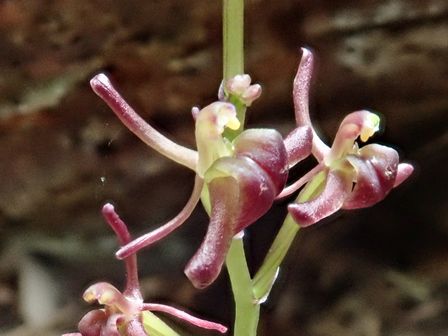
2019.07.02
シオデ
駐車場から校舎へ向かう道の斜面にシオデが咲いていました。つる植物で、巻きひげで他の植物にからみつきながら成長します。花は球形に咲き、花弁が反り返ることが特徴です。山菜の王と呼ばれ、若芽を摘んで食用とします。
2019.06.28
オオチドメ
オークヒルにオオチドメが咲いていました。チドメグサの仲間で、葉や茎を揉んで傷口につけると血が止まることが名前の由来といわれています。本種以外にノチドメやチドメグサなど似ている種も身近に多くあります。本種は茎の先端が斜上することや、葉柄(ようへい,葉と茎の間の柄)より,それに対する花柄(かへい,花と茎の間の柄)のほうが長いことで近縁の種と区別することができます。
2019.06.14
ナルコユリ
校舎裏の斜面にナルコユリが咲いていました。葉腋(ようえき,葉の付け根の部分)から筒状の花が垂れ下がって咲くのが特徴です。和名はこの花の姿を鳴子(なるこ,田んぼに吊り下げて音で鳥を追い払う道具)に見立てています。
2019.06.11
トチバニンジン
ヒノキ林の林床にトチバニンジンが咲いていました。和名はトチノキに似た葉をもつ人参を意味します。ここでいう人参とは野菜のニンジン(セリ科)のことではなく、薬用植物として知られるオタネニンジン(ウコギ科、高麗人参や朝鮮人参とも呼ぶ)と近縁であることを示しています。トチバニンジンにも薬用成分が含まれており、生薬として用いられることもあるとのことです。
2019.06.07
アズマイバラ
正門から坂をあがって、聖心橋を過ぎたところの斜面にアズマイバラが咲いています。主幹は太くなく、垂れ下がるように咲くのが特徴です。園芸植物のバラと同じバラ科バラ属で、十数種ある日本のバラの野生種の1つです。
園芸種のバラは花びらが多数ある八重咲きのものが多いですが、野生のバラは基本的に5枚の花弁と多数のおしべをもっています。
2019.06.04
ハコネウツギ
共生の森やオークヒルにハコネウツギが咲いています。花は初め白ですが、しだいに赤く変化します。近縁種にニシキウツギがあり、こちらも名前の通り花が白から赤に変化します。
両者は葉の裏面の毛の量で区別でき、主脈上に毛が少ないものがハコネウツギで、密生するものがニシキウツギです。確かめたところ、毛は散生する程度でしたので、ハコネウツギと判断しました。
2019.05.31
フタリシズカ
クヌギ林の林縁にフタリシズカが咲いています。和名は能の「二人静」に由来し、花穂を静御前とその亡霊の舞姿に見立てたと言われています。実際には花穂は2本に限らず3本以上あることもよくあります。
2019.05.24
ヨウラクラン
着生ランであるヨウラクランが咲いています。着生とは文字通り、樹の幹や岩にくっついて生えていることを指します。単に生活の場として樹の幹や岩を利用しているだけで、養分を奪う寄生とは異なります。
茎の先端から伸びた花穂には小さい花が多数輪状についています。花は1mmほどで非常に小さいですが、拡大してみるとランの仲間らしい花の形をしています。
2019.05.17
チガヤ
ススキ野原でチガヤが咲き始めました。チガヤの花穂は白い絹毛が密に生え、花が咲いているとよく目立ちます。花穂をツバナといい、若い花穂には甘みがあるので、昔は子どもたちがおやつ代わりに食べていたそうです。
2019.05.14
ヤマサギソウ
ススキ野原にヤマサギソウが咲いていました。日当たりのよい草地に生えるランの仲間です。環境省のレッドリストには載っていませんが、多くの都道府県で絶滅が危惧されている貴重な植物です。農園の方々が茶草場として定期的に草刈りをしてくださっているおかげて、生育に適した環境が保たれていると考えられます。
花は緑色で、注意しないと他の植物に紛れて見逃してしまいます。ラン科らしいユニークな形で、側花弁と呼ばれる2枚の花弁が上に伸びてバンザイをしているようです。
2019.05.10
ハハコグサ
共生の森をはじめ、校内の様々な場所でハハコグサが咲いています。春の七草の1つ御形(おぎょう、または、ごぎょう)はハハコグサのことで、身近な場所でよく見られます。
とても身近な花ですが、花のつくりは複雑です。遠目にみると茎の先端に1つの黄色い花が咲いているように見えます。しかし、実際にはタンポポなどのキク科に見られる頭花(とうか)と呼ばれる花の集まりが、さらに密に集まっているつくりをしています。つまり花の集まりの集まりが1つの花のように見えています。ハハコグサは、タンポポでは緑色の総苞(そうほう,頭花を包む葉)も黄色なので、全体が1つの黄色い花に見えています。
2019.05.07
ハナイバナ
共生の森でハナイバナが咲いています。茎は良く分枝し、上向きの毛があります。街中でも路傍や畑に普通に見られる雑草的な存在です。
しかし、よく見ると車形の可愛らしい花です。同じムラサキ科のキュウリグサに似ていますが、葉が花序の先まである点や、花の中央部の副花冠が淡青色である点によって見分けることができます。
2019.05.03
ヒメハギ
ススキ野原にヒメハギが咲いています。マメ科のハギに似た小さい花ですが、白い房状の付属体が特徴です。『神奈川県植物誌2018』によると「日当りの良い草地で普通に見られるが、市街地周辺では減少している」そうです。不二聖心のススキ野原は茶草場として毎年草刈りが行われ、ヒメハギの生育に適した日当たりの良い草地が維持されています。
2019.04.30
オオバウマノスズクサ
グラウンドの生垣にオオバウマノスズクサが咲いていました。
つる性の木本で、花は長い筒状で独特な形をしています。
花の中には小さなハエが数匹いました。長い筒状の花に入り込める小さいハエをおびき寄せ、花粉を運んでもらっているようです。
2019.04.26
オオジシバリ
校舎裏にオオジシバリが咲いています。和名の通り、茎は横に広がり地面を縛るように群生しています。近縁のイワニガナ(別名ジシバリ)とよく似ていますが、より大型で、葉がへら状になることが特徴です。
2019.04.23
キュウリグサ
校内の畑や植え込みにキュウリグサが咲いています。和名は、もむとキュウリのような匂いがすることが由来です。
2mmほどの淡青色の花の中央には、黄色い副花冠(ふくかかん)と呼ばれるつくりがみられます。また、伸びきっていない花序の先が丸まっていることも特徴です。
2019.04.19
サルトリイバラ
校内の林縁でサルトリイバラが咲いています。つる性で、茎はところどころにトゲがあり、ジグザグに伸びる特徴があります。和名は、猿捕り茨(サルトリイバラ)で、サルが絡まって捕らえられるという意味です。若芽は山菜として食用にされ、葉は餅を包むのに使われることもあります。
2019.04.16
スズメノヤリ
校内の芝地にスズメノヤリが咲いています。茎の先端の花の集まりが、大名行列で用いられた毛槍(けやり)に似ていることが和名の由来です。
1つの花で雌しべが成熟する時期と、雄しべが成熟する時期が分かれている雌雄異熟(しゆういじゅく)という特徴をもっています。下の写真の左は雌性期で、成熟した白い柱頭が見えます。右は雄性期で、柱頭はしおれて雄しべが成熟しています。自分の花粉で受粉してしまうことを避け、遺伝的な多様性を保つ工夫と考えられます。

2019.04.12
カキドオシ
キャンプ場の近くでカキドオシが咲いています。和名の垣通し(カキドオシ)は、垣根を越えて繁茂していく様子に由来しています。花は直立する茎につきますが、花後は横に伸びる匍匐枝(ほふくし)を出して広がっていきます。
花はシソ科らしい唇形花です。
2019.04.09
キランソウ
校内の道端や芝地でキランソウが咲いています。雑草として見過ごされやすいですが、よく見ると可愛らしい唇形花を多数つけています。
また、ジゴクノカマノフタ(地獄の釜の蓋)という変わった別名をもっています。下の写真のように地面にへばり付くように生える様子や、薬草として利用され病気を治す(=地獄の釜の蓋が閉じる)ということが由来のようです。
2019.04.05
フデリンドウ
ススキ野原でフデリンドウが咲いています。青紫色のかわいらしい花ですが、小さく目立たないため、注意しないと見逃してしまいます。ススキ野原は不二農園の方々によって「茶草場」として管理され、毎年冬に草刈りが行われています。そのおかげでフデリンドウの生育に適した日当たりの良い草地が維持されています。
2019.03.26
ヒサカキ
校内でヒサカキが開花しています。独特な強い芳香があるため、校内の森を歩いていると、花を見つけるより先に、匂いでヒサカキが咲いていることがわかります。一般には雄株と雌株に分かれており、下の写真は雌株の雌花で、先端が3つに分かれた雌しべが見られます。
下の写真は雄株の雄花です。多数の雄しべが見られ、雌花に比べてやや大きめです。形も雌花が杯型なのに対し、雄花は鐘型が多いようです。
2019.03.19
コハコベ
お茶畑にコハコベが咲いています。畑や路傍に見られる最も普通な雑草の一つです。一般にハコベと呼んでいるものにはこのコハコベと近縁のミドリハコベがあります。両者は雄しべの数や種子に見られる突起によって区別されますが、判断に迷う個体もあるようです。今回は雄しべの数が3~5本と少ないものが多かったので、コハコベと判断しました。ミドリハコベは8~10本あるものが普通なようです。
下の写真は花を拡大したものです。花弁は5枚と数えます。一見して10枚に見えるのは1枚の花弁が2つに深く裂けているためです。
2019.03.15
クモラン
校内の梅の木にクモランが着生していました。葉緑素をもつ緑色の根が放射状に広がっており、独特な姿をしています。この姿を蜘蛛(くも)に見立てたことが名前の由来です。葉はもっていませんが、代わりに根が光合成をすることで葉の役割も担っています。着生ランは樹木から養分を奪っていると誤解されることもありますが、くっついて生活しているだけで直接養分を奪うことはありません。
昨年に受粉してできた果実が裂開し、ラン科の特徴であるほこりのように細かい種子が見られました。
2019.03.01
タネツケバナ
マリア館前の花壇には前回紹介したミチタネツケバナに交ざって在来種のタネツケバナも咲いています(写真の中央がミネツケバナ、左奥がミチタネツケバナ)。ミチタネツケバナに比べ茎の上の方にも葉をつけ、果実は茎に対してやや開いた角度で立つことが特徴です。
また、茎や葉に毛があることも本種とミチタネツケバナと見分けるポイントです。和名は種漬花で、イネの種を水につけて苗を育てる準備をする時期に咲くことが由来といわれています。
2019.02.26
ミチタネツケバナ
マリア館近くの花壇にミチタネツケバナが咲いています。在来種のタネツケバナに似ていますが、ヨーロッパ原産の帰化植物で1992年に国内への定着が報告されました。葉は茎の下部に集まってつき、茎の途中にはあまり見られないことが特徴です。
また、茎に毛が無く、葉の付け根に刺毛状の毛が散生することもタネツケバナと区別するときのポイントになります。
2019.01.15
ロウバイ
マリアガーデンのロウバイが咲いていました。中国原産の落葉樹で、庭木としてしばしば植栽されています。黄色の花弁は透明感があり、ろう細工のようです。梅のように、1月~2月のまだ葉が開く前に、ろう細工のような花を咲かせることが名前の由来と考えられています。
2019.01.08
アオキ
聖心橋の手前の林内でアオキが赤い実をつけています。和名は冬でも葉や枝が緑色であることが由来です。『神奈川県植物誌2018電子版』には「ニホンジカの増加に伴いアオキが最初に食べられている」との記載があります。他の植物が葉を落とすなか、青々としたアオキの葉や枝は、シカにとって美味しそうに見えるのかもしれません。
2019.01.04
クロガネモチ
共生の森でクロガネモチが赤い果実をつけています。2016年度に高校1年生が植栽したものです。クロガネモチは関東地方以西に自生もしていますが、庭木としてよく植栽される樹種でもあります。モチノキの仲間で、樹皮から鳥もちをつくることができるそうです。
2018.12.28
タイアザミ
共生の森でタイアザミが咲いていました。タイアザミは別名トネアザミといい、関東地方で最も身近なアザミの仲間です。秋が花の盛りですが12月に入っても開花している株を見ることができます。
2018.12.25
セイタカアワダチソウ
共生の森のセイタカアワダチソウが果実をつけています。北アメリカ原産の帰化植物で、明治時代に観賞用として輸入されたと言われています。和名は秋に咲く黄色い花の泡立つように咲く姿に由来するという説と、写真のような冠毛のある果実の姿に由来するという説があります。しかし、もともとアワダチソウは在来種のアキノキリンソウの別名なので、単純にアワダチソウ(アキノキリンソウ)と同じ仲間で草丈が高いからセイタカアワダチソウと名付けられたのかもしれません。
2018.12.18
センリョウ
聖心坂近くの林内にセンリョウが見られます。前回紹介したマンリョウとともに、正月の縁起物として知られています。万両(まんりょう)に対してやや実の数が少ないため千両(せんりょう)とされたと言われています。赤い実や名前だけを見ると近い仲間のようですが、マンリョウがサクラソウ科に対し、センリョウはセンリョウ科と、植物の仲間としては遠い関係にあります。
2018.12.14
マンリョウ
校内のマンリョウの果実が赤く色付いています。比較的日陰を好み、校内ではヒノキ林の林床や植木の陰でしばしば見られます。和名は万両(まんりょう)の意味で江戸時代から正月に赤い実を多数つける縁起物として知られているそうです。不二聖心ではこの赤い実を、クリスマスリースの飾りに使用しています。
2018.12.11
クロヤツシロラン
校内の竹林でクロヤツシロランと思われる果実を見つけました。クロヤツシロランは自ら光合成をせずに、完全に菌類から栄養をもらって生きている菌従属栄養植物です。花は黒っぽく地面から数cmの所で咲くのであまり目立ちませんが、花後に写真のように茎が急速に伸び、目立つようになります。
下の写真は裂開した果実です。ラン科の特徴であるホコリのように細かい種子が見られました。クロヤツシロランは静岡県では準絶滅危惧種とされています。今後も観察を続け、来年は花を確認したいと思います。
2018.12.07
チカラシバ
共生の森にチカラシバが群生しています。試験管を洗うブラシのような花穂が特徴です。また、しっかりと根を張り、引き抜くのに力がいることが和名の由来です。
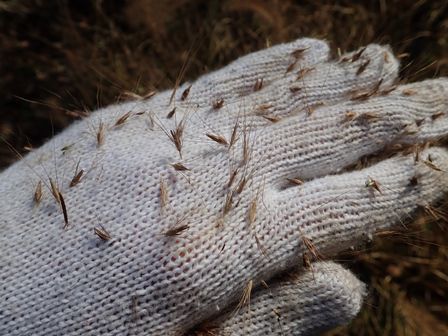
2018.11.30
ツルグミ
校内のヒノキ林の林縁にツルグミの花が咲いていました。和名はつる性のグミを意味し、4月ごろに赤く熟す果実は他のグミの仲間と同様に食用となります。
つる性と言っても、他の植物に巻き付いたりすることはなく、長い徒長枝を伸ばし寄りかかかるように生育している様子をよく見ます。
2018.11.20
スダジイ
聖心坂の途中に大きなスダジイの木があり、地面にはたくさんのどんぐり(堅果)が落ちています。
2018.11.16
ハンショウヅル
校舎裏の斜面にハンショウヅルの果実が見られました。花後に雌しべが発達して羽毛状になったものがよく目立ちます。学名はClematis japonicaで日本のクレマチスを意味します。様々な園芸品種が知られるクレマチスですが、多くの種で花後に雌しべが羽毛状になることが特徴です。
2018.11.09
ハダカホオズキ
共生の森の近くの林でハダカホオズキを見つけました。光沢のある赤い実がたくさんなっており、よく目立ちます。同じナス科のホオズキは、花後にがくが発達し果実を包み込みます。しかし、本種は花後にがくが発達せず、むき出しのままです。これが和名の由来と考えられます。
2018.11.06
リュウノウギク
正門から聖心坂を上っていく途中にリュウノウギクが咲いています。いずれも斜面から垂れ下がるように咲いています。栽培されるキクと同じキク属の仲間で、和名は葉をもむと竜脳と呼ばれる香料に似た香りがすることに由来します。実際に葉をもんでみると、クスノキに似た香りがします。
2018.11.02
カラスウリ
カラスウリの果実が赤く色づいています。花は夜に咲き、翌朝にはしぼんでしまうのであまり目立ちませんが、赤い果実はよく目立ちます。
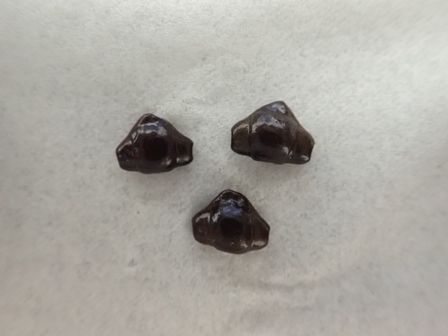
2018.10.30
ヤマノイモ
ヤマノイモにムカゴ(珠芽)が見られるようになりました。ムカゴは茎の一部が太ったもので、地面に落ちるとそこから新たな植物体が生じます。ヤマノイモの肥大した根は自然薯(じねんじょ)と呼ばれて食用にされますが、このムカゴも食用になります。
2018.10.26
ヒキオコシ
ススキ野原にヒキオコシが咲いています。和名は弘法大師が草の絞り汁を重病人に飲ませたところ、起き上がったという伝説に由来しています。古くから薬草として用いられたようでエンメイソウ(延命草)という別名もあります。
花はシソ科らしい「唇形花(しんけいか、花びらが上下に分かれ唇のような形の花)」で、雄しべや雌しべが花びらより長く飛び出しているのが特徴です。個体によって雄しべが長く雌しべが短いもの、雄しべが短く雌しべが長いものの2形があり、上の写真の個体は前者のようです。
2018.10.23
コシオガマ
共生の森からオークヒルに向かう途中のススキ野原にコシオガマが咲いています。ハマウツボ科の半寄生植物で、自ら光合成をしながらも、根では他の植物にとりつき栄養分を奪っています。
アフリカでは同じハマウツボ科の植物が農作物に寄生して甚大な被害をもたらしています。そこで、日本の研究グループはこのコシオガマをモデル植物として寄生に関する研究をしているそうです。近い将来、コシオガマの研究から得られた知見によって寄生植物による深刻な農業被害が解決する日がくるかもしれません。
2018.10.19
アキグミ
数年前に高校1年生が共生の森に植栽したアキグミがたくさんの実をつけています。同時に植えた他の樹種に比べ、鹿の食害も少なく、大きく育っています。
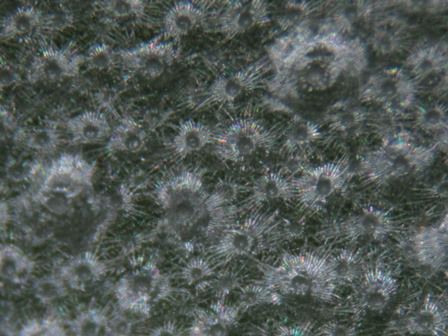
2018.10.05
ヒメガンクビソウ
キャンパス内のヒノキ林の林床にヒメガンクビソウが見られます。キク科の仲間で1つの花に見えるものは「頭花(とうか)」と呼ばれる花の集まりです。ガンクビ(雁首)とは,昔のタバコを吸う道具であるキセルの先端部分のことです。近縁の種のなかで小型なことと、頭花が下向きに咲く様子がキセルの雁首に似ていることが和名の由来です。
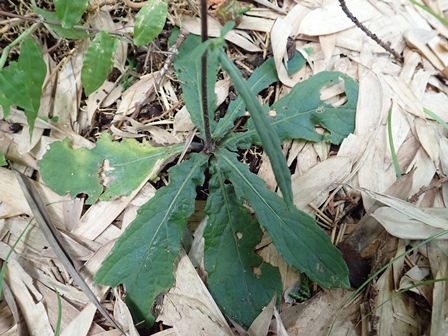
2018.10.02
ムカゴイラクサ
裏道のやや湿った場所にムカゴイラクサが生えています。上方の「葉腋(ようえき、葉の付け根の内側部分)」には雌花の集まり、下方の葉腋には雄花の集まりが見られます。

また、茎や葉には刺毛があります。ヒスタミンなどの化学物質が含まれているといわれており、触れると強い痛みを感じるので注意が必要です。しかし、春の若芽は近縁のミヤマイラクサとともに山菜として利用されます。ゆでたり、天ぷらにしたりすると、刺毛は気にならなくなります。
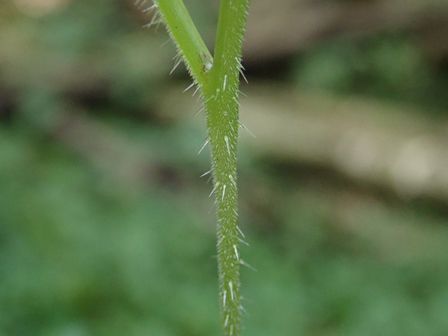
2018.09.28
ヌスビトハギ
校舎裏の駐車場に、ヌスビトハギが咲いています。マメ科の仲間で花は小さい「蝶形花(ちょうけいか、マメ科に多く見られる左右対称の蝶に似た形の花)」です。市街地から少し離れた場所の林縁などによく見られます。
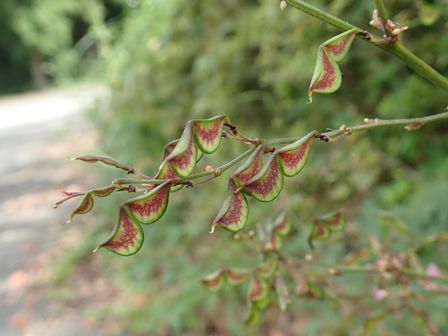
2018.09.25
ミョウガ
キャンパス内にミョウガが群生している場所が何か所かあります。野生状態で生育していますが、いずれも栽培されていたものが逃げ出したものと考えられます。
食用にされる部分は「花茎(かけい)」です。普通の葉とは別に,地下の茎から出てきます。花が咲く前のものが食用にされるので、スーパーなどでは蕾の状態で売られています。自然の状態では下の写真のように淡黄色の花が次々と咲きますが,1つの花は1日でしぼんでしまいます。
2018.09.21
コミカンソウ
共生の森にコミカンソウが生えています。暖地の畑や道端によく見られる植物です。葉は一見すると、オジギソウやネムノキのように複数の小葉が1つの葉をつくる「羽状複葉(うじょうふくよう)」のように思われますが、小葉に見えるものが1つの葉です。
葉の付け根には、名前の由来となった小さいみかんのような果実が並んでいるのが特徴です。
枝の先の方には雄花がついていました。がく片と花弁の区別のない6枚の「花被片(かひへん)」からなる可愛らしい花です。
2018.09.14
アマチャヅル
校内のヒノキ林の林床でアマチャヅルが開花しています。花は星型で、「鳥足状複葉(とりあしじょうふくよう」と呼ばれる形の葉が特徴的です。
2018.09.07
ウド
共生の森でウドの花が咲き始めています。若芽は春の山菜として有名で、畑で栽培されることもあります。
大型の多年草で、下の写真のように花をつけた茎は2mを超すほど高く伸びていました。「ウドの大木」という言葉のウドはこの植物のことです。「ウドの大木」を辞書で調べると「〔ウドは茎が高く生長するが、食用にはならなくなり、また茎が柔らかくて用途がないことから〕体ばかり大きくて、何の役にも立たない人のたとえ。」(大辞林 第三版)とあります。しかし、これは訂正しなければなりません。大きく伸びたウドがつける花や蕾は食用になります。私は毎年この時期になると、ウドの蕾を穂ごと摘み取り、薄く衣をつけて天ぷらにしています。香りがよく、とても美味です。
2018.08.31
クズ
共生の森の近くでクズの花が咲いていました。クズは生命力旺盛なつる性植物で、他の植物を覆いつくしてしまうほどです。
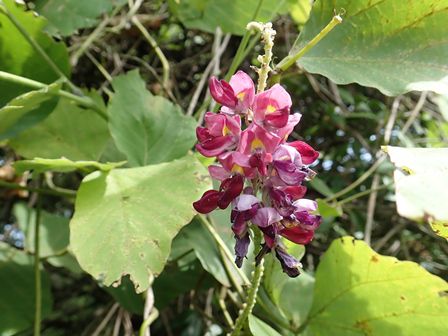
万葉集の時代から秋の七草の1つに数えられ、とても身近な植物だったことがわかります。根からとれるデンプンを和菓子に利用したり、つるの繊維から布をつくったり、葉を家畜の飼料にしたりと、様々な用途に使われてきました。
2018.08.28
コチャガヤツリ
共生の森にコチャガヤツリが群生していました。カヤツリグサの仲間です。「花序(かじょ、花のつき方)」は線香花火のような面白い形をしています。よく似た近縁な種もいくつかありますが、花の特徴からコチャガヤツリと考えられます。
カヤツリグサの仲間は、一見するとイネやススキなどのイネ科の仲間のようにも見えますが、カヤツリグサ科という別の科に分類されています。見分けるポイントとして、多くのカヤツリグサ科の植物は下の写真のように茎の断面が三角形になっているという特徴があります。
2018.08.24
シンテッポウユリ
キャンパス内でシンテッポウユリが白い花を咲かせています。シンテッポウユリは台湾原産のタカサゴユリと在来種のテッポウユリとの交雑由来の種を指しています。園芸目的で育てられていたものが野生化したと言われています。花の外側は赤みを帯びるものから、白いものまで変異が見られるようです。
シンテッポウユリは野生のユリとしては最も目にする機会が多いかもしれません。道路のわきや空き地などいたるところに見られます。ヤマユリなど他のユリは種子から開花まで数年かかるのがふつうです。しかし本種は種子から1年以内に開花し、たくさんの種子をつくるため、急速に分布を広げているようです。
2018.08.21
クサギ
駐車場から共生の森へ行く道の途中にクサギが咲いていました。花は長い筒状の部分があり、長い口吻(こうふん)をもつアゲハチョウの仲間の大型のチョウが蜜を吸いに訪れているのをよく見ます。
クサギとは臭い木という意味で、葉をちぎったり傷つけたりすると、独特の臭いがすることに由来しています。臭いからクサギとは少しかわいそうな気もしますが、平安時代の本草書(薬物書)にもある歴史のある名前だそうです。個人的には、ピーナッツのような匂いで、それほど嫌な感じはしませんが、感じ方は人それぞれのようです。
2018.08.17
コガンピ
ヒノキ林の林縁に、コガンピが咲いていました。1m以下の小低木で、冬になると地上部は基部を残して枯れてしまいます。地域のよっては草原の減少に伴って数を減らしているようですが、不二聖心では林縁や草原の手入れがされているために、毎年見ることができています。
近縁のガンピやサクラガンピなどは高級和紙の原料として利用されてきましたが、コガンピの樹皮はもろく、和紙の原料としては使えないようです。植物では、有用な植物に似ているが役に立たない植物の名前にイヌをつける習慣があり、コガンピは別名イヌガンピと呼ばれています。
2018.08.14
アリノトウグサ
オークヒル沿いの斜面にアリノトウグサが生えています。和名は「蟻の塔草(ありのとうぐさ)」で全体を蟻塚に、花を蟻に見立てていると言われています。
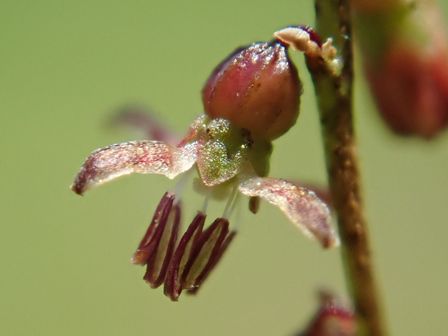
下の写真は雌性期の花で、すでに雄しべと花弁は落ちて、羽毛状の雌しべの柱頭が目立ちます。雄しべ先熟は、雄しべと雌しべの成熟する時期をずらすことによって、自分の花粉で受粉しないようにする植物の工夫であると考えられています。
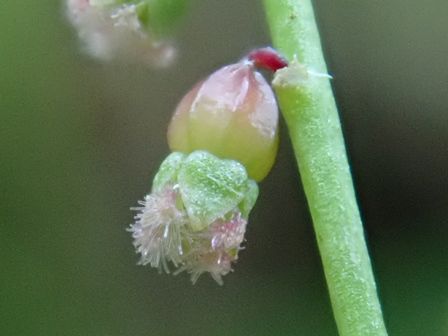
2018.08.10
カナビキソウ
オークヒルにイネ科の植物などに交じってカナビキソウが見られます。葉緑体を持ち、自ら光合成をしながらも、地下ではほかの植物から栄養分を奪っている半寄生性の植物です。
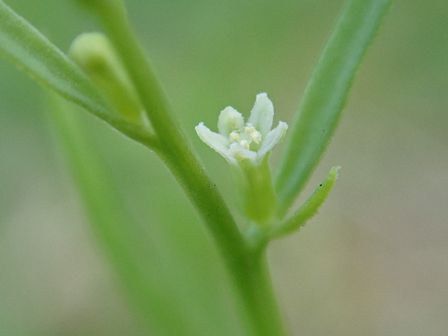
2018.08.07
コニシキソウ
お茶畑のわきなど、いたるところにコニシキソウが見られます。北アメリカ原産の帰化植物ですが、日本各地の畑や路傍に普通に見られる雑草になっています。一方で在来種のニシキソウはコニシキソウにおされて少なくなりつつあるそうです。
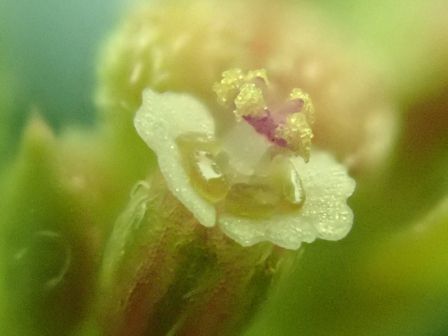
下の写真は雌花を拡大したものです。雄花と同様に蜜腺が見られます。雄花で花粉をつけたアリが蜜を吸おうと頭を近づけると、やはり雌しべの先端の柱頭に頭がぶつかり、受粉するようになっています。雑草として見過ごしてしまう植物もよく観察すると大変興味深い生態をもっています。
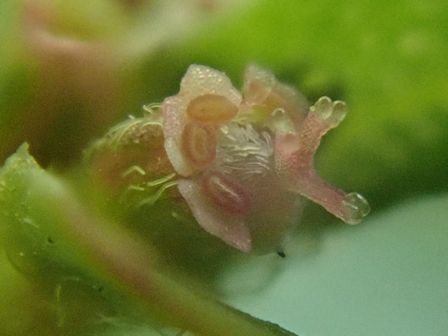
2018.08.03
アイナエ
オークヒルの一部にアイナエが群生しています。図鑑によると日当たりの良い暖地の低湿地に生えるとなっていますが、オークヒルも生育に適した環境なのでしょうか。芝生に交じって生え、長い花茎の先に白い小さな花をつけています。
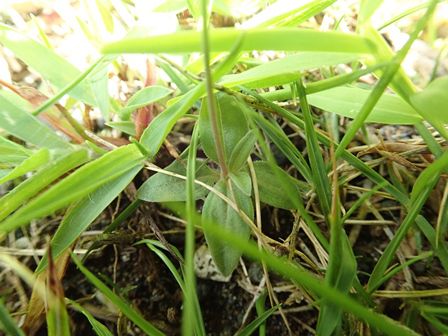
2018.07.24
ハエドクソウ
校内の日当たりの悪い斜面や林床にハエドクソウが咲いています。全体に有毒成分があり、根を絞った汁でハエ取り紙をつくったことが和名の由来です。
花には小さいアリが来ていました。花の蜜には毒が含まれていないのでしょうか。ハエドクソウは花や葉の形状や花期の違いによって「ハエドクソウ」と「ナガバハエドクソウ」の2種類に区別されることがあります。写真のハエドクソウは葉の基部の形状などからナガバハエドクソウだと思います。
2018.07.17
ヤマユリ
校内でヤマユリが開花しています。手のひらほどの大きな花で、強い芳香があります。とても立派な花なので園芸品種のようですが、本州の近畿地方以東に自生している日本固有の野生植物です。
校内では急な斜面に垂れ下がるように咲いている個体はよく見ますが、平らな場所に生えているものはほとんど見ません。ヤマユリの「鱗茎(りんけい、いわゆる球根)」は苦味がなく、ゆり根として食用になります。おそらくイノシシなどの野生動物も鱗茎を掘って食べてしまうので、斜面など掘って食べにくい場所にある個体が残っているのだろうと考えられます。
2018.07.10
ネジバナ
古くなった木製のベンチにネジバナが咲いていました。花が茎にらせん状につき、ねじれて見えることが和名の由来です。花のねじれの向きは決まっていないようで左巻きや右巻き、ほとんどねじれないものなど変異があります。
ネジバナはランの仲間です。下の写真は花をアップで撮影したもので、小さくてもちゃんとランらしい左右対称な花のつくりをしています。ランの仲間には絶滅危惧種に指定されている希少な種も多いですが、ネジバナは最も身近に見られるランの仲間と言ってもよいのではないでしょうか。
芝生に交じって群生し、雑草のように扱われることもあるネジバナですが、いざ育てようと思うと意外に難しいことが知られています。それはランの仲間は菌根菌と呼ばれるカビやキノコの仲間と共生しており、菌根菌がいない環境に移されてしまうと弱って枯れてしまうからです。一枚目の写真のネジバナも、かわいそうだからと別の場所に植え替えてしまうとかえって弱ってしまう可能性があります。一見すると土もなく厳しい環境に見えるベンチの上も、ネジバナにとっては菌根菌に囲まれて、他にライバルとなる植物のいない快適な環境なのかもしれません。
2018.07.06
ハナイカダ
校舎の裏の斜面にあるハナイカダの果実が紫黒色に熟していました。葉の中央に花をつけるというユニークな特徴をもっています。ハナイカダという和名は、この特徴を筏(いかだ)に乗る人の姿に見立てたことが由来になっています。
2018.07.03
タシロラン
校内でタシロランの開花を確認しました。全体が白いのは葉緑体を持たないためです。タシロランは養分のすべてを光合成ではなく土壌中の菌類から得ています。
2018.06.26
ナワシロイチゴとアオガネヒメサルハムシ
ススキ野原にナワシロイチゴが咲いていました。「苗代(なわしろ)」とは稲の苗を育てる場所のことです。苗代で稲の苗を育てる時期に赤い果実ができることからナワシロイチゴと呼ばれたそうです。しかし、現在の稲作ではすでに田植えも済んでいるのでずいぶんと時期がずれてしまっています。ピンク色の花弁は直立し、雄しべや雌しべを包むように咲きます。

2018.06.15
サルナシ
学院の森にサルナシが生育している場所があります。先日、様子を見に行ったのですが、すでに花の時期は終わっており、果実ができつつありました。マタタビ科のつる性の落葉樹で、葉の柄の部分が赤くなるという特徴があります。
2~3cmになる果実は秋に熟し、甘く食用になります。キウイフルーツと近縁で、味や果肉の見た目はキウイフルーツに似ています。近年は、ベビーキウイなどの名称でスーパーの果物コーナーに海外産のサルナシが売られていることもあります。秋になったら再びこの場所を訪れて、不二聖心産のサルナシを味わってみたいと思います。
2018.06.12
エビガライチゴ
2週間ほど前から共生の森でエビガライチゴが咲いています。植物体に長い赤色の腺毛が密生しており、白い花弁は直立して雄しべや雌しべを包むように咲くのが特徴です。中部日本の代表的なキイチゴ類の一種で赤く熟した果実は食用になります。
がくは花が咲き終わるといったん閉じ、実が熟すころに再び開きます。写真に見られる先端の方のものはつぼみではなく、咲き終わった後の花で、中にはまだ熟していない青い果実が見られます。腺毛からはネバネバする液体が分泌されており、小さい虫は絡まって動けなくなっているようです。エビガライチゴの長い腺毛と開閉するがくは果実が成熟するまで虫からの食害を防ぐ働きがあるのかもしれません。
2018.06.05
テイカカズラ
校内の林でテイカカズラが咲いています。「カズラ」とはつる性植物の総称で、テイカカズラの花も他の樹木や岩にぶら下がって咲いています。
「テイカ」は藤原定家に由来しており、定家が恋した式子内親王の墓石にからみついた本種をテイカカズラと呼ぶようになったそうです。下の写真はセカンドオークヒルで撮ったものです。白く見える部分はすべてテイカカズラの花で、15mはあるヒノキを覆いつくす勢いで繁茂しています。この強い生命力を見た昔の人々がテイカカズラと定家の執念を結び付けて考えたのかもしれません。
2018.05.25
タチツボスミレ
タチツボスミレが閉鎖花をつけています。つぼみのように見えますが、このまま花が開くことなく受粉が行われ、種子がつくられます。
ふつうの花では、昆虫などに花粉を運んでもらうため、うまく受粉に成功しなければ種子をつくることはできません。しかし、閉鎖花では下の写真のようにほとんど受粉に成功し、種子をつけているようです。
今日は創立者聖マグダレナ・ソフィアの祝日です。彼女は特にスミレの花を好んだといわれています。残念ながら今の時期に紫色の可憐な花を見ることはできませんが、花期の終わりに閉鎖花をつけて確実に子孫を残すスミレの姿を見ることができます。
2018.05.15
ニワゼキショウ
校舎近くの芝生やオークヒルにたくさんのニワゼキショウが咲き始めました。北アメリカ原産で明治20年ごろに渡来し各地に広がったそうです。
名前は庭に咲くセキショウという意味です。セキショウは川の縁などに自生しています。下の写真はマリア館前のビオトープ池に植栽されたセキショウです。4月に撮影したもので、黄緑色の棒状のものが花の集まりです。花は全く似ていませんが、葉のつき方は似ています。
2018.05.11
ウマノアシガタ
駐車場の近くにウマノアシガタが群生している場所があります。別名をキンポウゲといいますが、本来はウマノアシガタの花が重弁になったものをキンポウゲと呼んでいたようです。花弁には光沢があって遠くからでも目を引きます。
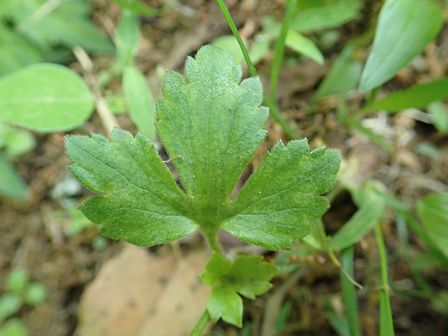
2018.05.08
ホソバオオアマナ
クリ畑の隅にホソバオオアマナが咲いていました。周りによく溶け込んでいたので在来種かと思いましたが、地中海沿岸地方原産の帰化植物でした。観賞用に栽培されていたものが野生化して分布を広げていると言われています。
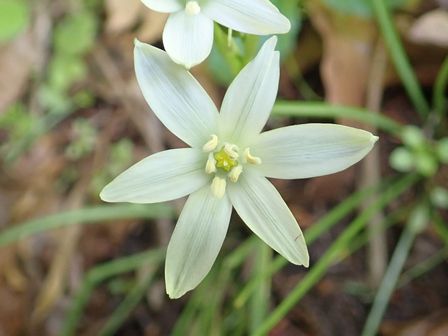
2018.04.24
ナベワリ
先週、ヒノキ林の斜面にナベワリが咲いているのを見つけました。花は緑色で下を向いています。有毒植物で、舐めると舌が割れるという意味の「舐め割り」が訛ってナベワリとなったと言われています。
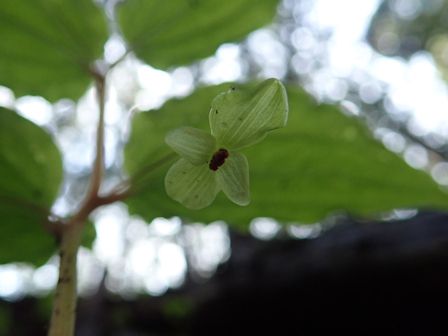
2018.04.17
スルガテンナンショウ
校舎の近くにスルガテンナンショウが咲いていました。「仏炎苞(ぶつえんほう)」と呼ばれる筒状の葉に花の集まりが包まれており、独特の雰囲気があります。
近縁の種には、草姿や模様がマムシに似ていることからマムシグサと呼ばれるものもあります。本種は仏炎苞の上部の内側に微細な突起が密生することや、付属体と呼ばれる棒状の部分の先端が前方に曲がり球状にふくらむことで区別されます。スルガテンナンショウの分布は中部地方の太平洋側とされており、『神奈川県植物誌2001』に記録がないことから、不二聖心がほとんど分布の東限と言ってよいかもしれません。
2018.04.13
サトザクラ
職員室横の八重咲きのサトザクラが満開を迎えています。サクラの園芸品種は200種類以上あると言われていますが、これらを総称してサトザクラと呼んでいます。生徒と花弁の枚数を数えたところ、1つの花につき23~32枚の花弁がありました。
ヤマザクラなど野生のサクラの花には5枚の花弁と多数の雄しべがあります。八重咲きのサトザクラは遺伝子の異常によって雄しべが花弁に変化したものと考えられています。花を分解してみると、下の写真のように花弁と雄しべの中間の形をしたものが見られました。確かに、雄しべが花弁に変化しているようです。
木曜日には家庭科クラブの生徒たちが、開ききる前の花を摘み取って「桜の塩漬け」づくりをしていました。サトザクラは目で見て楽しむだけでなく、食用にも利用されています。この後、塩や酢に漬け込み、1か月ほどで出来上がるそうです。
2018.04.06
ジロボウエンゴサクとタチツボスミレ
ジロボウエンゴサクとタチツボスミレが並んで咲いていました。写真の中央の淡紅紫色の花がジロボウエンゴサクで、そのまわりがタチツボスミレです。
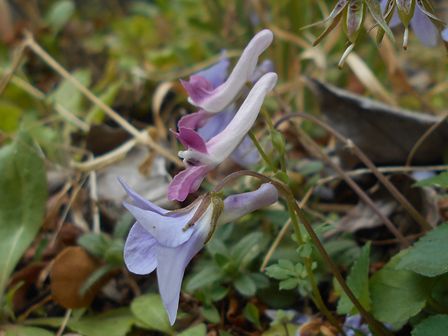
2018.04.03
モミジイチゴ
モミジイチゴが白い花を咲かせています。不二聖心ではいくつかのキイチゴの仲間が見られますが、このモミジイチゴが最も早く花を咲かせるように思います。花は下向きに咲くので、覗き込むように写真を撮りました。
葉は変異が大きく、また、近い種との雑種をつくりやすいことから分類は難しいグループのようです。不二聖心に見られるものは下の写真のように、切れ込みが深いものが多いです。


